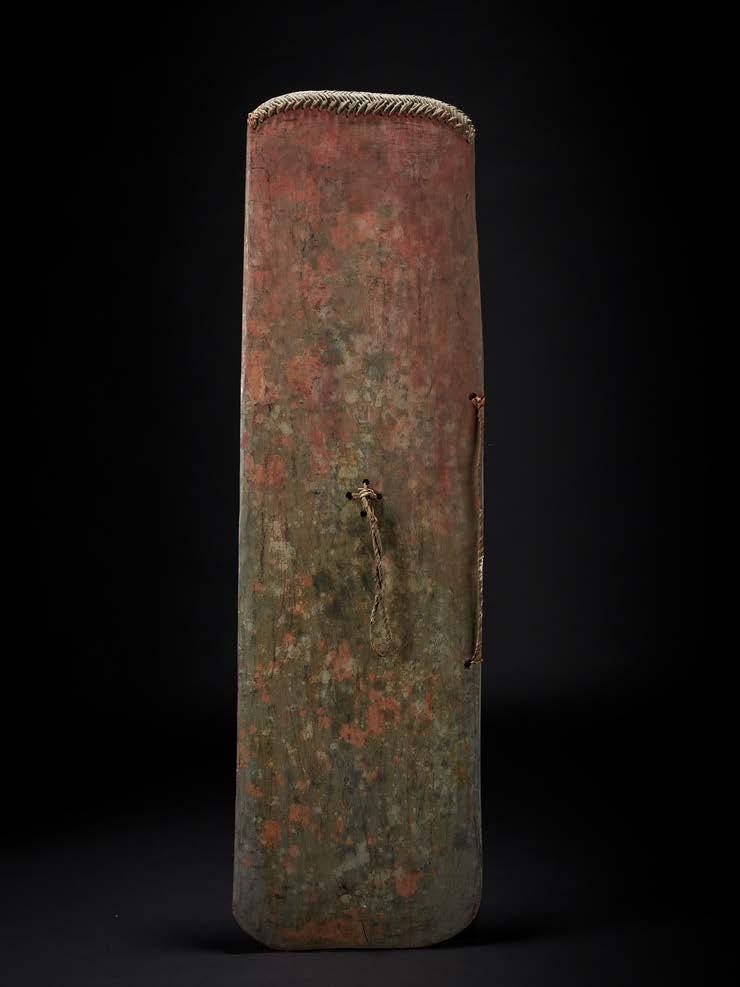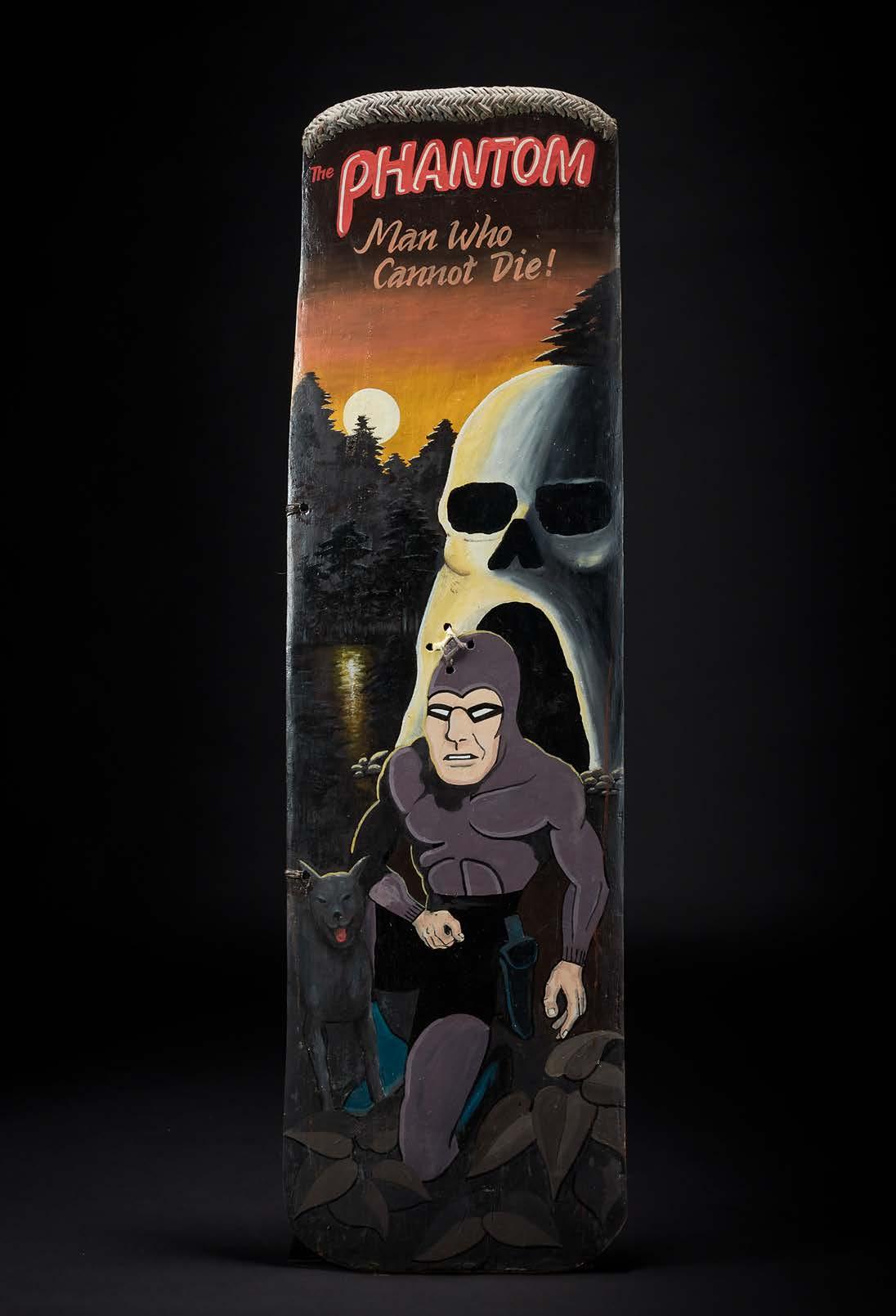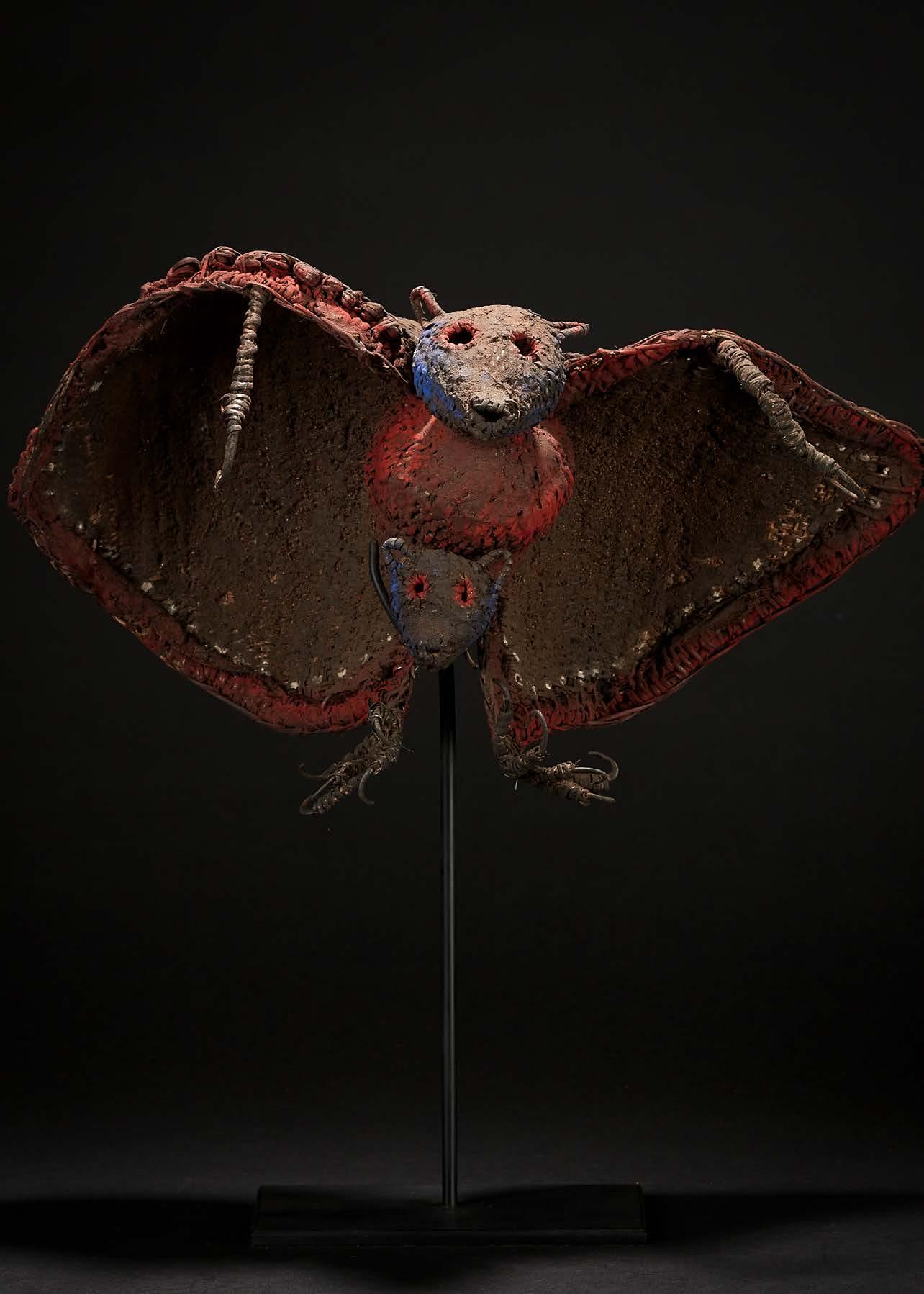

Chris Boylan - Oceanic Art
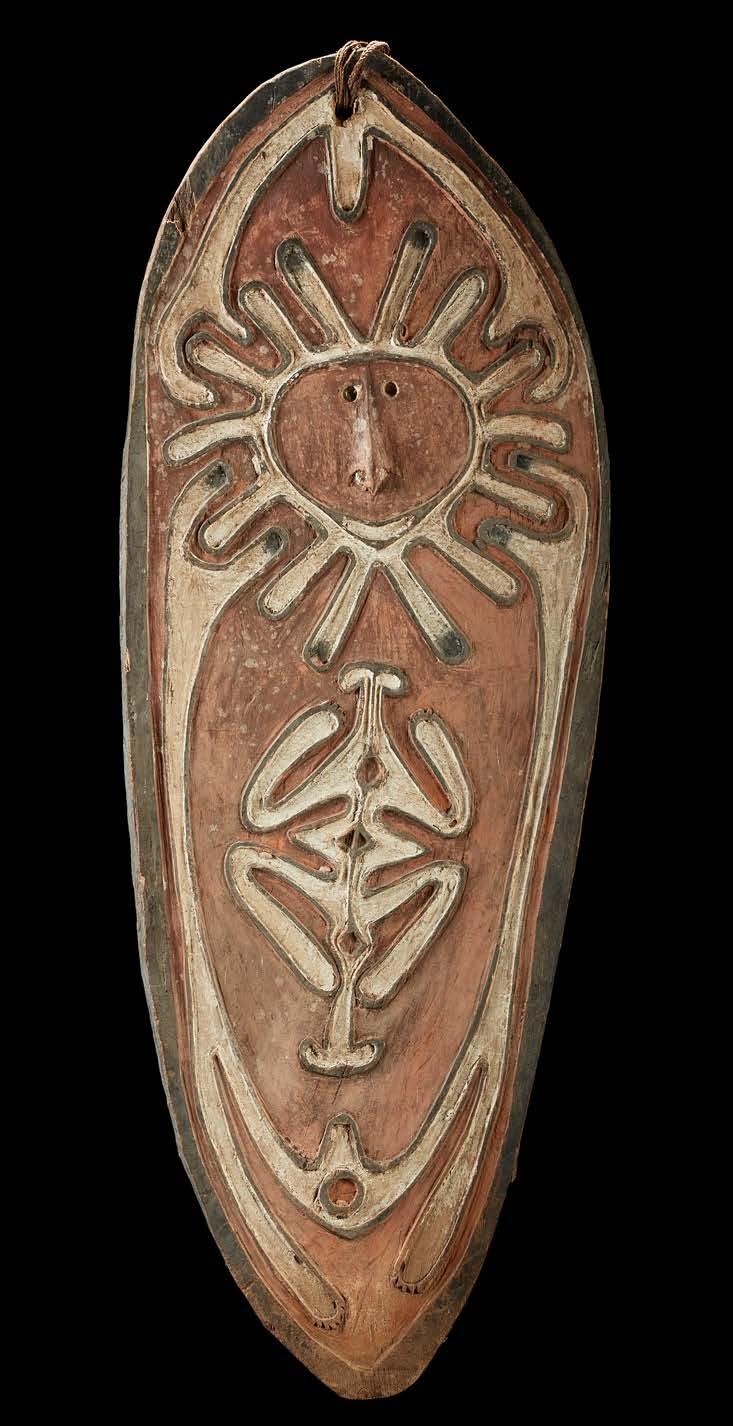
PARCOURS DES MONDES 2025

Chris Boylan - Oceanic Art
Sydney Australia
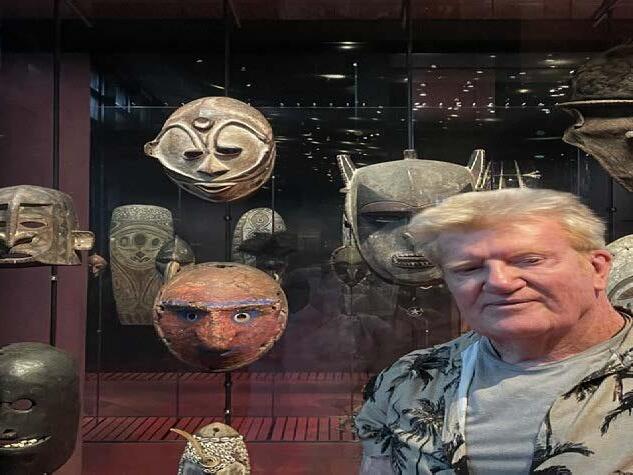
I live in Sydney, Australia. Due to my many travels, I work from a home office and Sydney warehouse rather then a permanent gallery. My schedule includes several trips to Papua New Guinea and various Pacific regions, with regular exhibitions in Australia and overseas. An avid field collector, I still greatly enjoy these Pacific odysseys and always come across some fine and interesting artworks. Having said that, old collections and small auctions within Australia can also be a rich resource for artworks. email: info@chrisboylan.com.au www.chrisboylan.com.au
TEL: +61 405 093 577
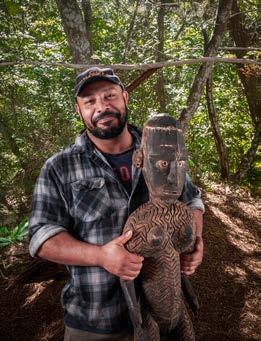
Design: Grumpy Wombat, Sydney
Photos: Jenni Carter, Sydney

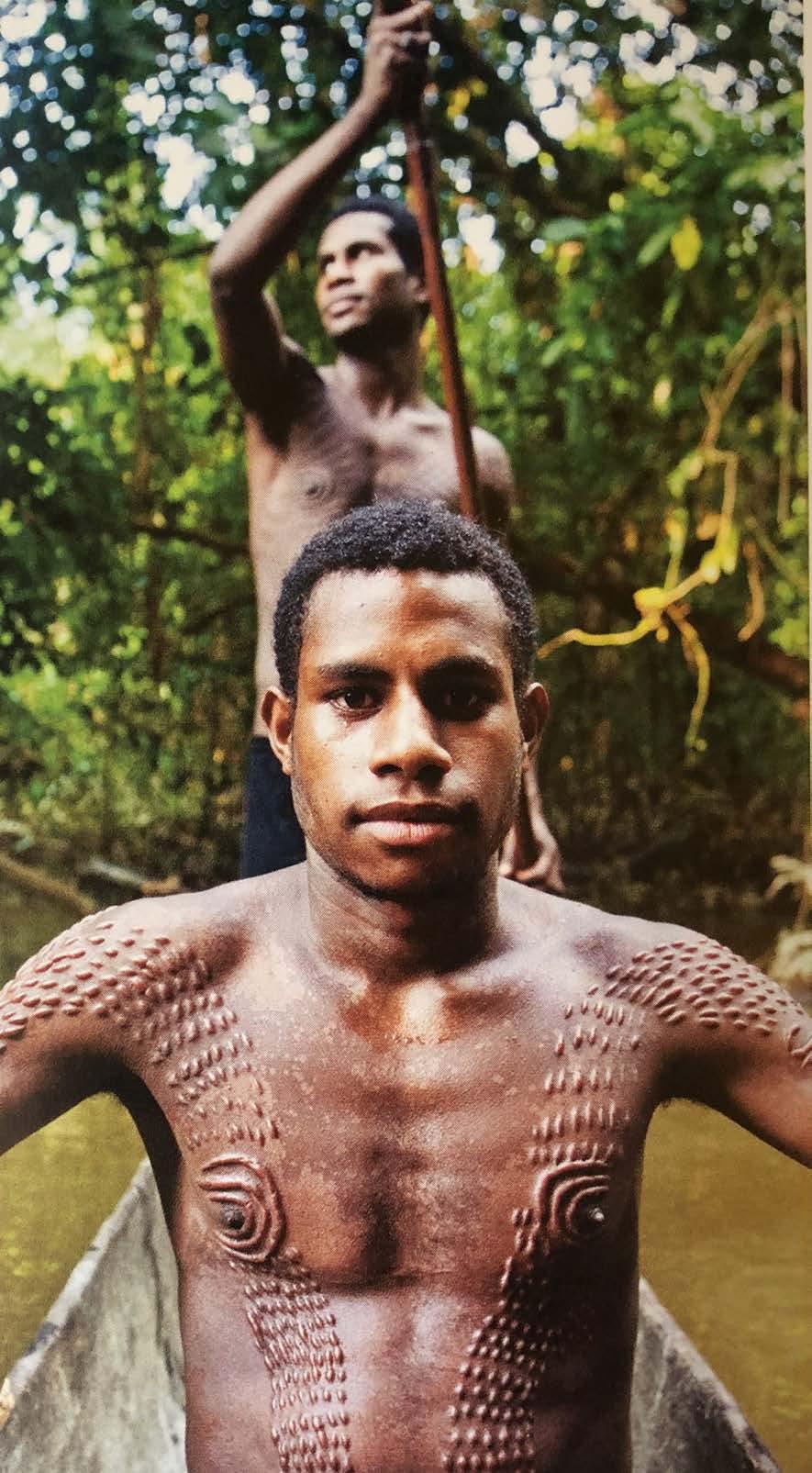
1. PRE-CONTACT FIGHTING SHIELD, elyaborr
Mendi Valley, Southern Highlands, Papua New Guinea.
Provenance: Collected in Papua New Guinea Highlands c. 1969. ex-important Tahitian collection.
The shield is ancient with an overall glossy patina. It has a dramatic, engraved running figure that covers most of this shield. This creates a rare dynamic quality in a Mendi shield that so often use more static geometric motifs. Such shields are used by archers, who sling the shield over the shoulder, giving protection to the side of the warrior’s torso. The shield is certainly pre-contact and stone-carved.
Published” “ Shields of Melanesia” edited by Harry Beran and Barry Craig, Crawford House Publishing, Adelaide, 2005 pp135.

€ 8,500
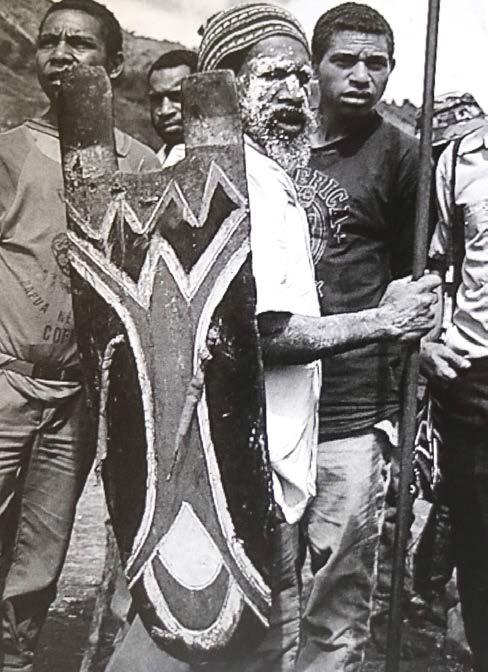
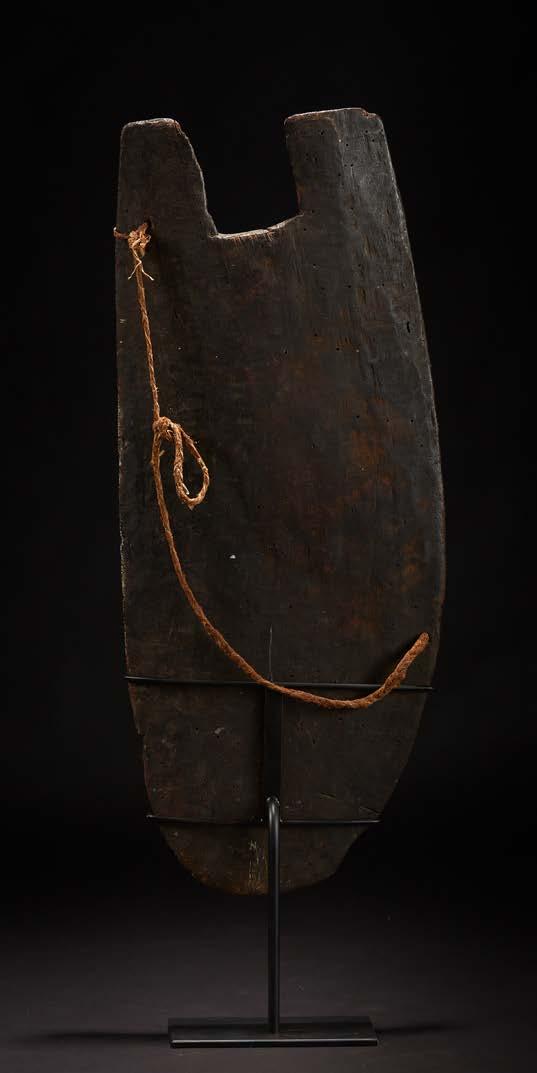
84 x 35 x 4 cm
Warrior preparing for war, carrying his elyaborr.
Photo Chris Boylan Mendi 1976

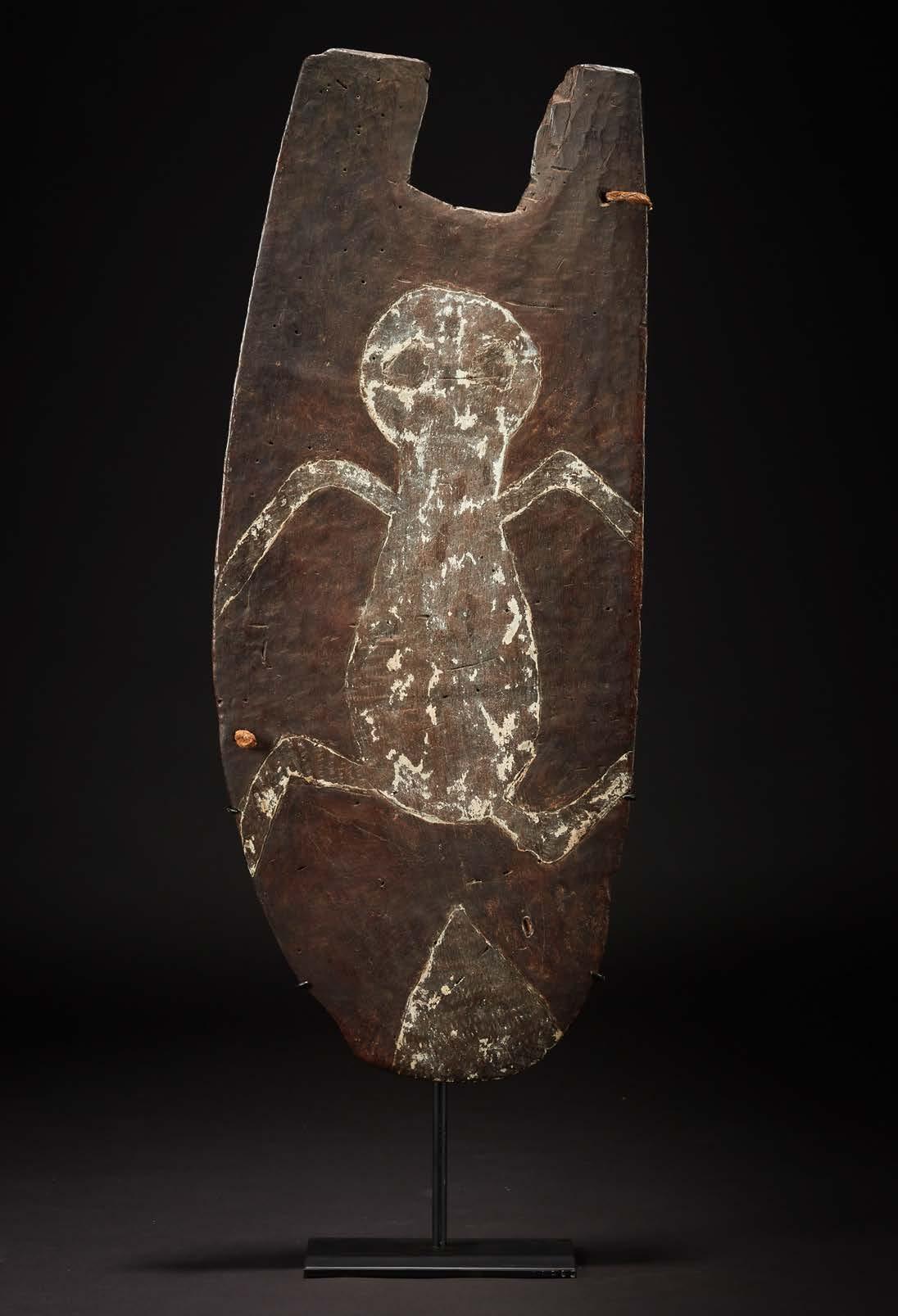
2. POWERFUL FEMALE FIGURE, KORLU
Sawos region, inland Sepik River region, Papua New Guinea. 19th Century.
Provenance: Collected by Keith Buxton, Numangwa village in the late 1960s.;Ex-Roy Boylan 1971-78; private collection Chris Boylan til present.
This of one of only a few significant examples of Sawos Female Cult Figures. It is stone-carved and dates to pre-contact times – mid-19th Century or earlier.
Traditionally these important figures were housed in the Men’s Ceremonial House, attached to the rafters or a main post; hidden from women and uninitiated males. Offerings were hung from the hooks; offerings of betel nut or sometimes food that would encourage the spirit to protect and guide at particularly difficult times.
The figure is female, with a powerful almost male-like form, with arms and legs apart in a strong protective stance. “Power” emanates from this figure in a potent and protective sense. The carving is superb, attesting that a true master-carver had fashioned this figure. This rather rigid form is typical of Sawos sculpture (Newton:1979,324)
Much of the face was once covered in clay and embedded nassa shells, some parts of which remain intact. Blue German trade beads set within cut conus shells produce an almost terrifying glare; the pierced ears and nose would have been decorated with shell ornaments on special occasions. A semi-circular snake creature on the left of the main torso, and a cassowary head near the figure’s feet on the right were once balanced by similar forms, but were gone long before the figure was collected, as the breaks are old and discoloured.
There are several equivalent important similar figures in collections. importantly one in the National Gallery of Australia, Canberra (2024-683) 1. And another in the former Jolika collection, New York.2. But this figure, despite its missing sections, is far more powerful.
1.”MYTH + MAGIC -Art of the Sepik River, Papua New Guinea”, Crispin Howarth, National Gallery of Australia, 2015,p186-189. 2. “New Guinea Art - Masterpieces from the Jolika Collection, Fine Arts Museum of san Francisco, 2005, “ p260, illus 233 (field photo): Photo, Anthony Forge, 1958-59. Shows the figure, in the Men’s House, Toembi village hanging high in the rafters, that is now in the National Gallery of Australia, (MYTH + MAGIC, 2015).
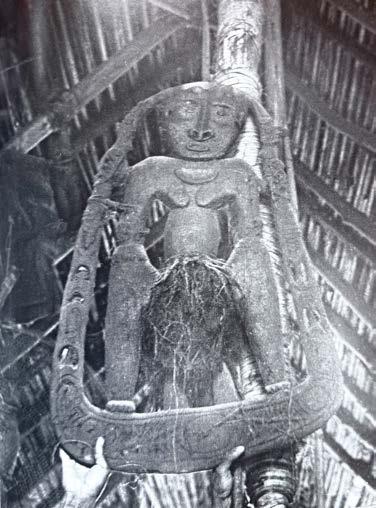
106 x 56 x 15 cm POA

Photo: Anthony Forge, 1958-59. Shows this important female figure, strapped high in the rafters. The figure is now in the National Gallery of Australia, Canberra (2024-683).
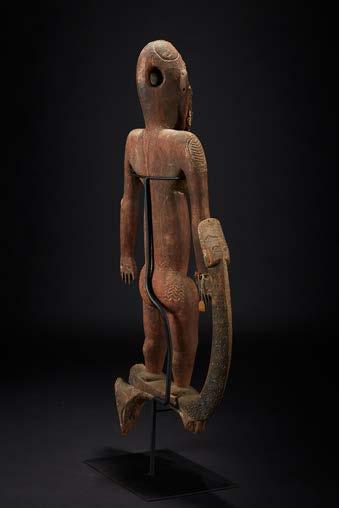

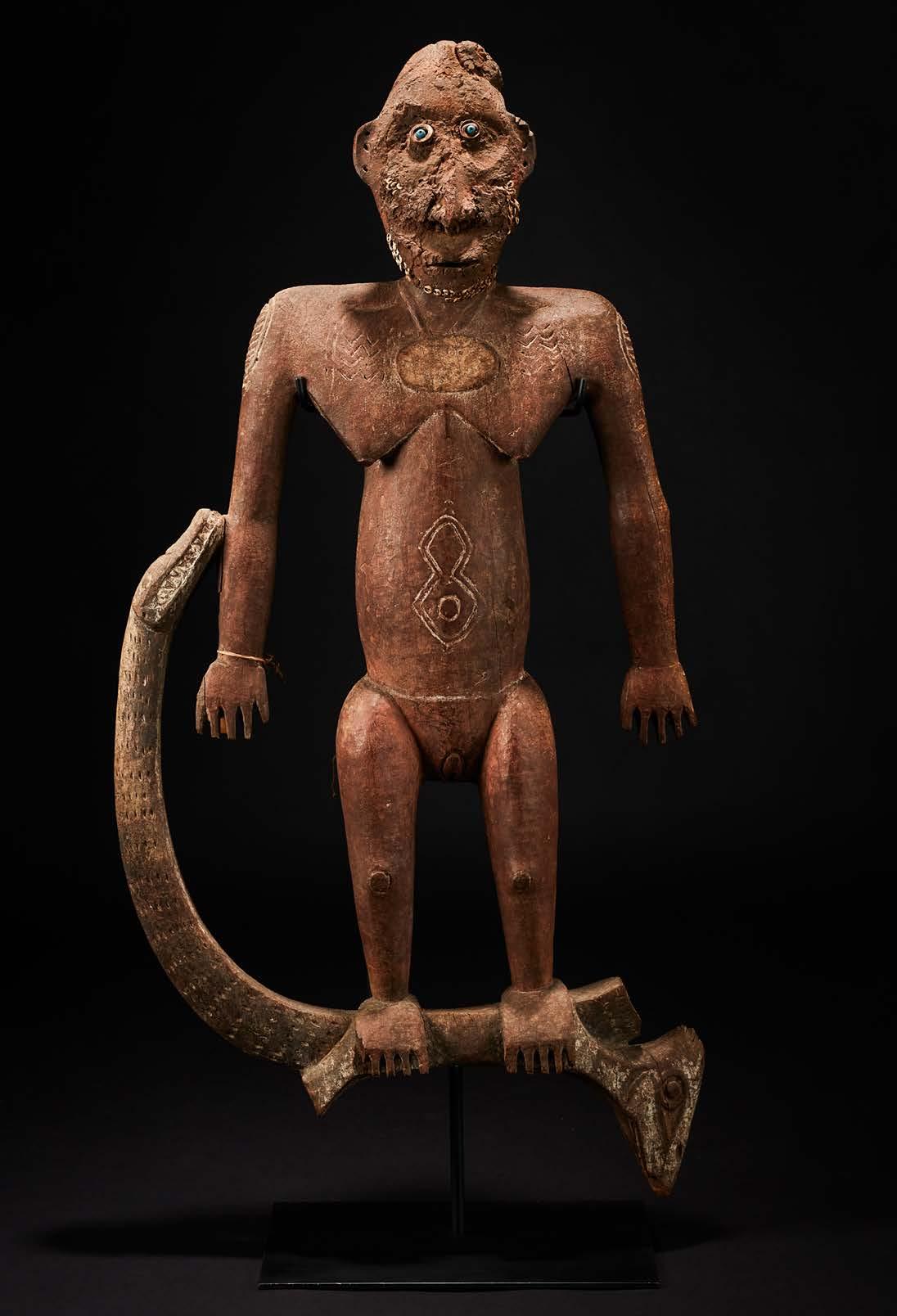

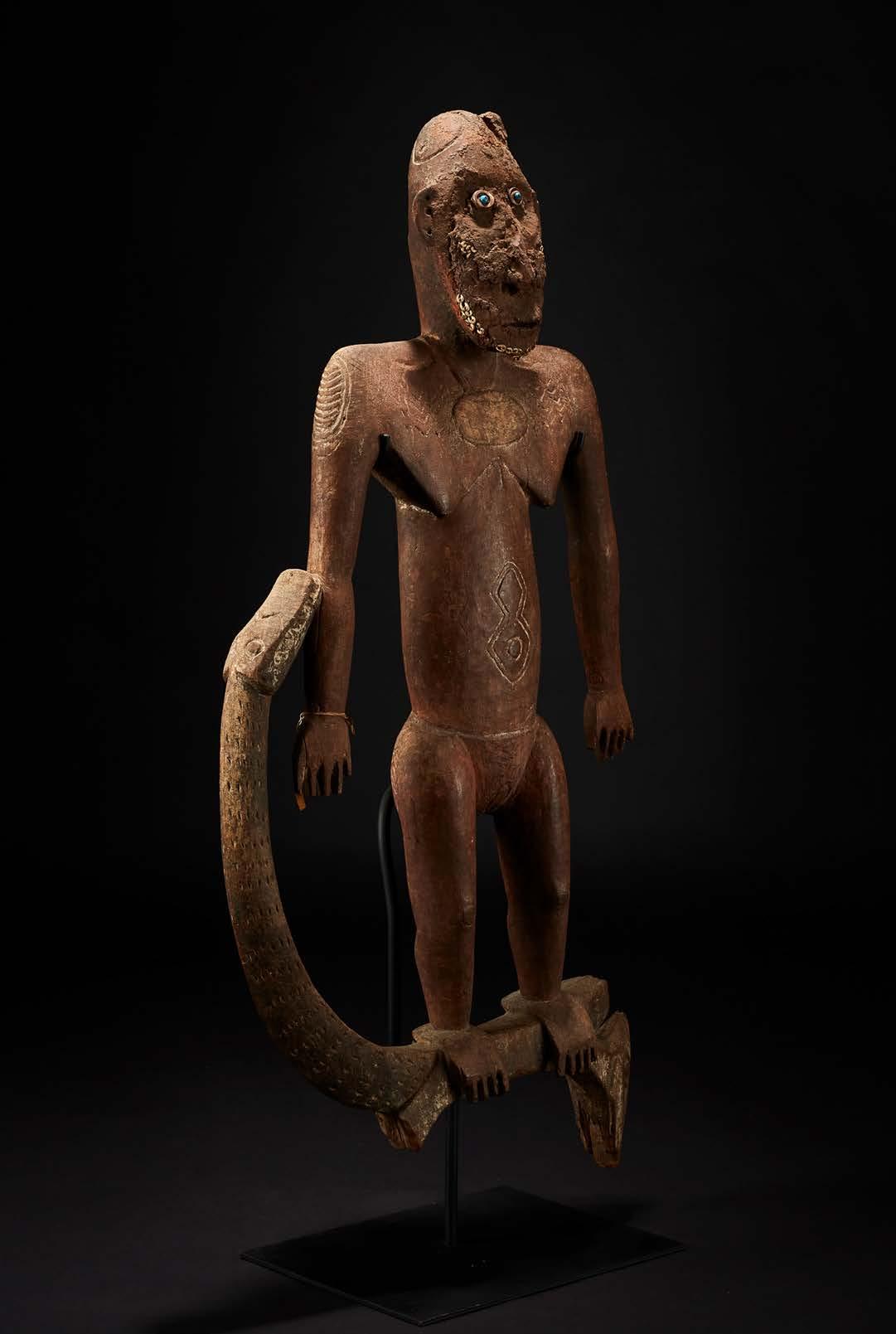

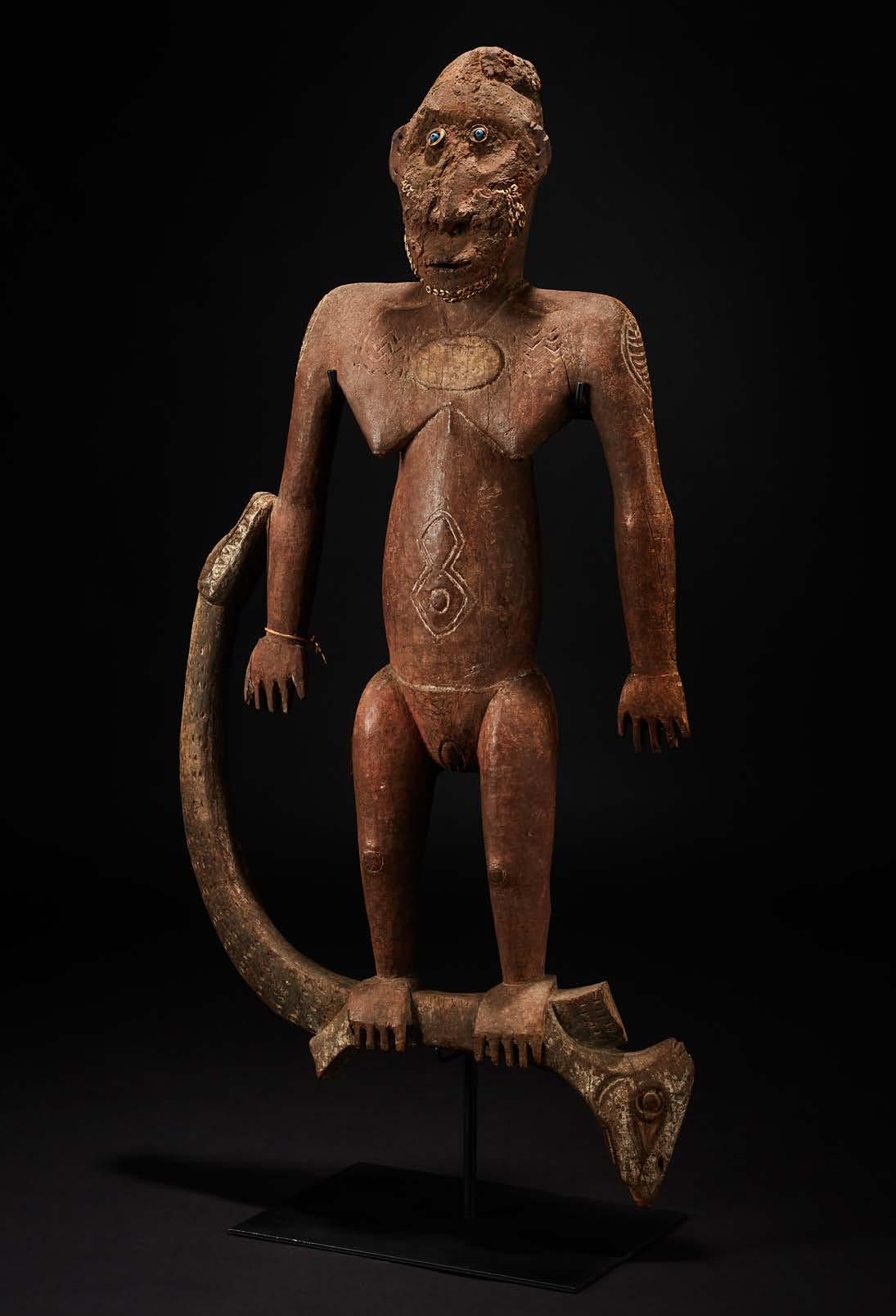

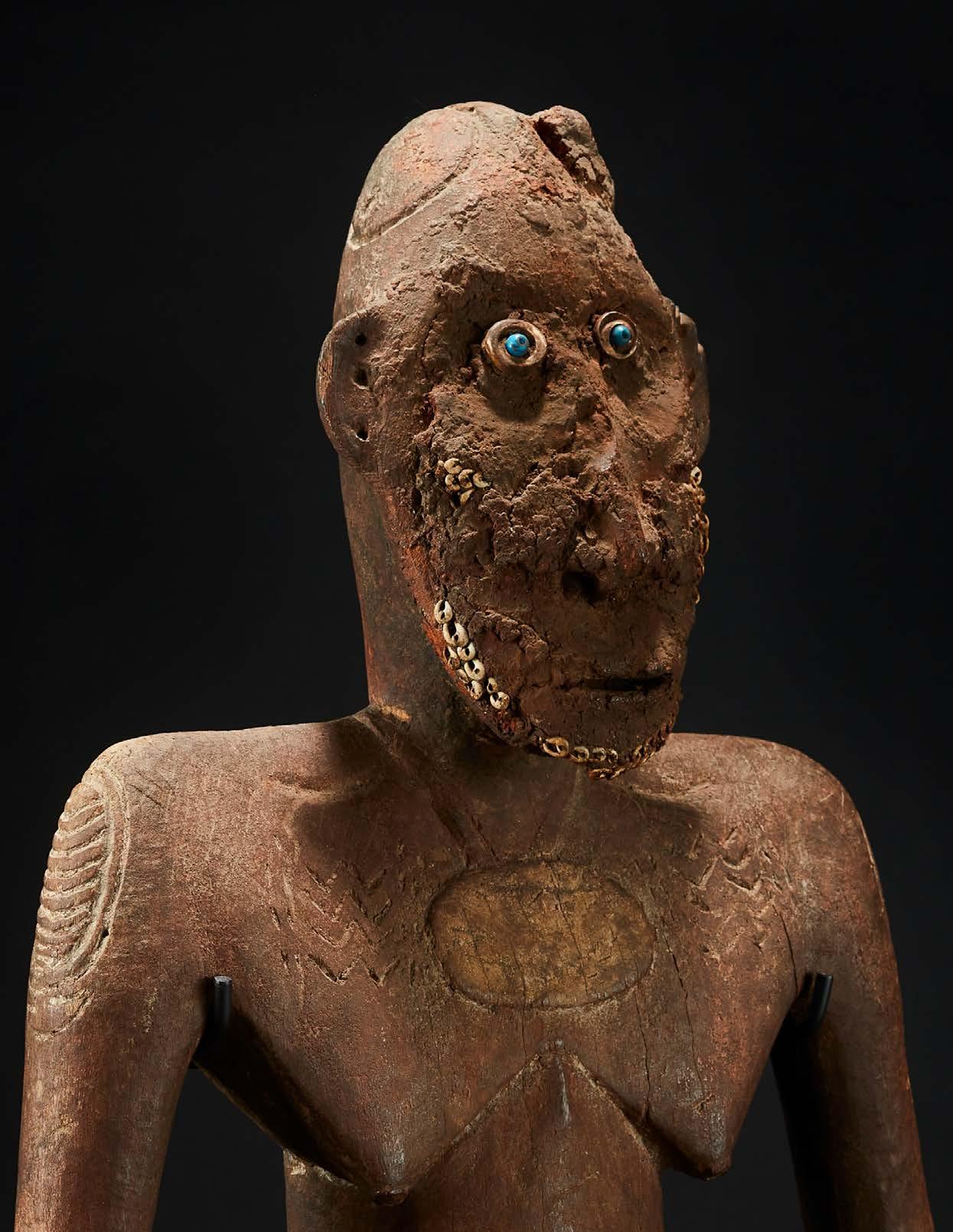

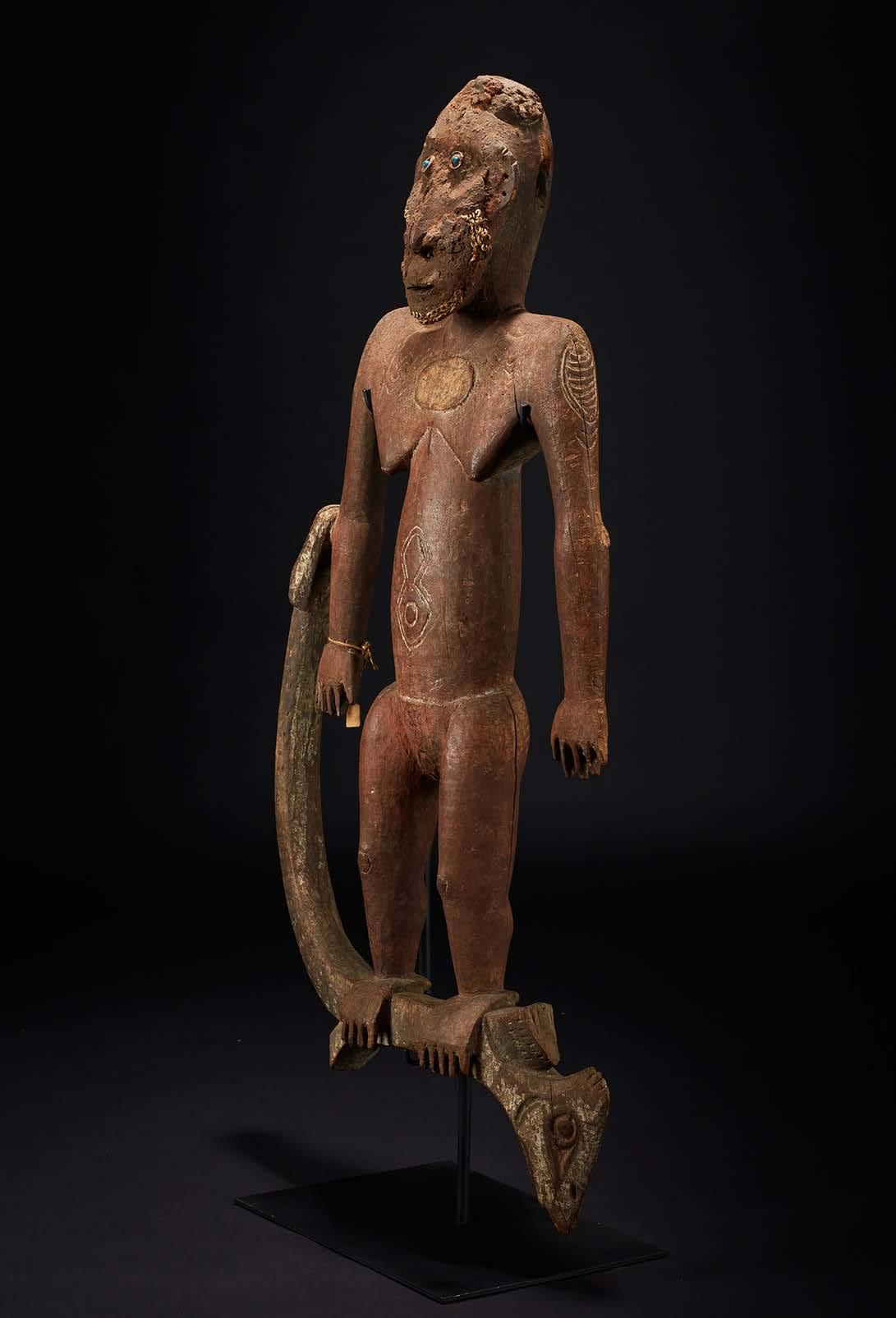
3. EBONY LIME SPATULA
Massim, Trobriand Islands or Woodlark Island. 19th Century.
Provenance: old Sydney collection.
This elegant and rare Massim lime spatula is carved from a dark, dense ebony timber and features two finely modelled squatting figures rising symmetrically from a central engraved ring. Though subtly varied in scale and detailing, the figures mirror each other in form, with the asymmetry characteristic of early traditional carving adding a dynamic quality. The work is richly ornamented with incised scroll motifs, double bird-head finials, and precisely carved ears, hands, and feet—hallmarks of a highly skilled artist. The spatula bears evidence of use, with the lower end darkened from frequent handling and stained with the residual red hue of lime and betel nut mixture.
This spatula was photographed by Harry Beran in 1995 and published in “Mutuaga”(Beran) He identified it as one of only five known double-figure lime spatulas which he attributed to a single, highly distinctive late 19th-century artist, whom he termed the “Master of the Interlocking Scrolls.” Of the five examples, two have early documented provenance: one in the Museum of Mankind, London (accession no. Oc1896.C3.1017), and another in the Pigorini Museum, Rome, collected by Lamberto Loria in 1891 on Woodlark Island.
Of particular relevance is a closely related spatula illustrated in “Massim”, Douglas Newton, Museum of Primitive Art, New York, 1975 (illus. 18), and later sold at Christie’s, Paris, 19 June 2014, Lot 113. The close correspondence in stylistic treatment, compositional balance, and fine detailing confirms that both works were carved by the same anonymous master— identified by Harry Beran as the ‘Master of the Interlocking Scrolls’.
Published: “Mutuaga: A Nineteenth Century New Guinea Master Carver”, Harry Beran, University of Wollongong, 1996, p. 196.
36 x 6.5 x 2.5 cm POA



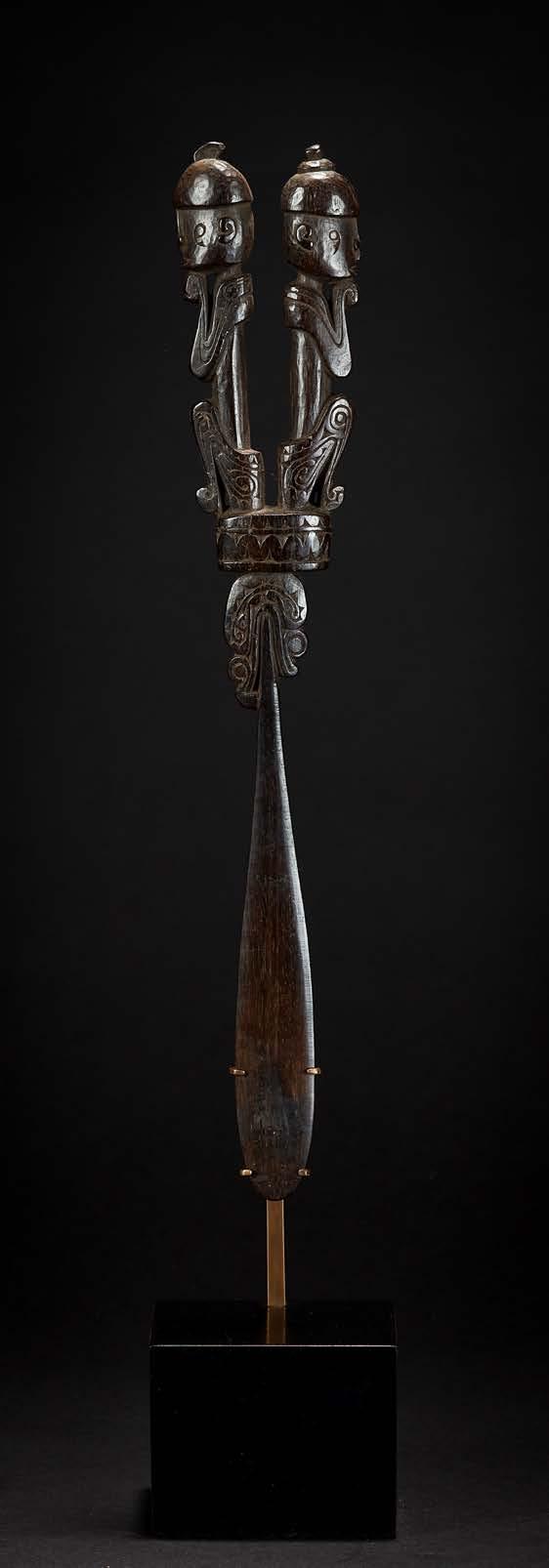
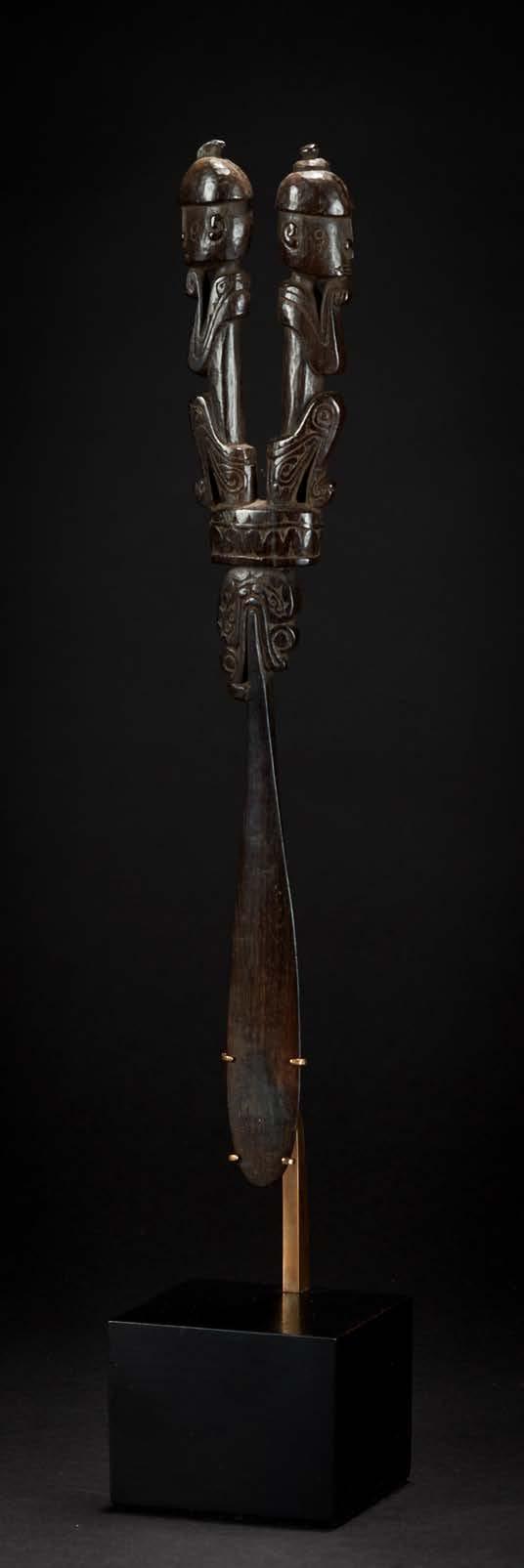

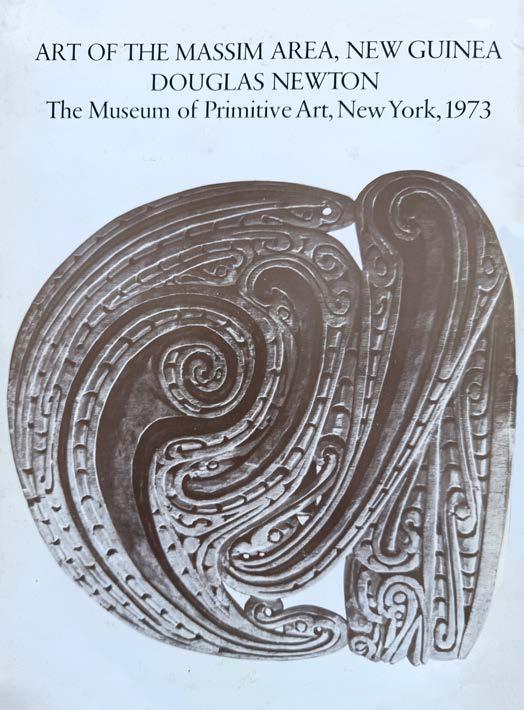
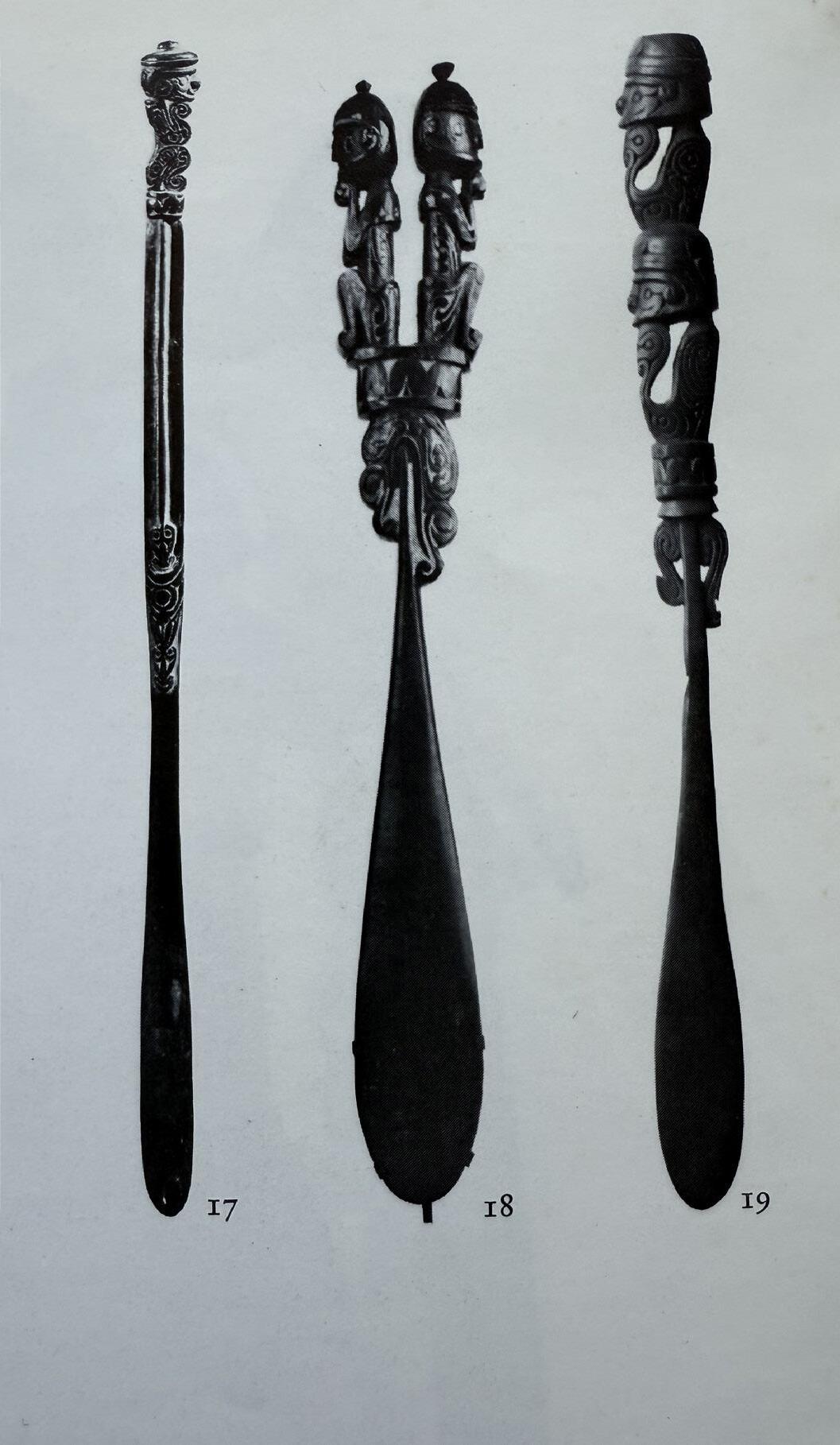

18. Lime spatula: addorsed figures collection Mr and Mrs Gustave Schindler, NY.
Sold Christie’s, Paris 19th June 2014 lot 113

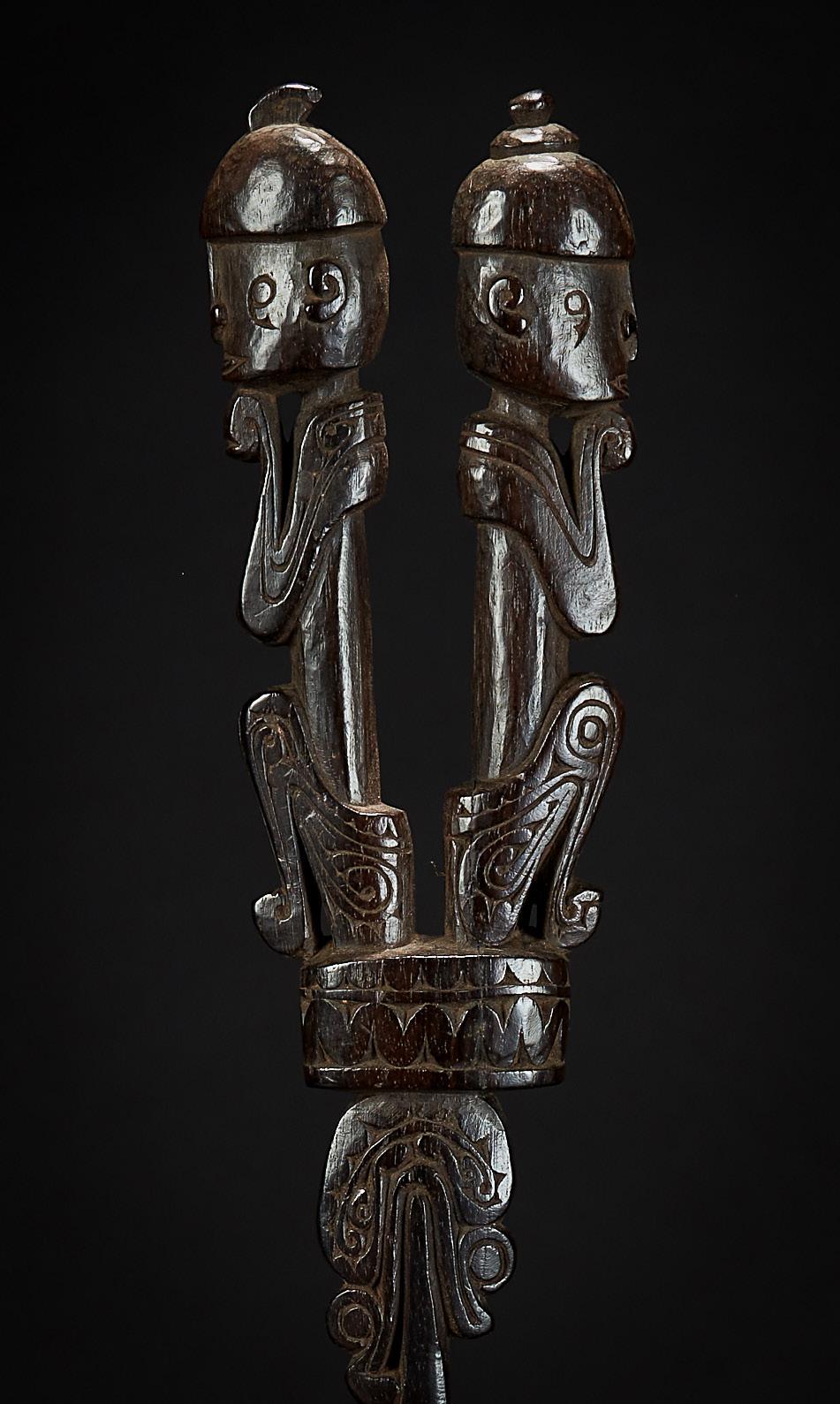
4. SPIRIT BOARD
Gope, Era River / Wapo Creek, Papuan Gulf, Papua New Guinea.
Provenance: collected by George Craig in the 1960s when living in the Papuan Gulf; ex-important Tahitian collection.
This is a very large and expressive gope board, withew a slight curve that indicates it was carved from the side of a canoe. The most important and powerful gope were carved from the sides of war canoes. Wirz wrote in the 1930s that the most significant gopes were owned by the clan and had personal names. They were kept inside the Ravi, the Men’s Spirit House, in clan cubicles. These cubicles were covered in gope boards, but the important ones had pride of place. Gope boards have variously been described as representing ancestral beings, or spirits but whichever they are, they were consulted at times of warfare, hunting and other important events.
The raised carved design on this gope is powerful and alluring. A simplified figurative form seems to border the gope, with legs and hands, even a suggestion of a penis. In the belly of the board is a floating asymmetric abstracted figurative form. However, the most powerful motif is the face, simply rendered, but surrounded by a nebulous sun-like form. The strength and haunting presence of this gope board is its simplicity – all elements have an ingenious strength with austerity. The face again is central to this potency, with its wonderful asymmetry, the raised nose, the piercing stark eyes.
Gopes with this “nebulous sun “ which seems to dazzle the viewer are rare I have located only five others; one collected by Paul Wirz (1930s) and three collected by Thomas Shultze-Westrum (1966). The fifth is in The Hood Museum of Art, Dartmouth College, Hanover, USA.

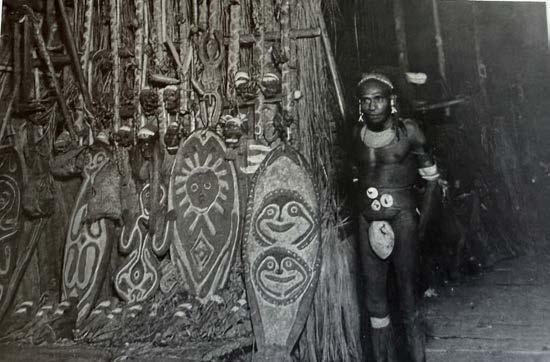
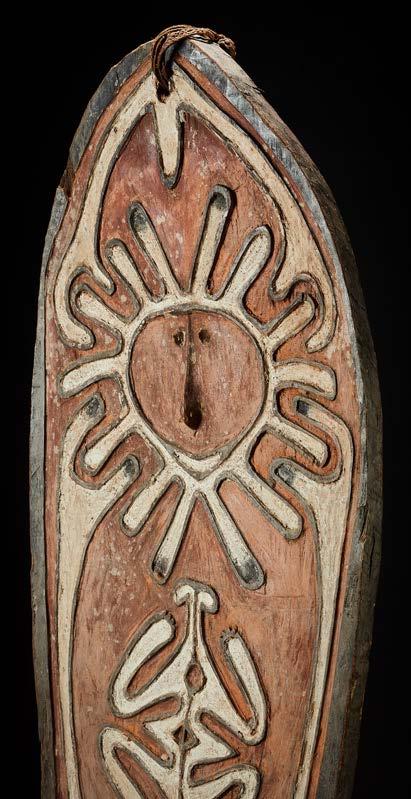
147 x 52 x 4 cm
POA Photo: J W Vandercook, 1933. Amei village, Era River. Courtesy Metropolitan Museum of Art, NY.

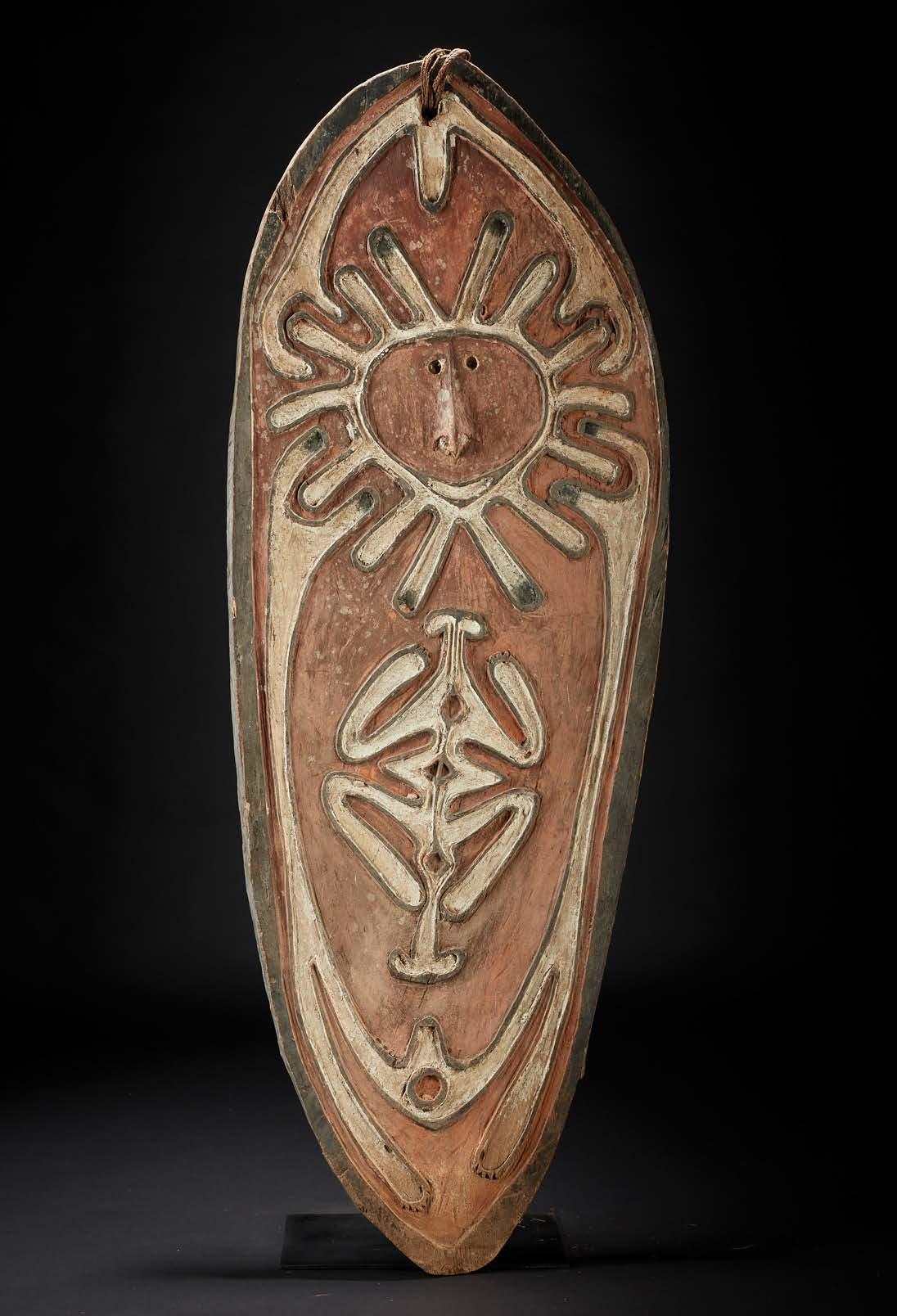

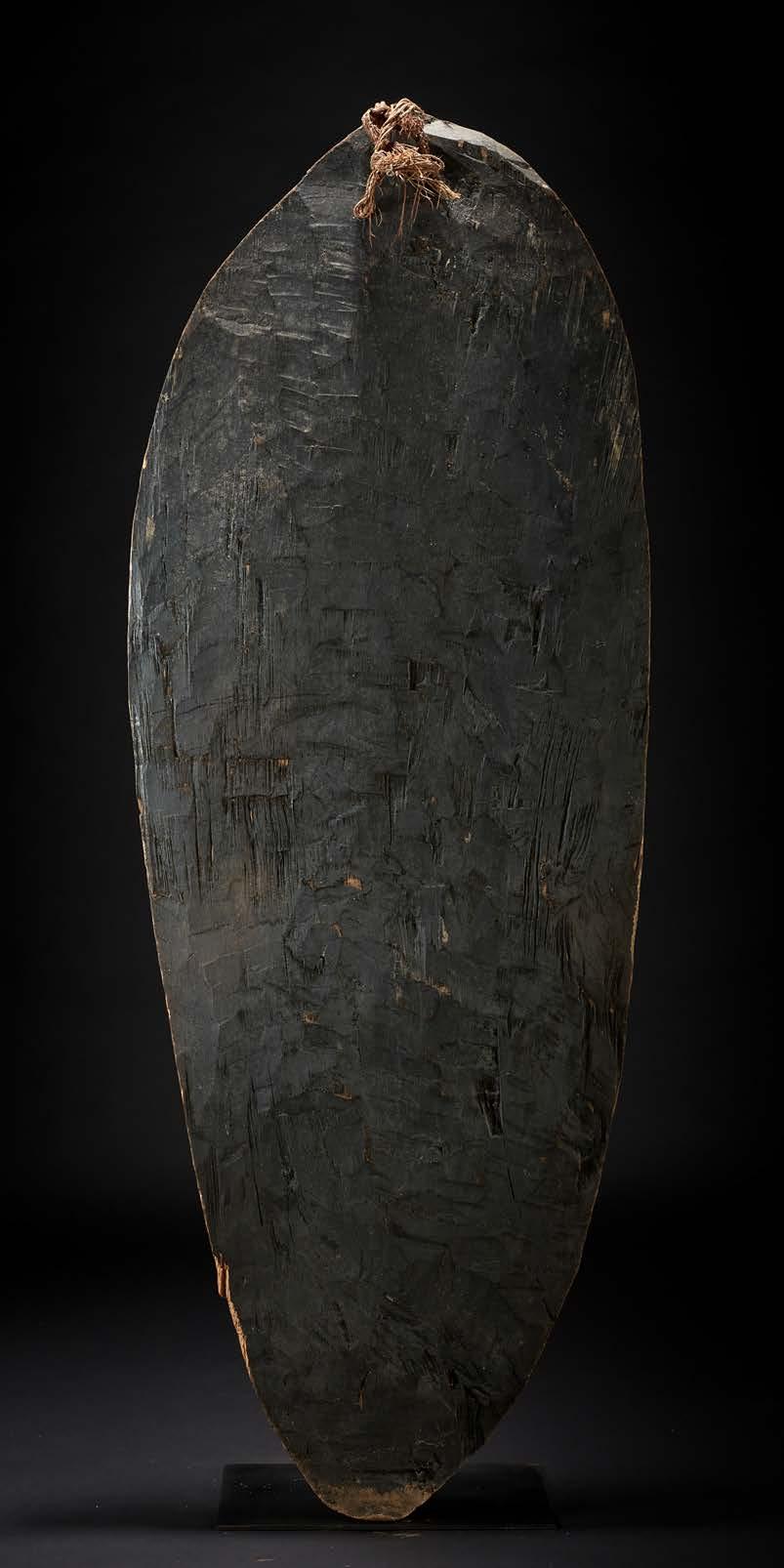
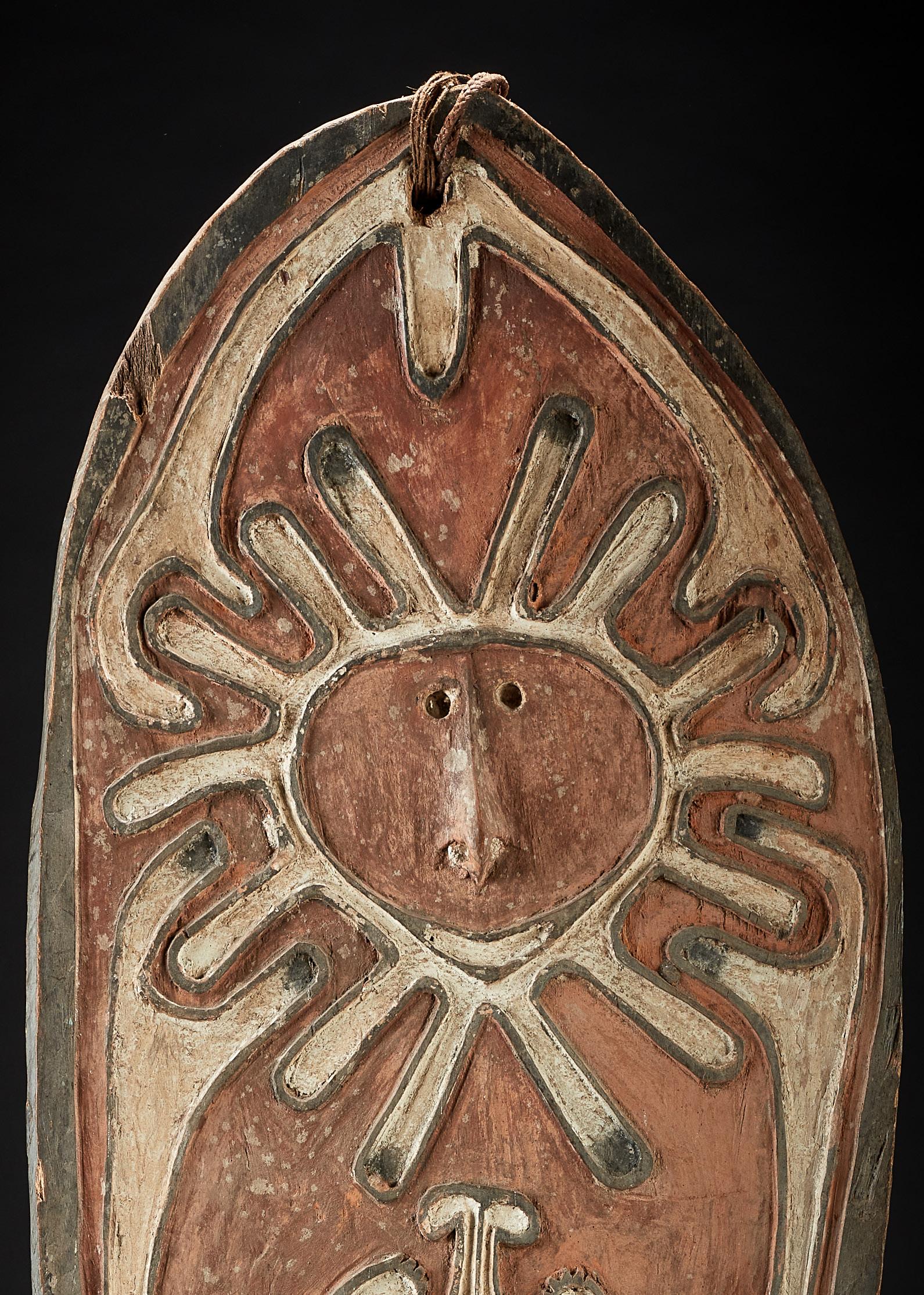

5. EARLY MALANGAN FUNERY FIGURE
New Ireland, Papua New Guinea early 20thC.
Provenance: originally acquired from a missionary who brought it to Australia following the end of World War I.
ex-private collection Queensland 1971-2010
Ex NSW private collection 2010 to present.
This striking Malangan figure is a superb example of funerary sculpture from northern New Ireland. The tall, singular figure wears an elaborate headdress and stands above a prominent pig’s head at the base—an emblem of wealth, ritual sacrifice, and ancestral connection. Held before the figure’s chest is a large flying fish, its open mouth touching the chin in a gesture that suggests speech or transmission. Two smaller flying fish extend from the figure’s outstretched lower arms to its feet. Flying fish are a recurrent motif in Malangan art and are said to represent “the speech of a leader, travelling far.” More than decorative, these motifs encode layered meanings about the afterlife, social cohesion, and the interconnected realms of land, sea, and spirit. The pig’s head, too, holds powerful significance. It conveys messages of social obligation, ceremonial exchange, and commemoration. As a central element in mortuary feasting, it symbolizes both the material resources invested in honouring the dead and the spiritual bond between the living and the ancestral realm.
1.Malangan sculptures were traditionally created for complex funerary rites and used during ceremonies to celebrate the deceased’s life and status. Intended to be ephemeral, they were commonly carved from lightweight wood, reflecting the belief that their purpose was fulfilled once the spirit had been properly honoured and released. Reference: “New Ireland - Art of the South Pacific”, Michael Gunn and Philippe Peltier, Five Continents, Milan, 2006. pp222

131 x 27 x 24 cm
POA

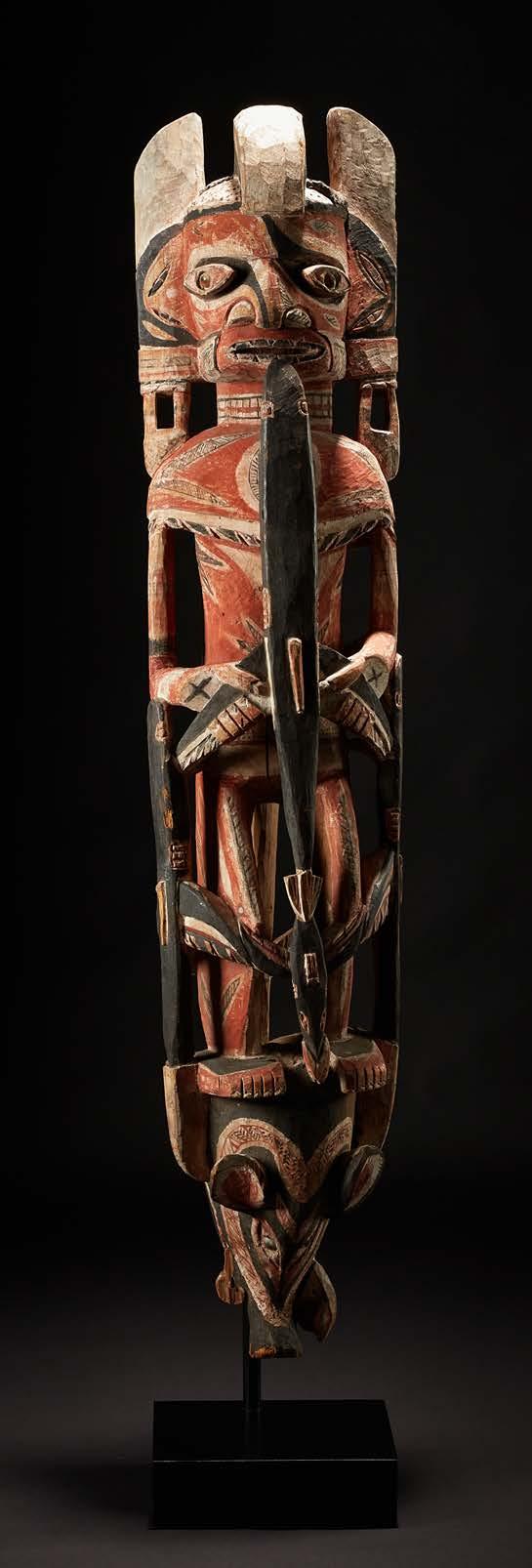
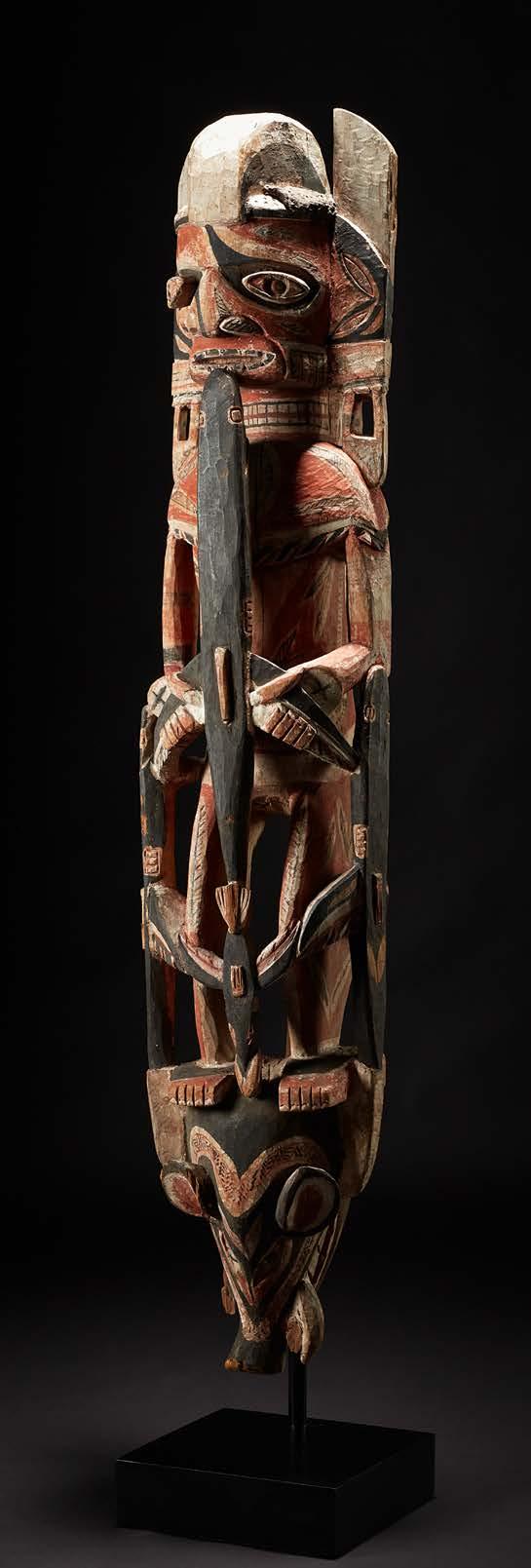

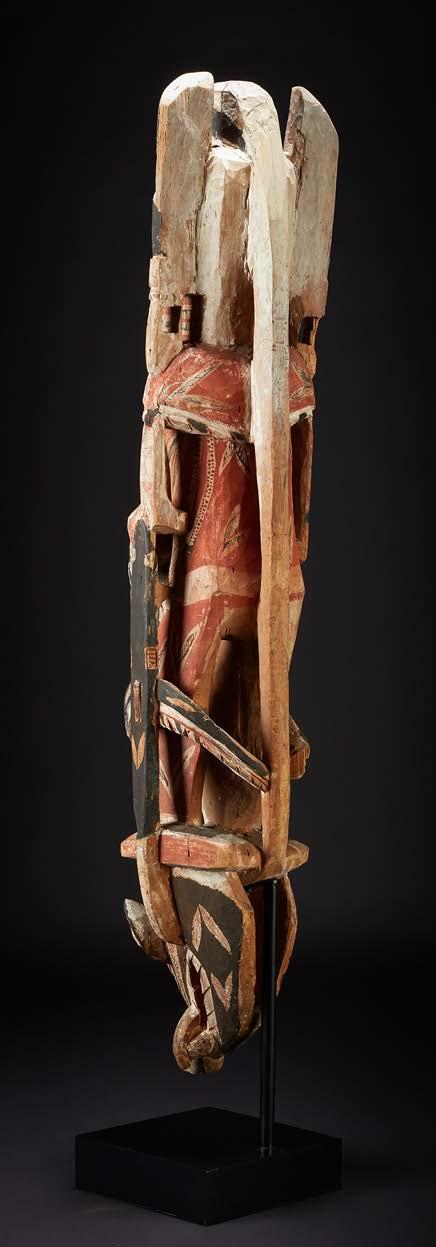
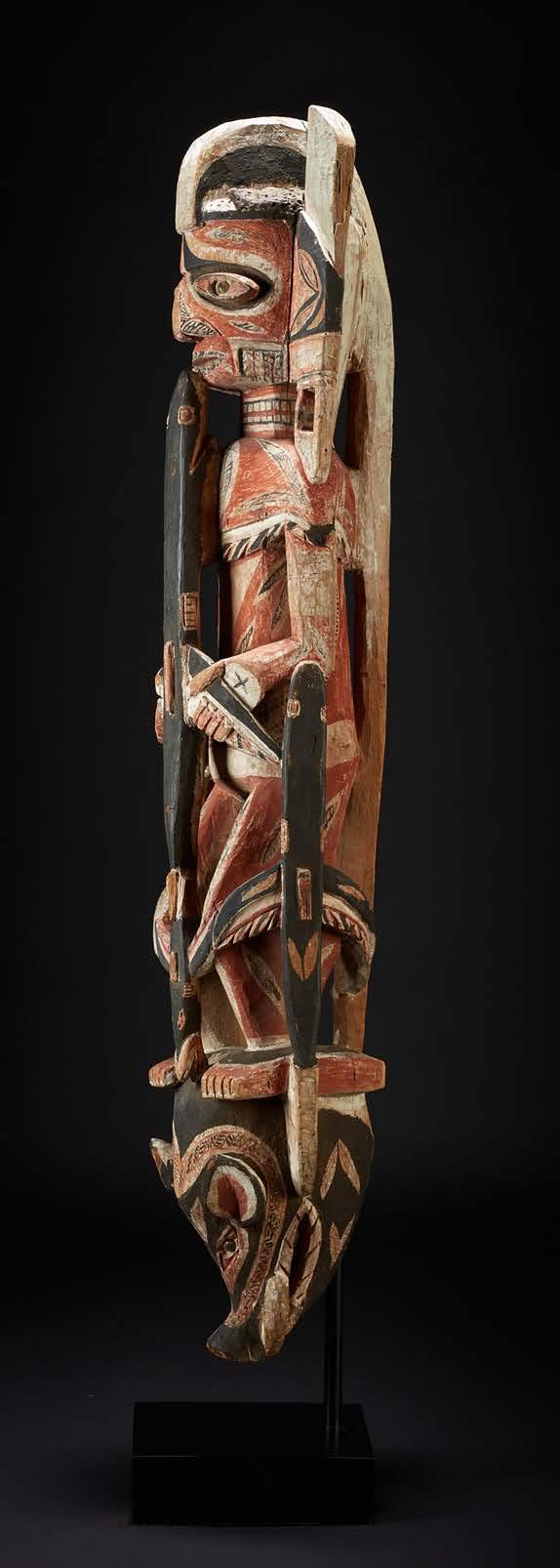

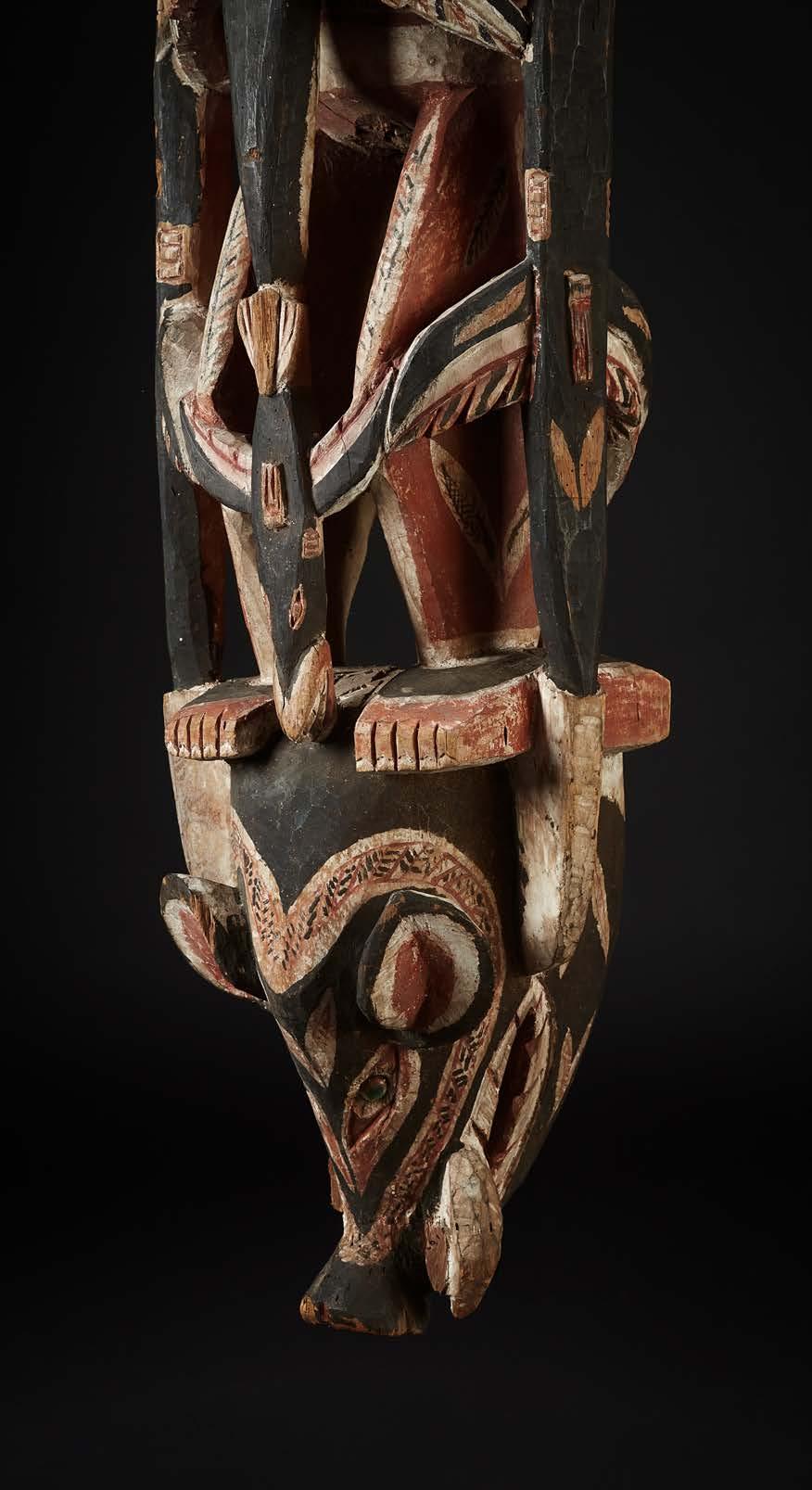
6. WHALE TEETH NECKLACE
Wasekaseka, Fiji.19thC.
Provenance: Purhased from a private collection, The Netherlands, early 1990s; since this time in an important Tahitian collection.
This elegant necklace is comprised of 27 split and polished sperm whale teeth, strung on several lengths of sennit binding. The longest is 16cm. Whale teeth were rare and of enormous prestige worn only by the chiefly families. The wasekaseka evolved from the stubbier vuasagal necklace made from the smaller pilot whales when European whalers of the 19thC increased the supply of these much larger whale teeth. The necklace was worn tightly around the neck on ceremonial ocassions, with the tips currving upwards.
42 x 36 cm; longest tooth 16cm

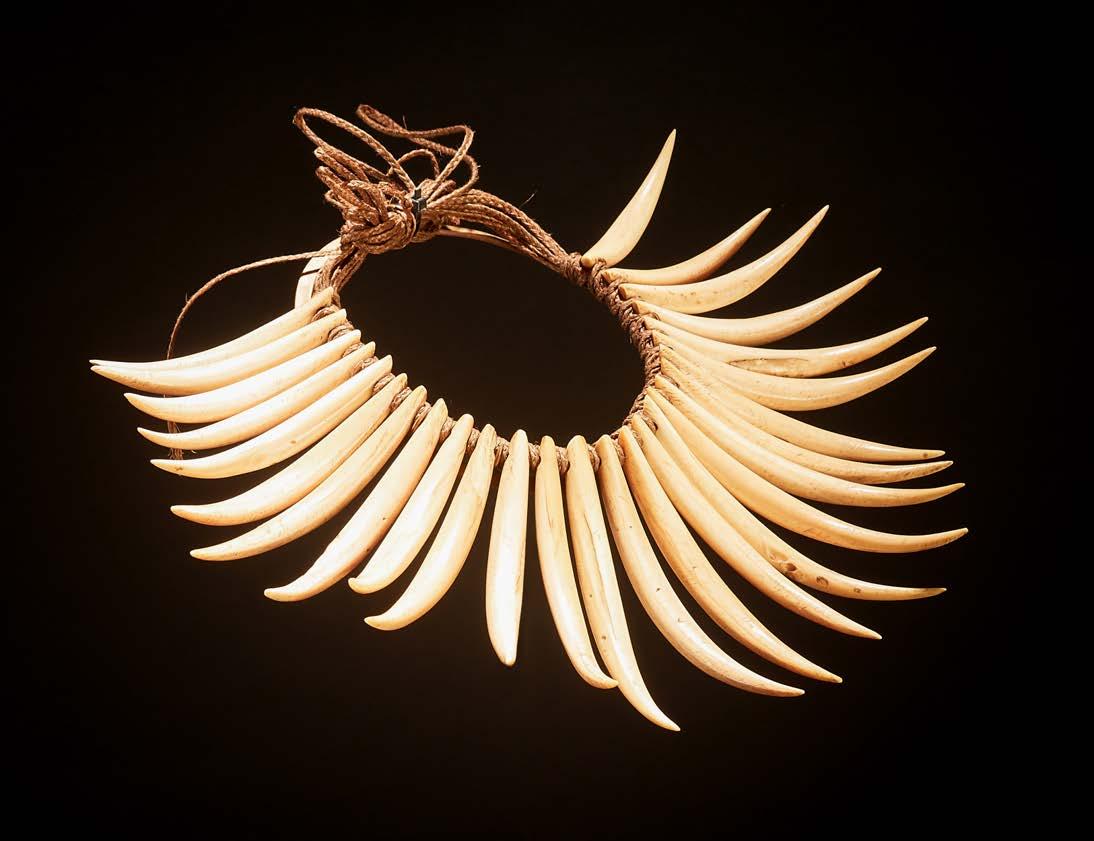

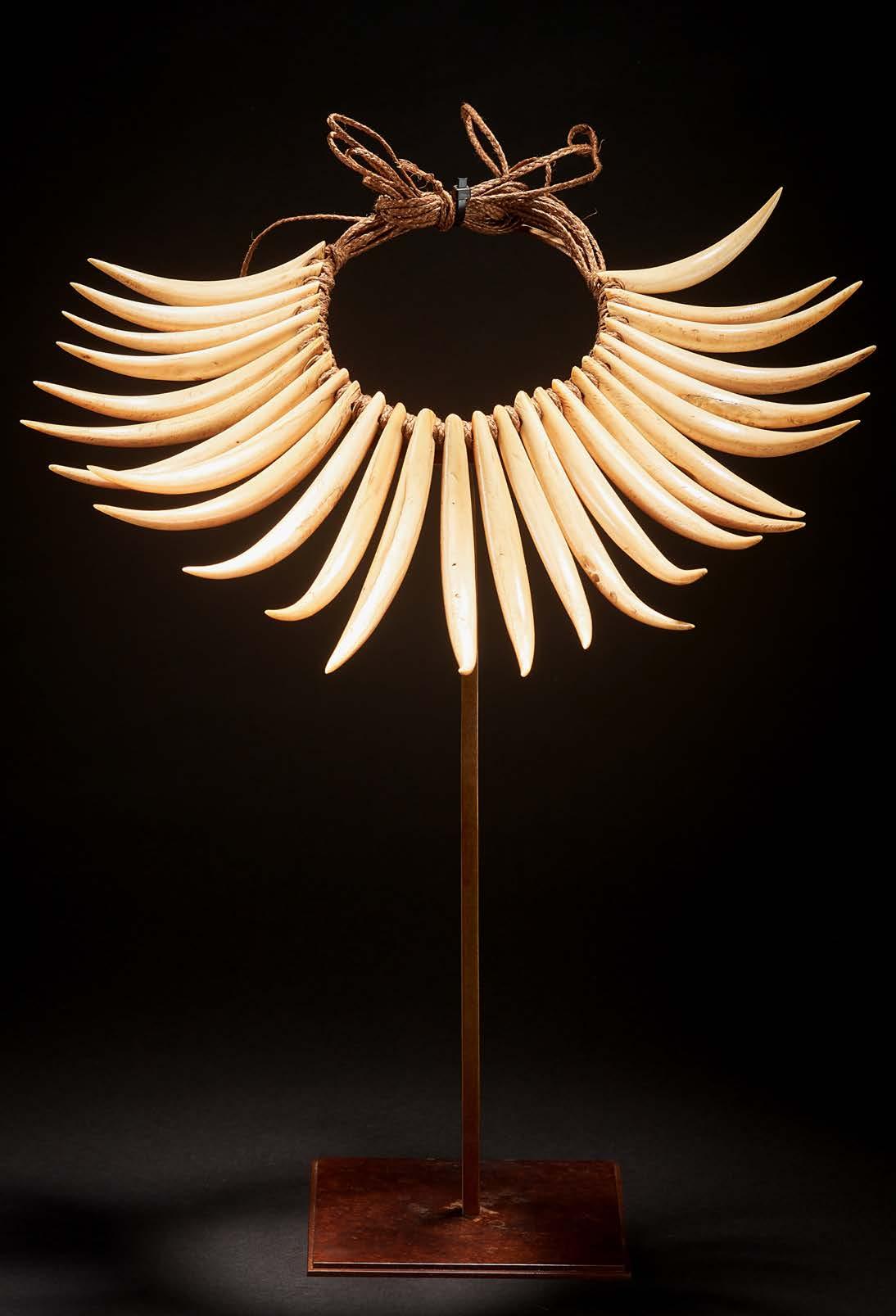
6a. ANCIENT WHALE TOOTH
Tabua, FIJI.19th Century.
Provenance: early Melbourne collection; ex-Alex Philips, Melbourne.
This whale tooth is ancient, cut from what must have originally been a much larger tooth, as both ends are solid with drilled holes. The coloration and grain of this tooth gives it an ethereal presence. These teeth, from the lower jaw of the sperm whale, were highly prized by Fijians, generally shaped and polished by Tongan craftsmen, and used in a range of priestly and chiefly roles. They are traditionally worn around the neck, using a plaited sennit chord.

€ 1,800
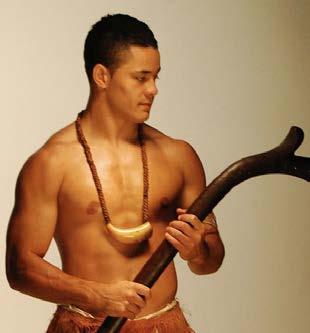
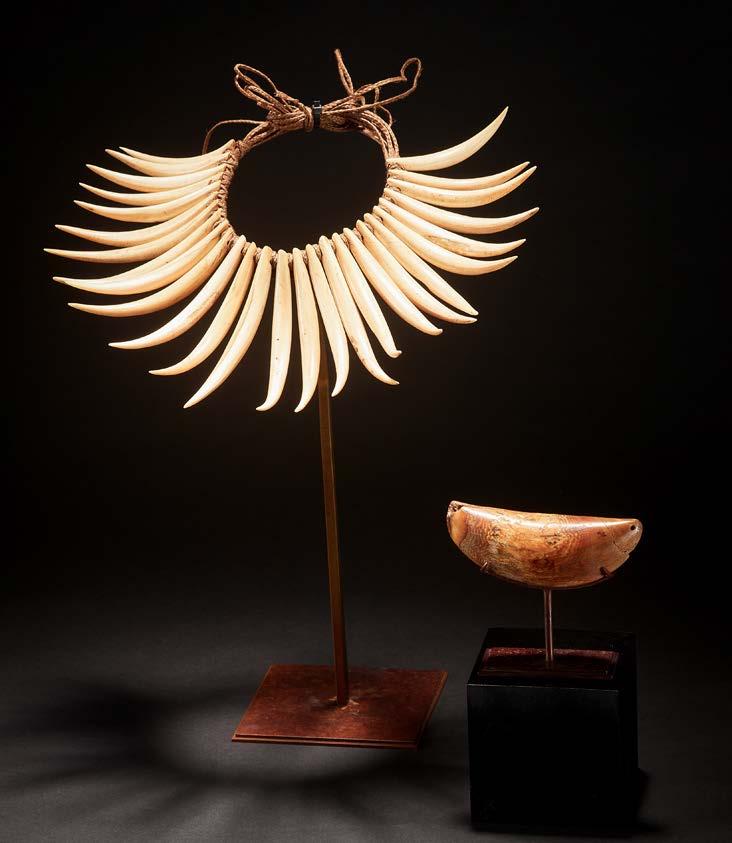
15.5 x 6 x 4.5 cm
Young Fijian wearing a tabua necklace

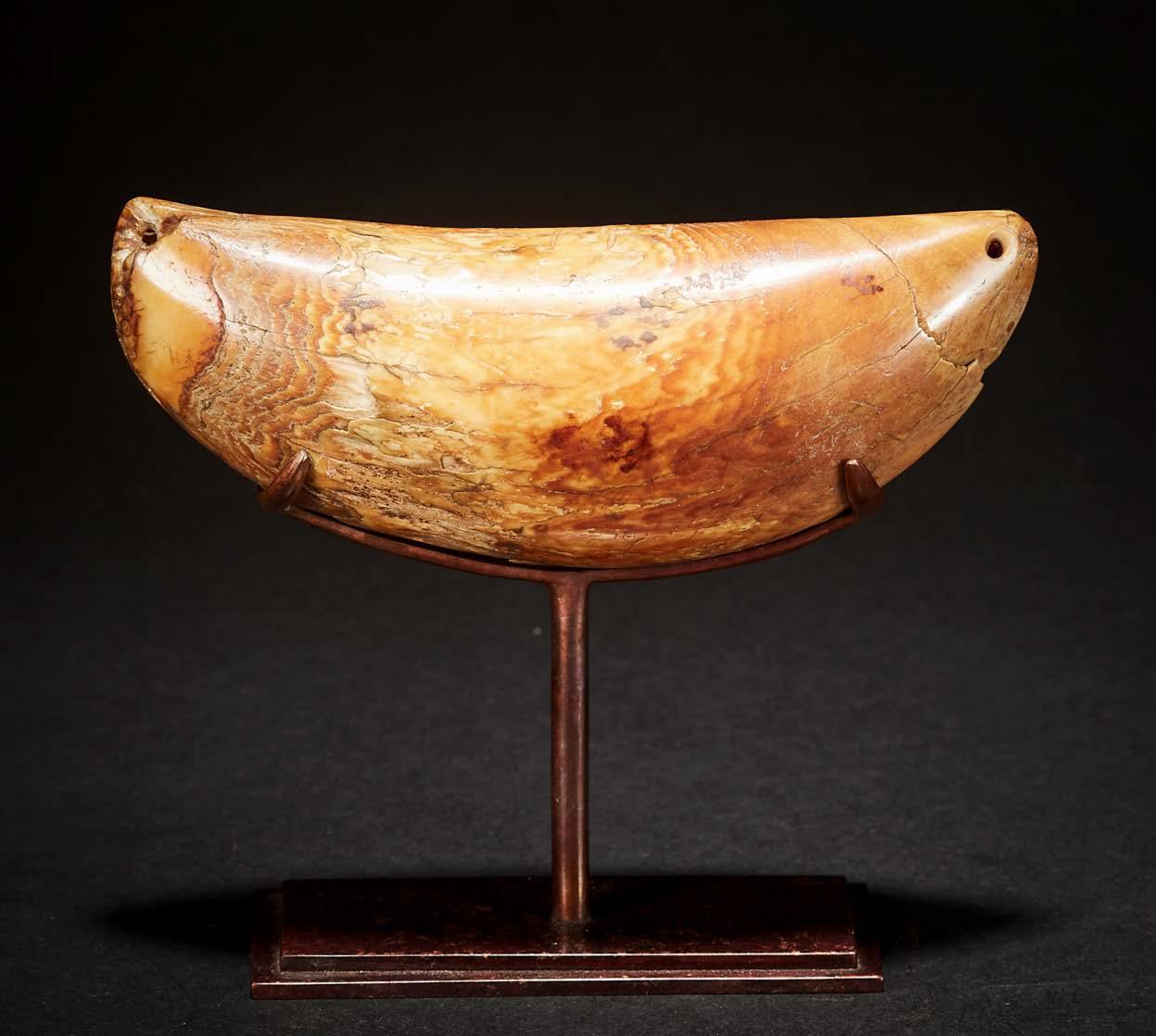

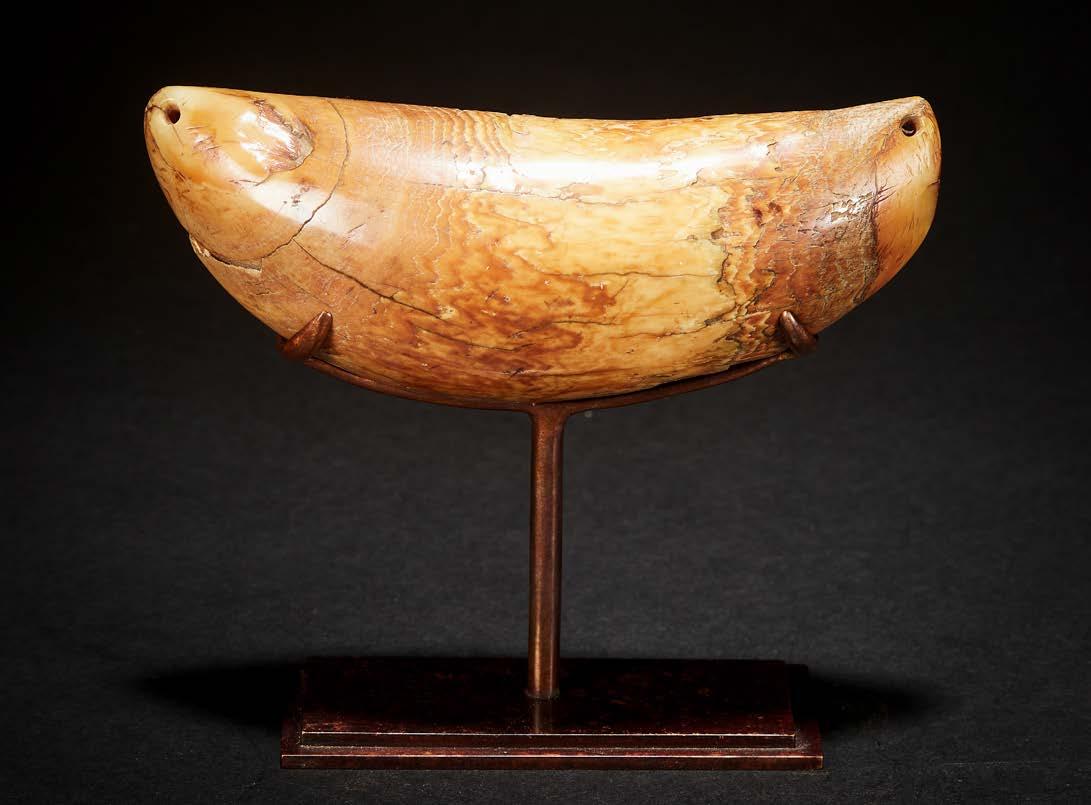
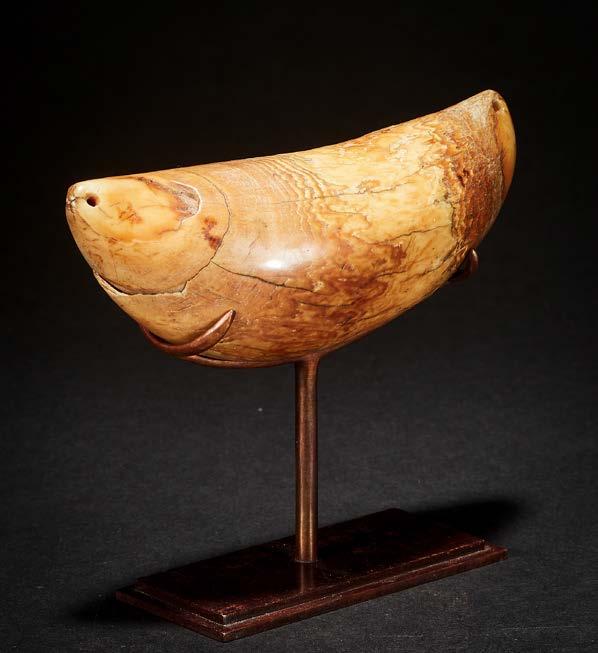

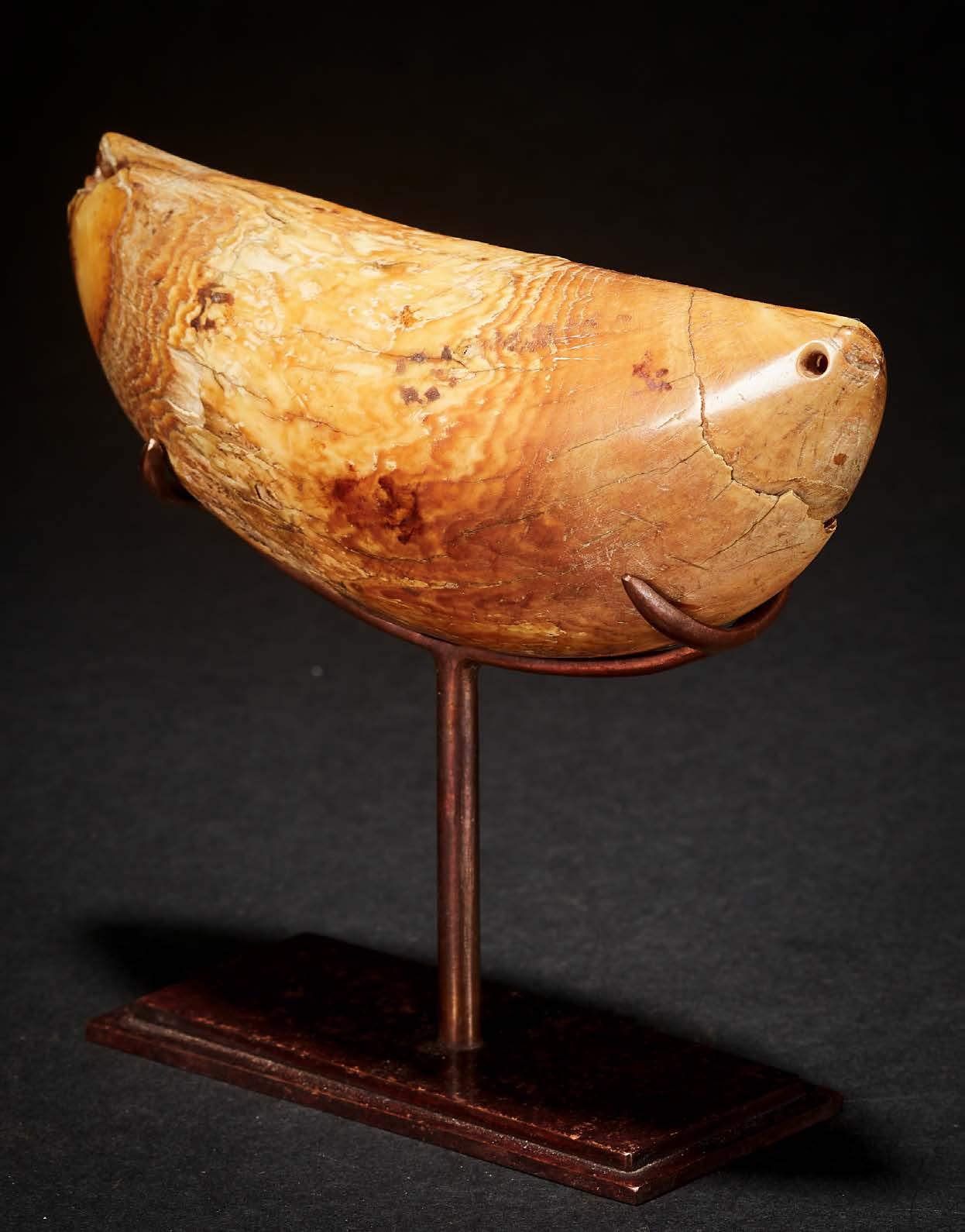
7. FIGHTING SHIELD
Upper Lai Valley, Southern Highlands, Papua New Guinea.
Provenance: Collected in 1992 by Chris Boylan in the Upper Lai Valley.
The shield has a district but abstracted figure, dramatically outlined in black on its variegated yellow background. The “arms” are more like wings, giving it an ethereal presence. This is an old shield, used and re-painted many times, over several generations. This region in the Upper Lai Valley is remote, with no road access, and traditional fighting continued well into the 21st century.
144 x 42 cm
€ 4,500

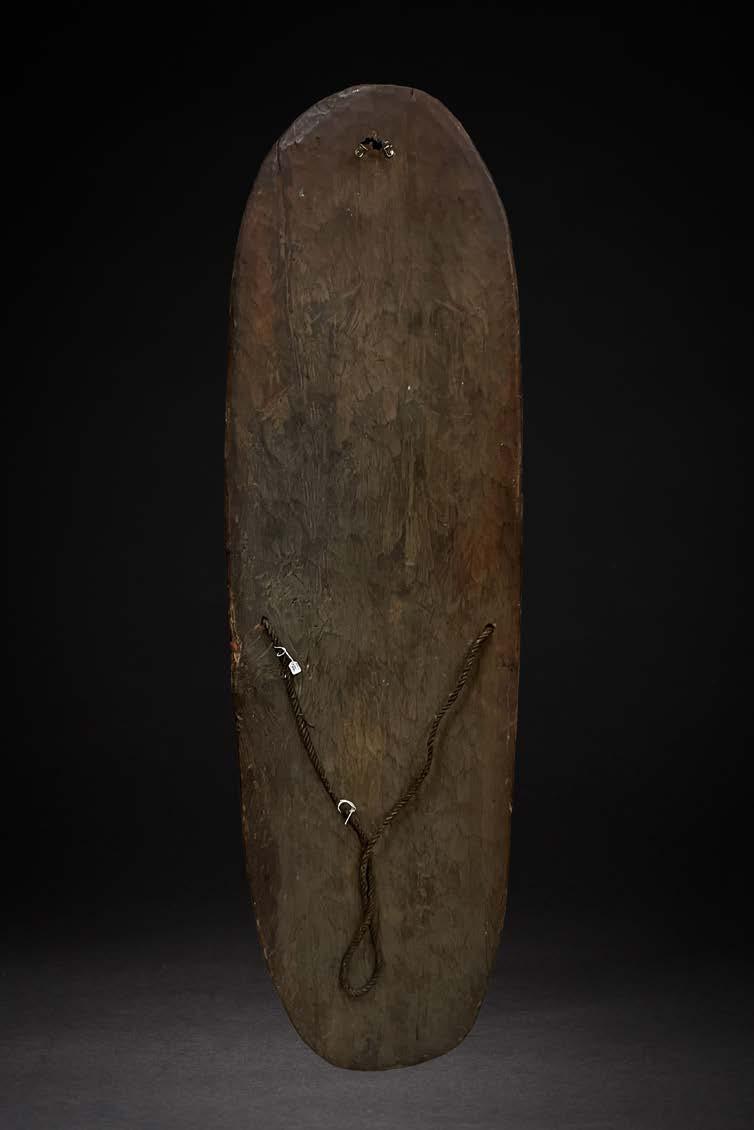

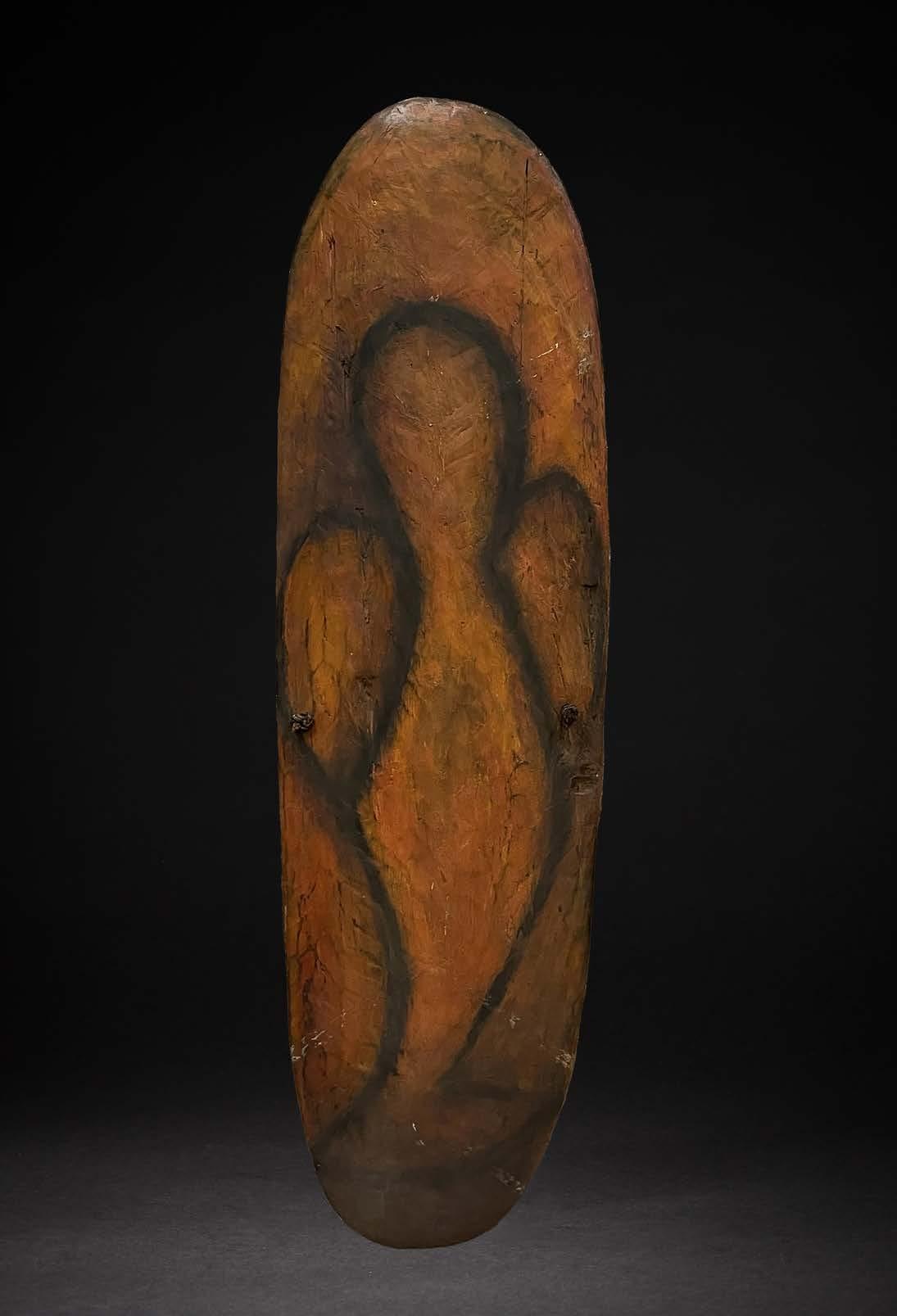

8. OVERMODELLED SKULL
Malekula, Vanuatu.19th / early 20th Century.
Provenance: old collection Belgium; ex-collection Baron Freddie Rolin, Brussels/ Miami (acquired from Franz M Olbrecht (1899-1958) by trade); ex-important Tahitian collection.
This is a superb example of a Malekula skull, overmodelled with a vegetable paste to re-create the deceased. It is wonderfully painted in red and black, with a thick spiderweb wig and a black feather wrapping around the side of the chin. These spiderweb wigs were the priviledge of only the men who reached a very high grade. To make this type of headdress, Malekulans would breed the giant spider (Nephila pilipes) who produced this thick web. This overmodelled shull was most probably mounted on the large human-like body made of vegetable matter, called rambaramp. After a ceremony, the rambaramp with the overmodelled skull was stored in the Men’s House, standing upright against a wall with other rambaramps. The deceased’s spirit was believed to be involved in rituals performed inside the Men’s House. The rambaramp, being made of vegetable matter had a life span of perhaps a generation, after which its deteriorated form was discarded. The overmodelled skulls were often then secured higher into the roof space. Some, perhaps like this one, were especially revered and kept close and protected by the family.
19 x 13 x 24 cm; spiderweb 55cm
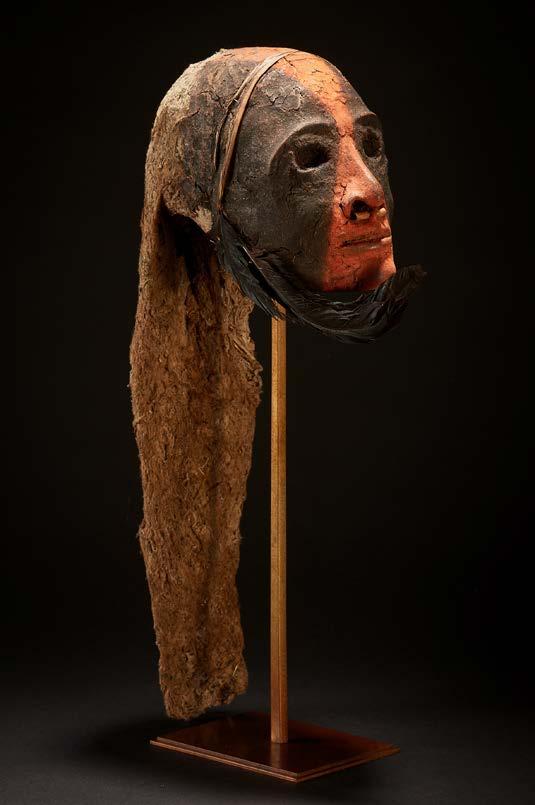
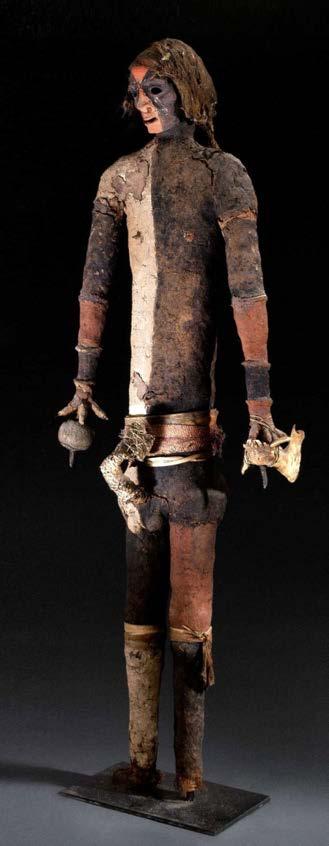
Memorial effigy figure, rambaramp, fashioned after death for only men of highest rank. The body, made of vegetable matter, would slowly deteriorate but the skull was preserved.
POA

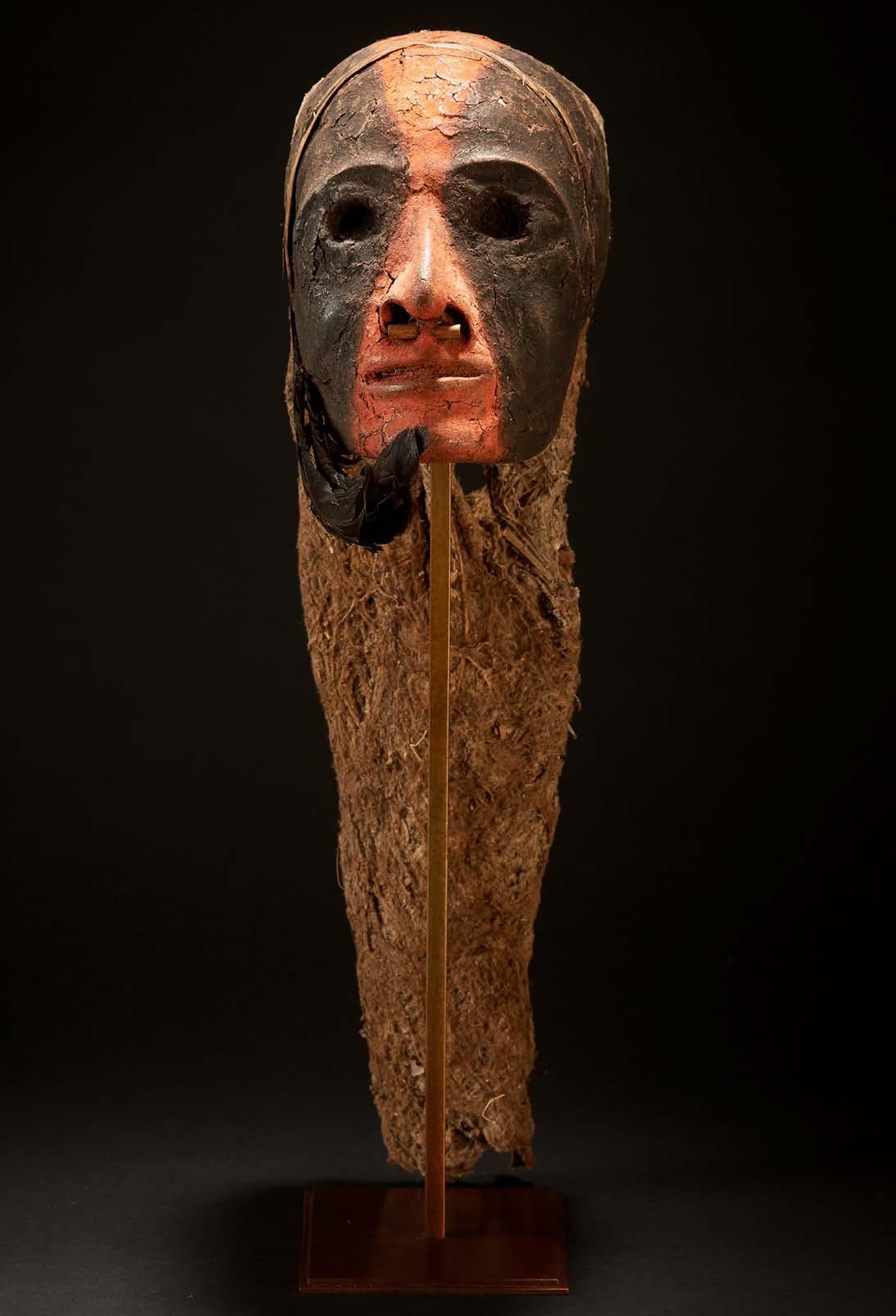

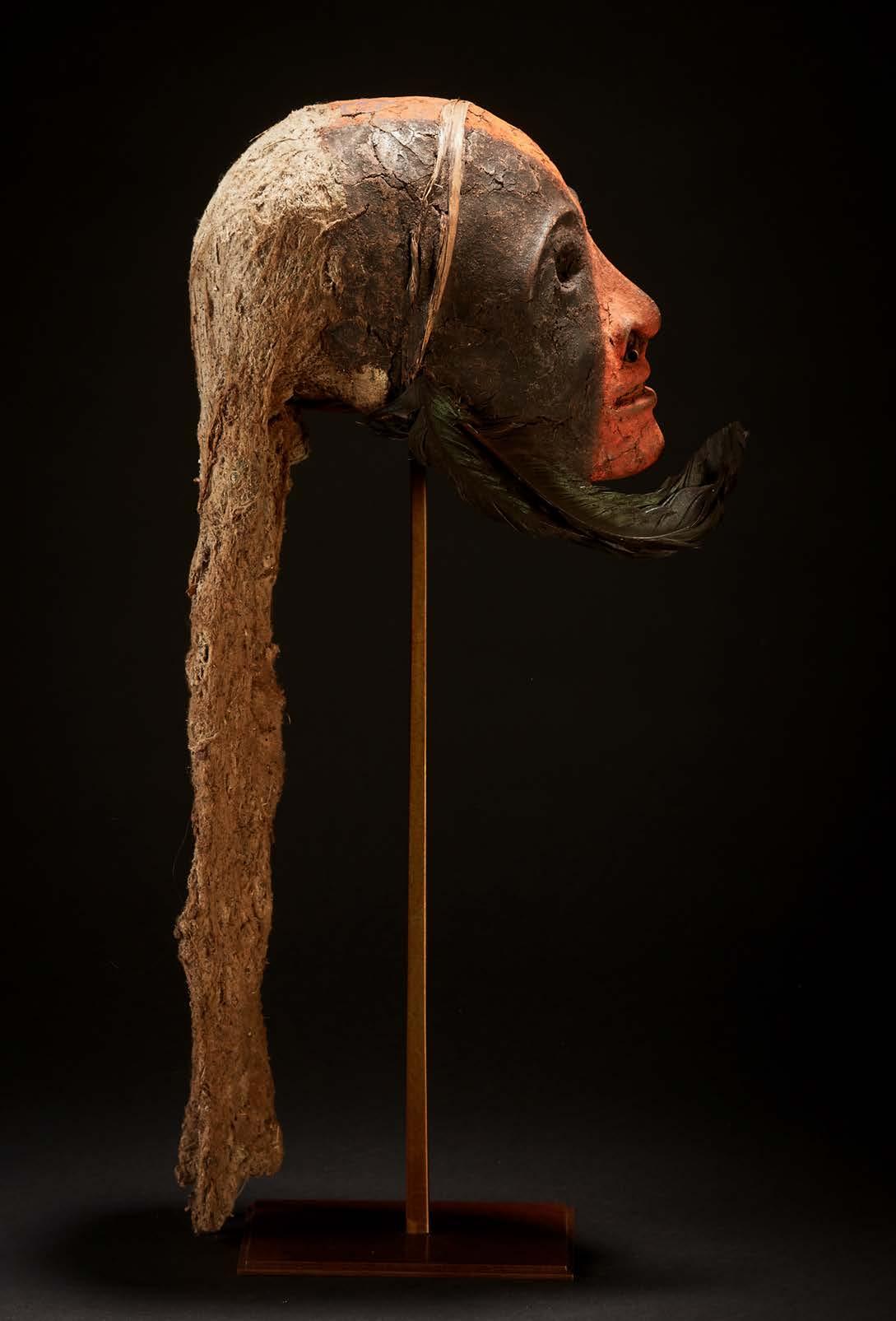

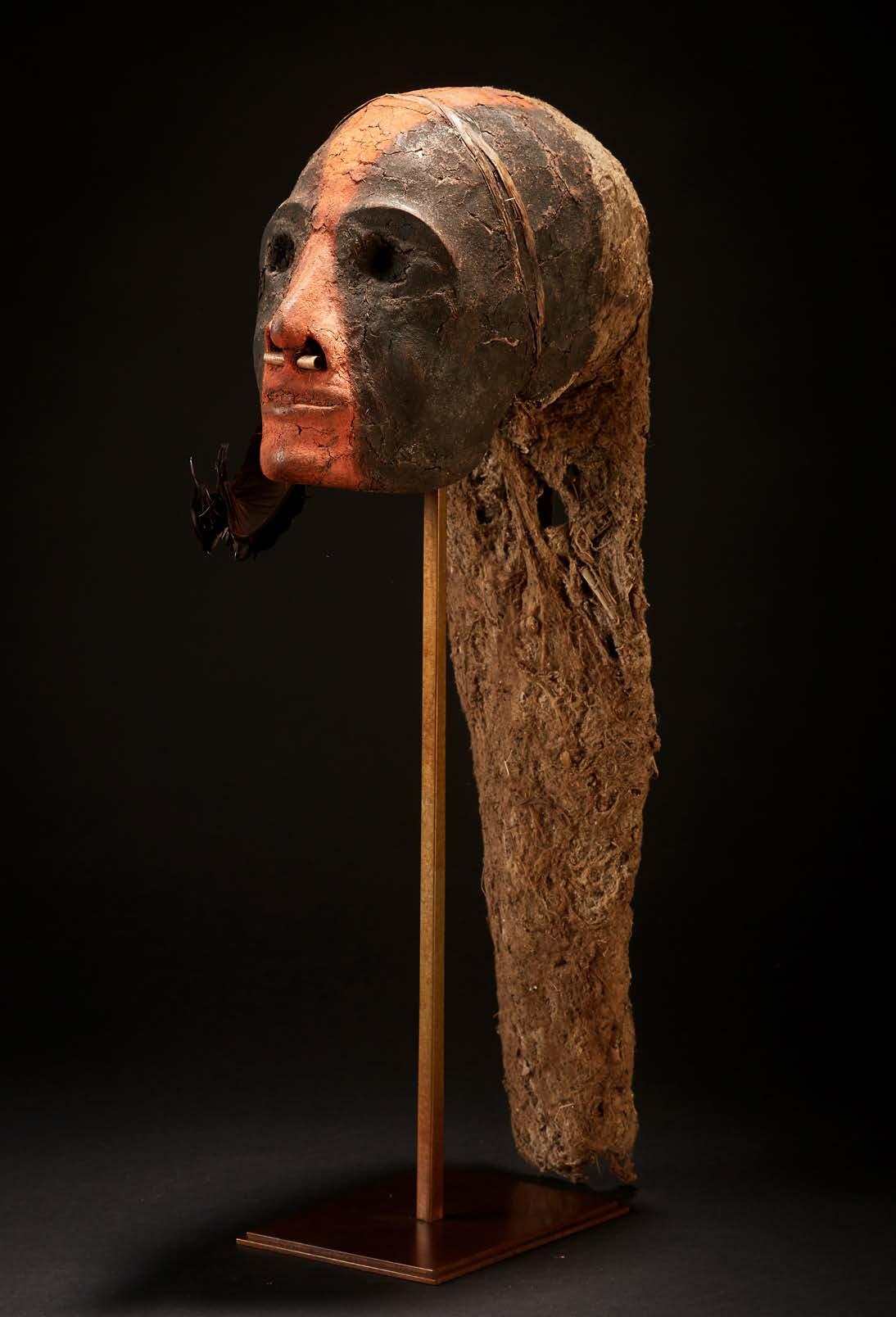

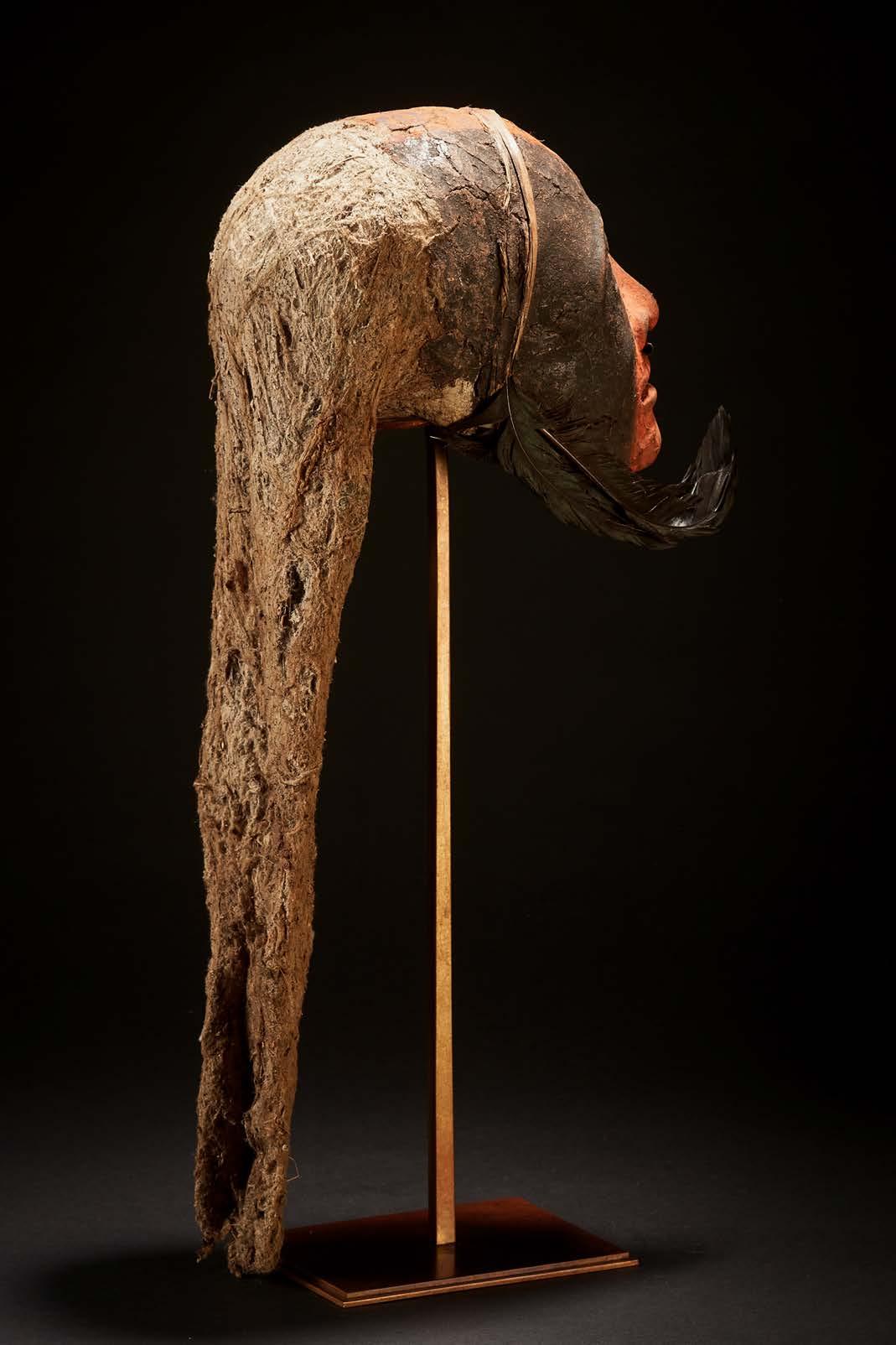

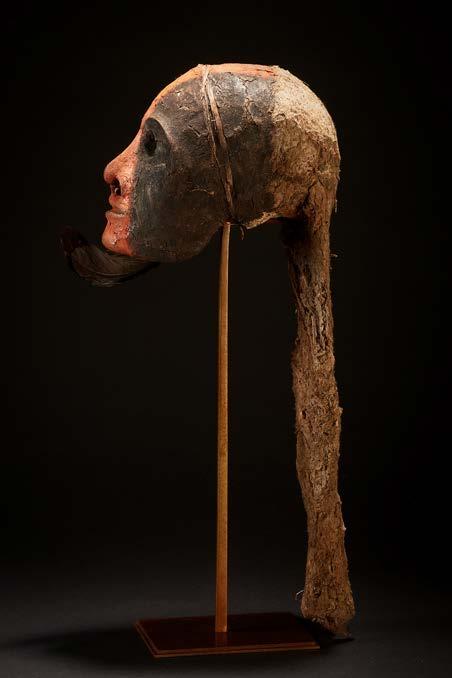
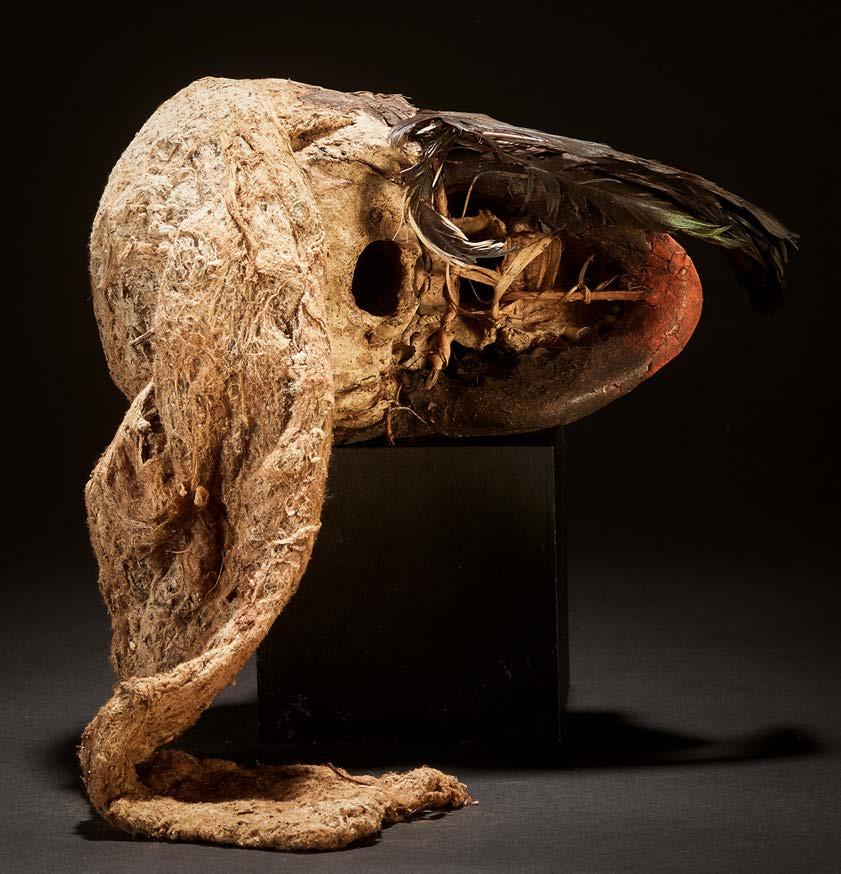
9. OLD FEMALE
ANCESTOR FIGURE
Boiken, Prince Alexander Mountains, Papua New Guinea 19th Century, stone-carved.
Provenance: Ex-Barry Hoare, Papua New Guinea; ex-collection Carl Shipman, Melbourne.
Boiken carving can be considered somewhat abstract and simple when compared with the better known and more sophisticated art of the Sepik River. However, it is precisely these qualities that give it a more profound aesthetic. This figure has a more elongated form; the face is more abstract yet powerful; the arms twist back behind the figure but the hands emerge to sit comfortably on the figure’s hips. And, above all , the primacy of female creativity is emphasised by the strong engraved diamond-shaped torso and the exaggerated vagina. In fact, the vagina, more than any other feature, dominates this figure. At the back of the head is a distinct lug for hanging the figure that, with its small ovate base, was never meant to stand.
The female figure, as many from these areas, was intentionally hung high in the Men’s House where it would never be visible to women or the uninitiated from outside. After all, the central creativity of the woman, superior to men’s dominance in all things spiritual and ritual, was importantly male knowledge.
This figure is ancient and covered in a crusty surface, a build up over time that envelops the figure. In times past it was probably painted, even brightly, but any old paintwork is shrouded in past generations.
98 x 8 x 10 cm

€ 9,000


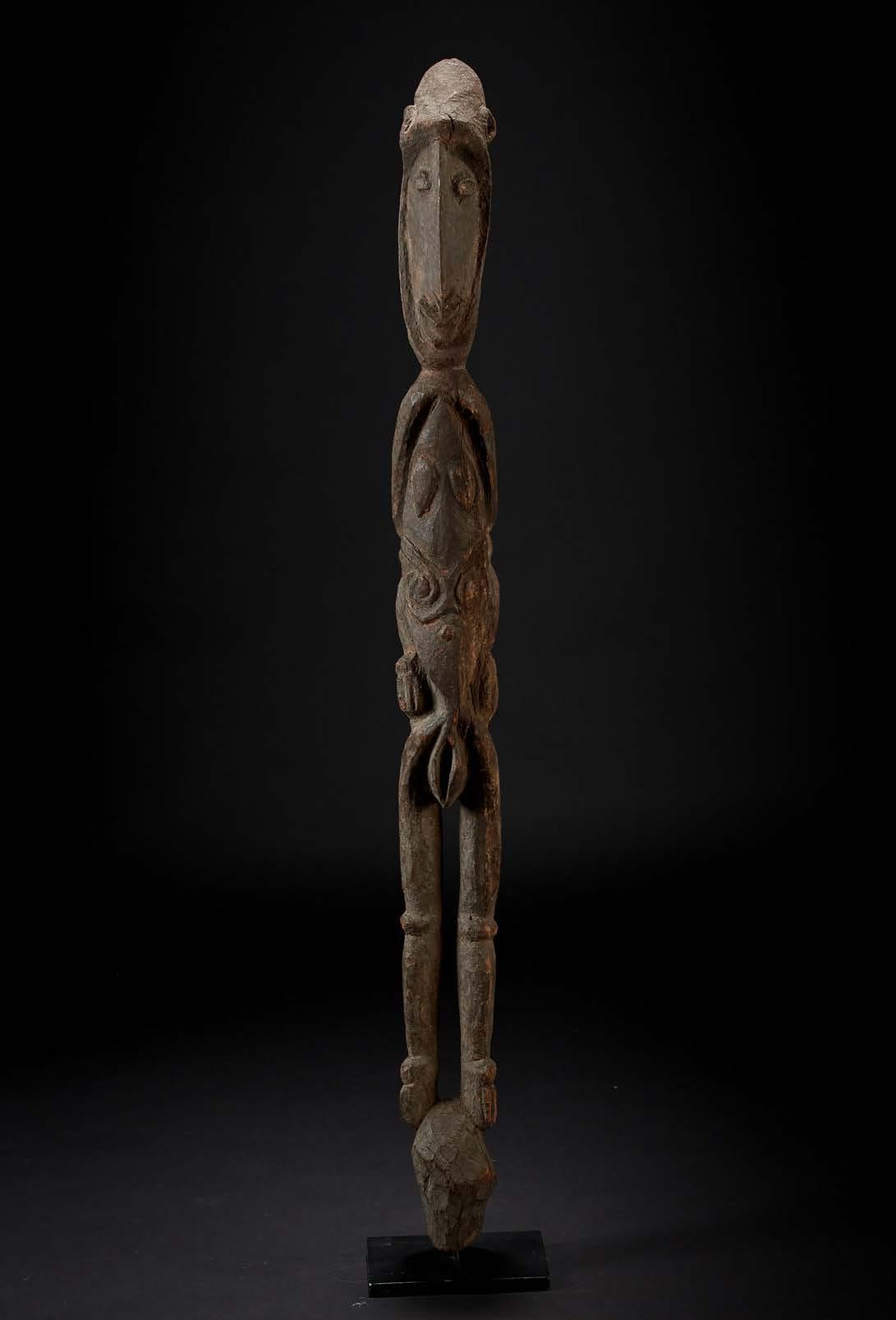

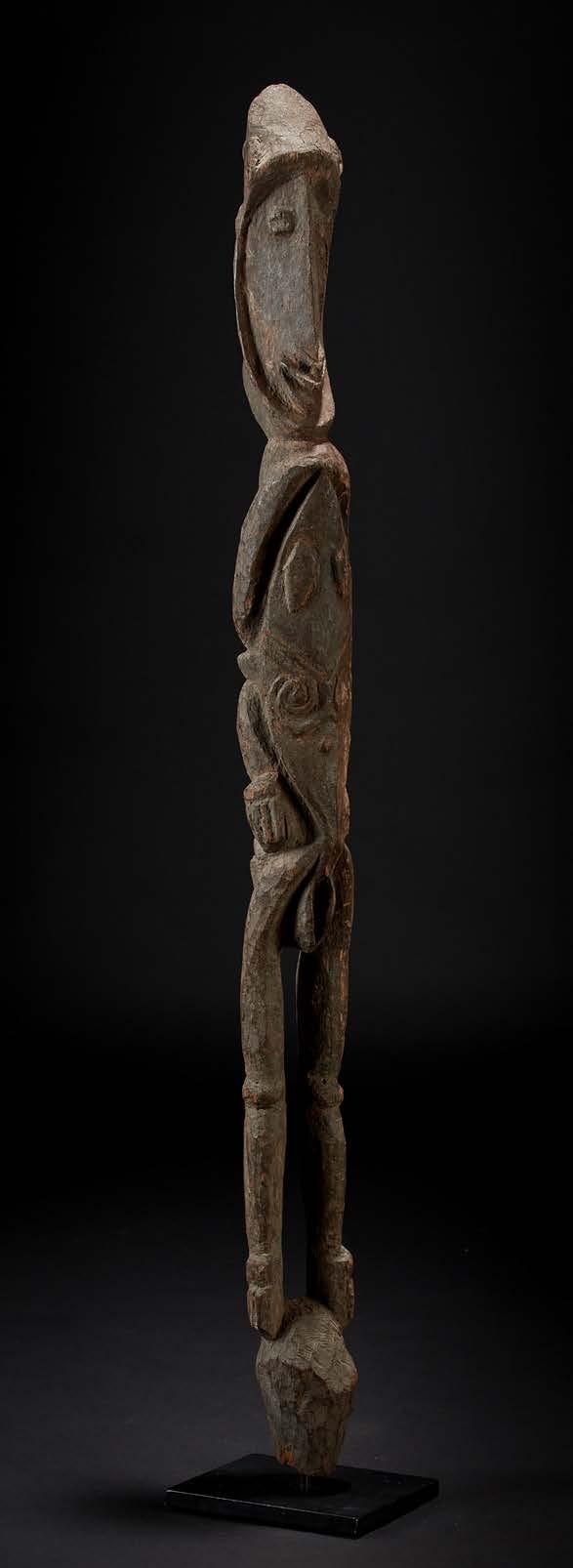
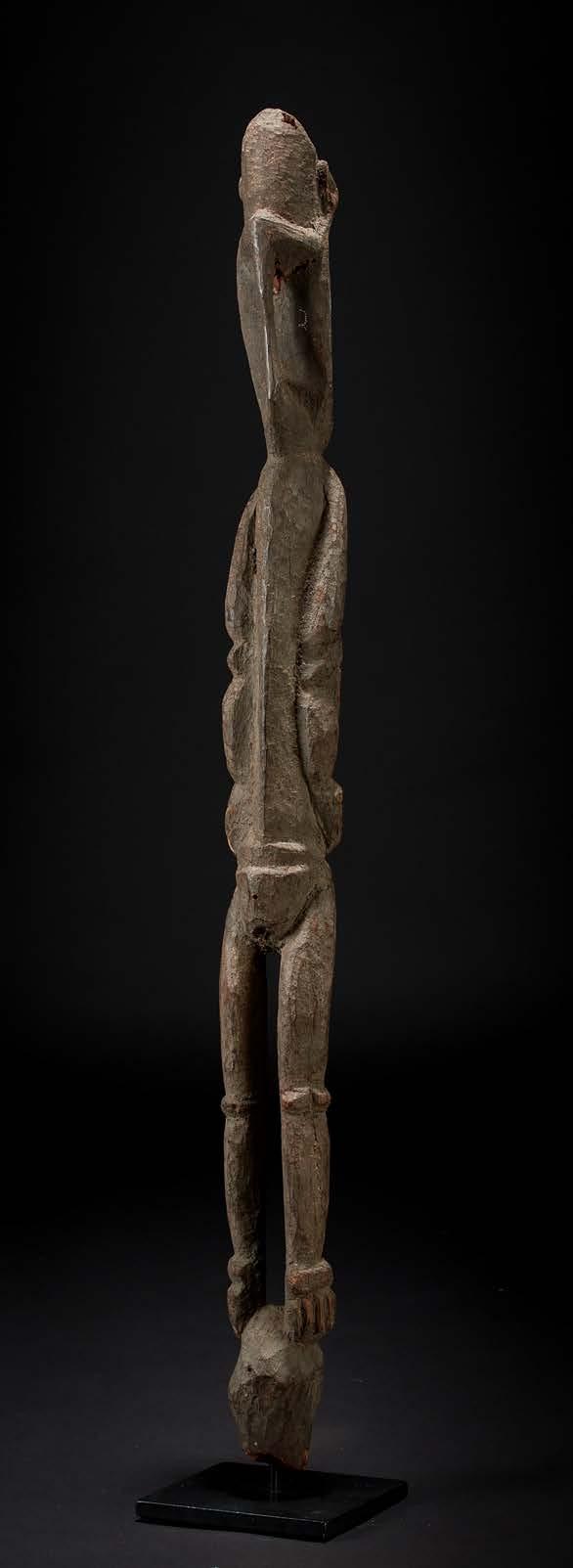

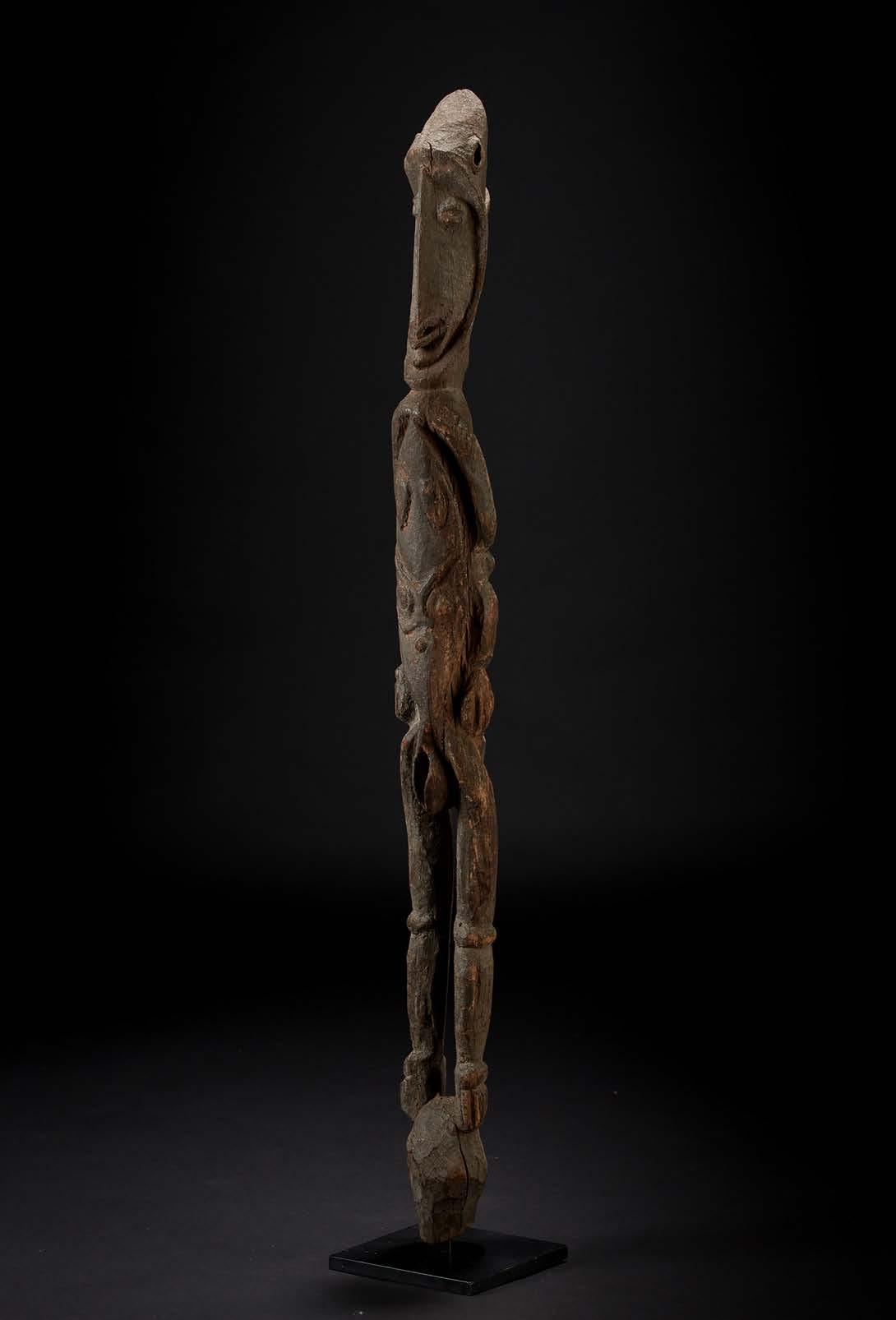

10. SHELL-INLAID WOVEN SHIELD
Solomon Islands.
There are only about 25 known examples of these original 19thC inlaid woven shields, according to the Metropolitan Museum in New York. All were collected between 1840 and 1860. None were collected after this period and there are no photographs of these early shields in use. Only in last 10-15 years one Solomon Island family on Malaita Is, whose heritage goes back to Iroboa, the famous great leader of Su’uafa, have actually made examples of these amazing and iconic shields. This family has maintained traditions around fishing and dolphin-hunting and have dedicated themselves to maintaining some of the ancient arts within their culture.
This shield is one of a handful of shell-inlaid shields that have recently been produced. The shield has a tightly woven and strong cane base. Tiny pieces of very finely carved Nautalus shell are prepared and set into parinarium nut pastse that covers the front surface of the shield. The finest old shields had a large central figure, elongated and abstracted, and surrounded by various geometric deigns. This shield has this same elongated central figure with arms raised and very linear form. Below this figure is a smaller figure in squatting position. Surrounding both figures are the typical geometric motifs.
The family has painstakingly re-created these enigmatic shields with some reflecting these central figures, while others that have explored designs based on their own experiences. Because of the time and creativity involved, only a handful have been created. This particular shield is somewhat darkened, possibly from being stored over several years in a smokey domestic environment.
83 x 24 x 6 cm € 6,000
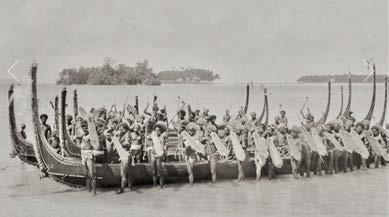
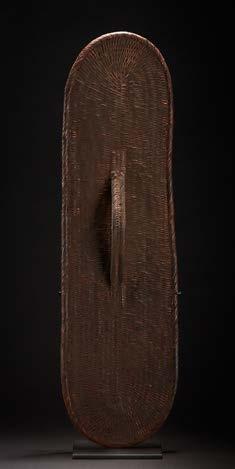
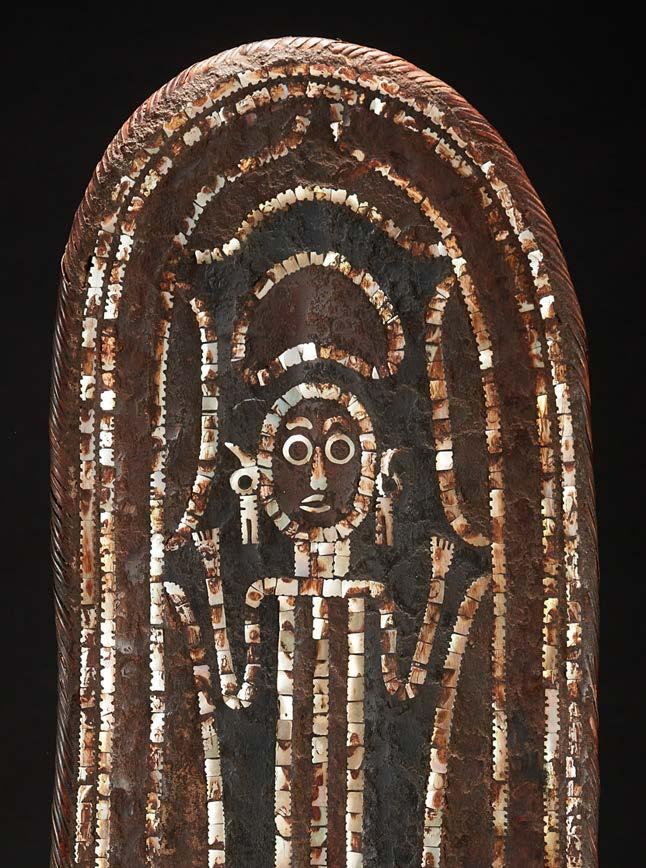
Photo: early 20thC. War canoe with warriors carrying lave-lave, war shields made of cane, but undecorated.

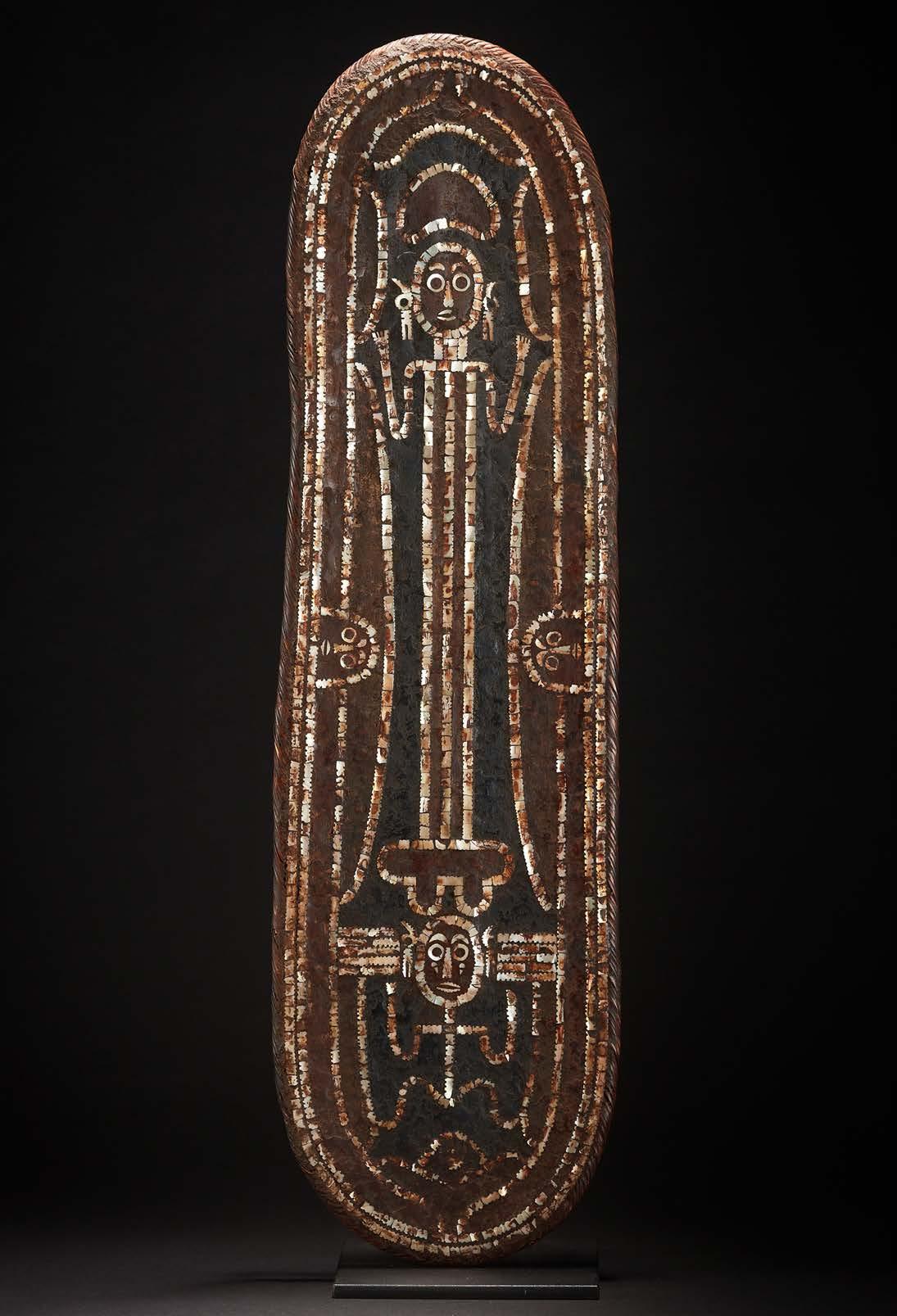

11. DUGONG FIGURE, Torres Straits, Australia. Early 20thC.
Provenance: early Queensland collection and by descent to a Brisbane collector. I acquired the figure in 1992.
This is a striking example of a Torres Strait dugong, with a fine elegance and fluidity. While not as old as examples in the British Museum, it shows a certain patina of age that is unmistakeable. The Torres Straits dugongs, a large aquatic mamal reaching lengths up to three metres was considered an animal of great significance, both as a totem and as food. Carvings of dugongs in both wood and stone were believed to have magical qualities that were believed to ensure success in dugong hunting. These figures were hung from special hunting platforms built among the seaweed where dugongs grazed or suspended from canoes used for hunting.
The British Museum have two dugong figures from Torres Staris, (one in wood and one in stone) both collected before 1889 by A C Haddon.
6,500
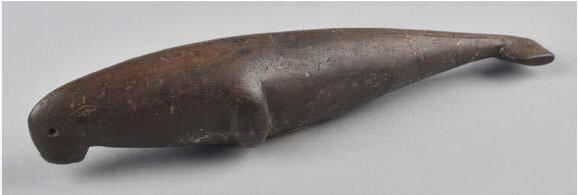
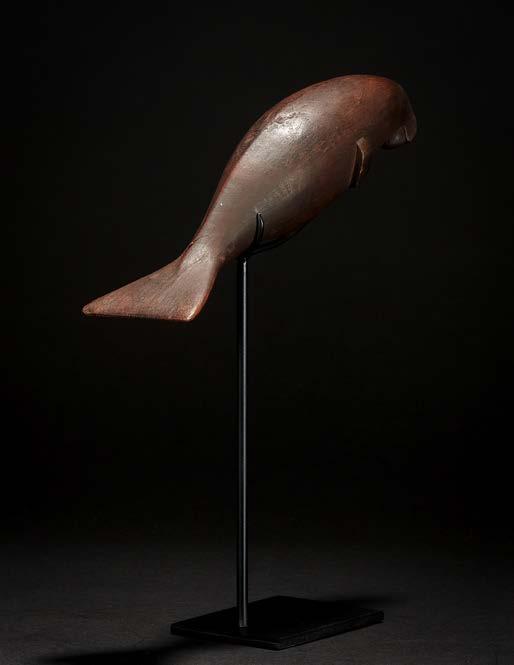
26 x 6 x 6 cm
Wooden dugong figure of polished dark brown wood, British Museum. Collected 1888-89 by A C Haddon.

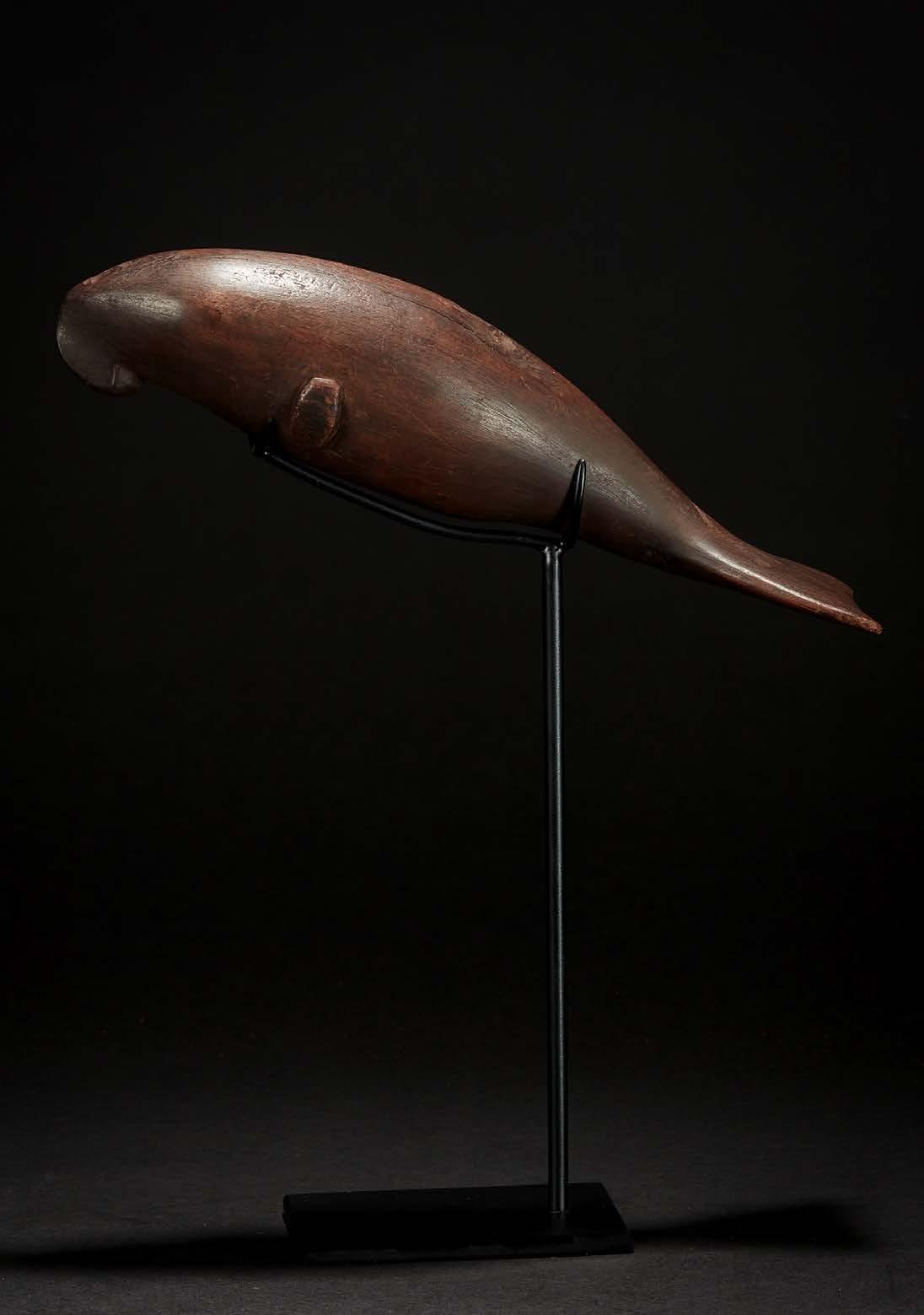

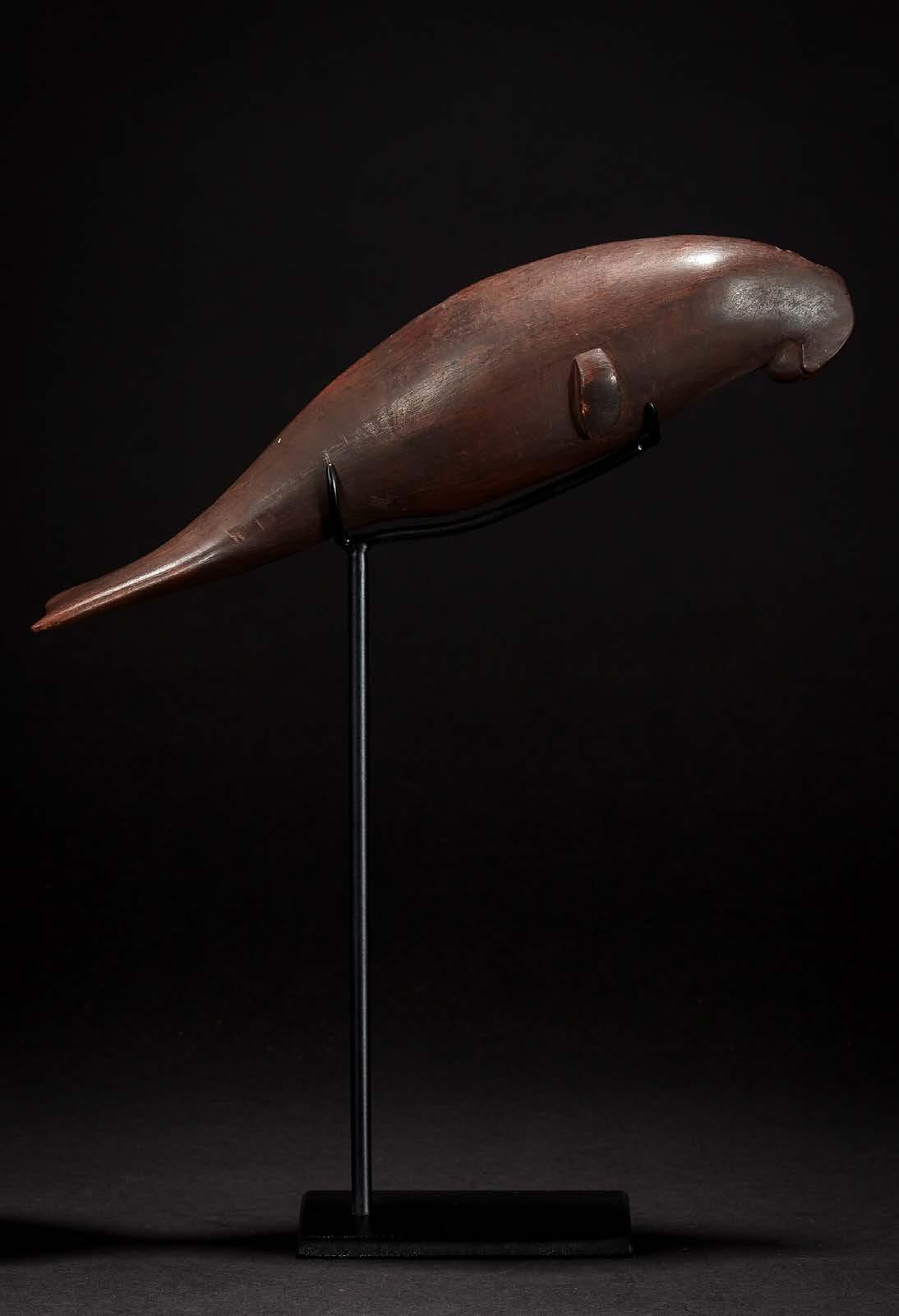

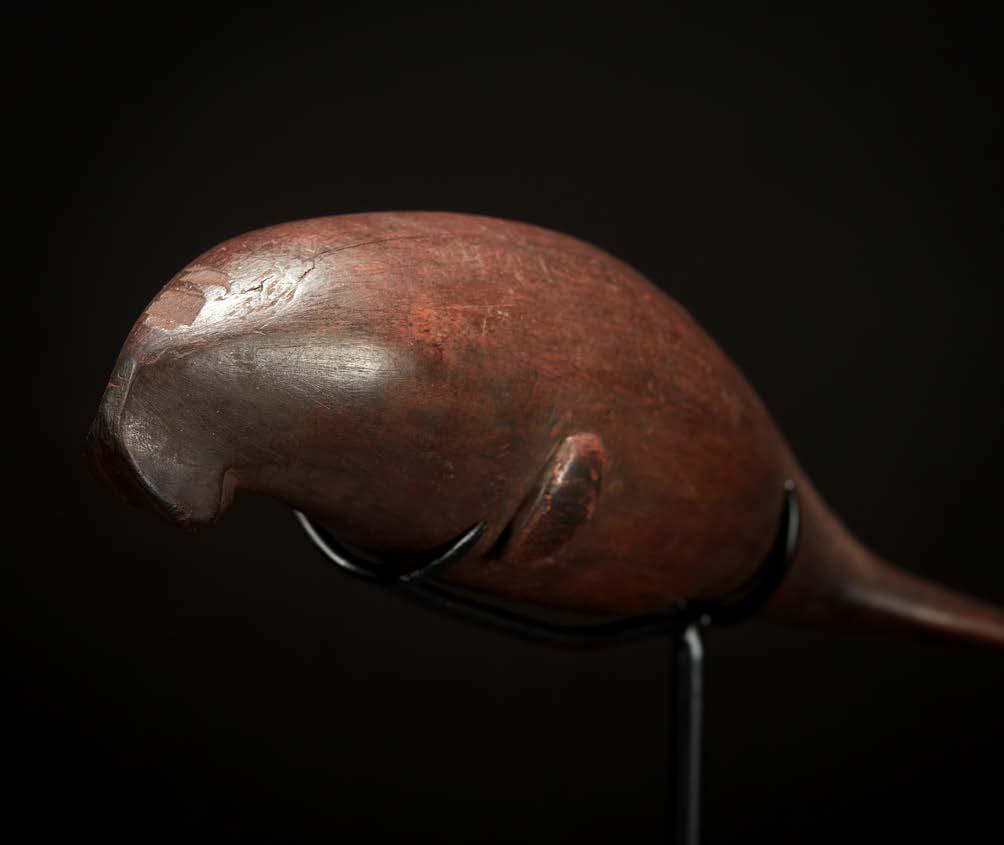
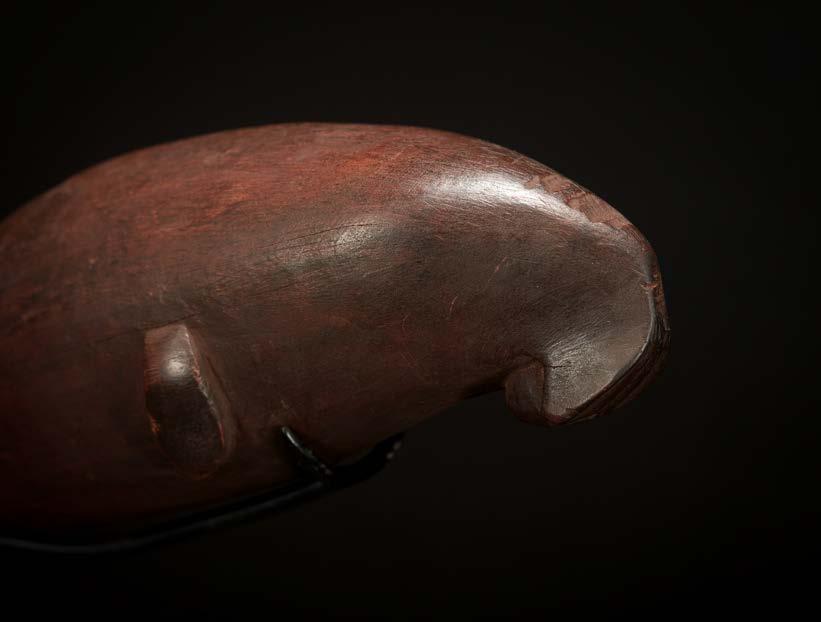
12. THREE OLD BONE DAGGERS
Kwoma or Nukuma, Upper Sepik River, Papua New Guinea.
All three daggers are made from the human femur bone; many are ancestral bones - fathers, grandfathers etc but sometimes the bones of strong enemy warriors may be used. They are engraved with similar designs found on war shields and generally cover most of the shaft.
a) Finely engraved, with inlaid cowrie shells, pale deep patina, beautifully decorated with tassels of seeds and German trade beads. Ex-old Melbourne coll; ex-Alex Philips, Melbourne; ex-Malcolm Davidson, Melbourne.
b) Deeply carved, inlaid pearl shell with deep brown overall patina. ex-old Victorian coll, Australia.
c) Engraved on its upper half with al dark brown patina and tassels of nassa shell and German trade beads. Red seed embedded at the top. Collected by Chris Boylan, Ambunti 1988.
a) 38 x 6 x 7 tassles 23 cm
b) 30 x 6 x 6 cm
c) 29 x 4 x 4 cm

a) € 4,000
b) € 2,800
c) € 1,600
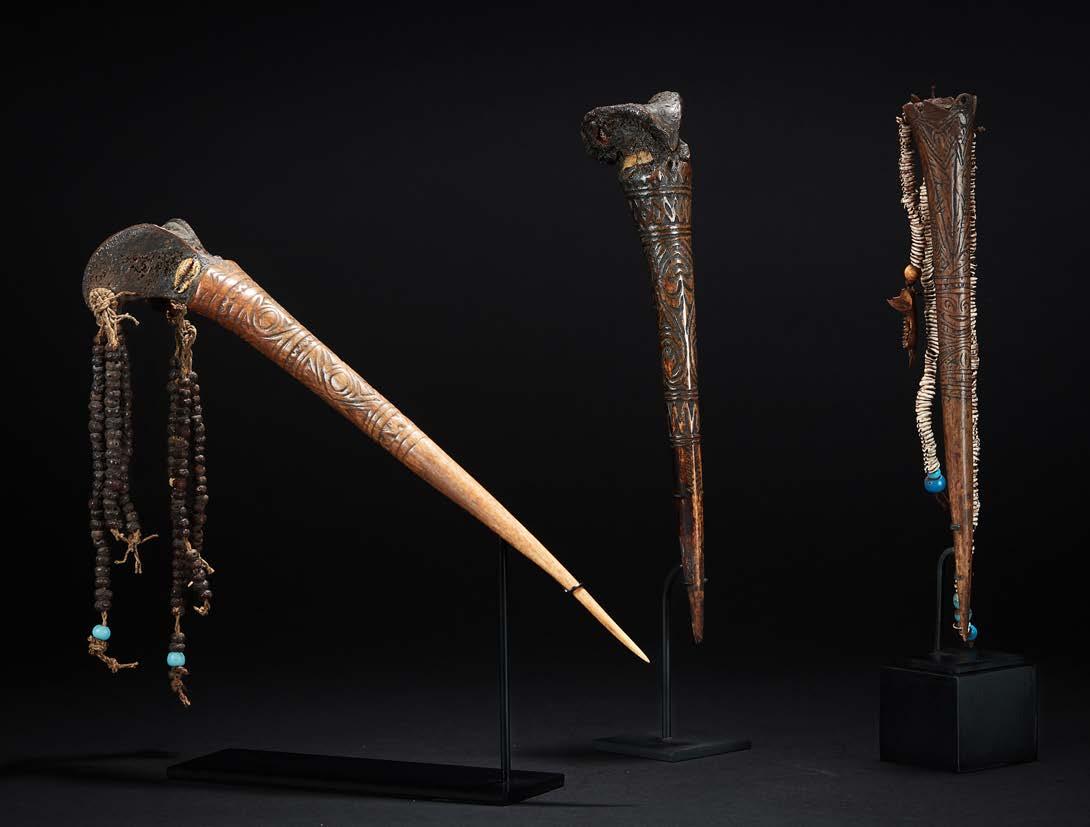

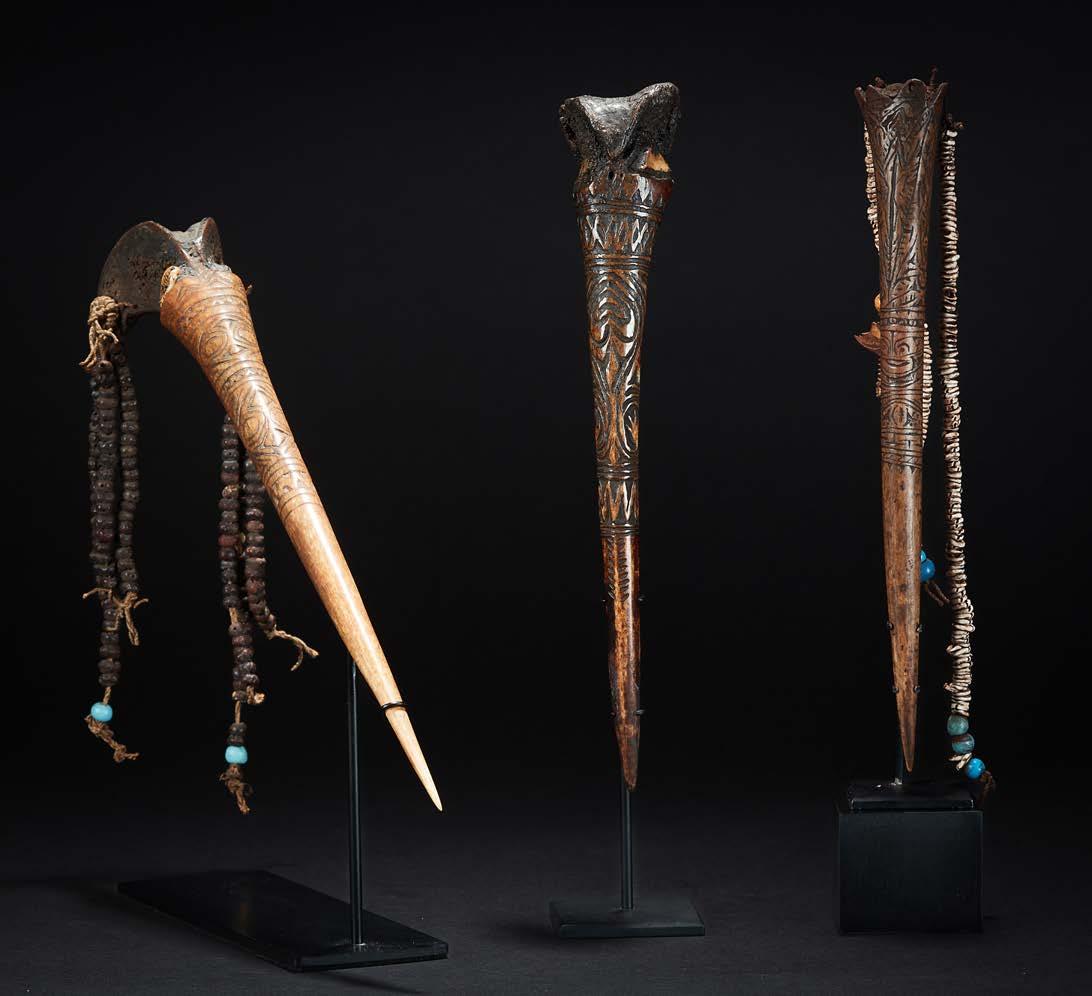
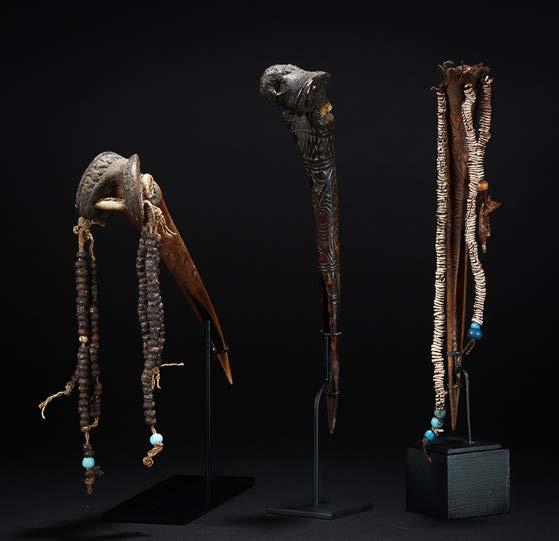
13. TWO BRIDE PRICE, TALIPUN
Prince Alexander Mountains, East Sepik, Papua New Guinea.
Talipuns are used by the Boiken people as important items of ceremonial exchange, particularly as bride-price. They consist of the giant green snail; shell (Turbo mamoratus) onto which is attached a wonderful woven mask-like form of cane. The best are quite elaborate, with ancestor faces, birds and animals. They are invariably painted in bright earth ochres.
a) A large face dominates this talipun, crowned by a bird figure, and completed with two outstretched arms. Provenance: ex-important old Tahitian collection.
b) An unusual talipun, with a wide open mask and two projecting woven cockatoo heads that resemble protruding eyes.
a) 43 x 32 x 28 cm
b) 36 x 23 x 18 cm
a) € 2,200
b) € 1,200

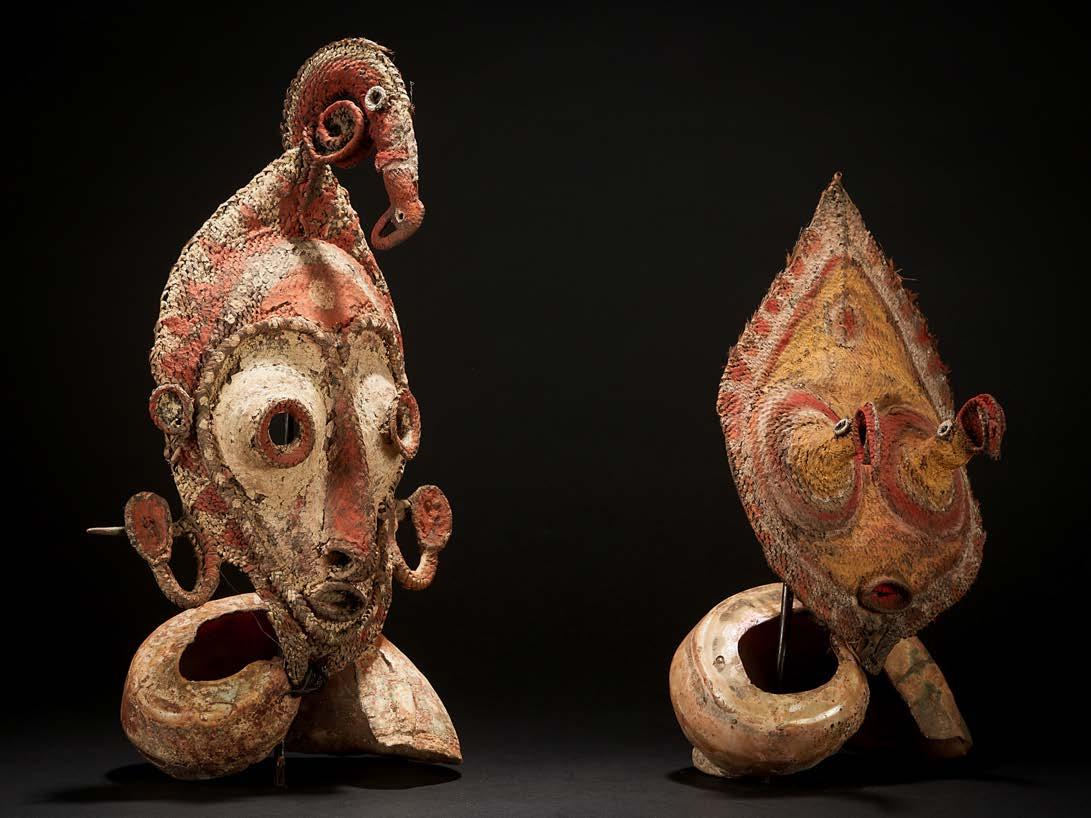

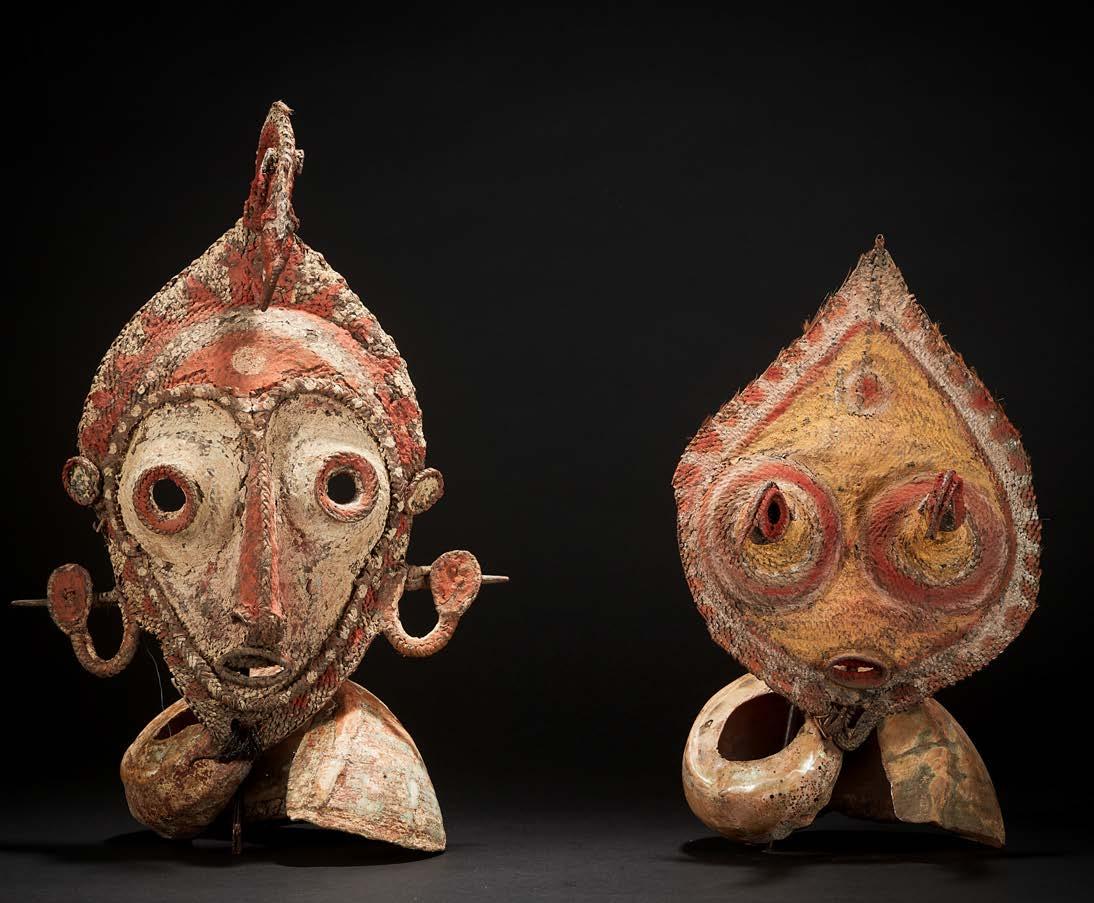
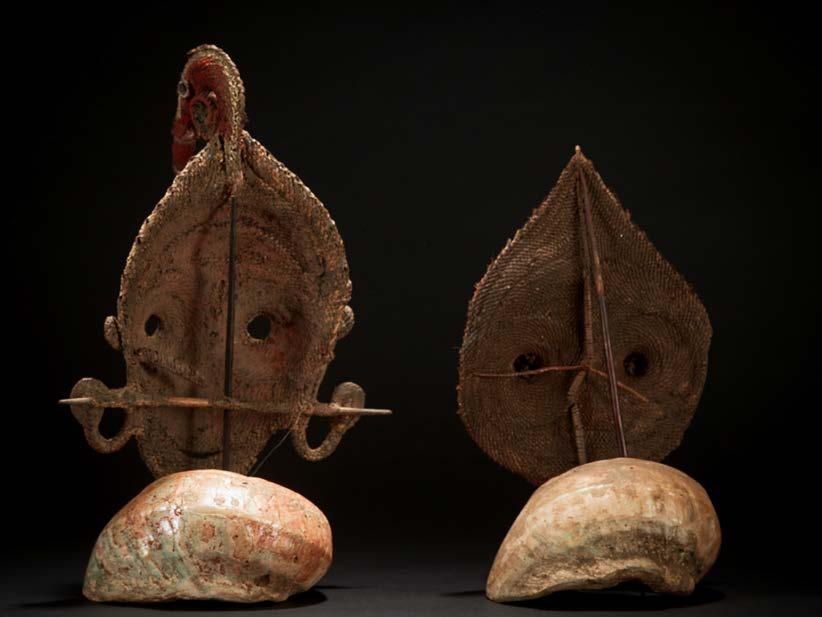
14. GIANT CLAMSHELL RING
Solomon Islands. 19thC or earlier.
Provenance: ex-important Tahitian collection. Reference: “ADORNED by nature”, Wolfgang Grulke, &One UK, 2022.
These giant rings are found only in the Western Islands Choiosel and Morovo Lagoon regions, and known as titi or tinete. These shell rings were primarily used as Land Title Deeds and were generally hidden away. These rings are both imporatnt and powerful; they are only allowed to be touched by the most senior chiefs. In fact some, like this one, are buried with the chief at his funeral because people fear the power of the shell ring. The surface of this ring shows it has weathered outside for a considerable time, and partially calsified.
24 cm diameter x 7.5 thick

€ 3,500
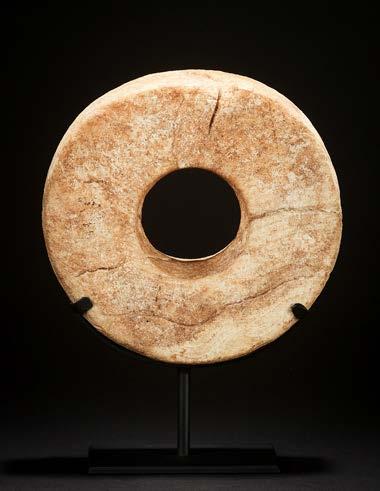
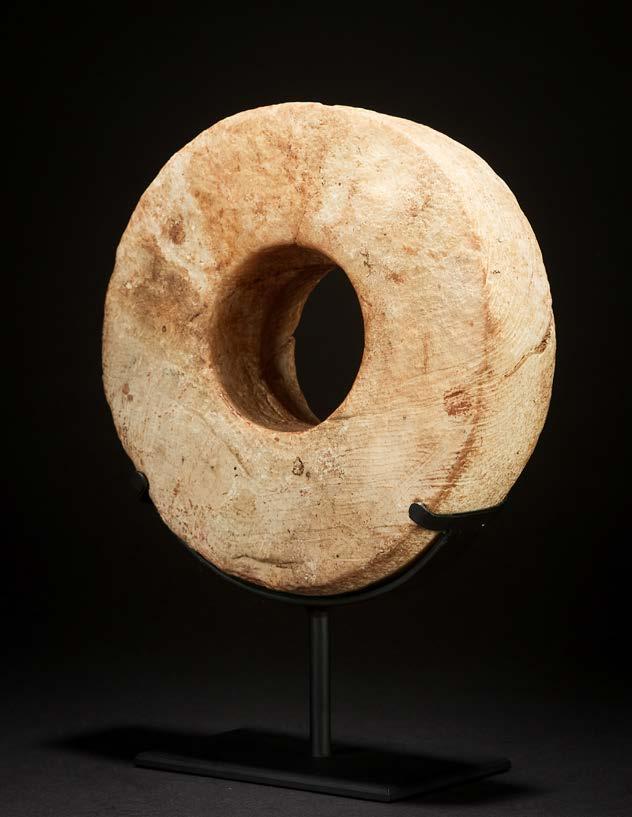

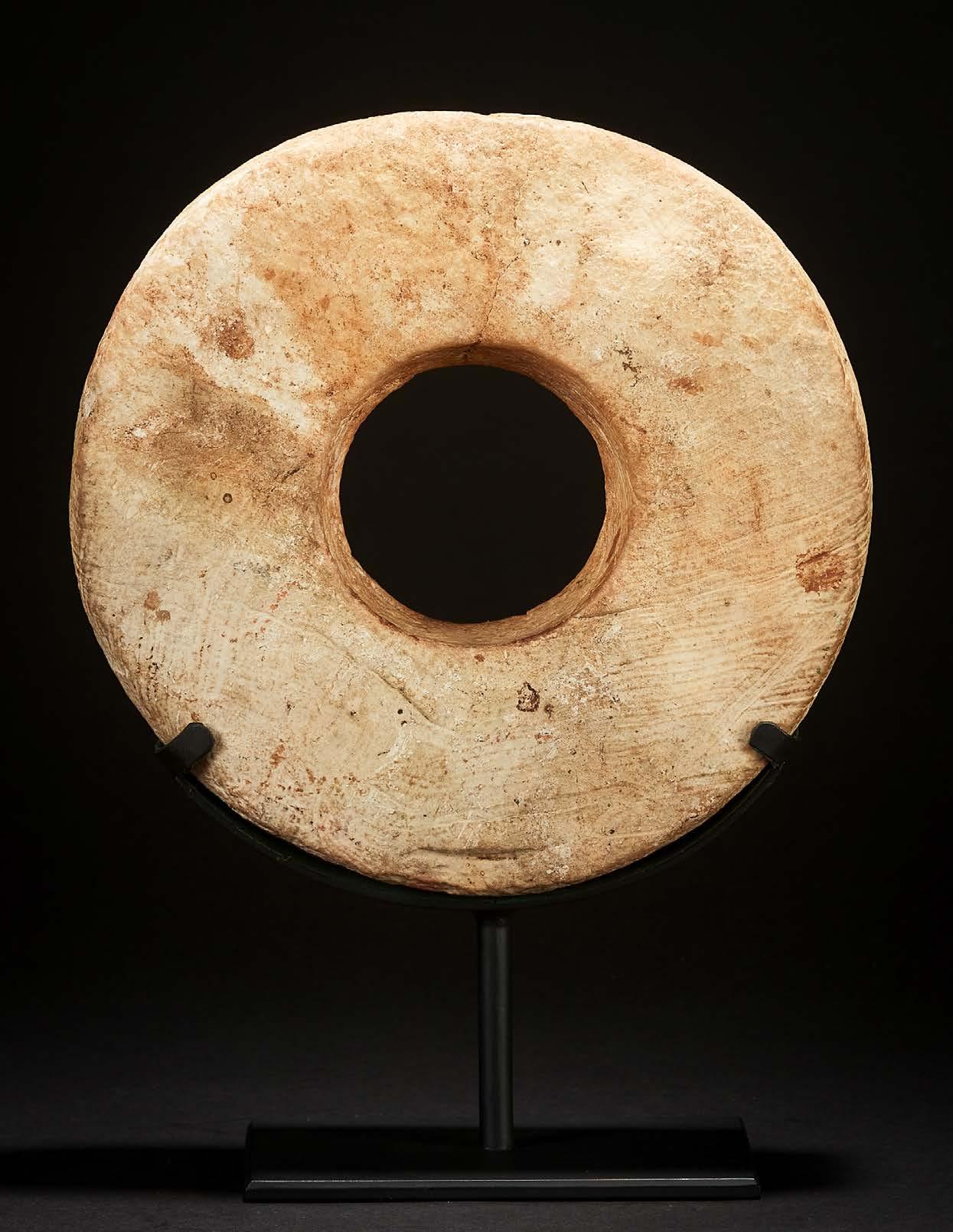

GREENSTONE in many world cultures is held in the highest esteem. In Oceania, the Maori consider greenstone to have both magical qualities and high status; hence they are used as symbols of power, weapons of war and body ornaments. In the Trobriand Islands, large axe heads invariably of dark green stone with lighter steaks, become bride price (not tools) and are given personal names. In the Wahgi Valley of Papua New Guinea, large green axe heads are fashioned into dispaly axes; the most imporatnt becoming wealth items used as bride price, (Meyer(1995)p.414, 415)
15. MAORI GREENSTONE CLUB, PATU ONEWA
New Zealand. 18th Century or earlier.
Provenance: Ex-collection Monique and Ismar Gosselin, France; ex-collection, Melbourne.
This patu is of drak radiant green basalt with lighter flecks. It has acquired a very worn and soft surface from several hundred years of use. The butt is simply grooved and the hole worn from long use where a flax chord attached to the warrior’s wrist. This is a superb example of a very early patu. There are several very small chips but this is expected on such old and well-used objects.
30 x 6.5 x 3 cm € 7,000
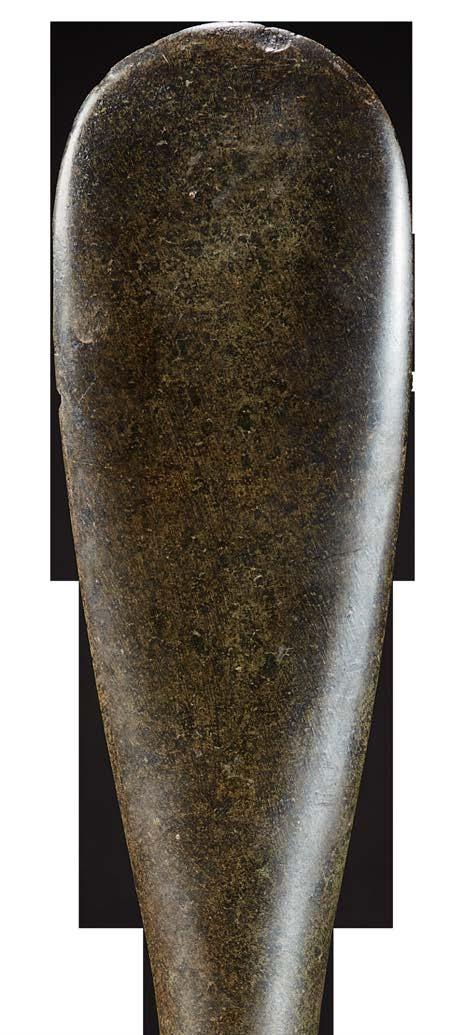
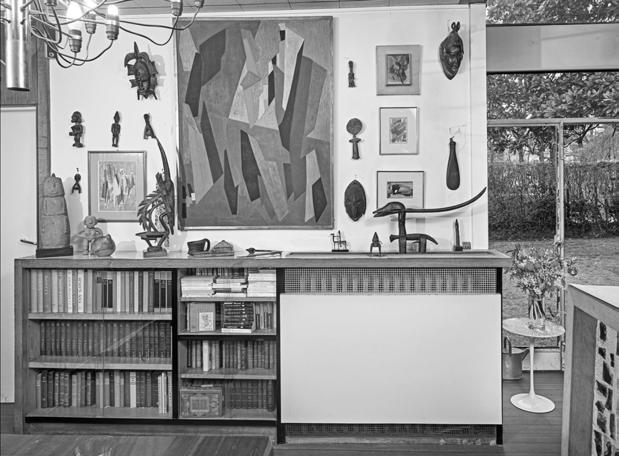
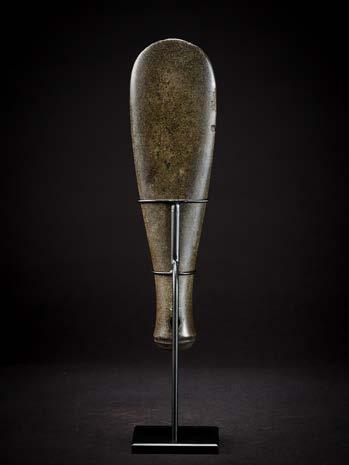
Patu, displayed in the home of the collector, Ismar Gossein c.1955

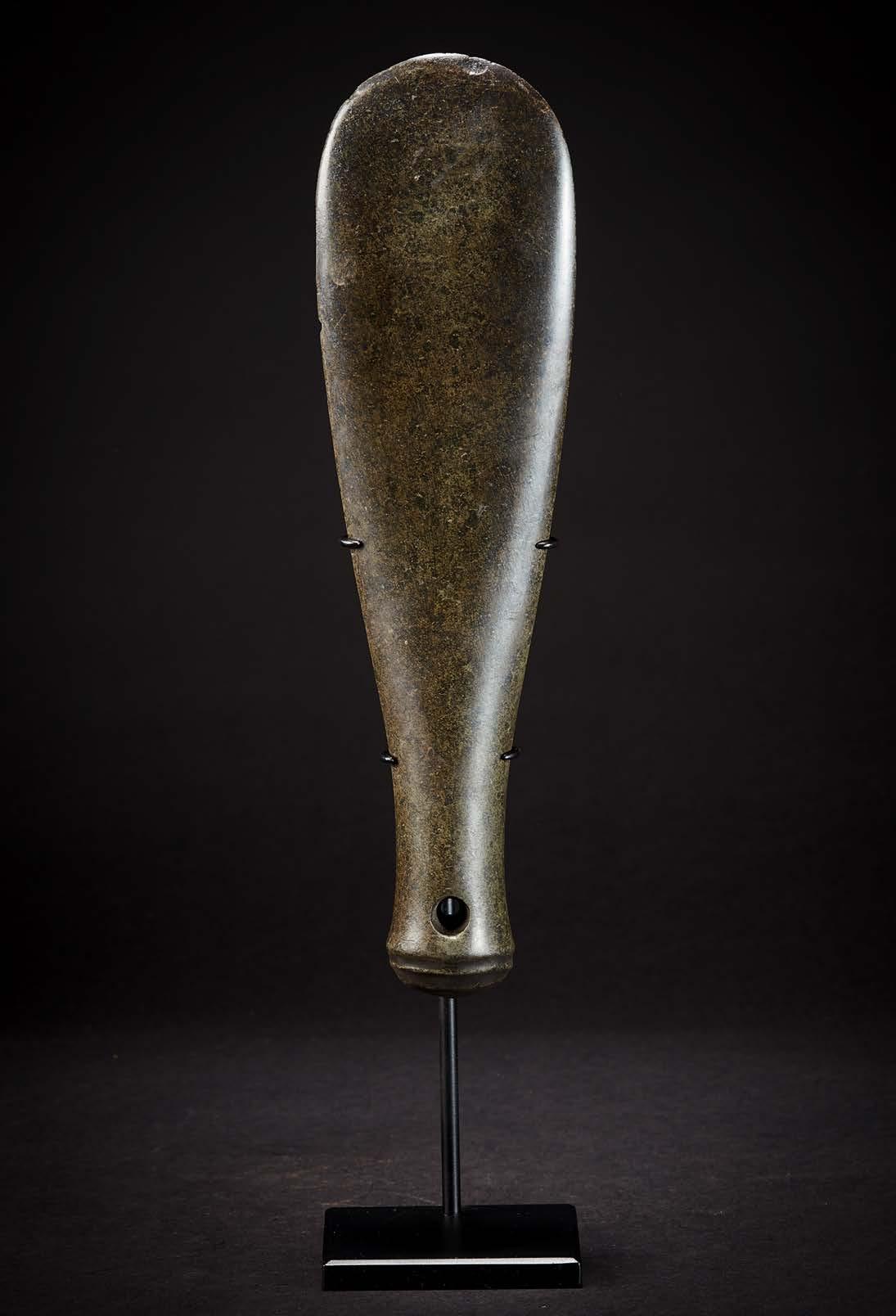
15a. THREE GREENSTONE AXE HEADS
Melanesia.
a) Large dark green blade with lighter stripes. Such blades are pestige items, used as bride price. Massim, Trobriand Is, ex-Jutts Malnic collection, Sydney.
b) Dark green wealth blade, hafted for cane attachments, Solomon Islands.
c) Large solid greenstone blade, with fine cutting edge and wide solid base, Wahgi Valley, Papua New Guinea Highlands.
a) 25 x 12.5 x 0.7 cm
b) 22 x 12 x 4 cm
c) 27 x 7 x 3 cm

a) € 650
b) € 900
c) € 500
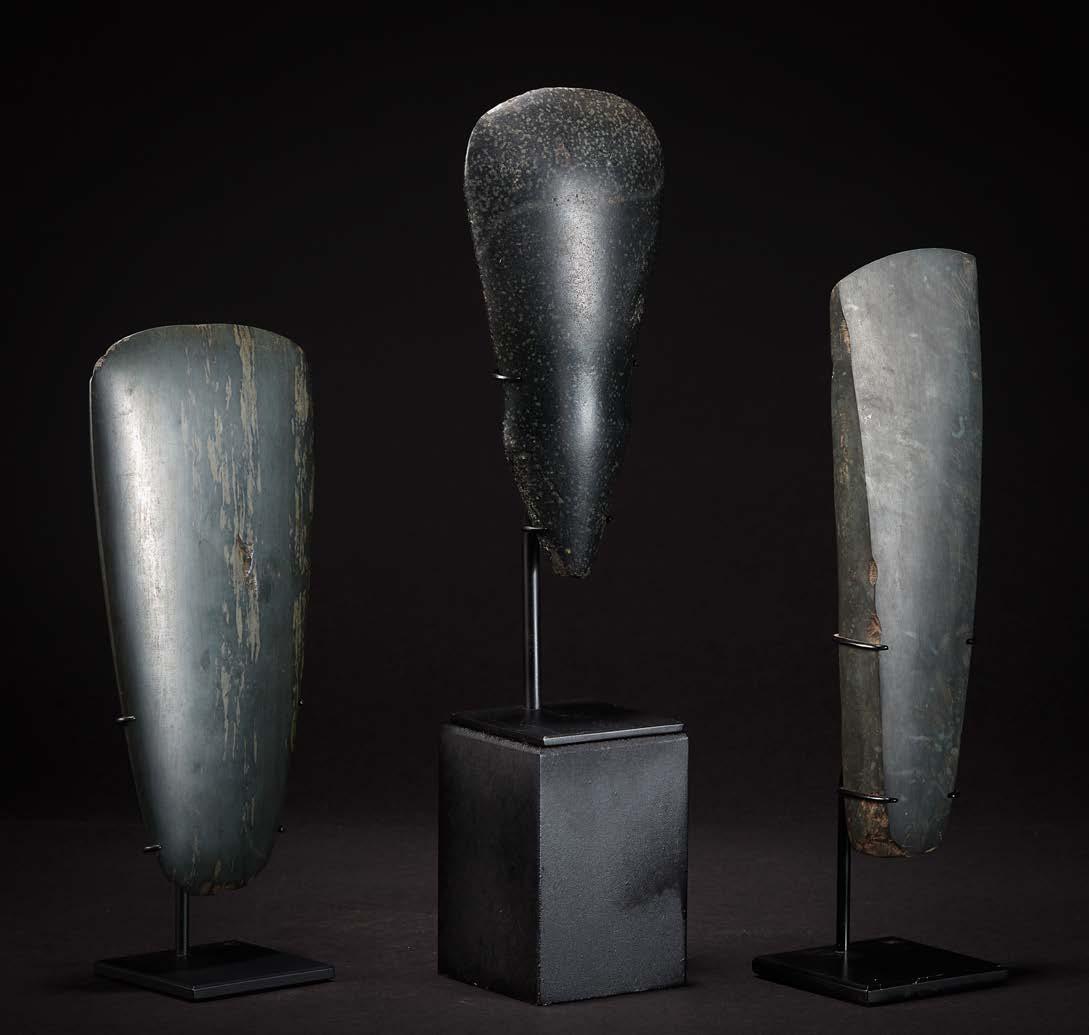

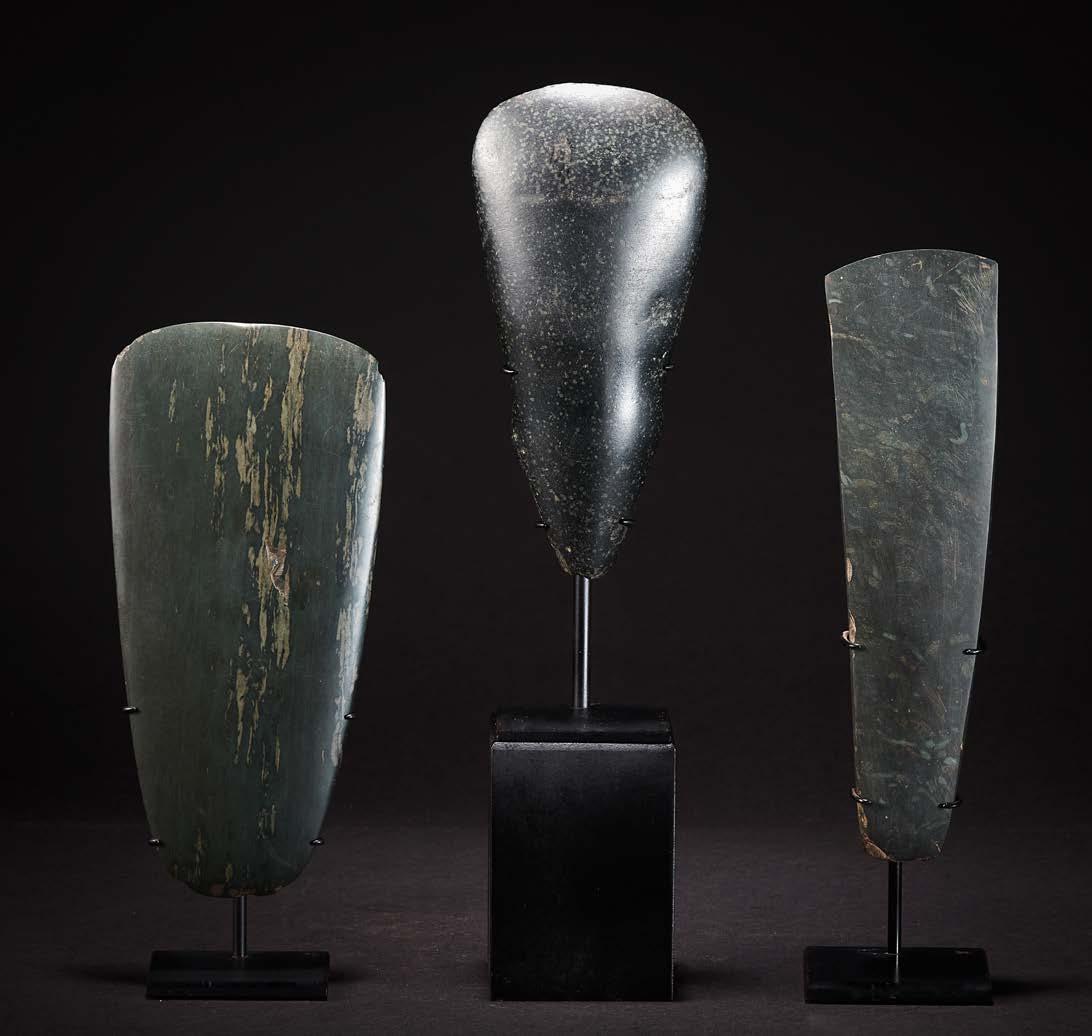
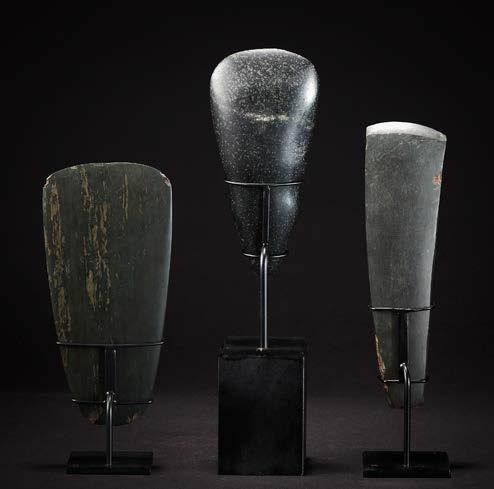
15b. FOUR GREENSTONE AXE
Melanesia.
a) Pale bright greenstone blade, speckled with darker fleks Eastern Highlands, PNG.
b) Deep radiant green blade with fine white dapples, serpentine stone, Lake Sentani, West Papua, Indonesia.
c) Radiant green blade with lighter green stipples, metemorphic stone, Witu Islands, New Britain, PNG.
d) Tall elegant blade, light green in colour with lighter flecks, metamorphic hornfels stone, Markham Valley, PNG.
a) 19 x 7.5 x 3.5 cm
b) 16 x 6.5 x 4 cm
c) 13 x 6.5 x 2.5 cm
d) 25 x 7 x 3 cm

a) € 350
b) € 500
c) € 400
d) € 450
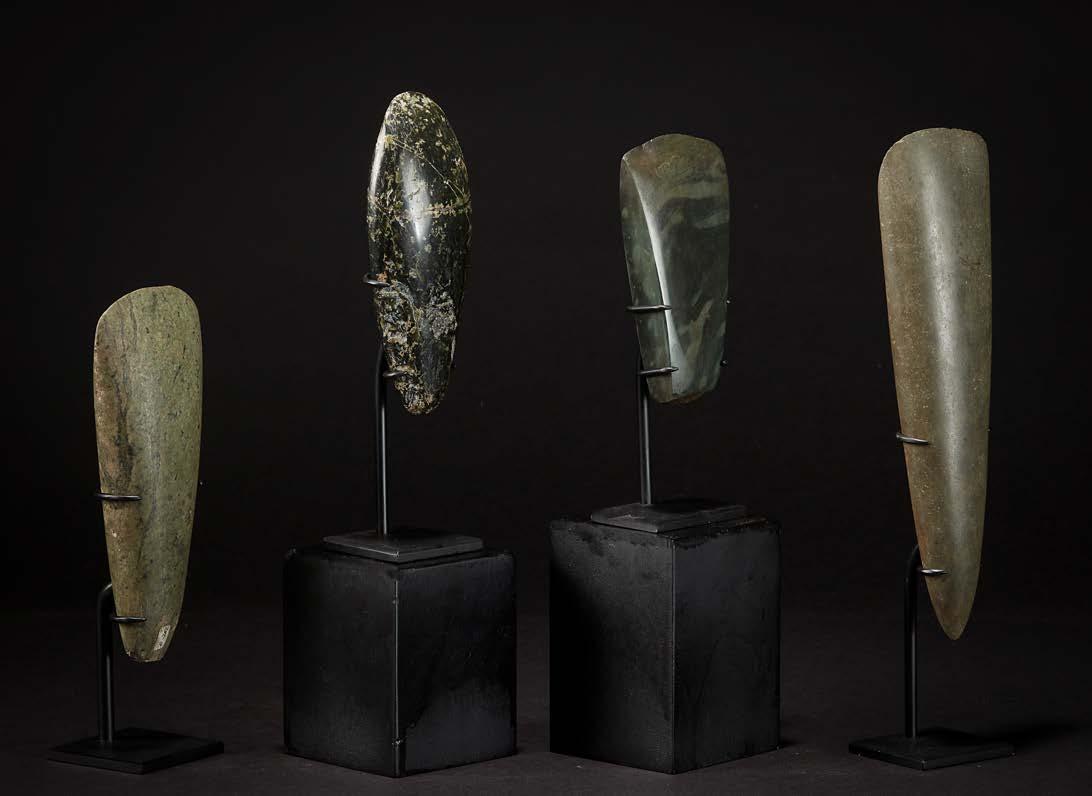

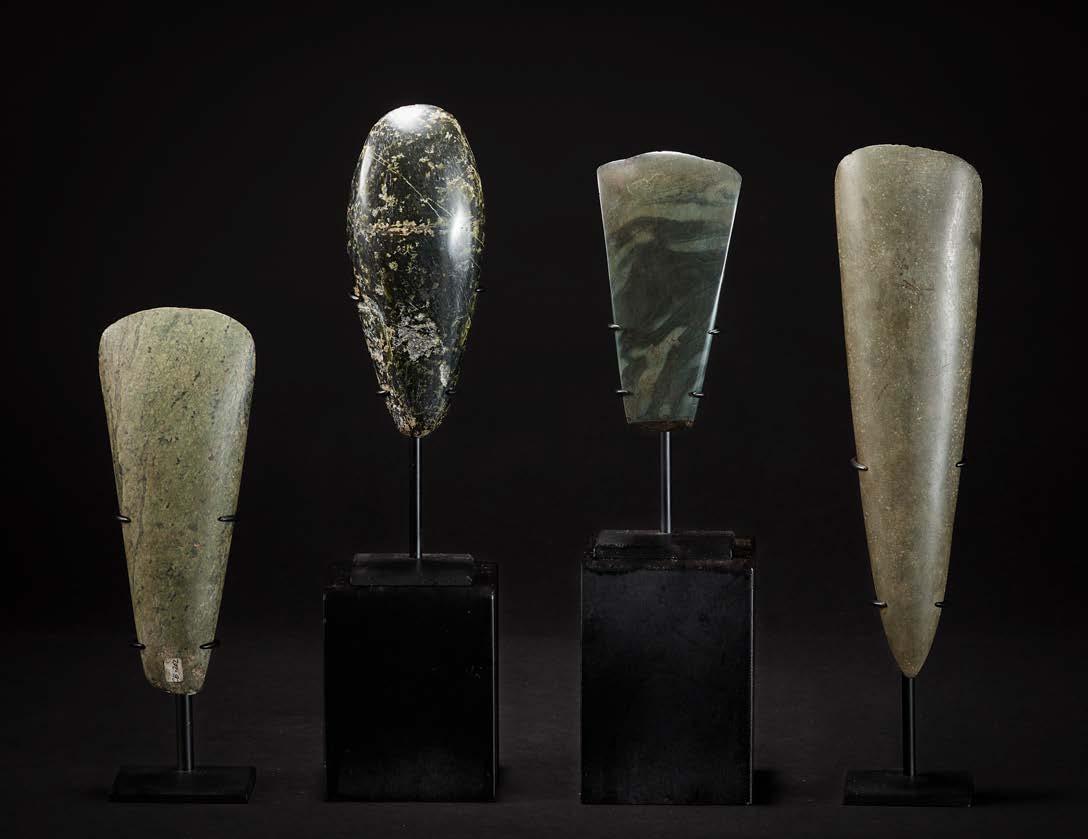
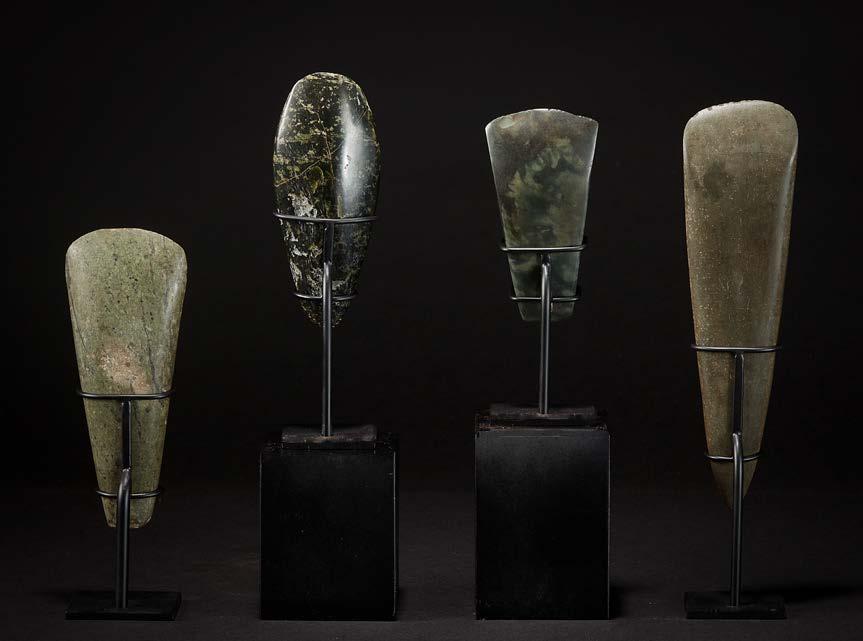
16. FIVE WOODEN YAM MASKS
Abelam, East Sepik Province, PNG. C. 1930s-1960s.
a) Mask from far western Wosera; from old Queensland collection.
b) Small old mask, with soft carving and deep patina; field collected by Chris Boylan 1980s.
c) An elegnat mask showing age; collection number “K235” (unknown coll) and an old Sothebys tag, Lot 35 (unknown auction).
d) Tall slim mask, simply painted in red and black.
e) Old mask, well painted; the back shows its age more than the often re-painted front. Old Queensland coll.
a) 27 x 13 x 7 cm
b) 14 x 7 x 4 cm
c) 35 x 17 x 7 cm
d) 40 x 12 x 6 cm
e) 37 x 13 x 8 cm

a) € 1,000
b) € 600
c) € 1,500
d) € 700
e) € 700
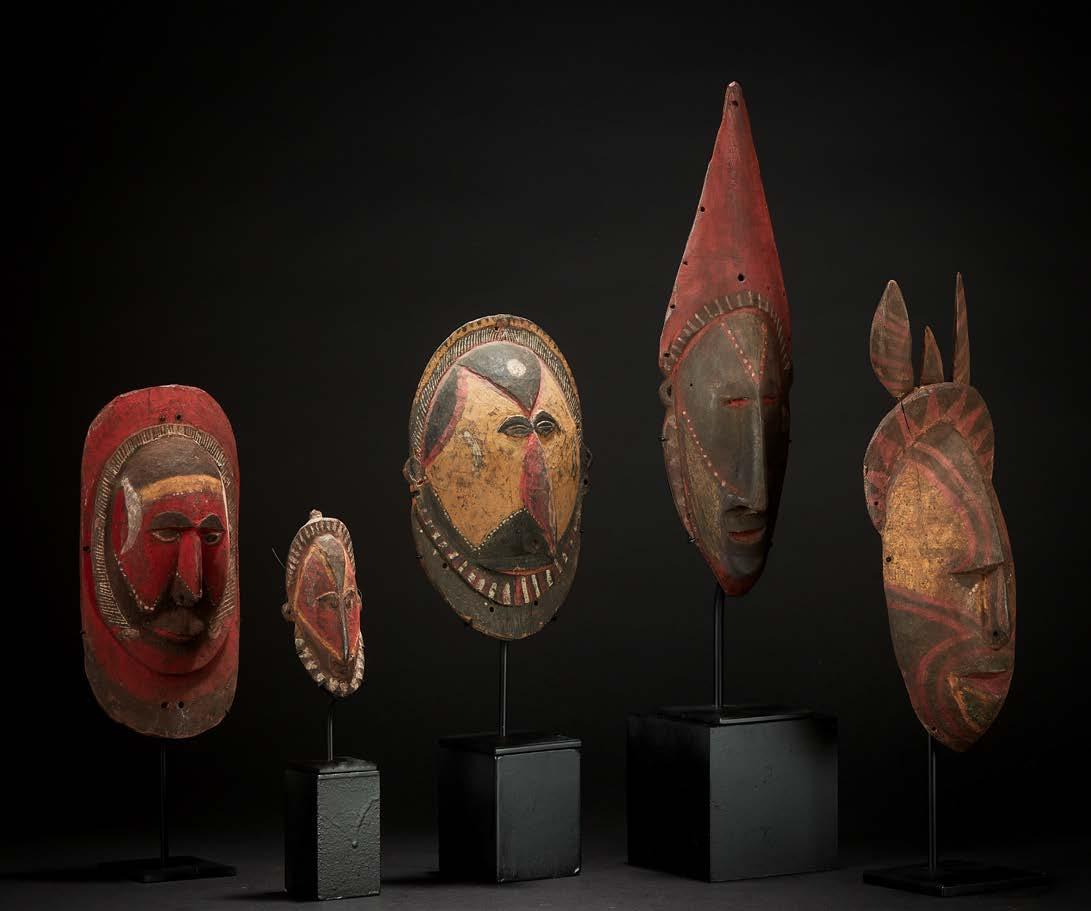

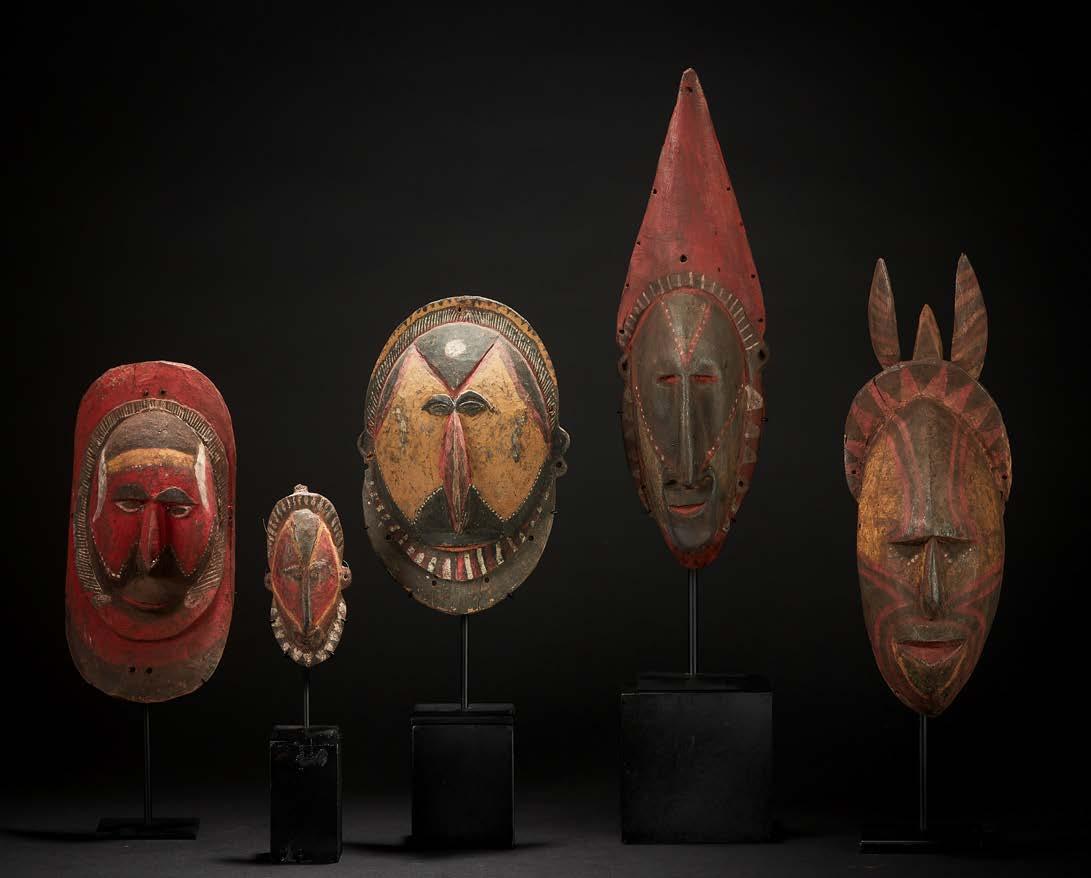
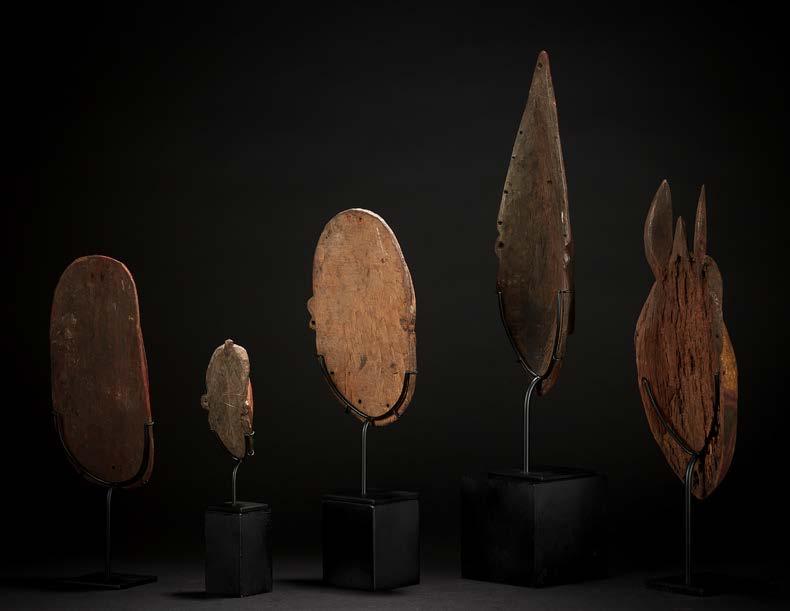
17. ANCIENT HEAD
Sawos, inland Sepik River region, Papua New Guinea.
Provenance: collected by Ed Boylan c. 1971 in the Sawos area; exact village unknown.
This beautifully proportioned head is from a much larger fiure or post that, looking at the back, seems to have decayed. No doubt this head was preserved when the larger figure deteriorated. Large conus shell eyes add to the face’s presence. The lug in the forehead would have held magic plants or shell decorations at times of ceremony.
47 x 18 x 15 cm

€ 3,000
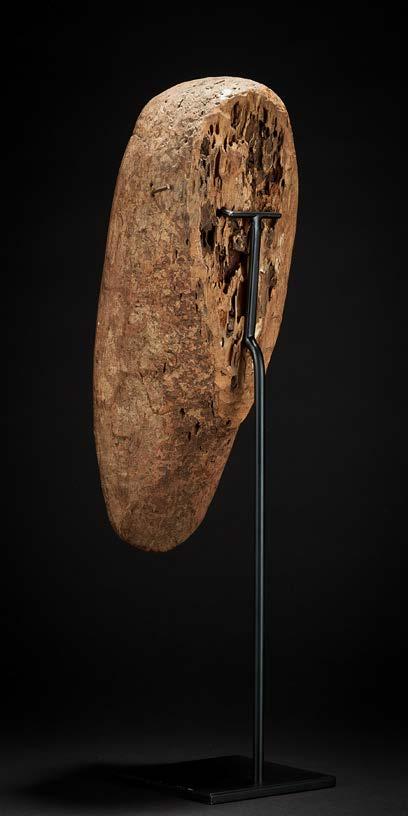
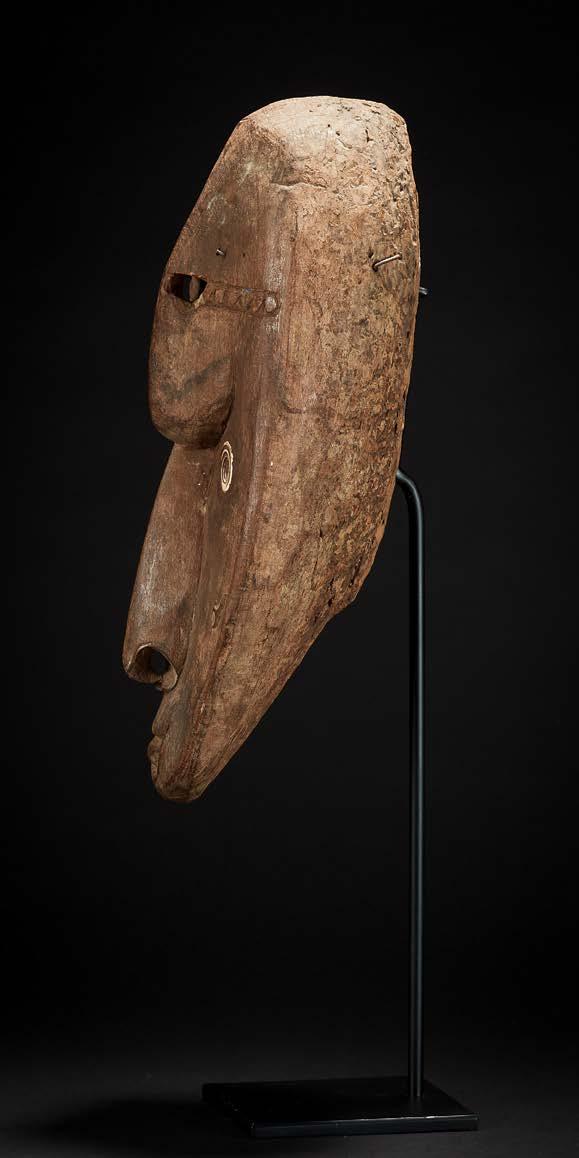

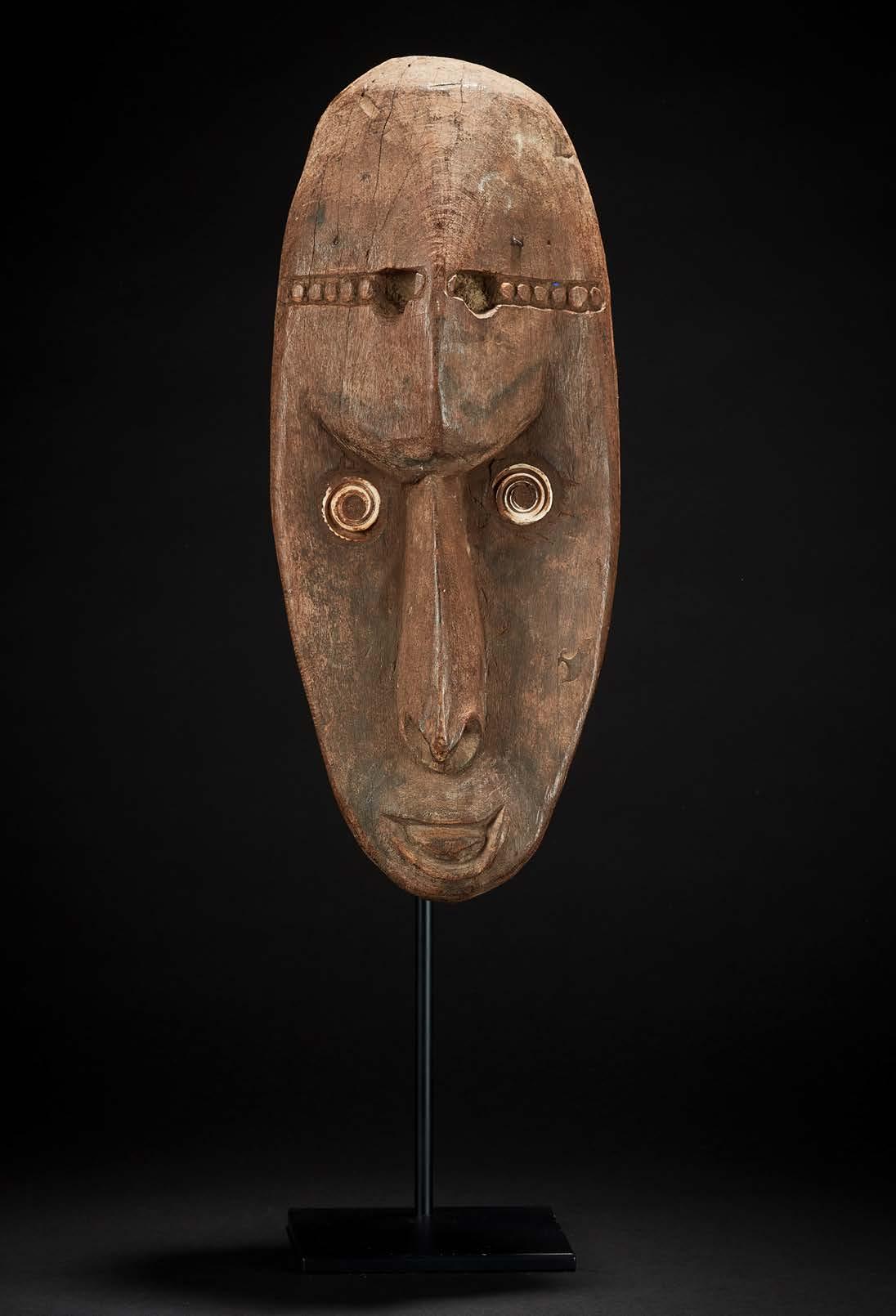

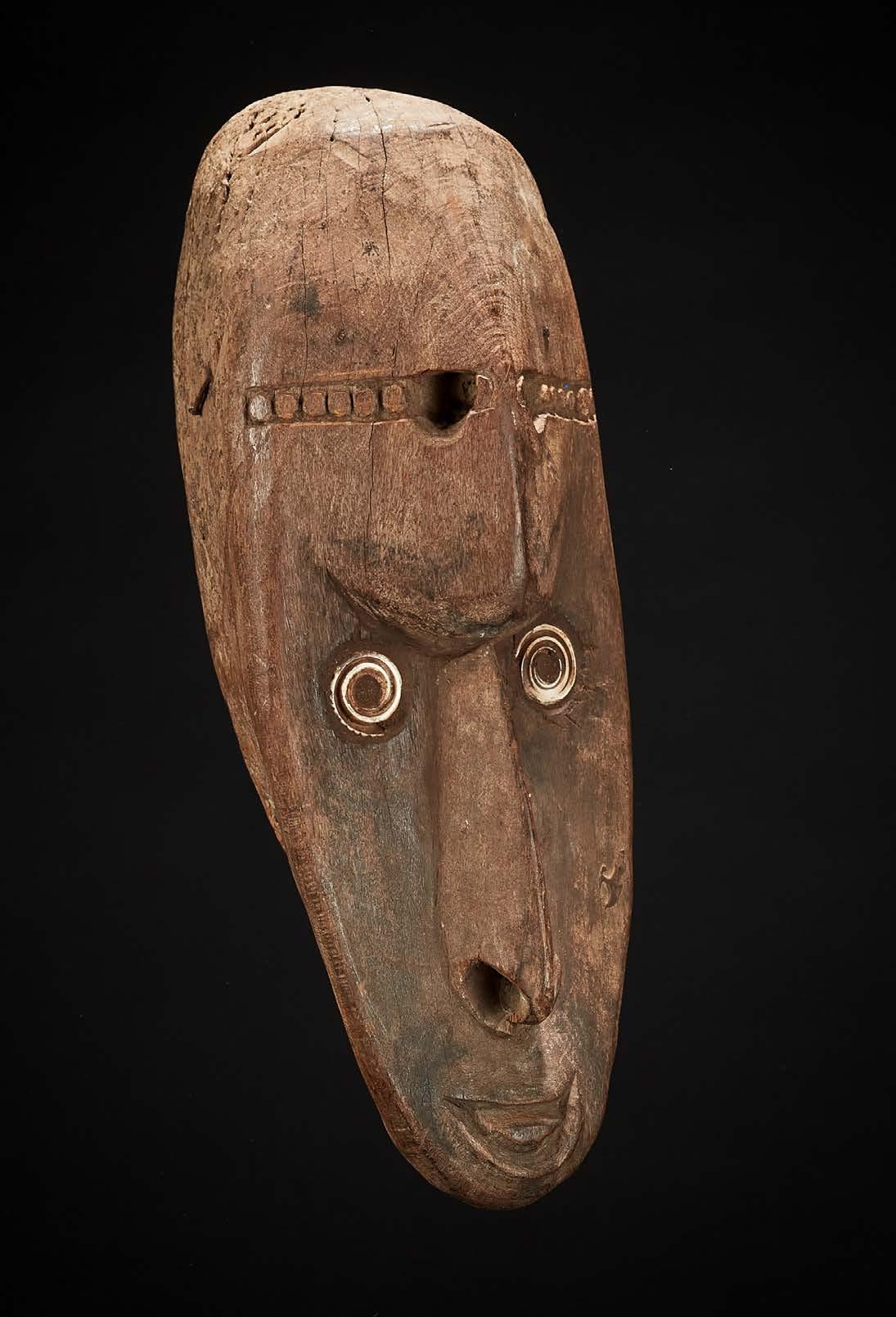

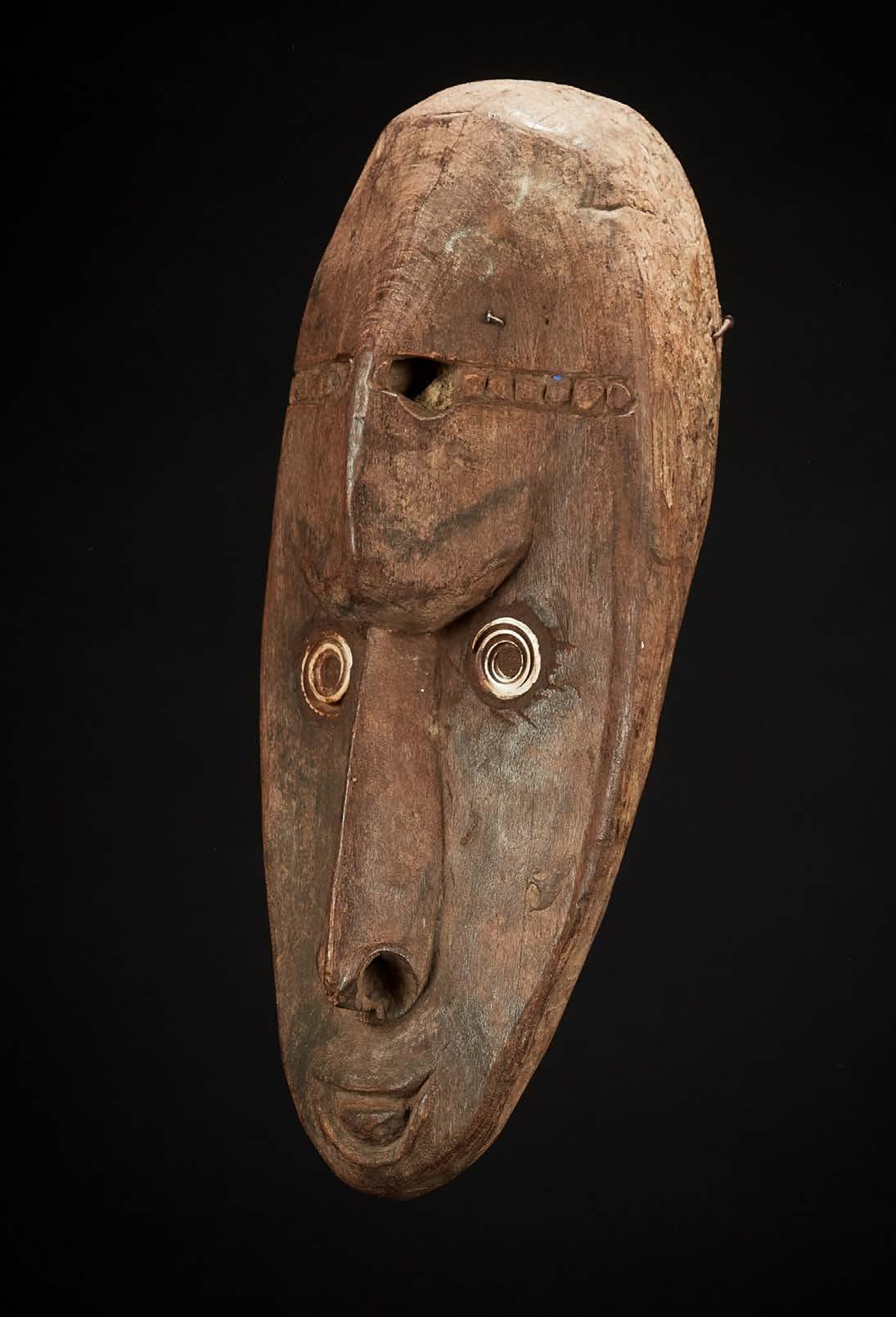

18. WOVEN MASK
Ramu River, Papua New Guinea.
This woven mask was collected in the middle reaches of the Ramu River in the 1970s, but it is considerably older. It is a most unusual mask, made of a shiny black fibre, with square eyes and mouth. Shells, nassa and cowrie, are secured with fibre onto the mask and a beard made of seed tassles hangs from its lower edge. Its use is not clear, but most probably in village ceremony relating to gardens or fertility.
41 x 23 x 6 cm € 2,800
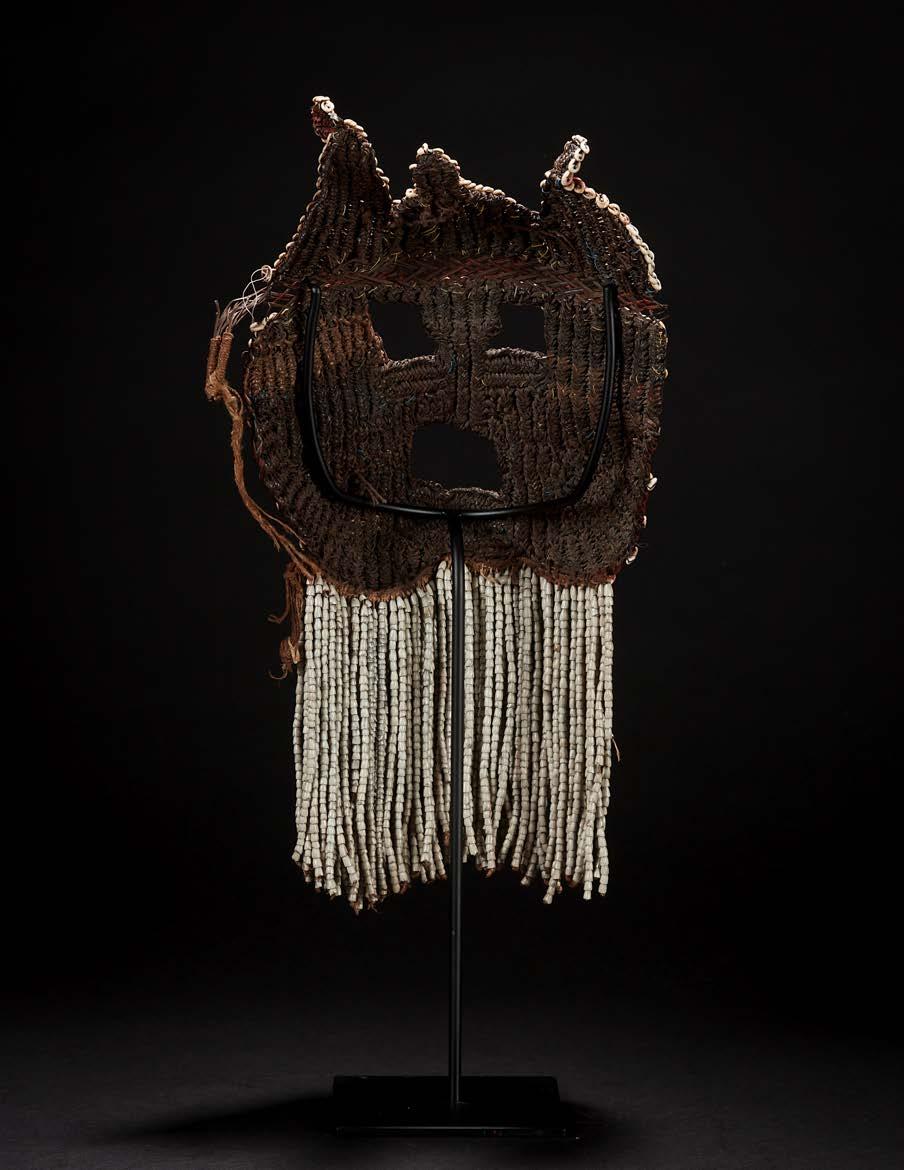

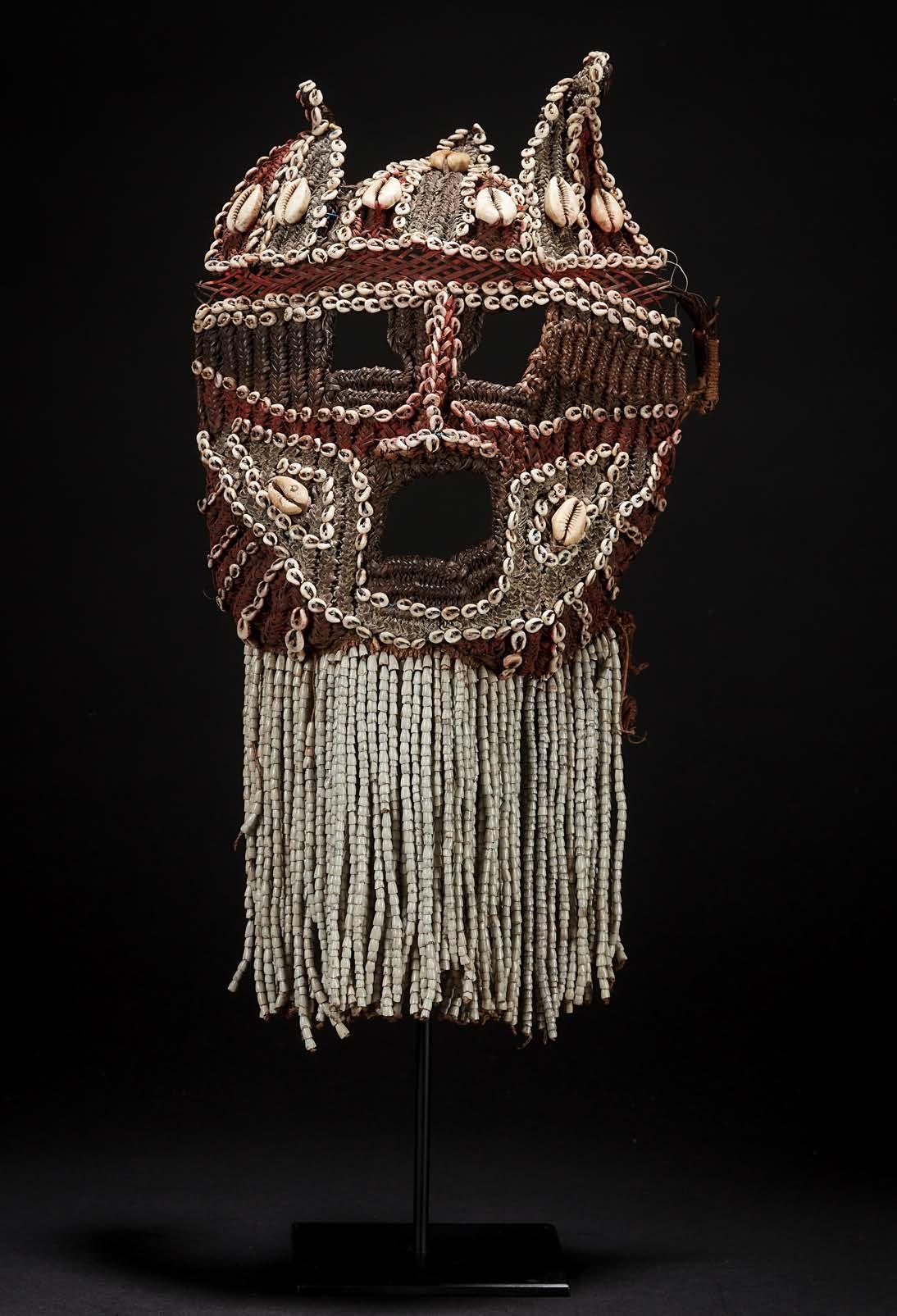

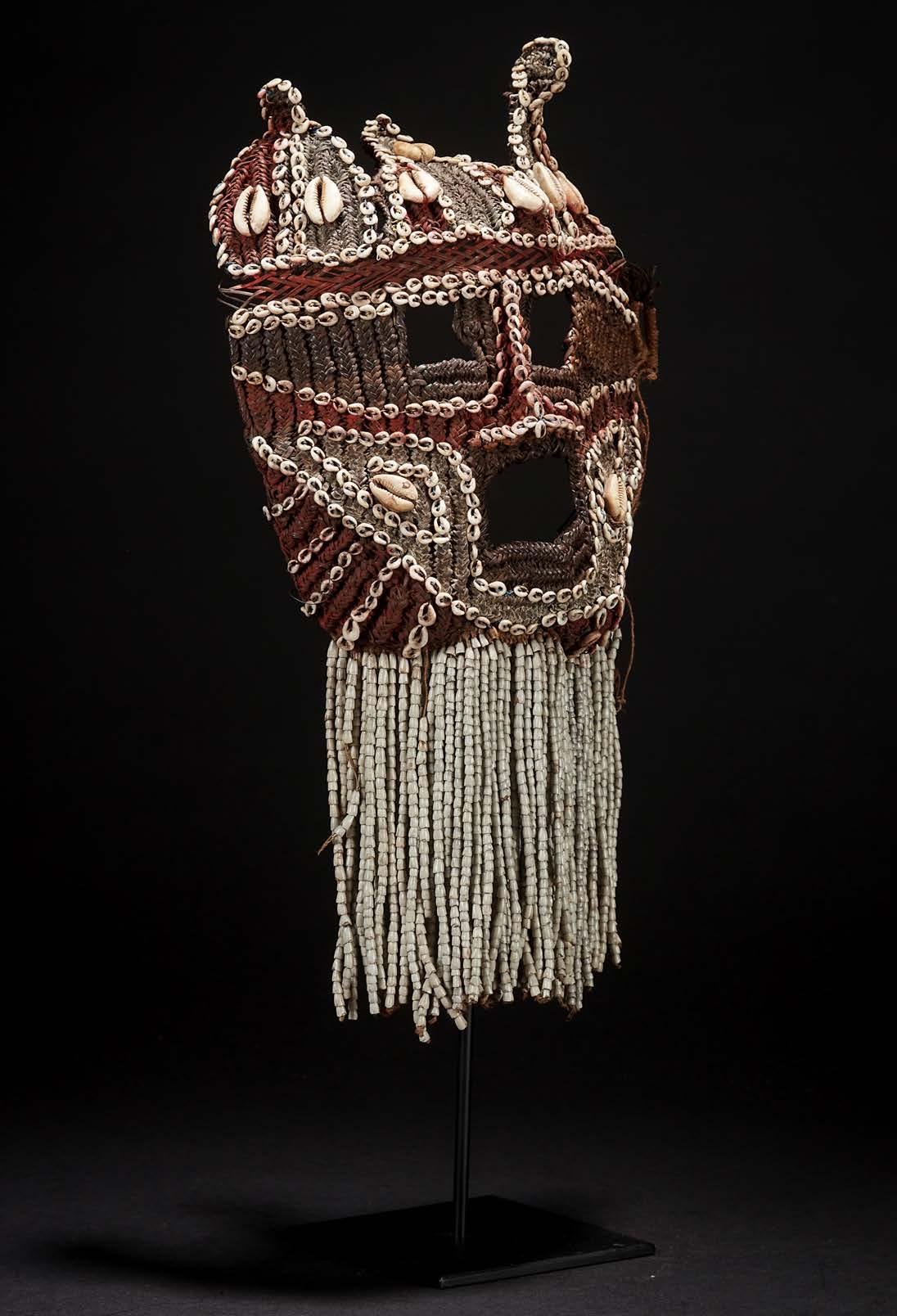

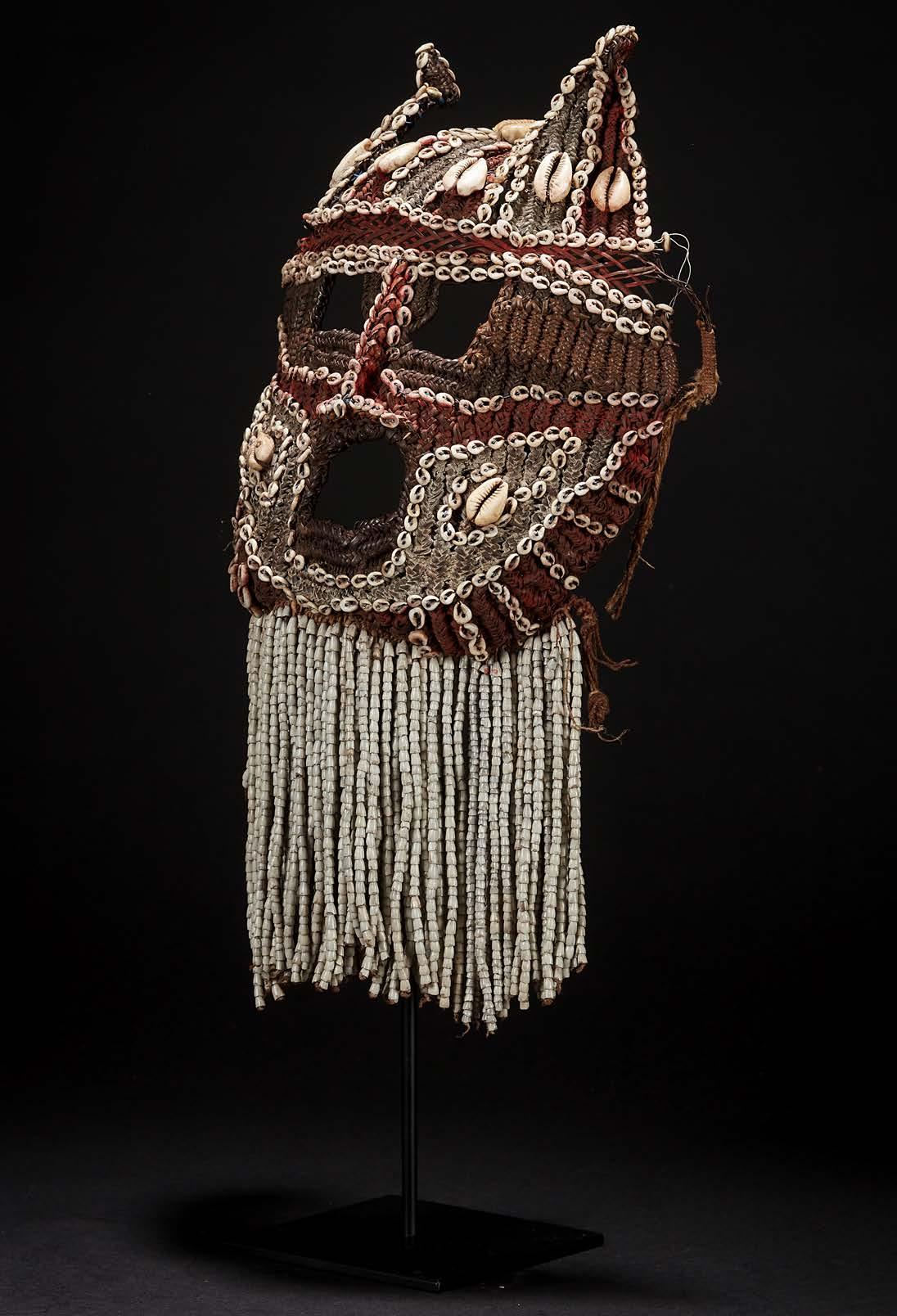

19. THREE ANCIENT LARGE CHURRINGAS
Central Desert, Australia
Provenance: ex-William Dunmall, ex-private museum
Churringas hold information within their carved form about ceremony and landscape. These three tall churringas each almost six feet tall, were in the collection of William Dunmall who displayed them in his private museum, , at Harvey Bay in Queensland from the early 1970s.
a) The full length is engraved with the inter-locking motifs that are typical of Kimberly designs. Each inter-locking element is then finely engraved with diagonal lines, now quite worn and ancient. It is covered in red ochre on the front and also the un-engraved back.
Dunmall’s catalogue numbe +_010”.
b) The full length of this ancient piece is engraved with the typical inter-locking motifs, then very fine diagonal lines within. This is probably the most ancient of these three chu ringa, still substantially intact, but showing areas that have simply disappeared with age. “Hooks” have formed on this piece, possibly where the wood was softer or thinner, giving it a quite ethereal feel. It is covered in a dark red pigment on the front and the un-engraved back.
Dunmall’s catalogue number “011”.
c) This is a beautiful, sinuous piece, wider at the top and almost pointed at the base. The front is covered in small delicate chevron engravings or, probably more precisely, undulating lines across the front that suggest
Dunmall’s catalogue number “012’.
a) € 2,200
b) € 2,200
c) € 2,200



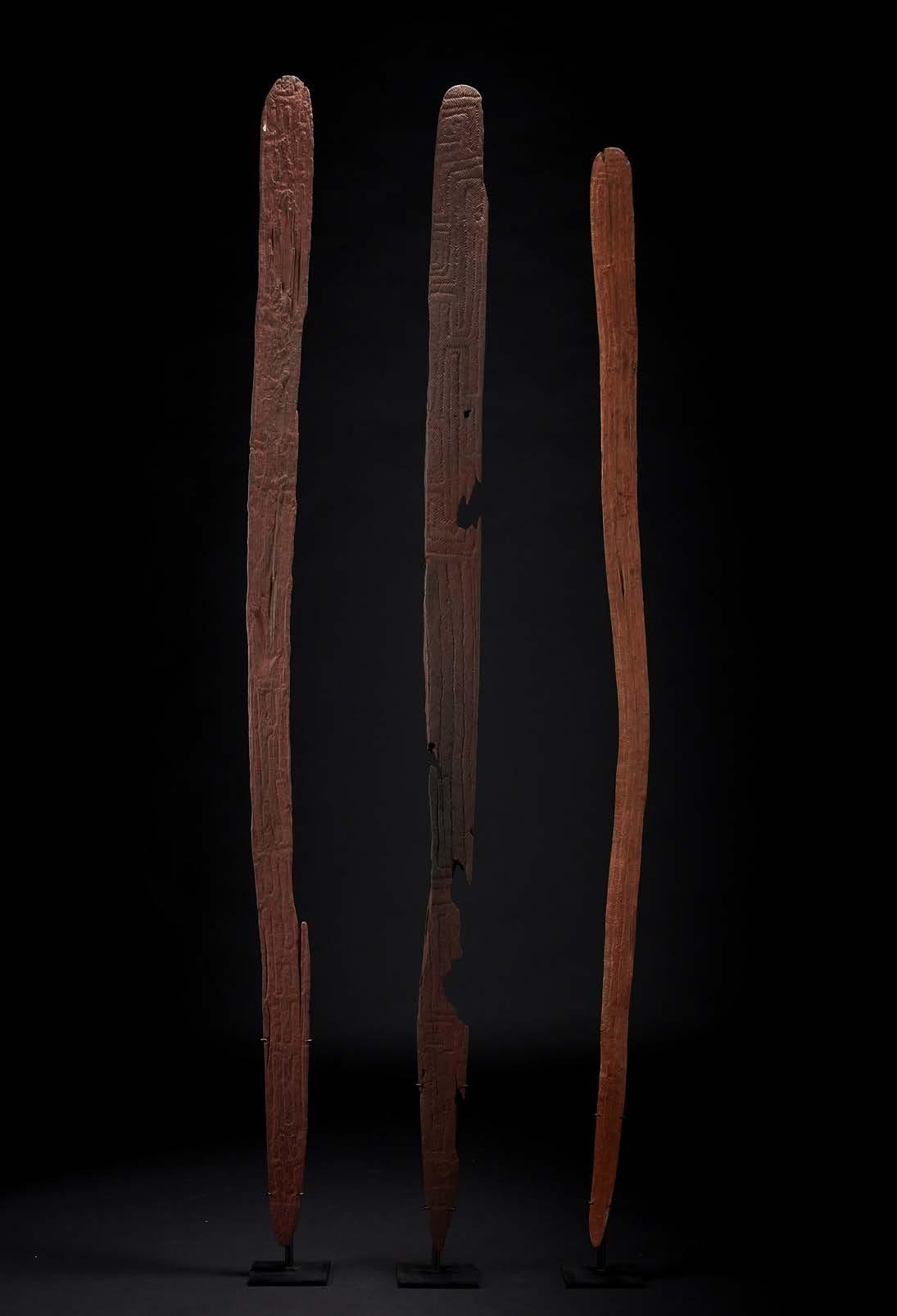


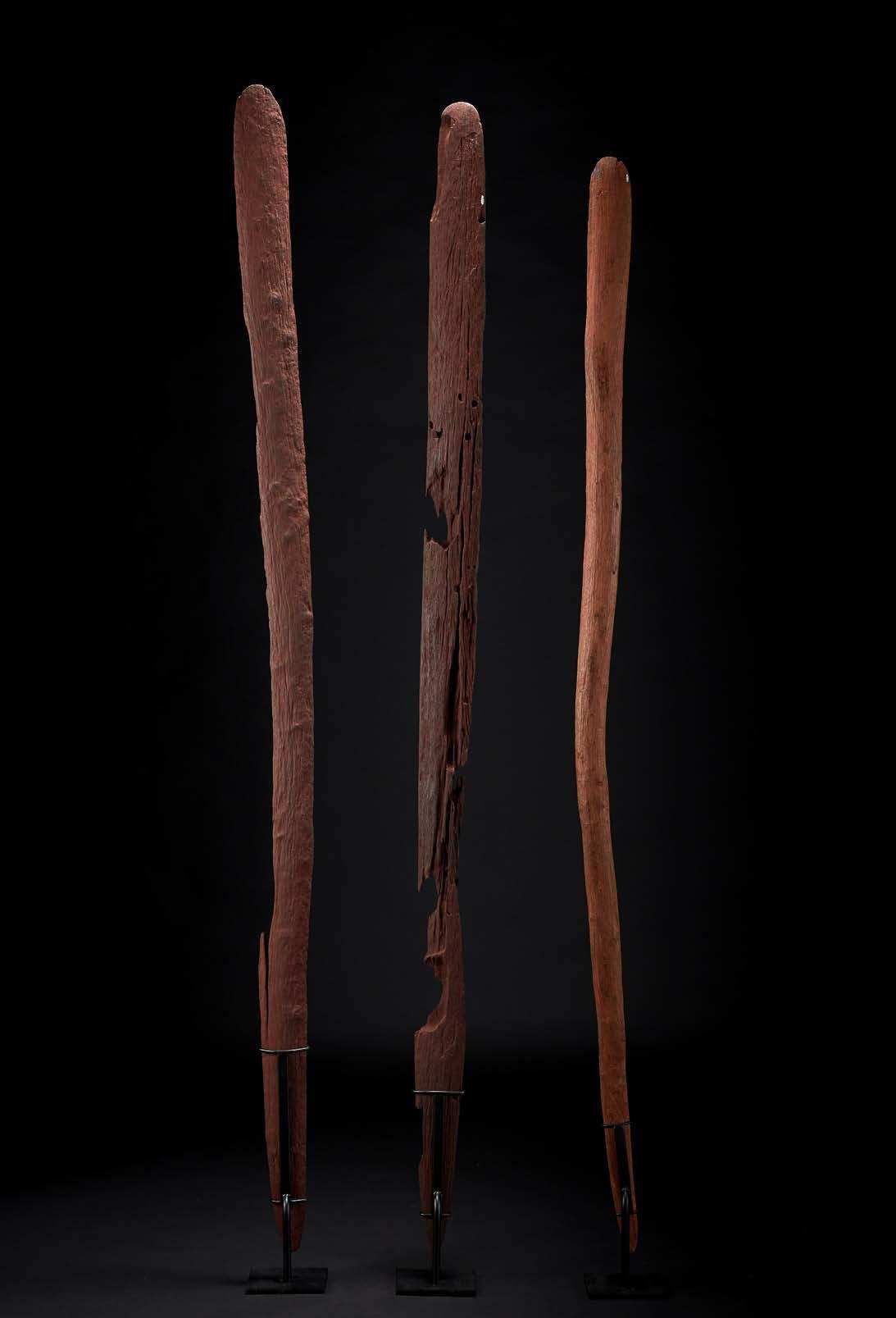

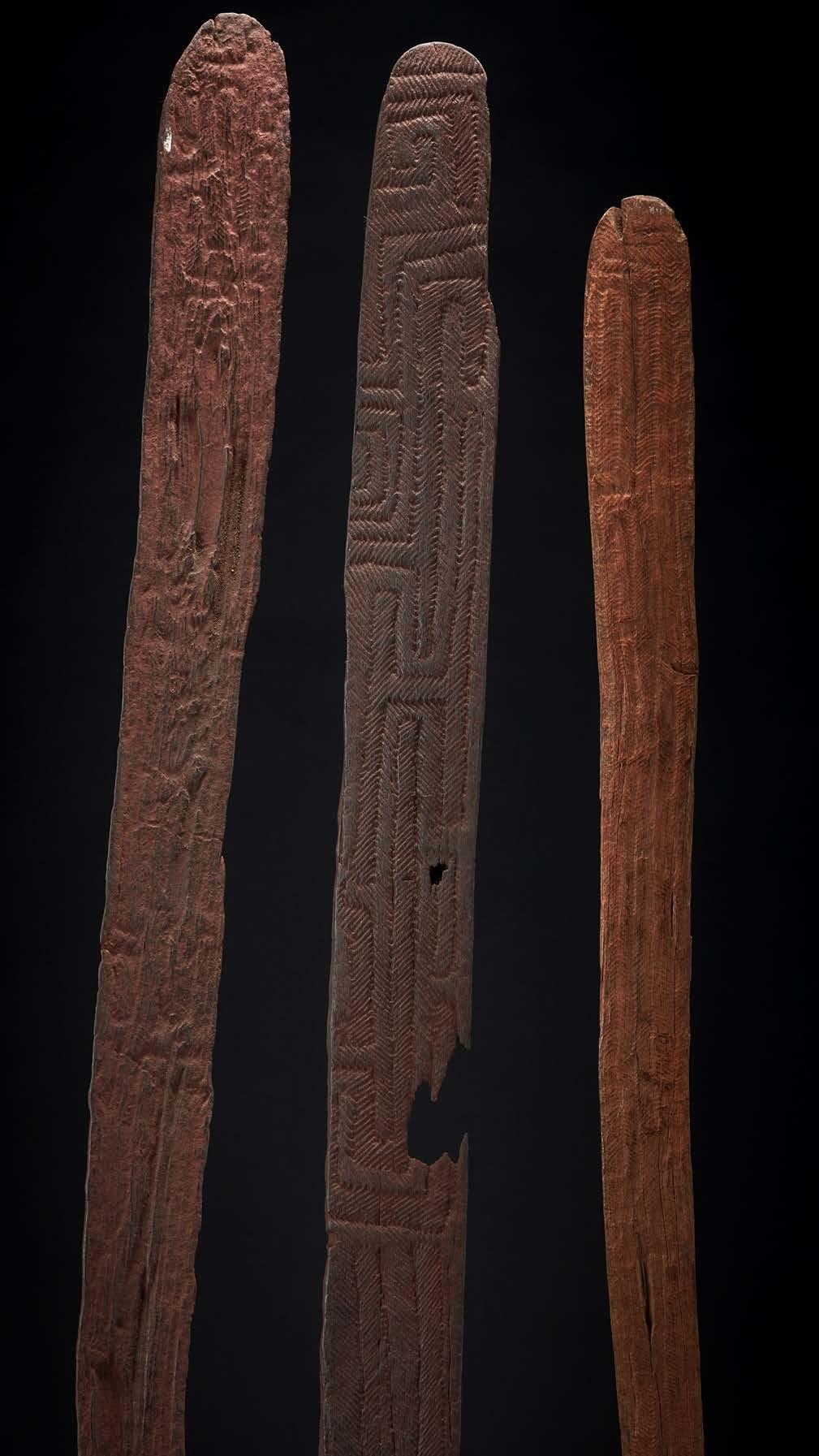
20. TWO WOVEN ABELAM MASKS
Wosera, southern Abelam, East Sepik, Papua New Guinea.
a) This small finely woven mask decorated with a beard of fine chains is worn by male dancers in the elaborate initiation ceremony. The galut covers the crown of the dancer’s head at the back of the large headdress and the chains hang down onto the dancer’s shoulders. Galut are quite rare, especially now that much of the truly elaborate dances of the Abelam are disappearing.
b) Yam mask, babamini, attached to yams for the annual yam lining fertility ceremony. It is old, very finely woven and decorated with chains of nassa shells and fine cane rings is most unusual. ex-important Tahitian collection.
a) 48 x 16 x 14 cm
b) 20 x 8 x 7 cm
a) € 2,800
b) € 1,400

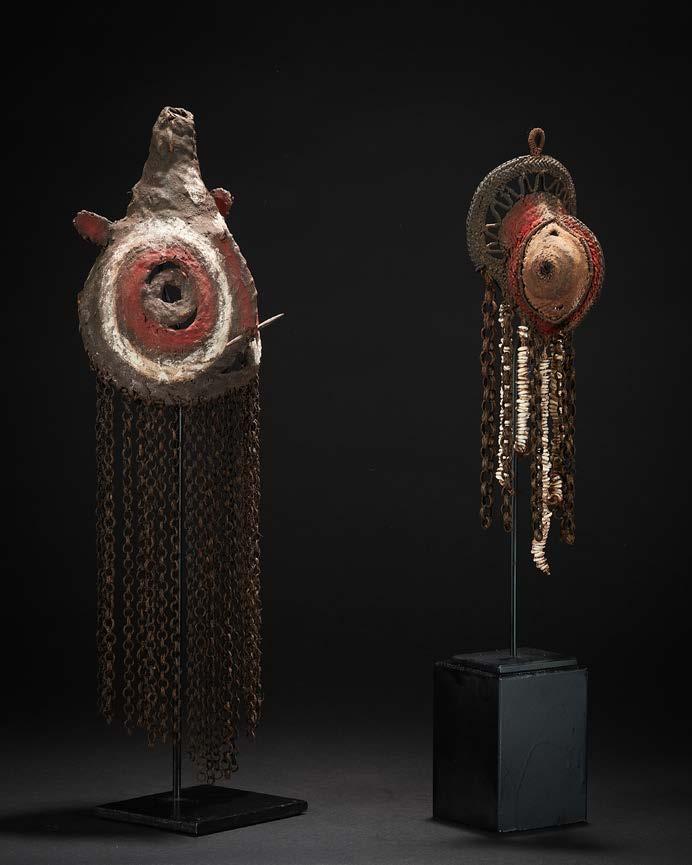
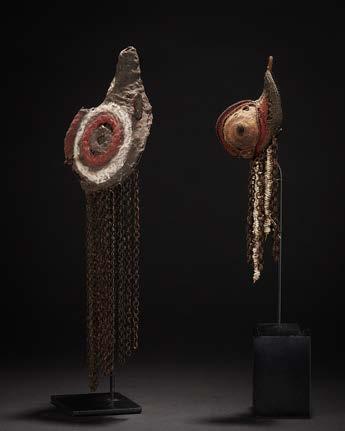
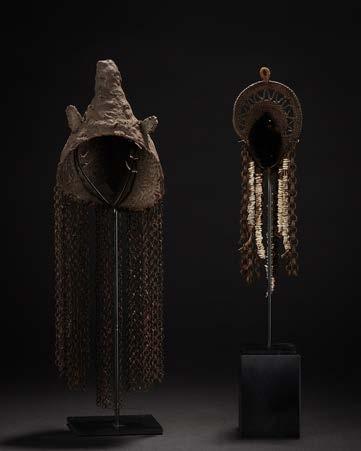

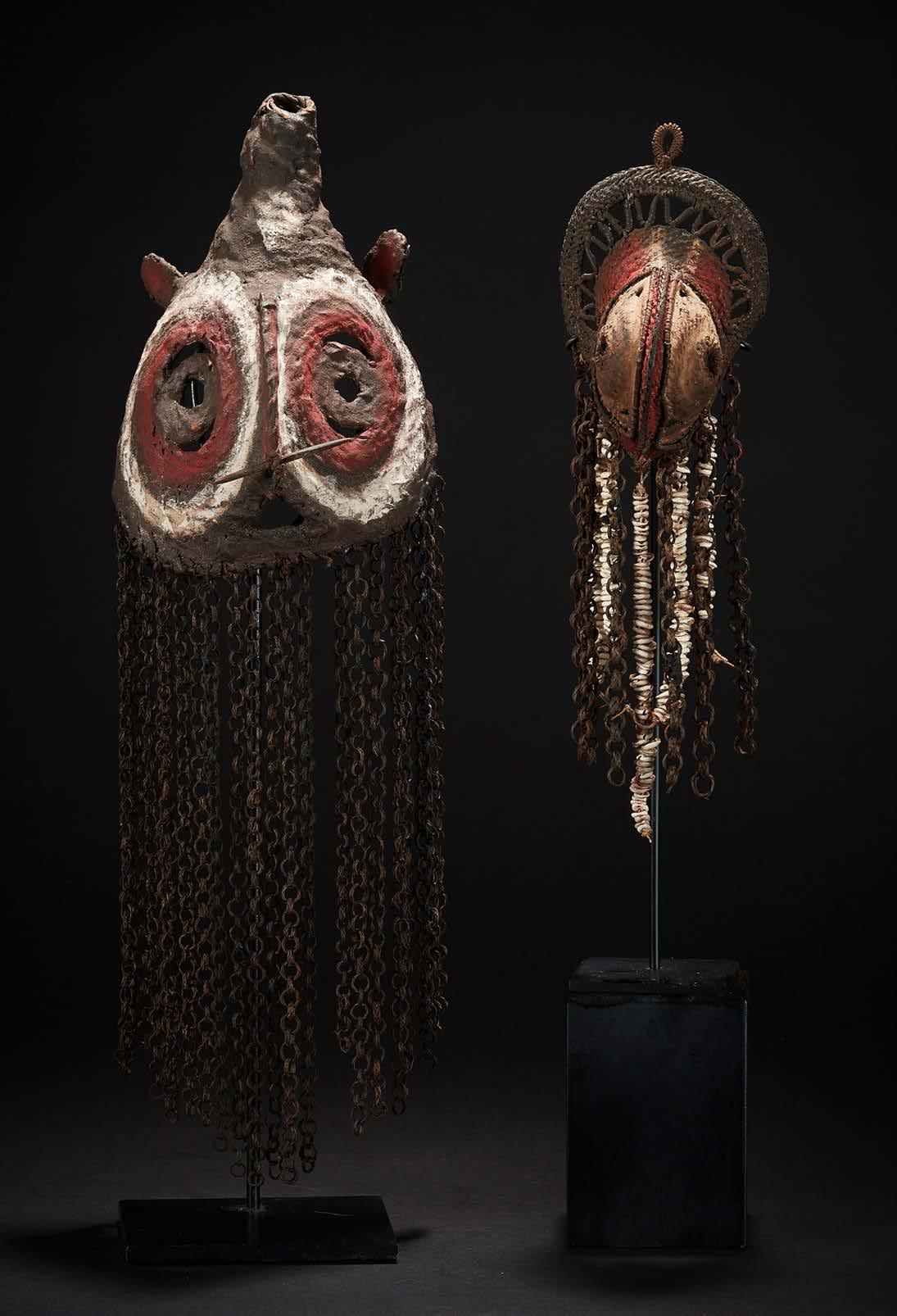
21. WOVEN BAT FIGURE
Abelam, Sepik Plains, Papua New Guinea.
This woven bat figure, with a baby’s head protruding from its pouch, is an exceptional and dynamic piece made with the most amazing detail. Animal forms, especially birds, are used in all Abelam ceremonies as representation of clan totems. The weaving and detailing of this woven bat is superb, obviously by a master-craftsman. The wings are wide and curve sinuously giving them an energetic rounded form suggesting flight. The claws in the feet and extra claws on the wings use the very claws of this bat (which is also a favourite food source).It depicts the largest bat in Melanesia, the Great Flying Fox (Pteropus neohibernicus). Such figures may be displayed on the front of the Haus Tambaran, protected under the eaves; or more likely inside the Haus Tambaran, as part of the initiation scene.
This figure was collected in the 1970s by a teacher at Maprik High School. It was in the southern Abelam region, Wosera, and most probably Wombisa village.
23 x 39 x 19 cm
€ 2,800

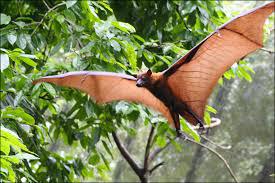
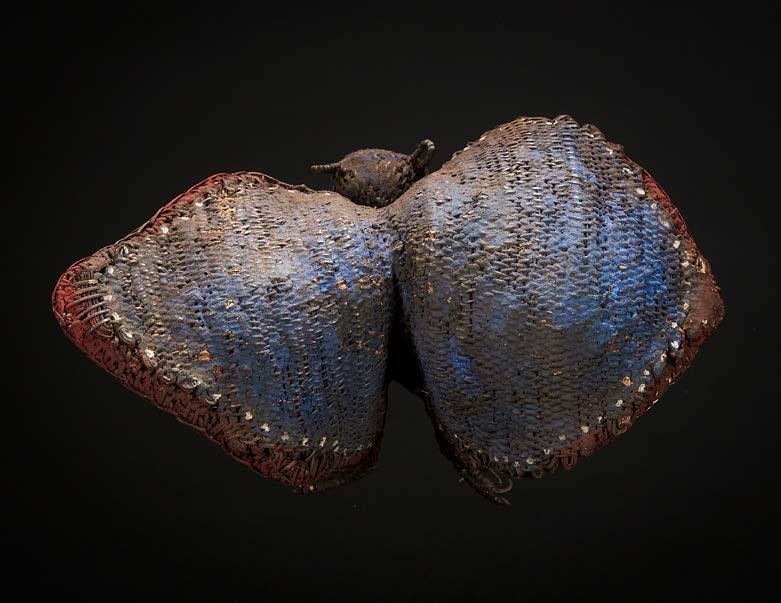
The great flying fox (Pteropus neohibernicus), the largest Bat species in Papua New Guinea.

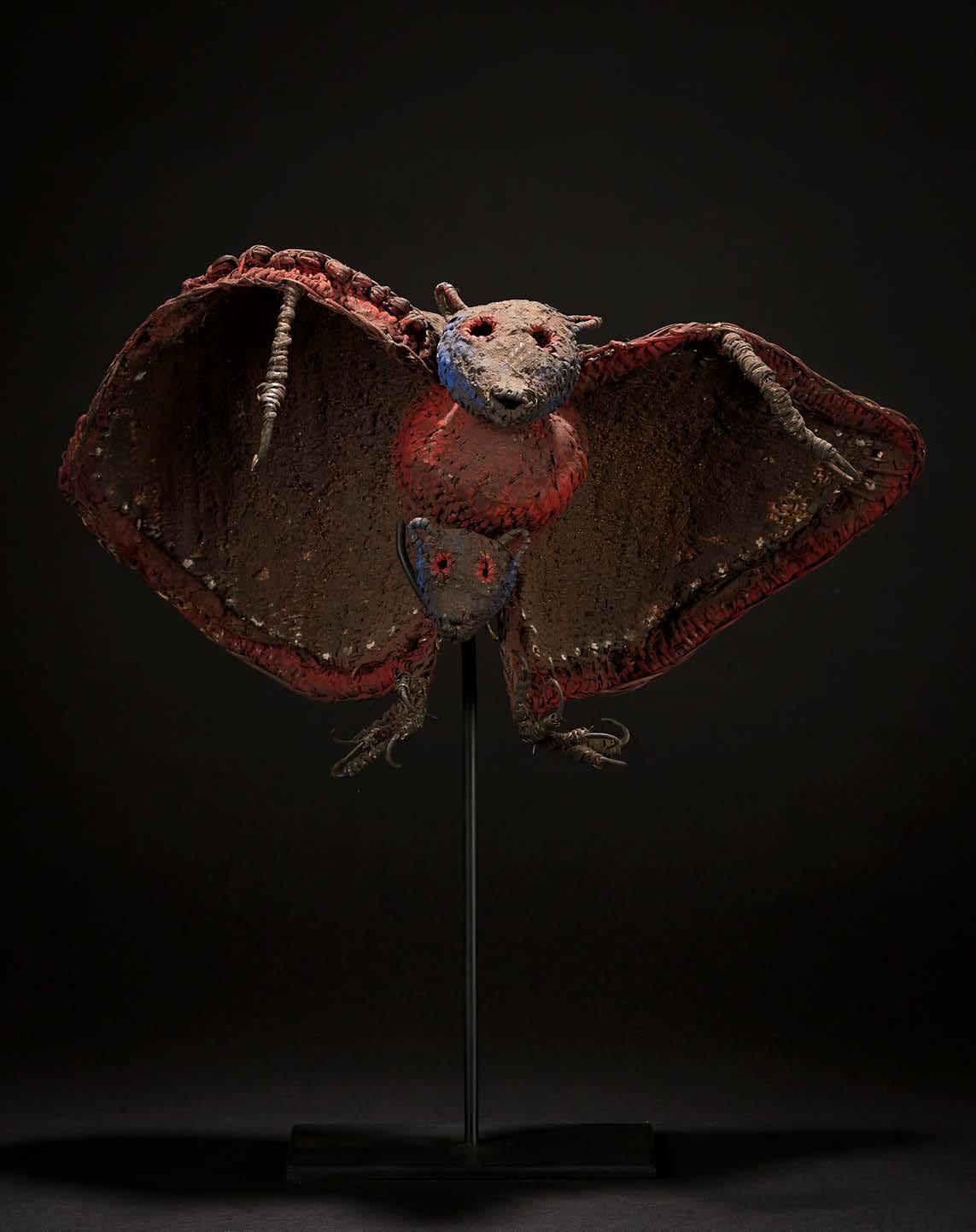

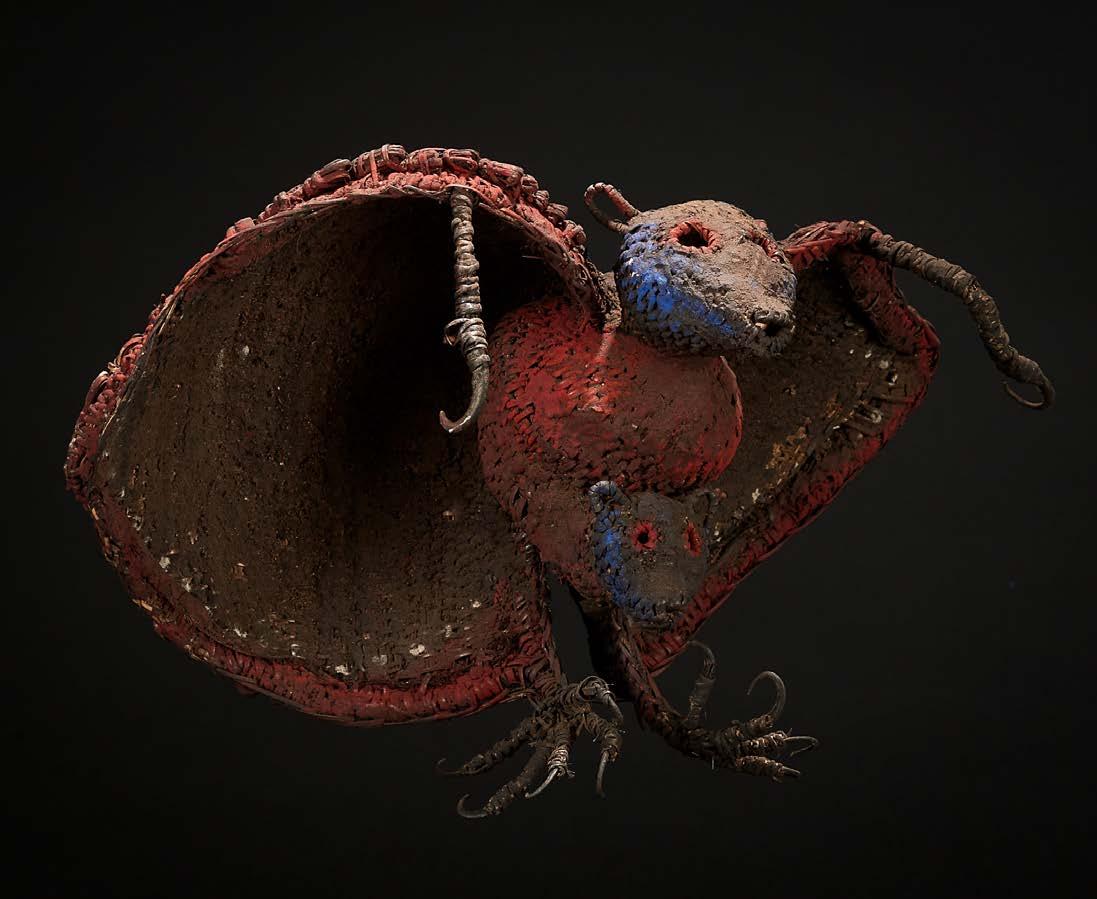

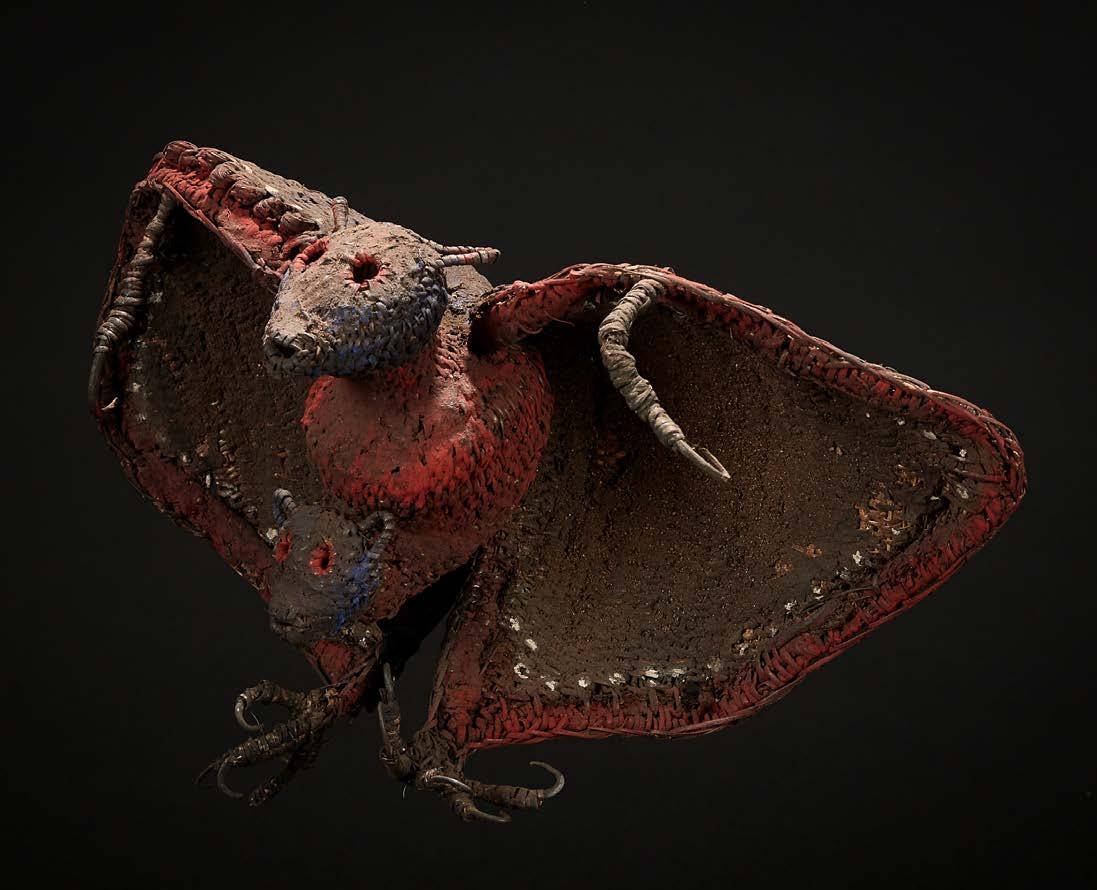
22. TWO EARLY MUNDUGUMOR FIGURES
Yuat River, Lower Sepik River, Papua New Guinea.
a) Small squatting figure with lively stance and a wide open face. Mounted on a black stone block. ex-coll Carl Shipman, Australia.
b) A figure combining human, bird and crocodile features, together in an abstracted form standing on a star-like base. It comes from an old Sydney collection but the earlier owner, with collection number ‘E106” is unknown.
a) 15 x 6 x 6 cm
b) 30 x 9 x 9 cm
a) € 1,000
b) € 1,200

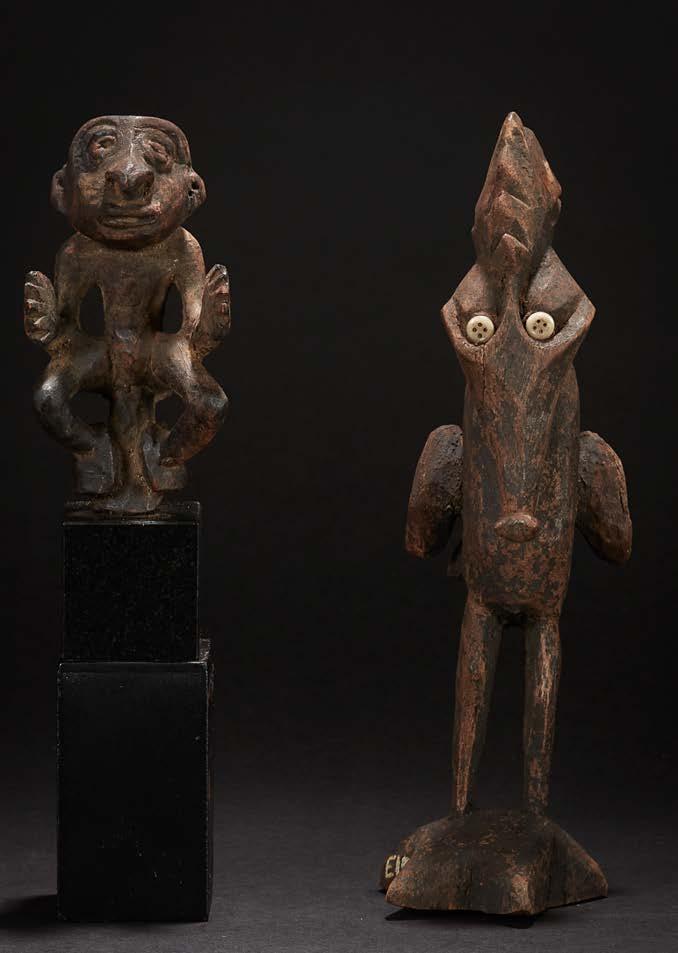
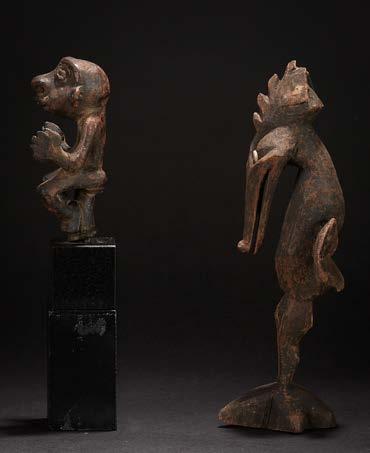

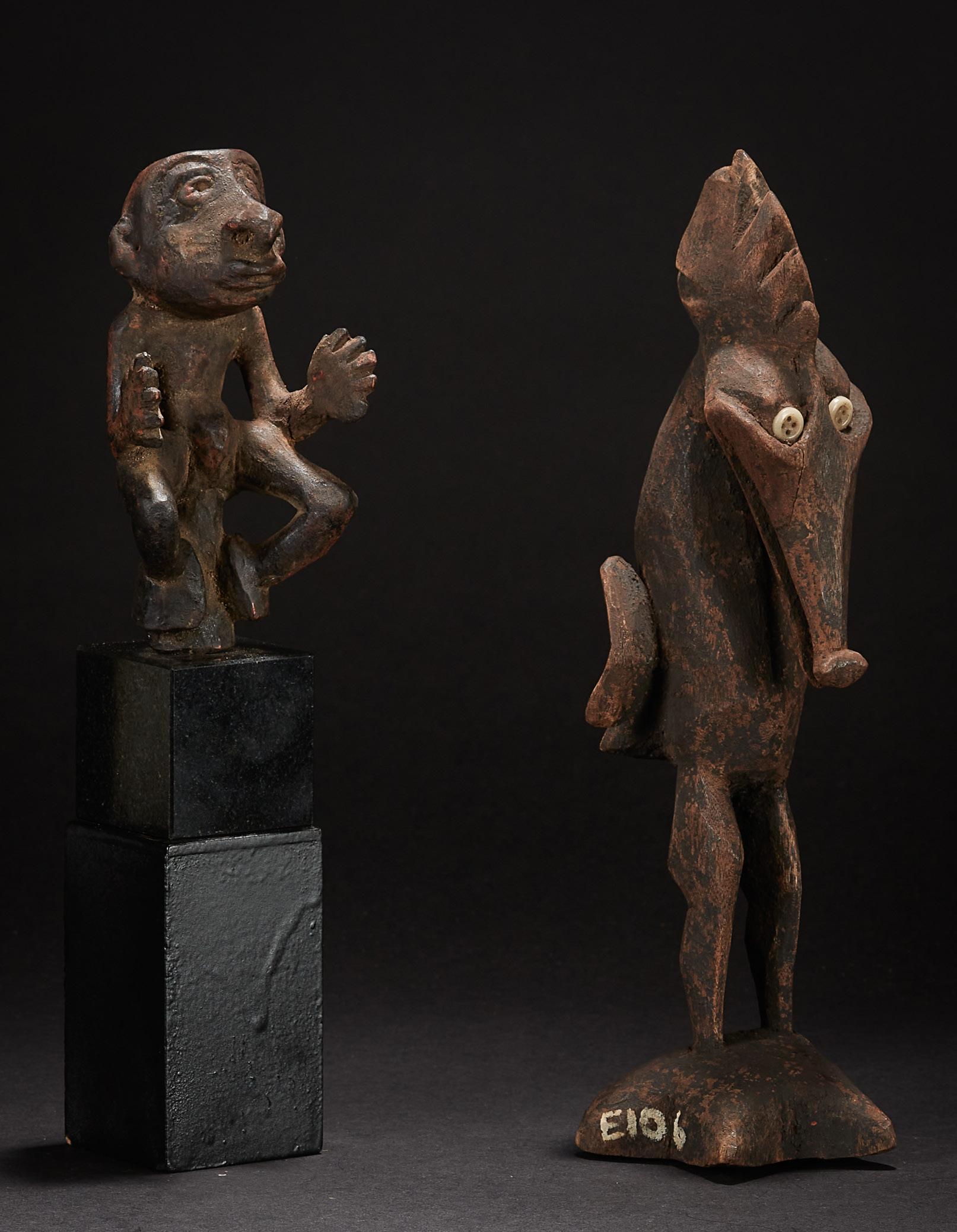
23. FIGHTING SHIELD
Upper Lai Valley, Southern Highlands, Papua New Guinea.
Provenance: Collected in 1988 by Chris Boylan in the Upper Lai Valley.
The warriors of the Upper Lai Valley paint their shields like no others, using abstract flowing forms half-immersed in an almost expressionistic palette. An ancestral figure, with arms raised and legs apart emerges from the swirling yellow, green and white; and there are obvious layering of re-painting having occurred over generations. This region in the Upper Lai Valley is remote, with no road access, and traditional fighting continued well into the 21st century.
approx 142 x 36 cm
€ 4,500

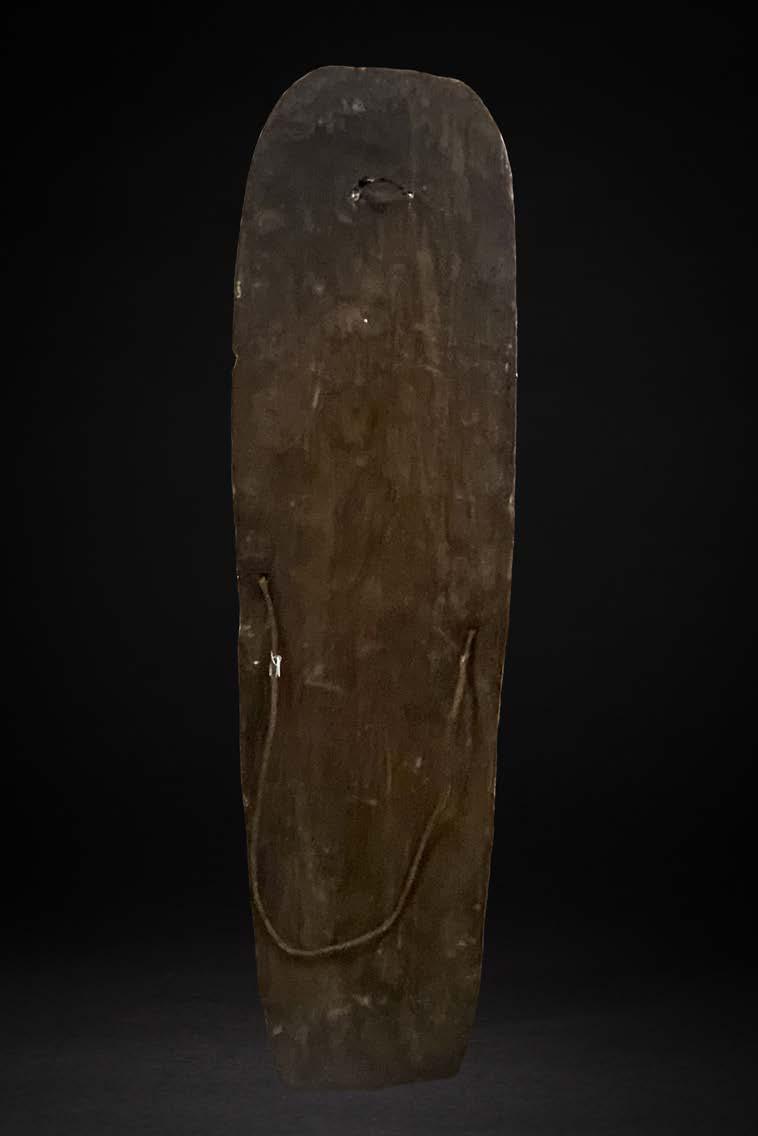

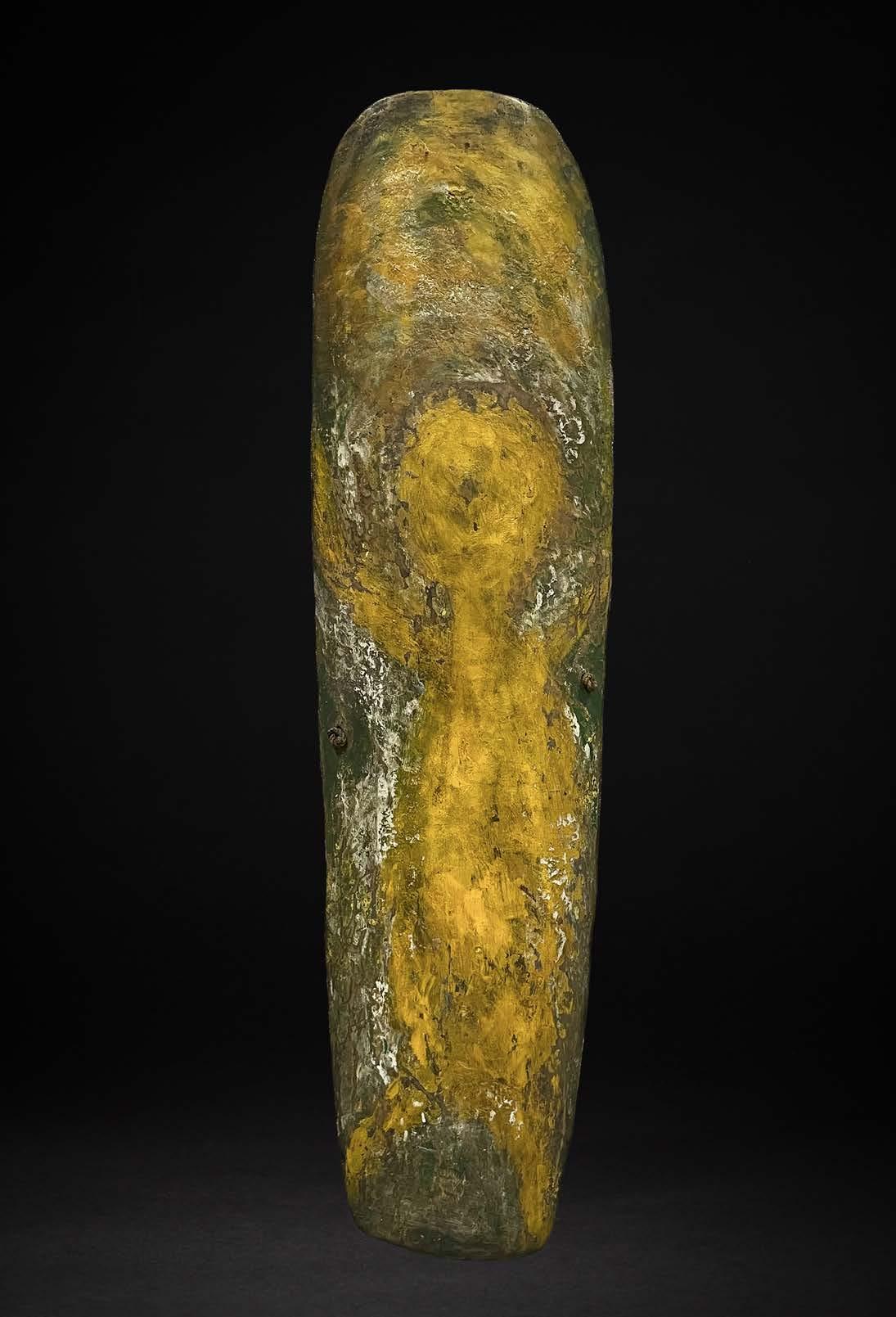
24. OLD WAR SHIELD
Dreikikir, Torricelli Mountains, East Sepik, Papua New Guinea. Early 20thC.
Provenance: Old Australian collection: Sohebys, Australia sale c. 1987. ex-private collection, NSW; collection the late Bill Evans, Sydney.
The front surface of the shield is covered entirely with delicate engraved designs. Shields from this region are rare, and generally use only geometric patterns. This shield has a wonderful squatting figure just below the central circular motifs. There is no paint remnants as these shields are so rare, it is unknown whether or not they were painted. It has an overall brown patina front and back.
Published: “Shields of Melanesia” Ed. Harry Beran and Barry Craig, Crawford House Publishing, Australia, 2005, Figure 4.25
120 x 32 x 3 cm
€ 12,500

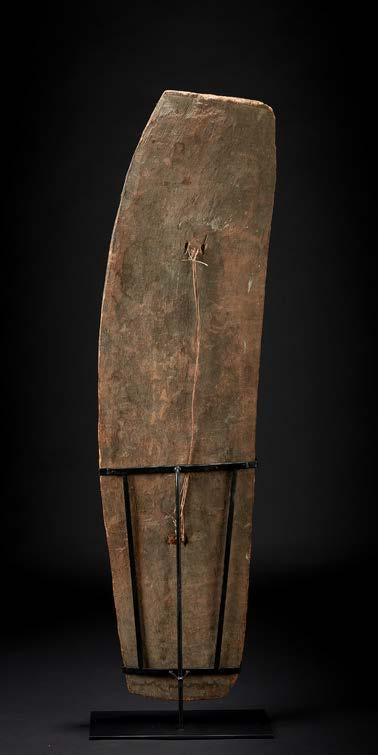
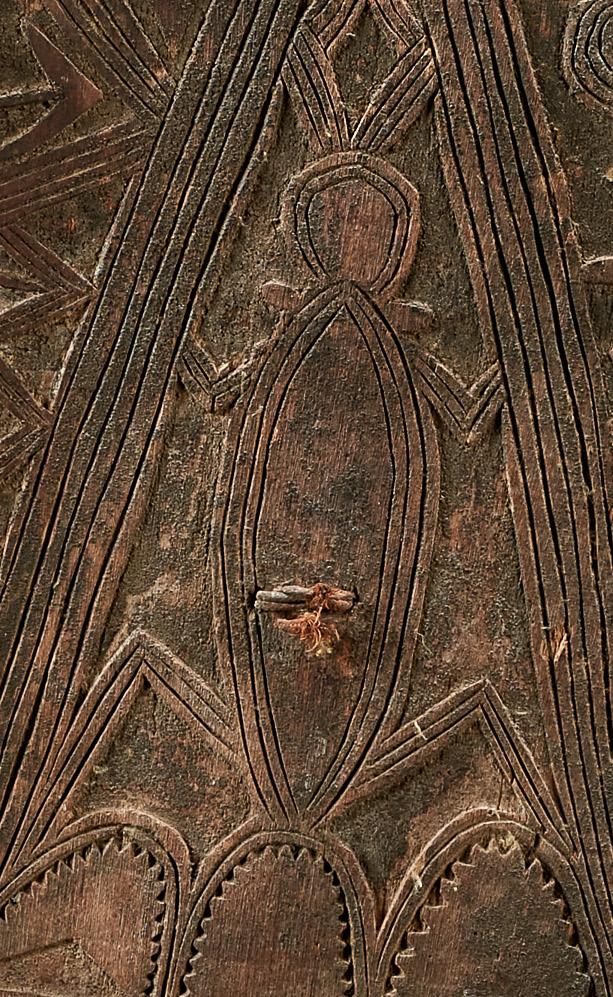

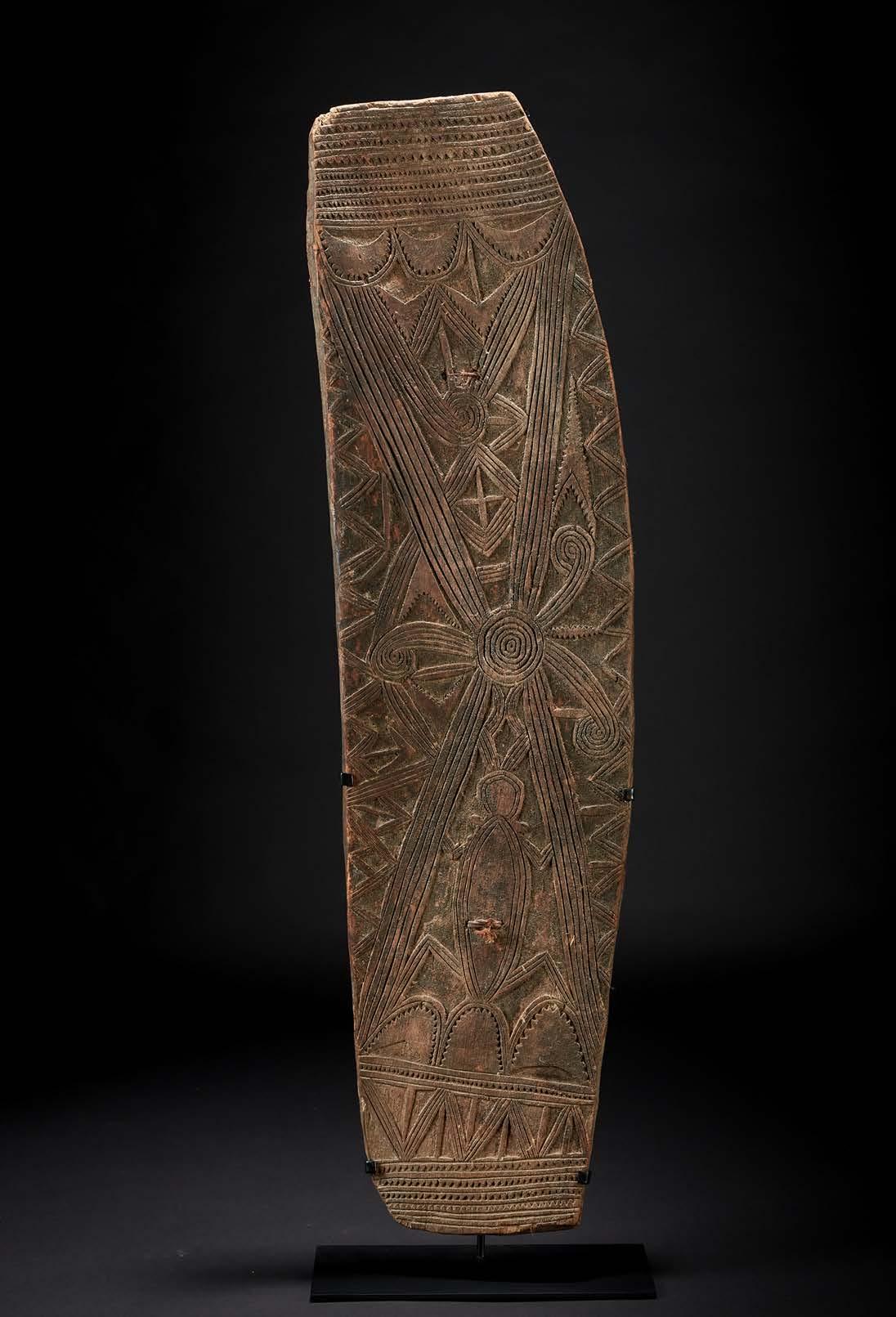
25. PREHISTORIC STONE FIGURE
Enga, New Guinea Highlands.
Provenance: ex -collection Ron Ingle, a geologist working in the Enga region 1962-63.
This stone figure is in almost perfect condition, except for a few chips on one arm. This squatting figure with elongated neck and arched head completed with flared nostrils, is said to represent a foetal echidna. There are several well-known superb examples in museum collections. This example is taller and slimmer than these mentioned, but displays essentially all the same details. The surface of the stone shows small pecking marks that show the slow, painstaking production by a stone-age artist.
31 x 8.5 x 4.5 cm

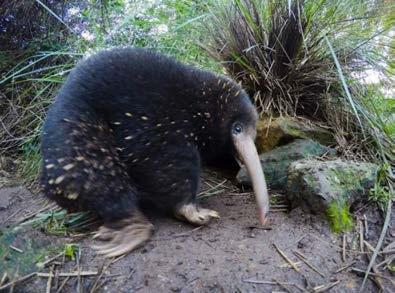
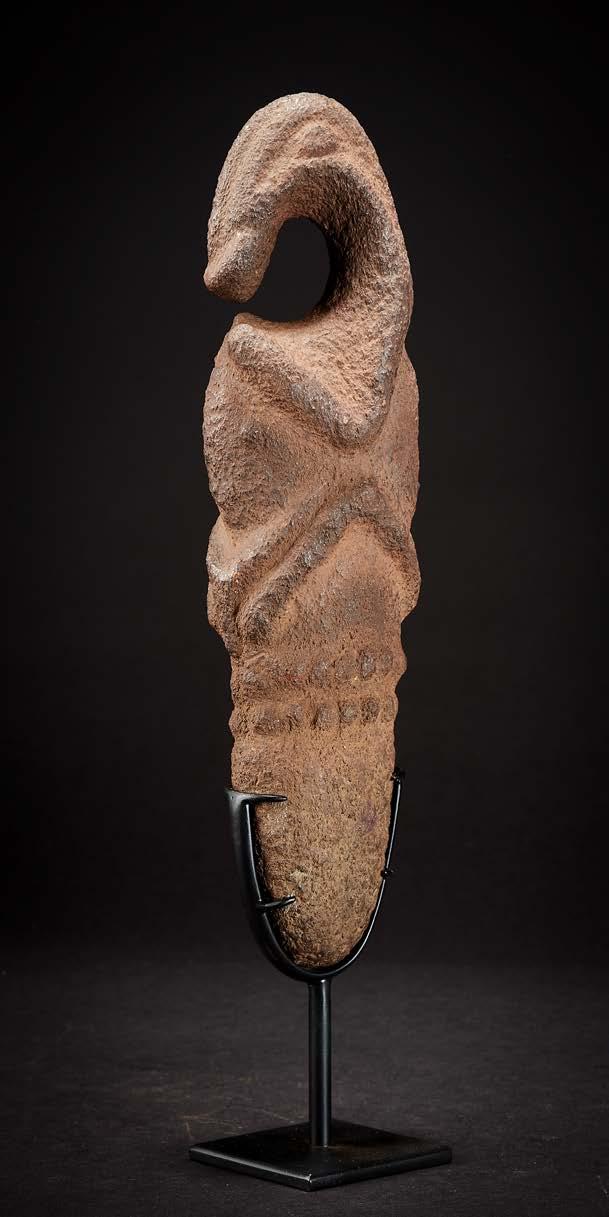
POA
This ancient stone figure is thought to represent some aspect of this echidna, Zaglossus bartoni, eastern long beaked echidna.

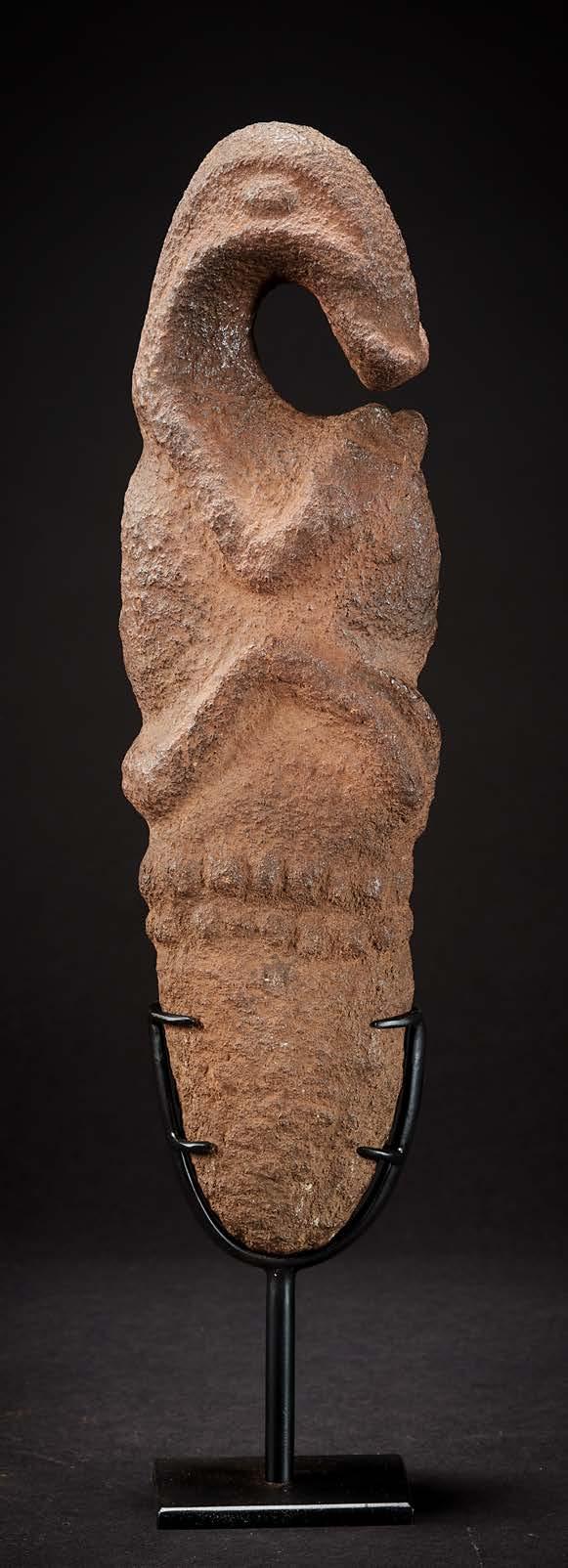

25a. PREHISTORIC STONE FIGURES
Enga, New Guinea Highlands.
Provenance: Both small figures are also from the Ron Ingle collection, 1962-63.
a) The stone figure has both bird and marsupial qualities and is essentially a morphed figure combining elements of unknown animals. This is a truly fluid and engaging form.
b) This stone figure is more marsupial in its form, displaying definite “arms. Both figures have a soft and alluring quality that come only with their great age.
a) 10.5 x 6 x 8 cm
b) 11 x 4.5 x 5.5 cm
a) € 3,600
b) € 2,400

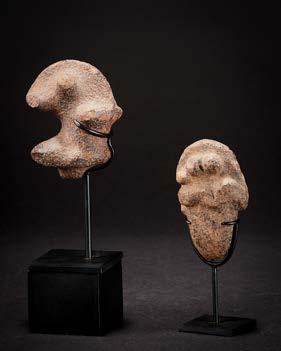
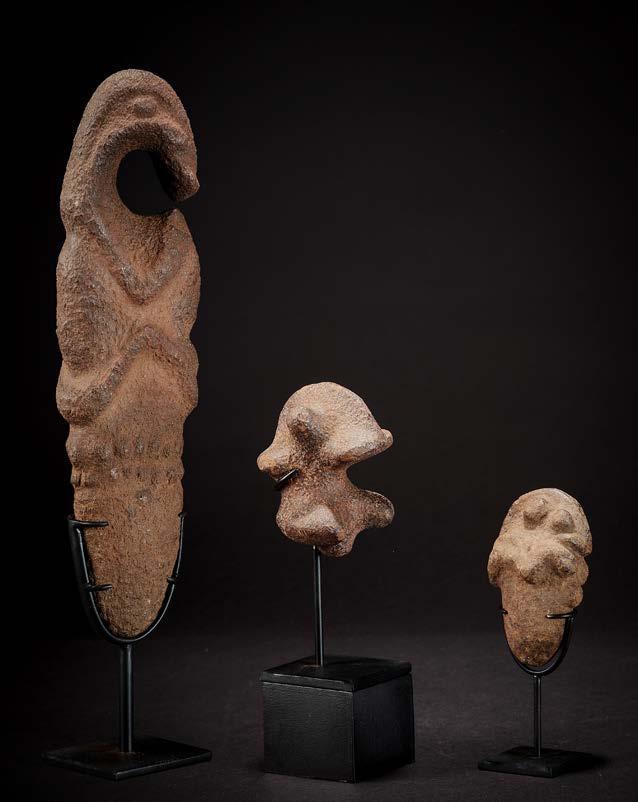

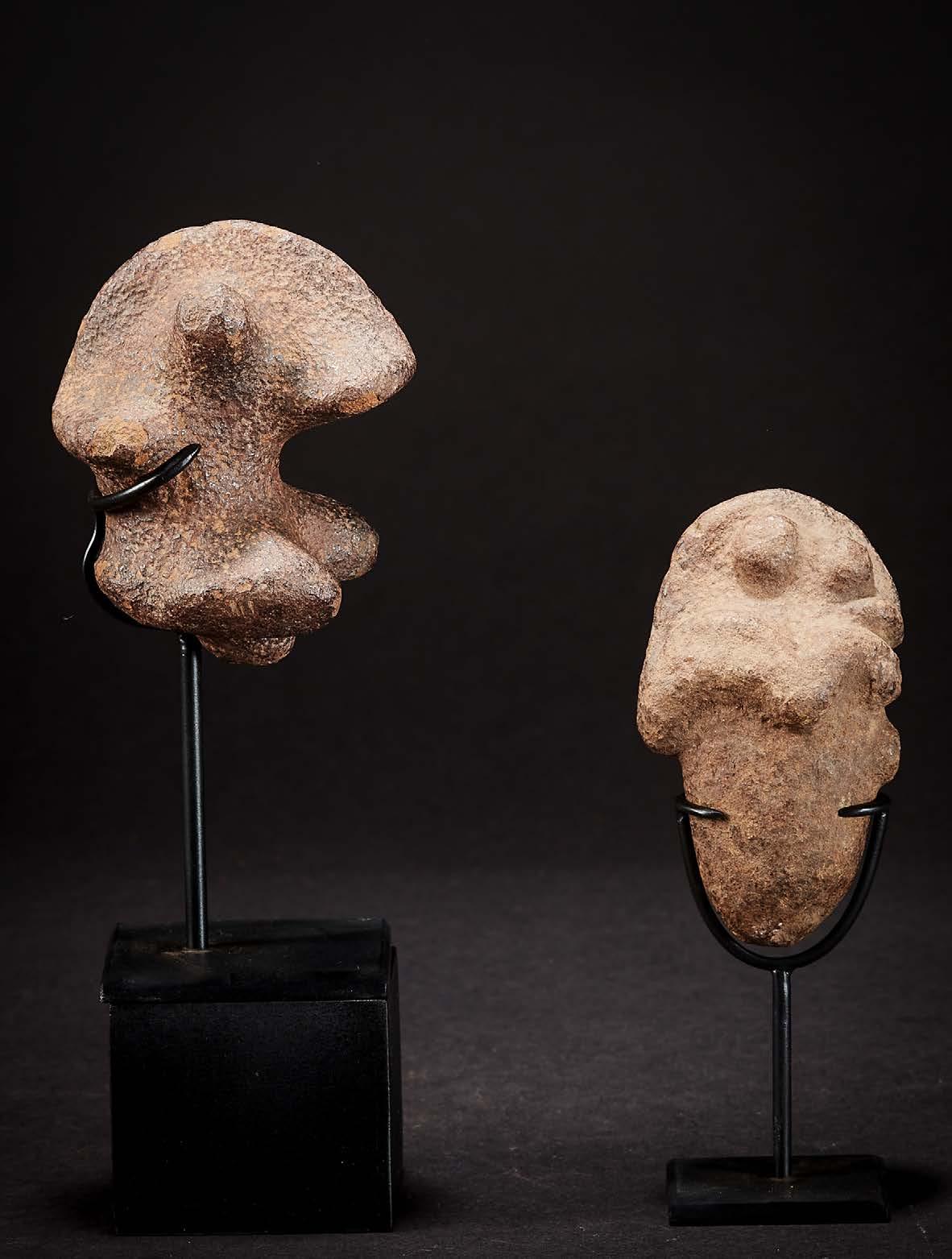
26. WAR SHIELD
Wonanara, Adelbert Ranges, Eastern Highlands, Papua New Guinea.
Provenance: ex-Michael Hamson, USA.
The shield is stone-carved and pre-contact with an overall wonderful patina front and back. This triangular-shaped shield, with woven cane shoulder sling, is typical from the Wonanara region. What is unusual and so beautiful on this particular shield is the raised curved ridge, highlighted above with red, below with cloud-like dapples. The shield is carried during warefare with the bold cane sling over the shoulder to protect the warriors.
85 x 32 x 4 cm € 4,000

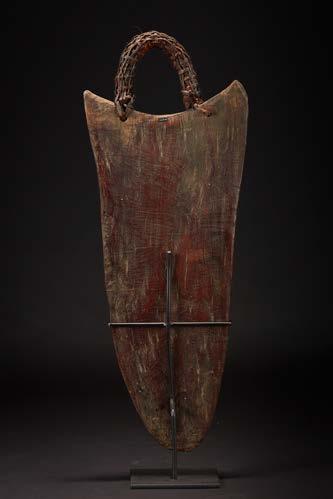
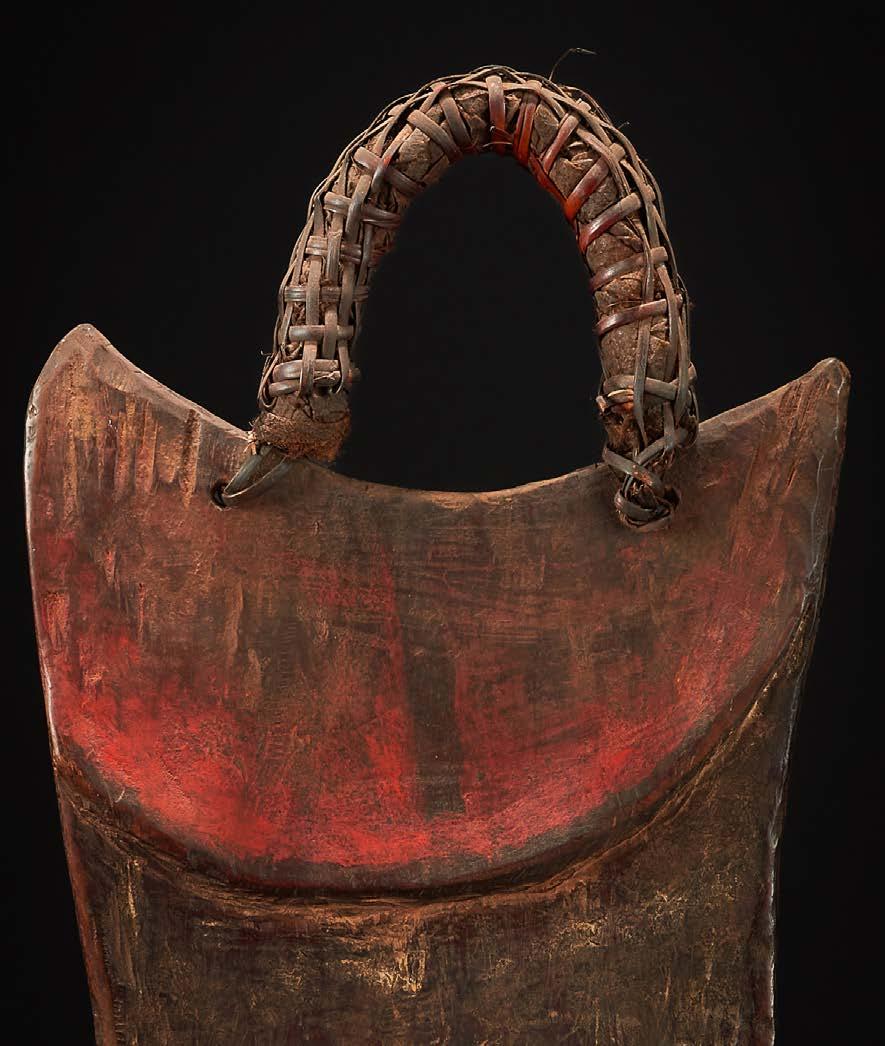

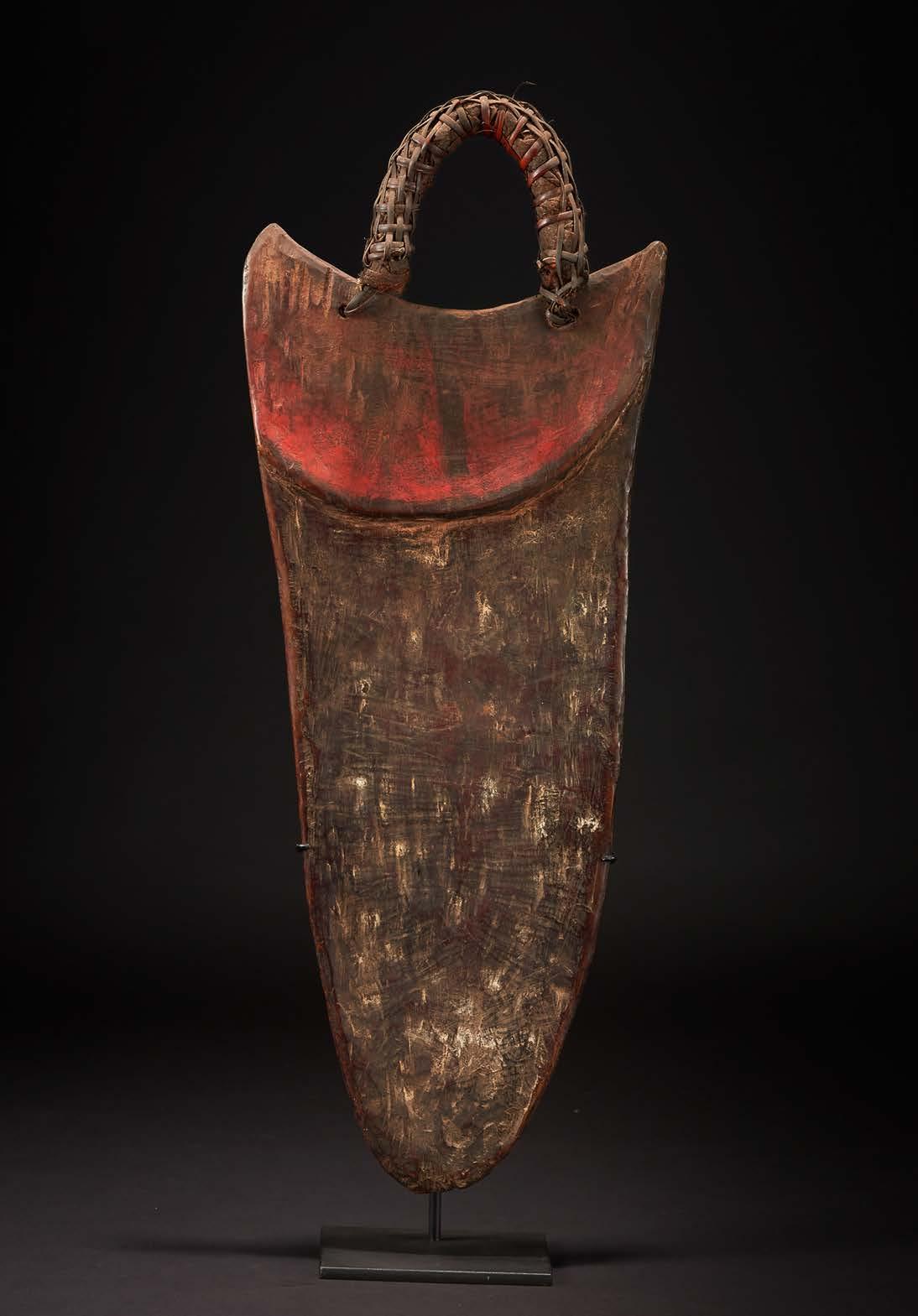
27. RED SPONDYLUS SHELL DECORATED SPATULAS
Massim, Papua New Guinea. (Spondylus spinosus)
a) Cerenial hardwood comb, decorated profusel both edges with spndolus tassles, Oro Province, PNG.
b) Tall slim lime spatula, decorated with red spondulus discs, Trobriand Islands, PNG.
c) Turtle shell spatula, with top half decorated with spondylus shells, Sudest Island, Massim, PNG.
a) 26 x 7 cm
b) 44 x 3 x 5 cm
c) 22.5 x 4.5 cm

a) € 900
b) € 600
c) € 900
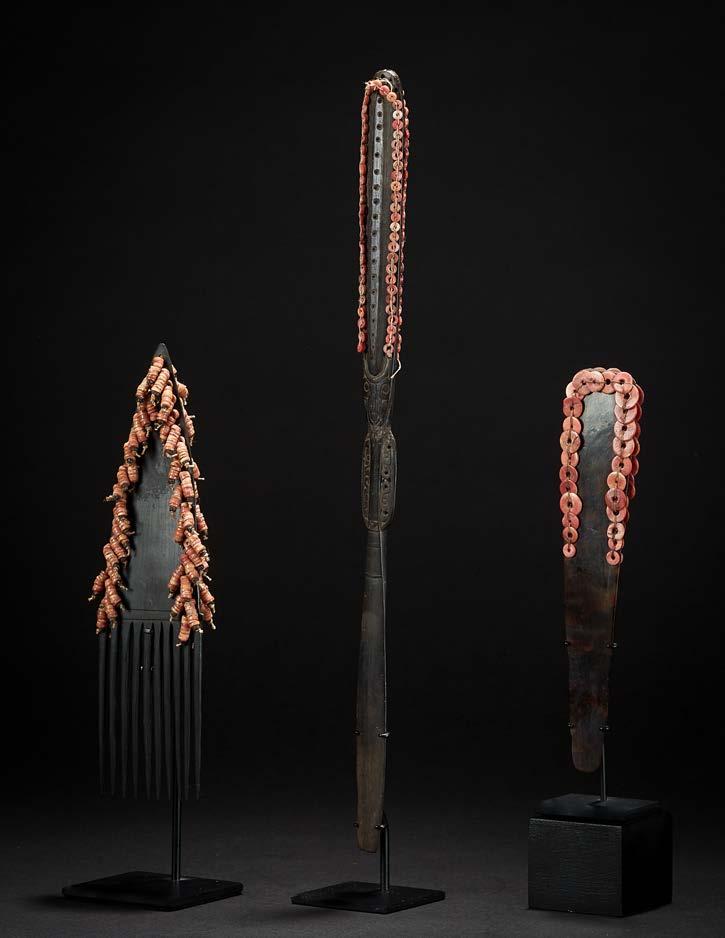
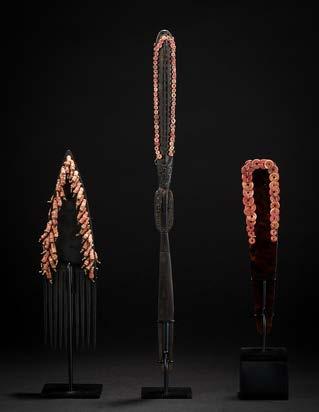

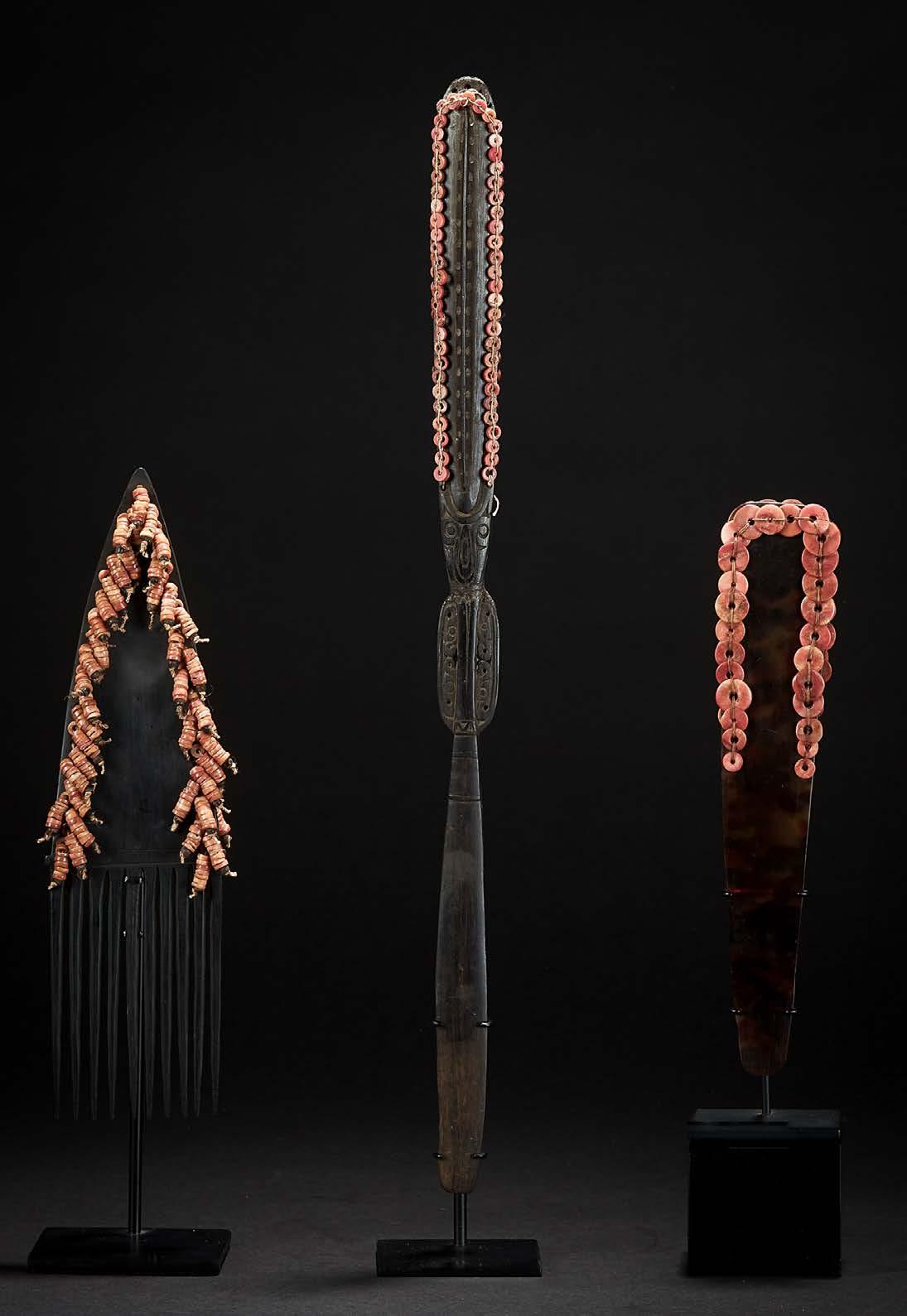
28. ABORIGINAL STONE KNIVES & STONE CHURRINGA
Central Desert, Australia.
Both stone knives ex-collection Professor Peter McCabe, Adelaide. ( “568” and “567” )
a & c) Both are made from chipped quartzite that forms a point and, more importantly, sharp cutting edges. The handle is made of tree resin, and coloured with natural red pigment. These knives are used for circumcision in male initiation.
b) This beautiful oval stone is engraved both sides with central radiating circles and various geometric motifs beyond.
Provenance: Collected by Robert Croll c, 1928; ex-collection, Sydney; ex-collection Netherlands.
a) 18 x 6.5 x 3.5 cm
b) 19.5 x 7 x 1.5 cm
c) 15 x 5 x 2.5 cm

a) € 550
b) € 2,200
c) € 400
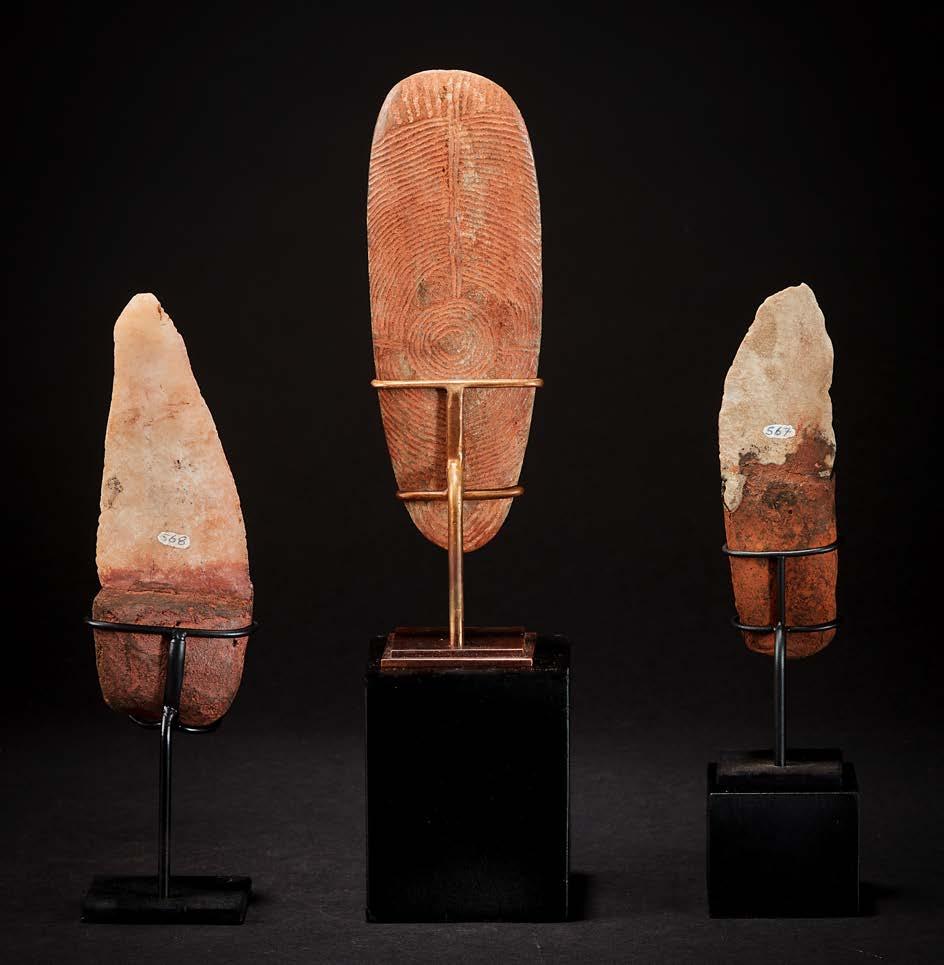

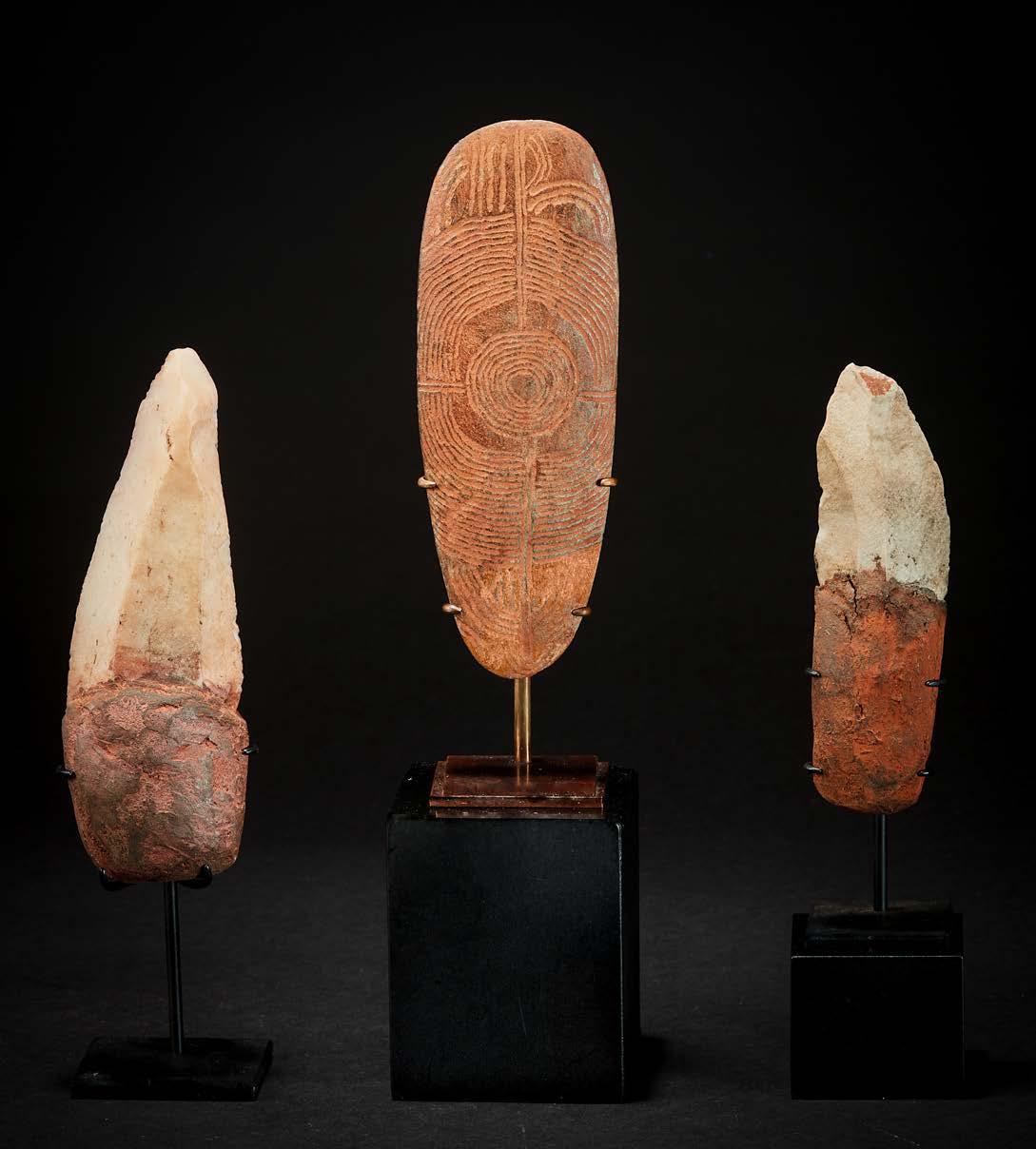
29. MAORI FEATHER BOX
Wakahuia, New Zealand. 19th Century.
Provenance: ex-important Tahitian collection.
Treasure boxes were the property of chiefs and used to hold valuables such as hei tiki, greenstone earrings and the tail feathers of the huia bird.The lugs at either end formed by the heads were used to suspend these boxes higher into the rafters. This beautifully carved example from the Te Arawa Iwi, dating c. 1880-1890, is of striking late 19thC Maori craftsmanship. It shows two heads at either end with their bodies curving beneath the box. As typical with much Maori carving the entire surface is embellished. This piece features intricate rauponga (notched ridge) and pakati (dog-tooth) patterns, with tupuna, the stylised ancestral figures dominating the two ends. The motifs on the lid and the base match perfectly, and the lid fits into the base with two dovetailed notches. Traces of the original kokowai (red ochre) anointing remains. The carving reflects the refined style of Rotorua-area master carvers of this period, combining spiritual symbolism and high technical skill.
66 x 20.5 x 20 cm

€ 14,000
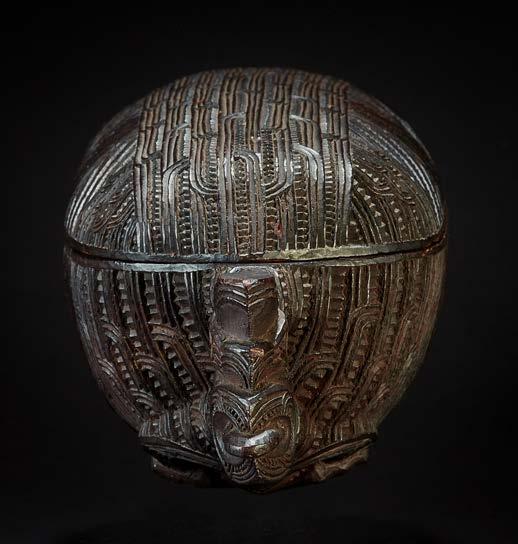
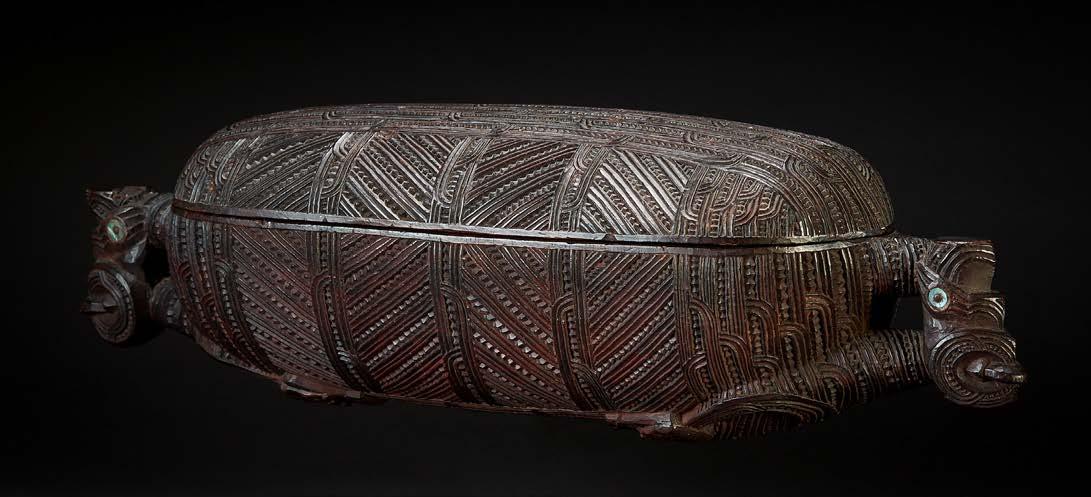
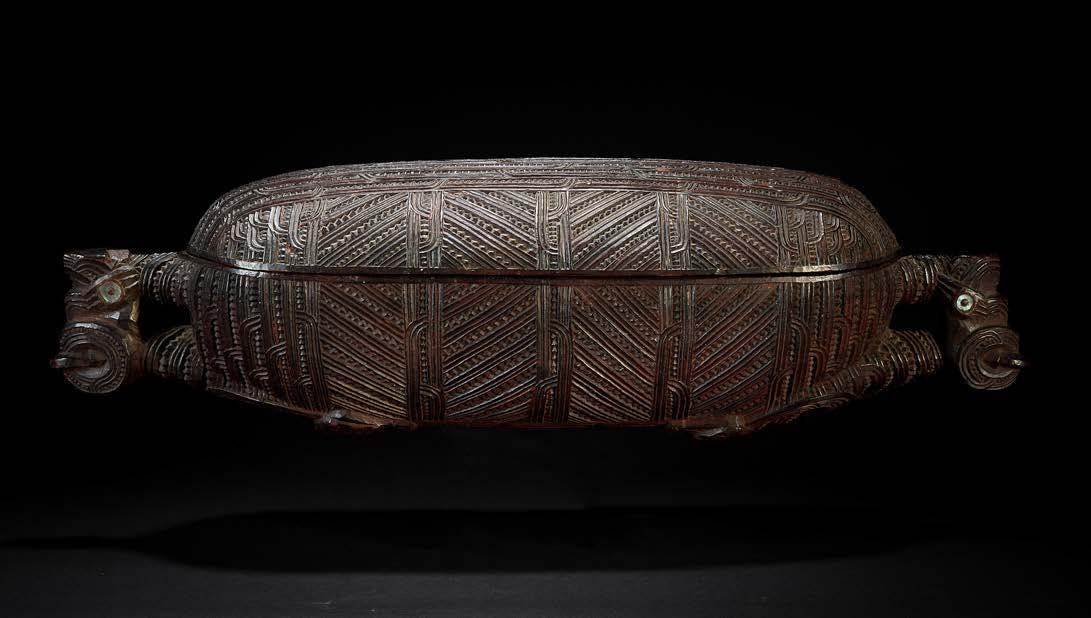

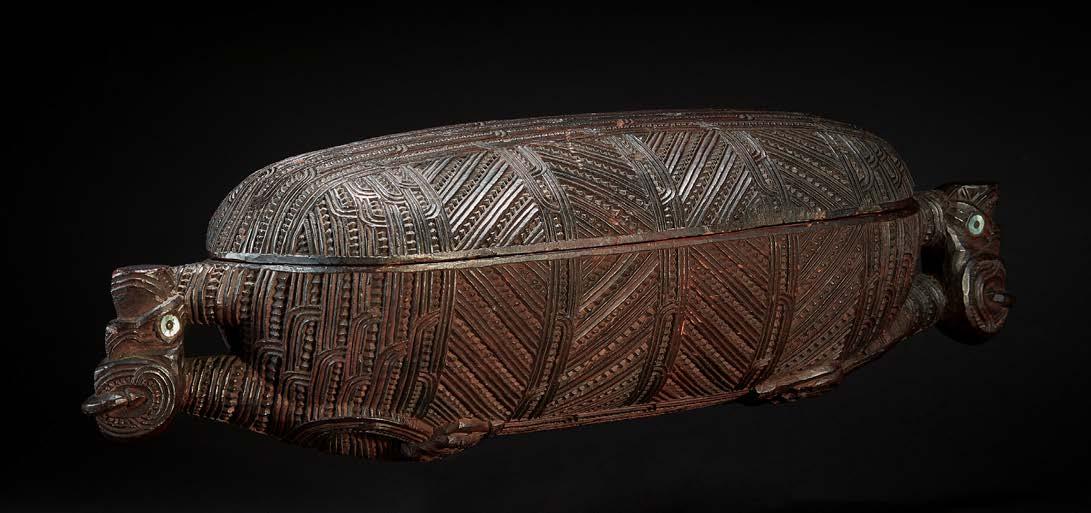
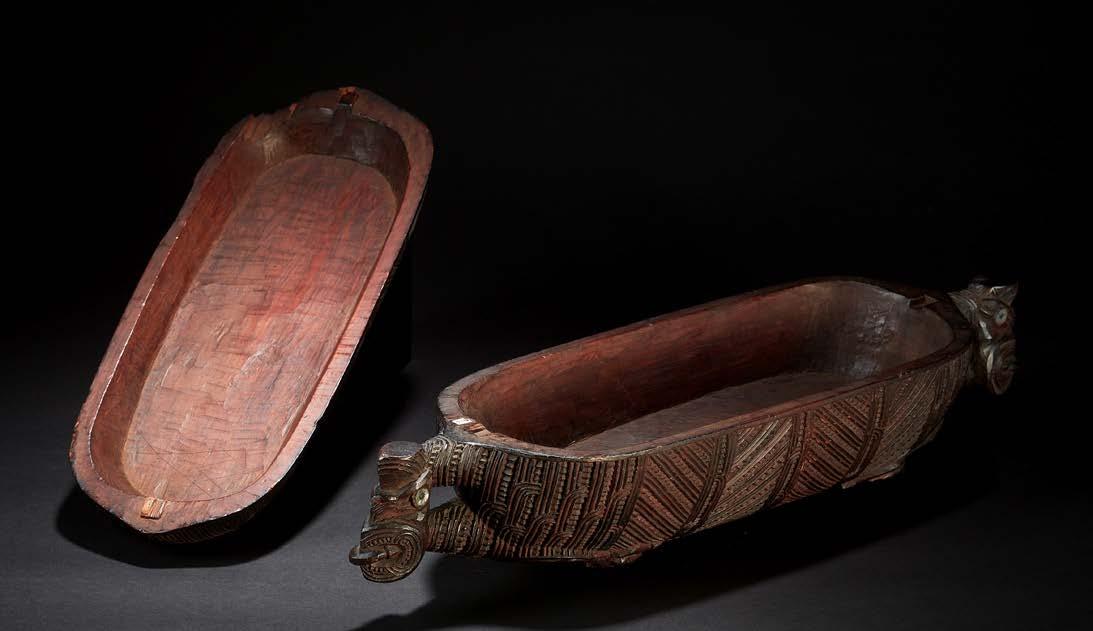

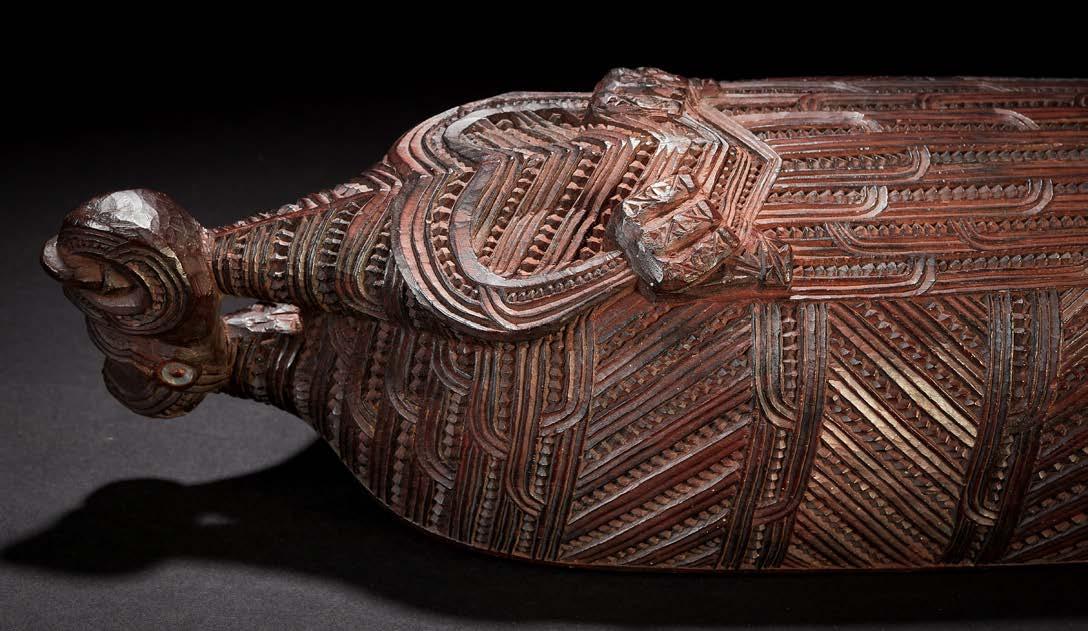
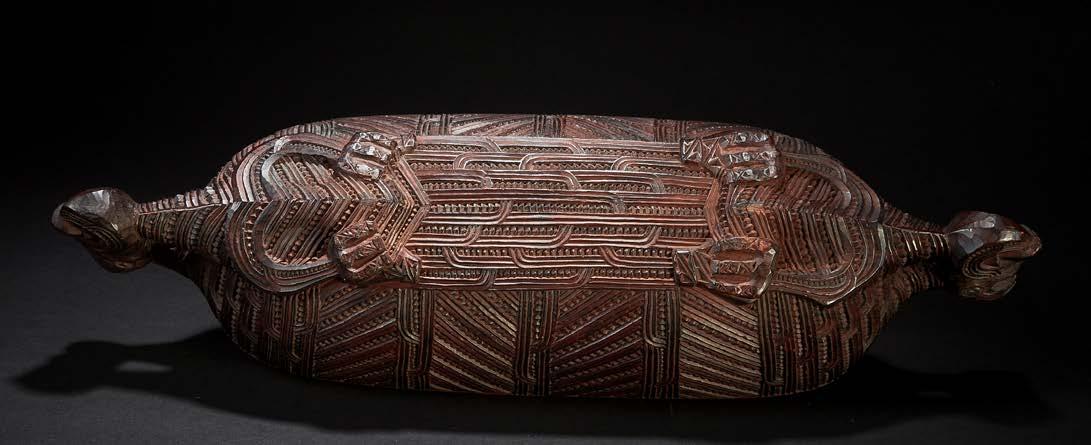

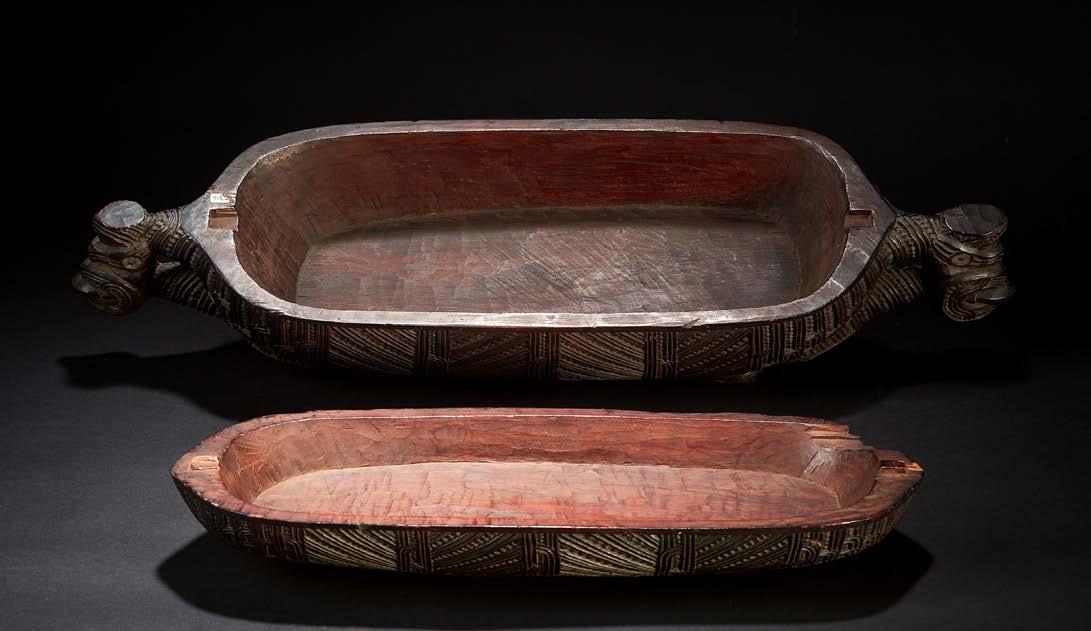
30. DANCE PADDLE
Solomon Islands. Early 20th Century.
This finely carved abstracted bird form representing bird totems is held in the hand by male dancers. These dance paddles can be used in different ceremonies but one of the most important is the re-enactment of mythological voyages from distant lands to their present home in Malaita. Birds are of immense importance both historically and in daily life to Solomon islanders. This originates from the Kwara’ae people of North Malaita. It has a deep patina from use, but came to Australia early.
39 x 18 x 2 cm € 2,400

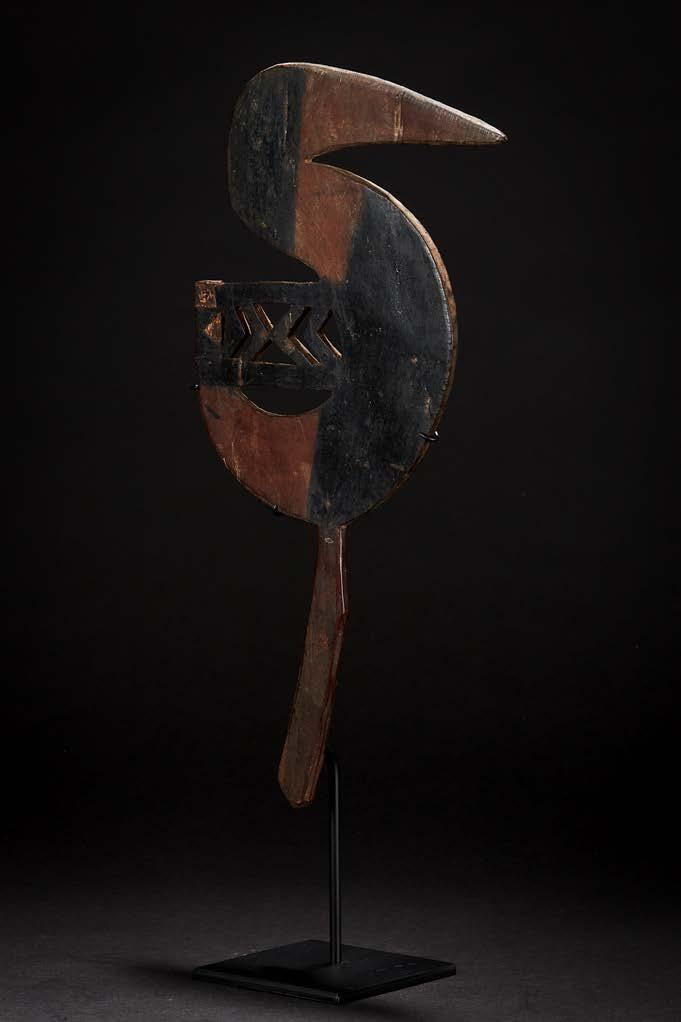
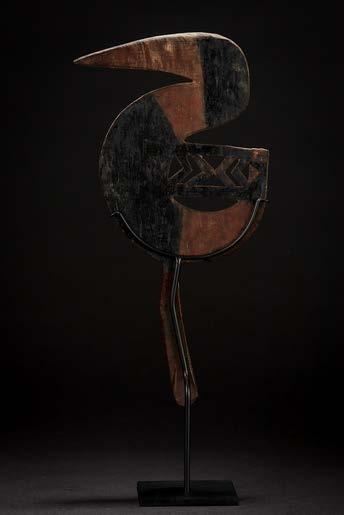

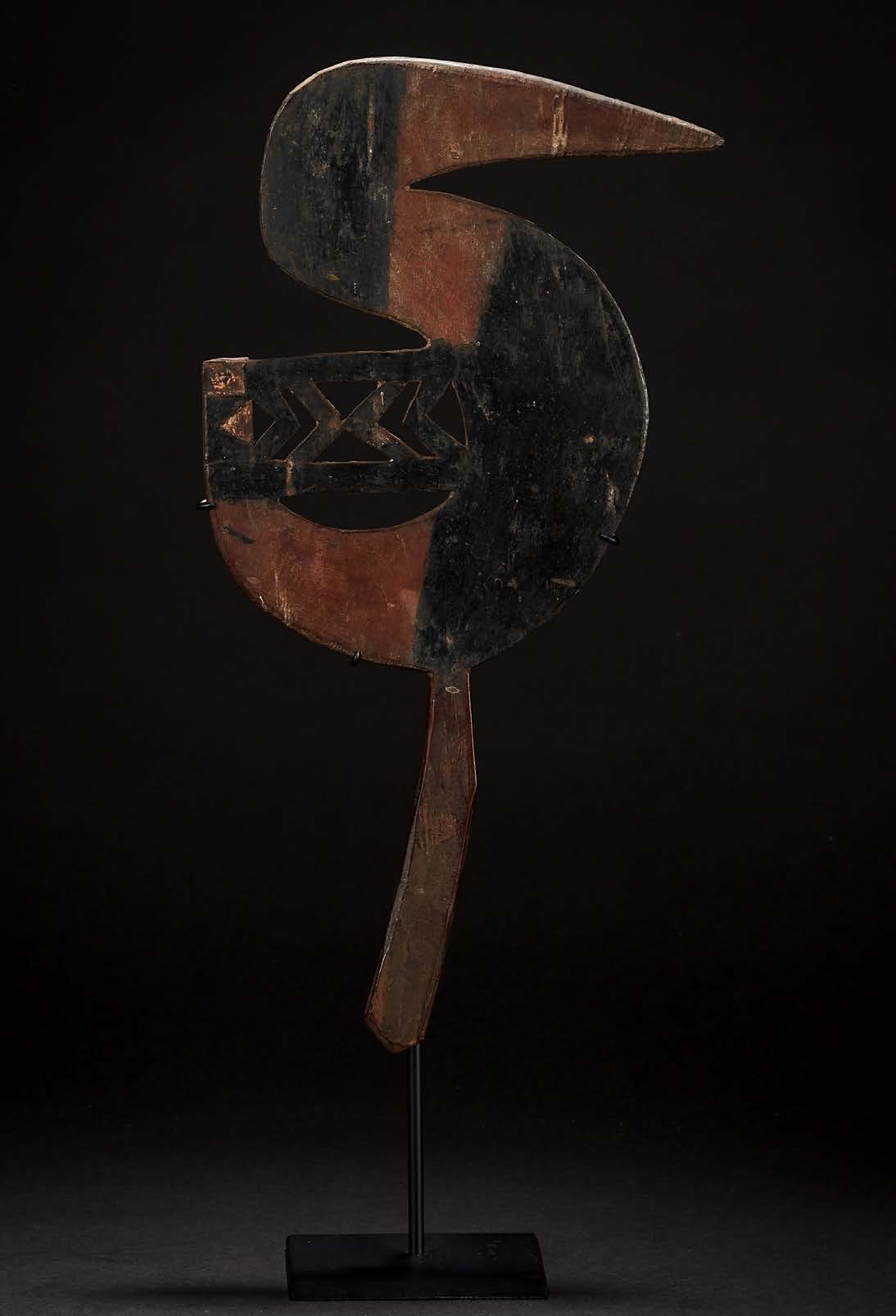
31. TWO FINE GOURD MASKS
Huli people, Southern Highlands, Papua New Guinea. c. 1980s.
Provenance: both gourd masks were collected by Helen Dennett, directly from the Huli makers. She lived in Papua New Guinea from late 1960s for 25 years.
These two gourd masks are made, and originate from the Huli tribe in the far western reached of the Southern Highlands, now known as Hewa. These masks were associated with the haroli cult, where male initiates were isolated from the community for 1-2 years to be instructed by the revered Haroli bachelor. These initiates had special human hairwigs, and used these masks as part of the cult.
a) This mask bold in form and colour and is very fine in its detail. Yellow, the hallmark of Huli ceremonial face painting, dominates the mask. Other colour details, red with fine white dots, are skillfully applied with also the addition of a human hair beard, small pig teeth. Village repair on the back suggest it may have been used several times in ceremony.
b) the mask is more austere; the unpainted nose and eye brows show clearly the resin and the white painted face is highlighted with red and blue colours. The gourd mask is in excellent condition.
a) 24 x 13 x 9 cm b) 21 x 12 x 6 cm
a) € 2,800
b) € 2,000

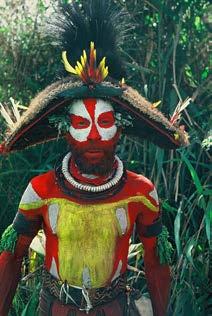
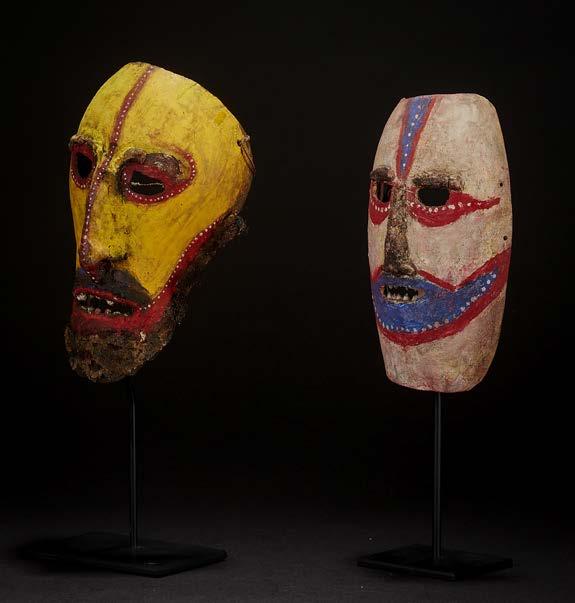
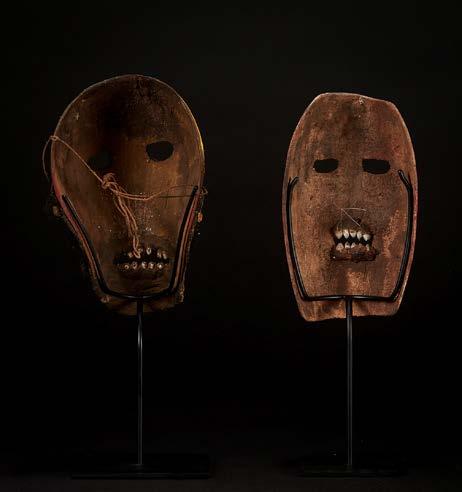
Huli man decorated in the fashion of the Haroli bachelor cult. Gourd masks, painted in similar colours, were an aspect of the Haroli cult ceremonies.

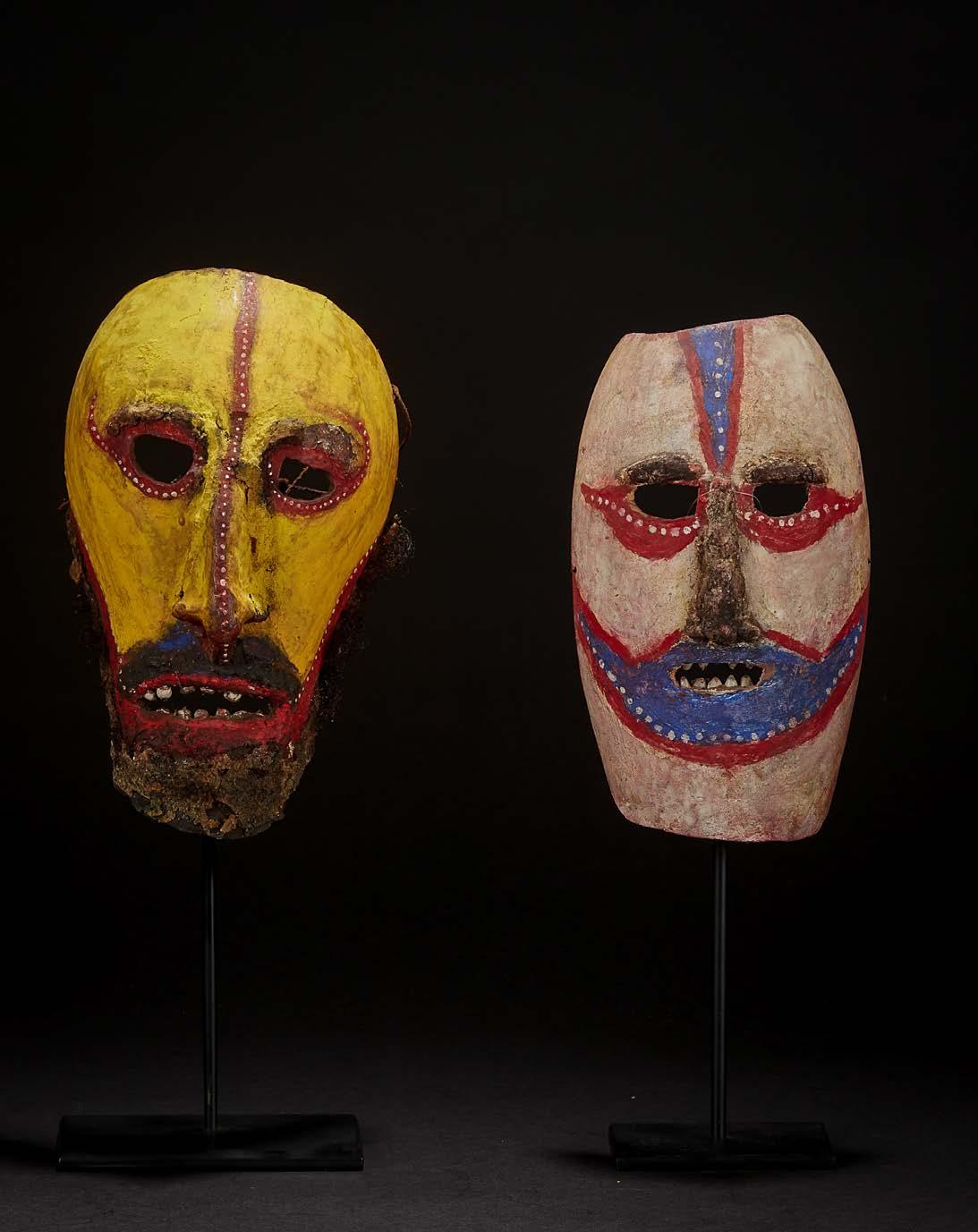
32. THREE PREHISTORIC STAR CLUB HEADS
New Guinea Highlands, Papua New Guinea.
All three club heads are ex-important Tahitian collection.
In the distant past in the Highlands of New Guinea, stone club heads were used widely. At contact (1930s) the Baruya of the eastern Highlands continued to use stone clubs in warfare. However, use of stone clubs in warfare in the main Highland valleys had become obsolete by then, and had become objects of magic and ritual. Then they were painted with ochre colours.
a) Double Star Club Head, New Guinea Highlands. Ex-Leo Fleishmann coll, Sydney LF/L53.
b) Large Star Club painted red with underlying orange pigments, Baruya people, Eastern Highlands.
c) Double Star Club head, hard volcanic stone. Wahgi Valley.
a) 14 cm diam x 6.5 thick
b) 21 cm diam x 6 thick
c) 12 cm diam x 4.5 thick
a) € 850
b) € 750
c) € 750

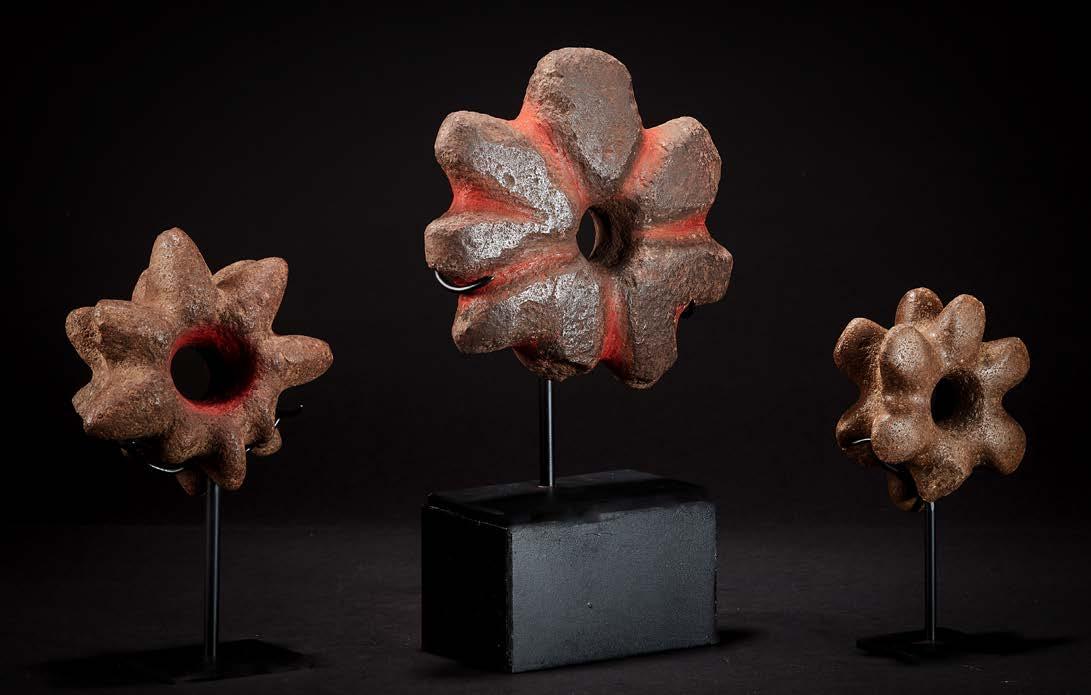

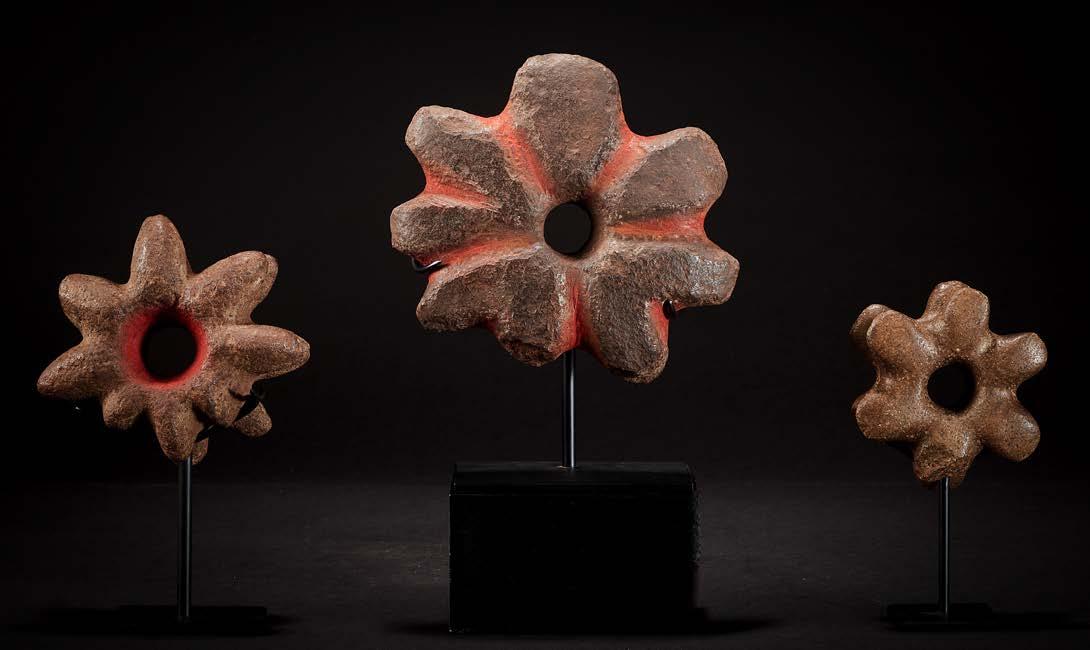
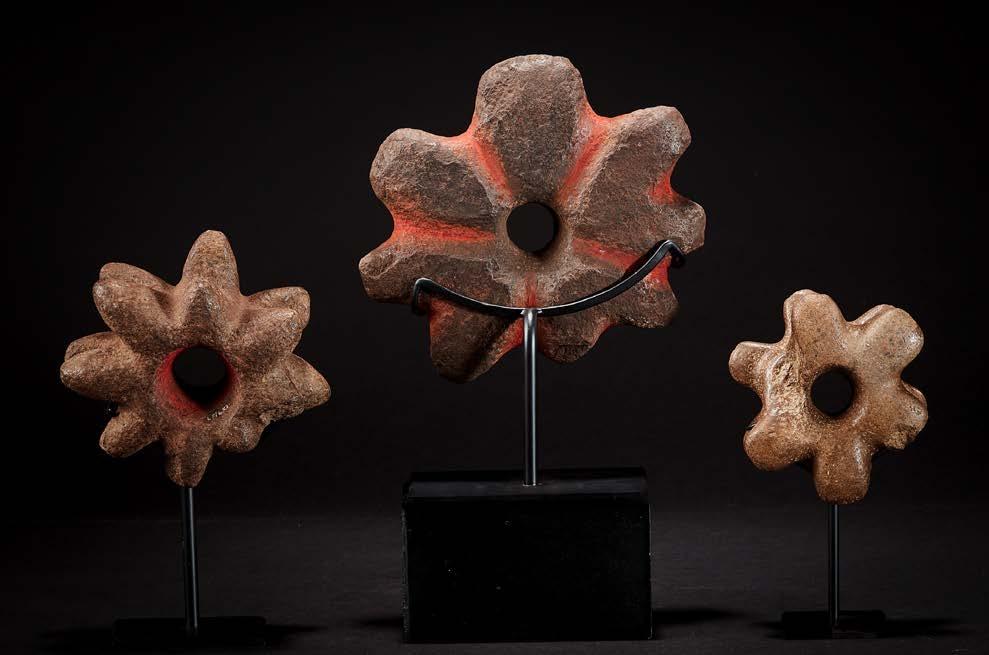
33. TWO BODY ORNAMENTS
Sepik River region, Papua New Guinea.
a) Karawut, a man’s war ornament, Abelam people. In war, this is held in the mouth; in ceremony, worn on the back. This is an exceptionally strong and fine example, covered in carefully graded nassa shells, split pig tusks, and a substantial clamshell nose ornament (quite rare).
b) Homicide’s apron, Iatmul people, Middle Sepik. These can only be worn by men who have taken a head; the black apron is made from the skin of a flying fox, a strong symbol of headhunting. The weighted front are mainly conus shells woven into a form that ends in a finely woven final of fibre, shell and human hair.
a) 37 x 19 x 5 cm
b) 41 x 6 x 7 cm

a) € 1,500
b) € 1,250
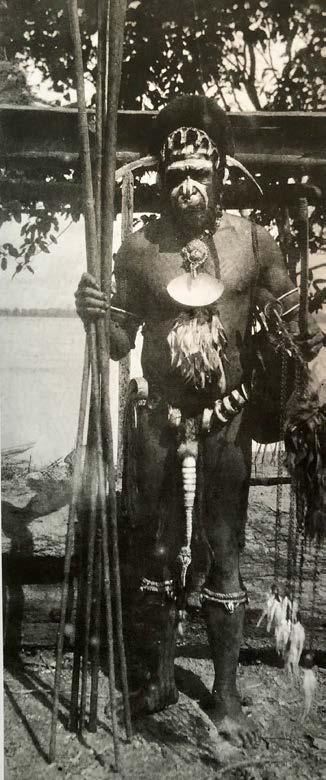
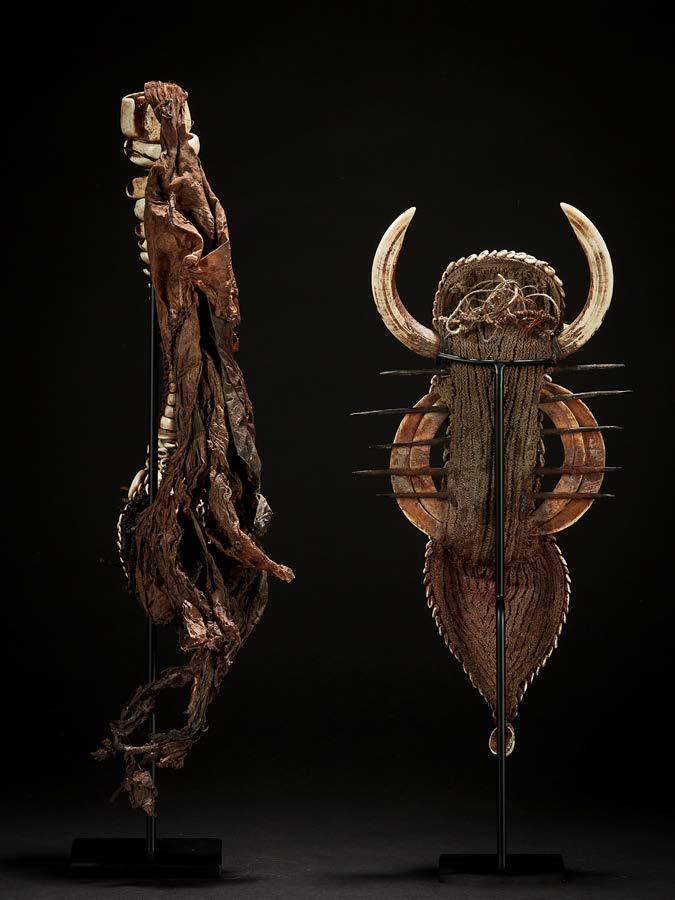
Early photograph of a Iatmul warrior wearing the homicide apron. This is a proud symbol of having taken an enemy head.

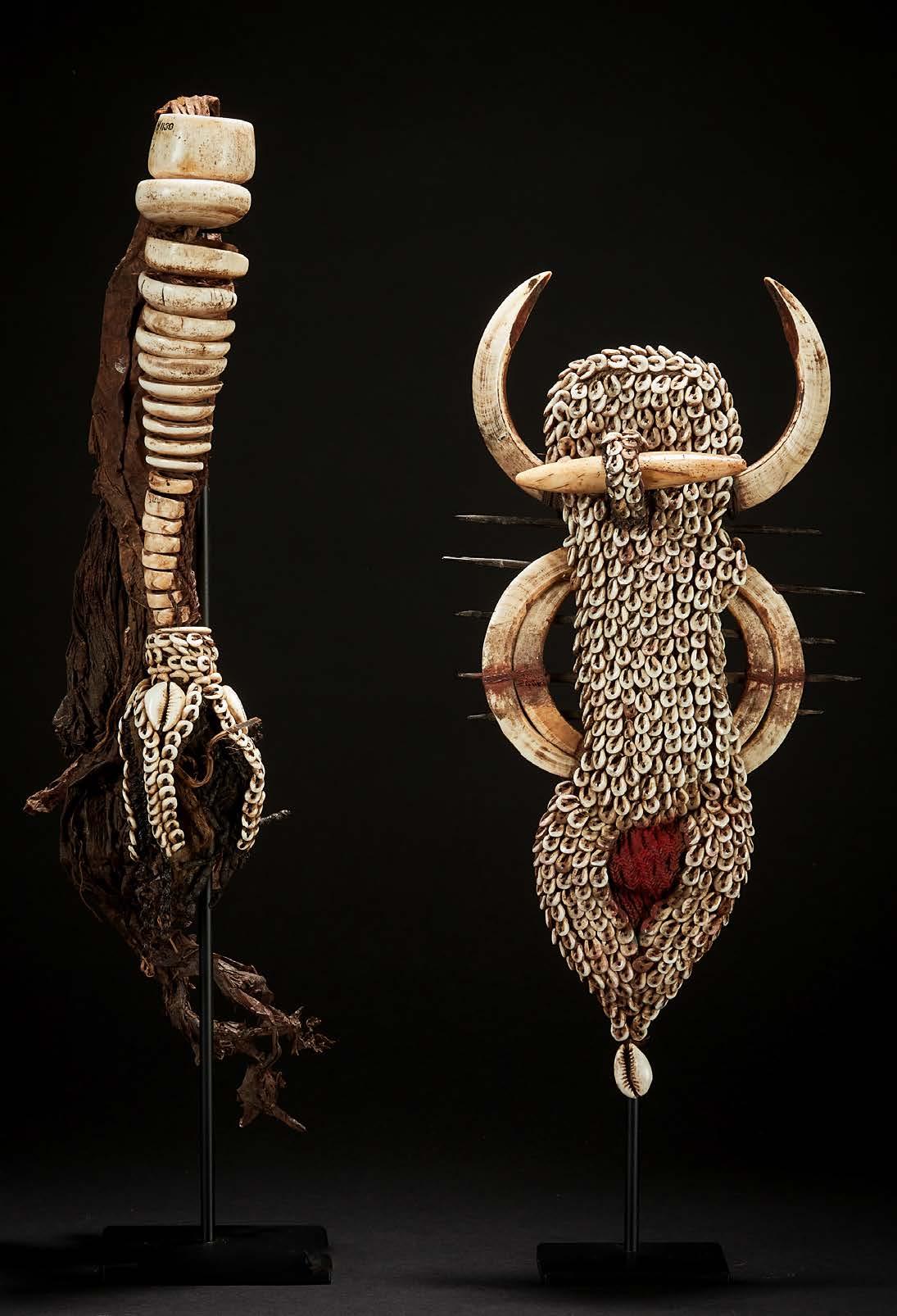

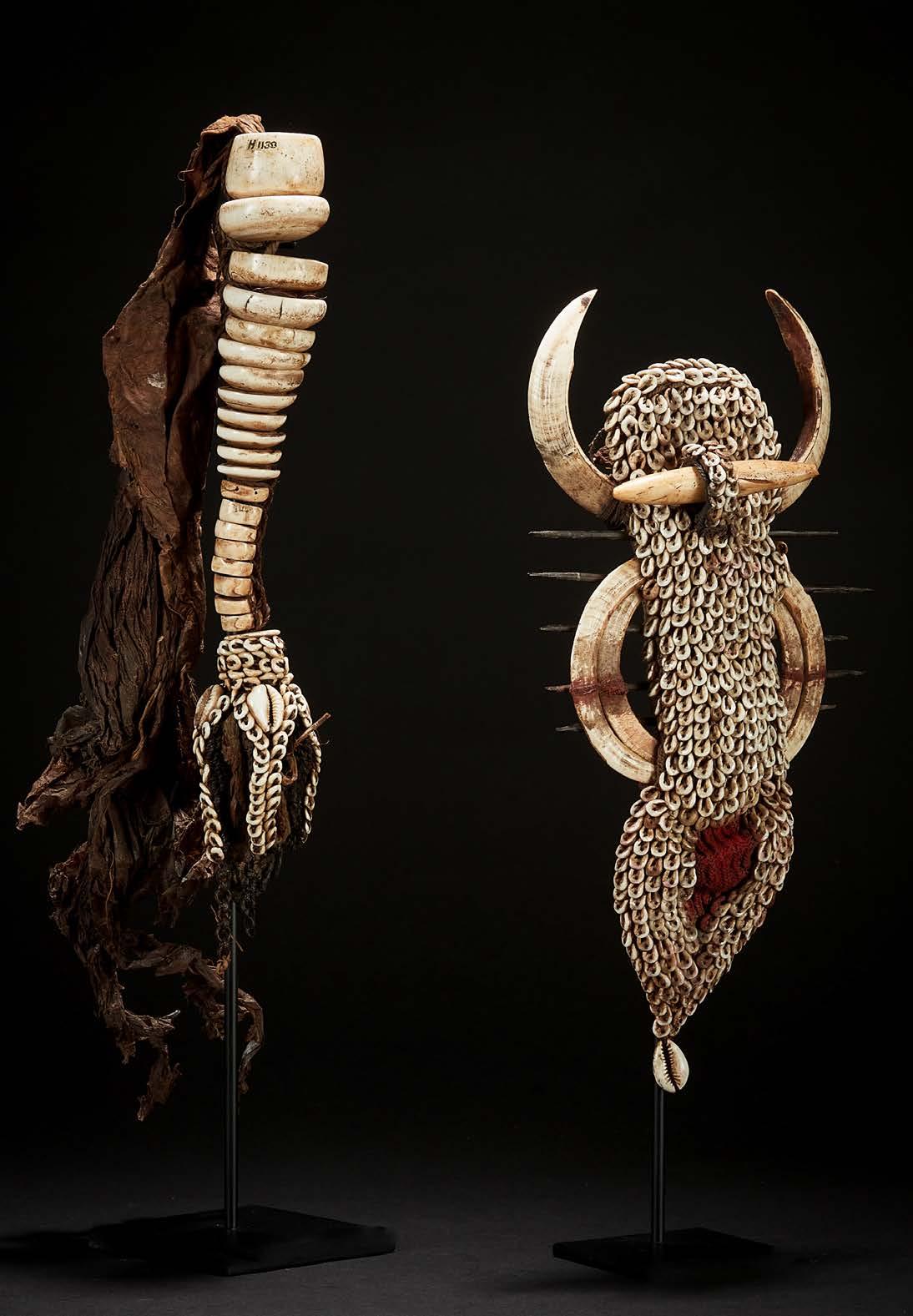

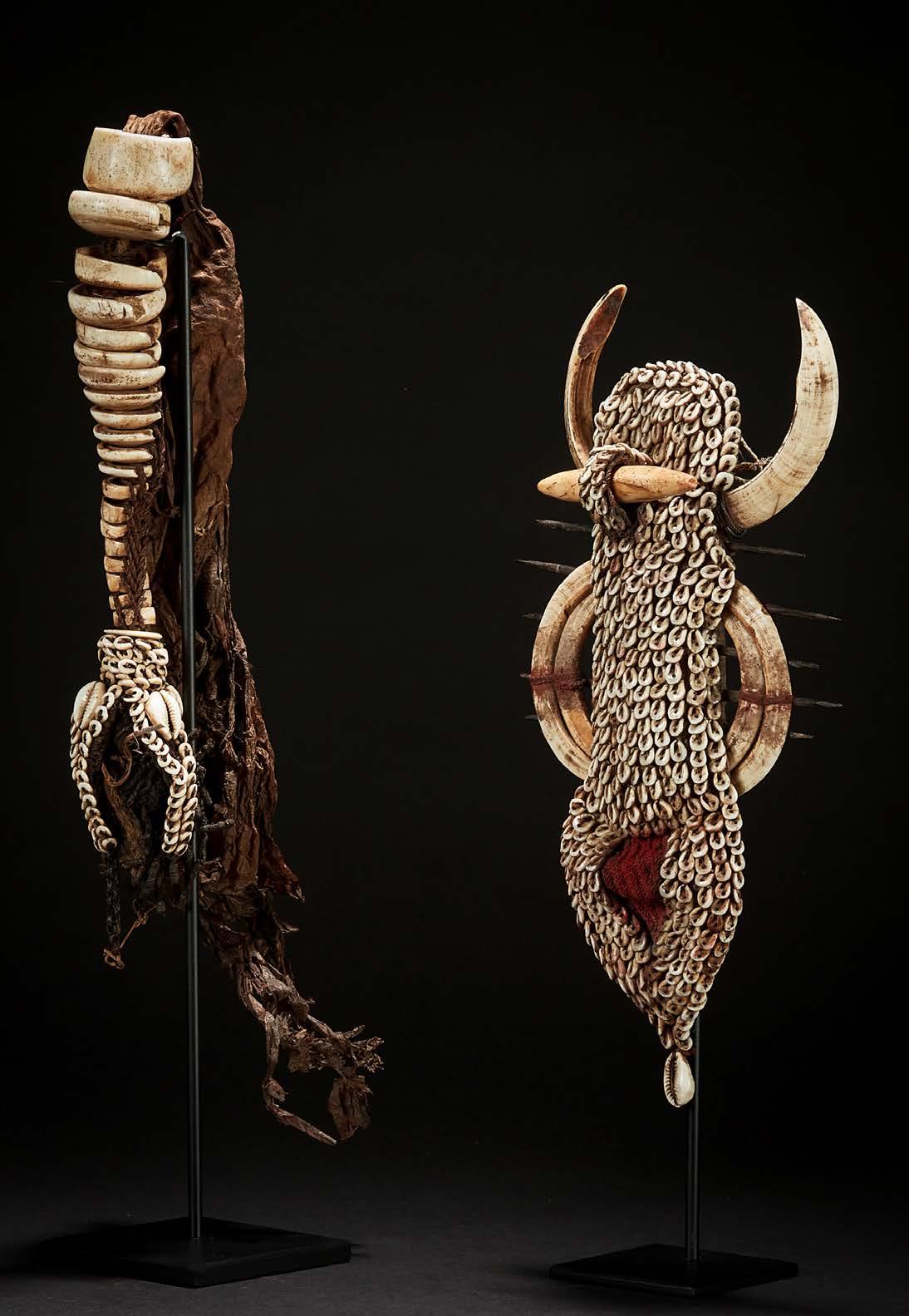
34. TWO SMALL OLD CHARMS
Karawari River and West Papua. Early 20thC.
a) Minature cult hook, yipwon, Karawari River, Middle Sepik. Such small hooks were personal items, carried in ceremony or also on journeys potentially perilous journeys as a protective talisman. Early to Mid-20thC.
b) Minature korwar figure, Cenderawasih Bay, West Papua , Indonesia. This is a small personal korwar decorated with an old Dutch trade bead, that would probably be carried in a small bag as a protective piece. Such a piece may also be worn around the neck on a string necklace.
a) 21 x 4 x 1 cm
b) 18 x 2 x 2.5 cm

a) € 1,500
b) € 900
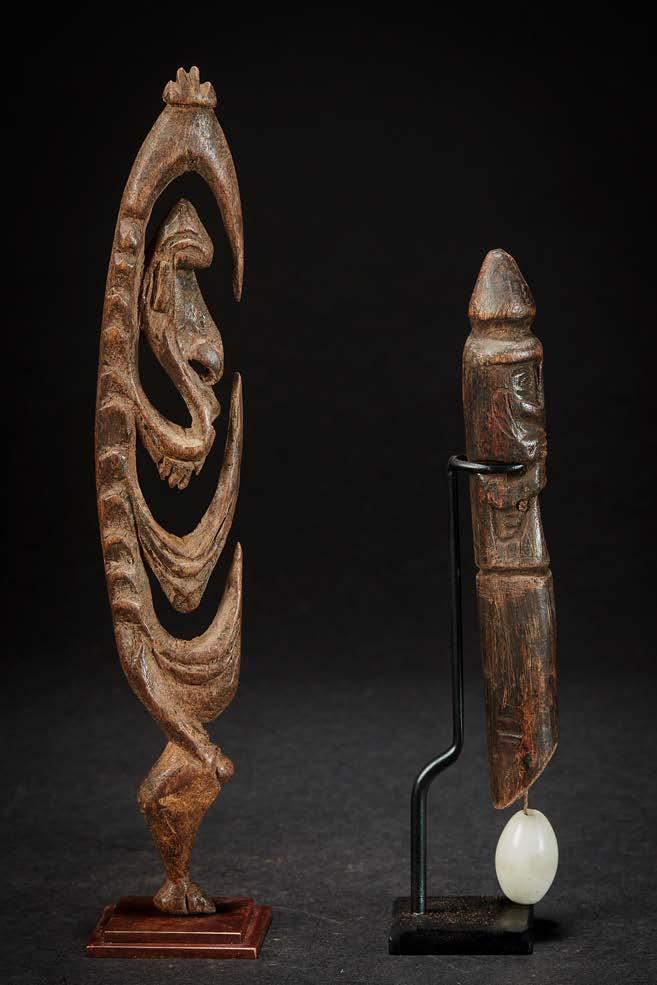
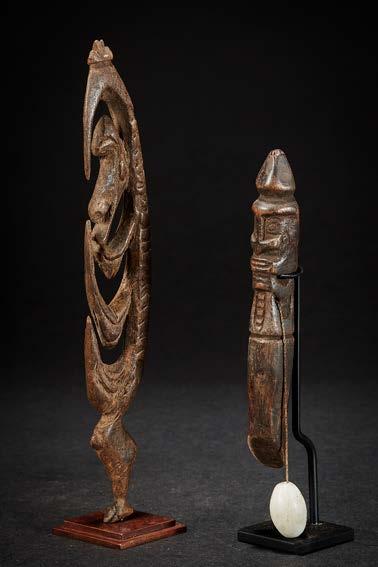

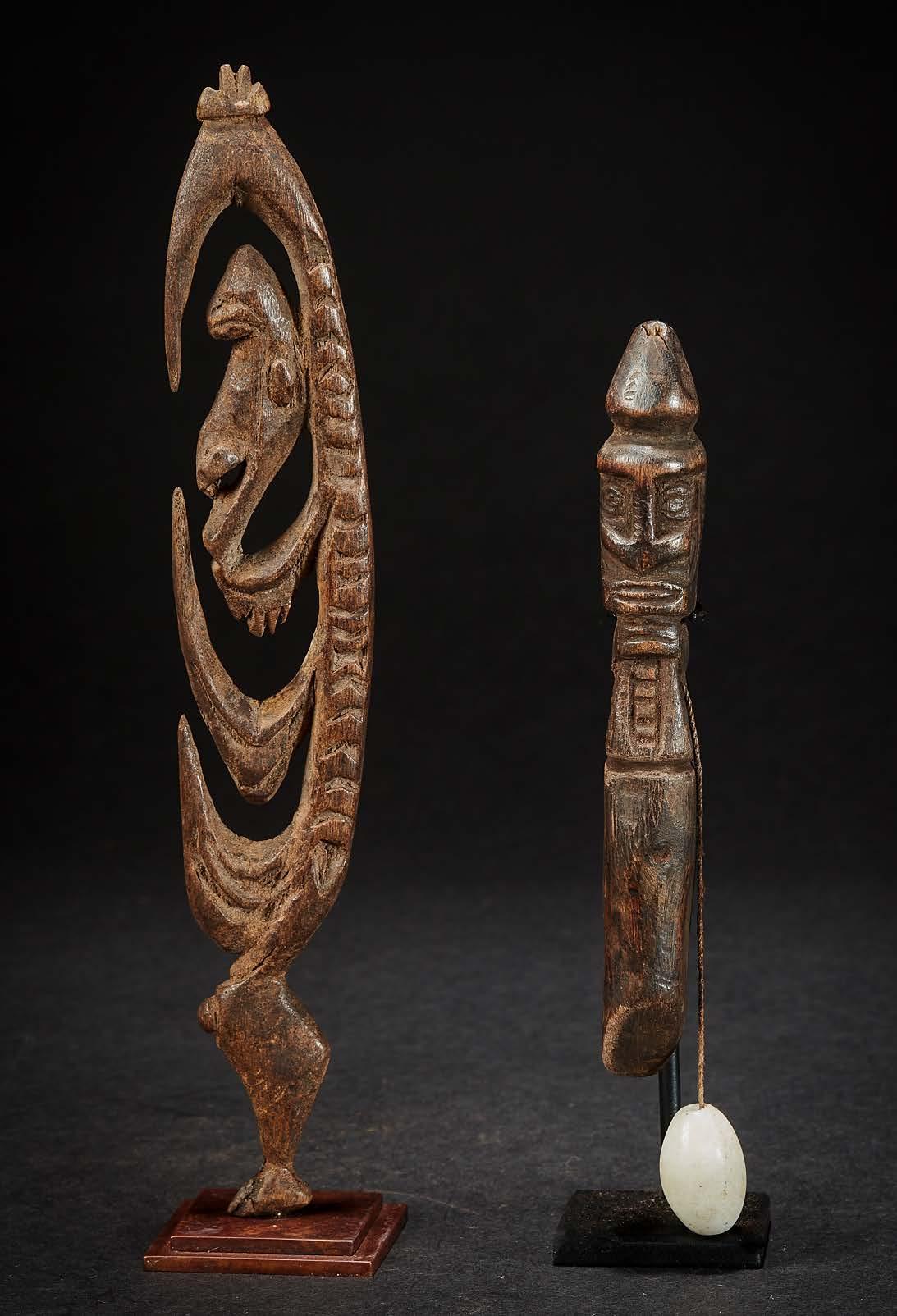
35. SORCERER’S CHARM
Marupai, Papuan Gulf, Papua New Guinea.
Marupai are found among the Namau and Elema people of the Papuan Gulf. They are made from dwarf coconuts and delicate incised designs are carved into the surface and filled with lime. The overall shape and design create the impression of the head of an animal; some would say pig-like. with two eyes generally central on the head. They were sometimes kept in small woven bags, that could be used to wear around the neck.
These marupai are personal property, and used by certain adult men. They fulfill a variety of magical functions; in the past they were much feared as a sorcerer could use the power of his marupai to harm or even kill his victim. The positive power of the marupai helped in fishing and hunting, protection against illness and also in warfare to protect against the enemy.
a) 10 x 4 diam cm
b) 10 x 3.5 diam cm
c) 10 x 3 diam cm

a) € 1,200 b) € 1,200 c) € 1,200
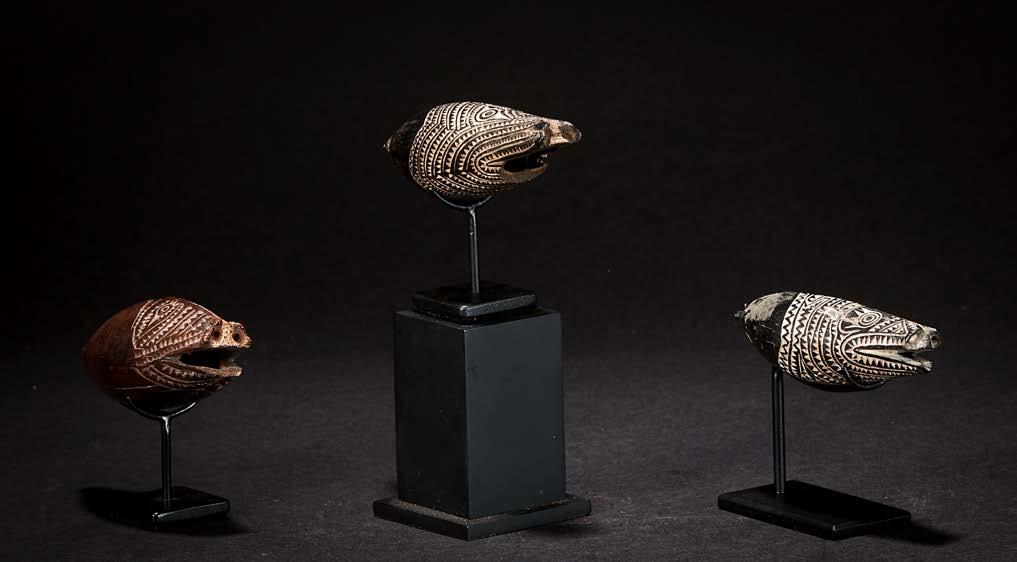
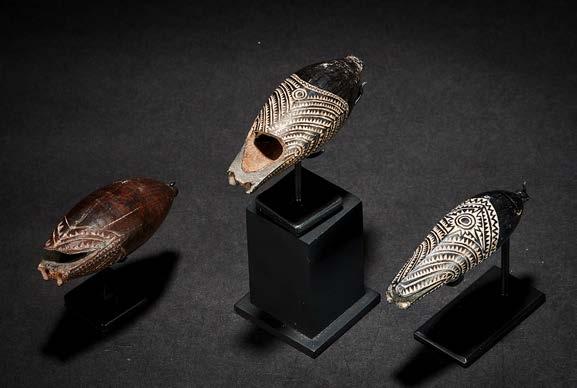
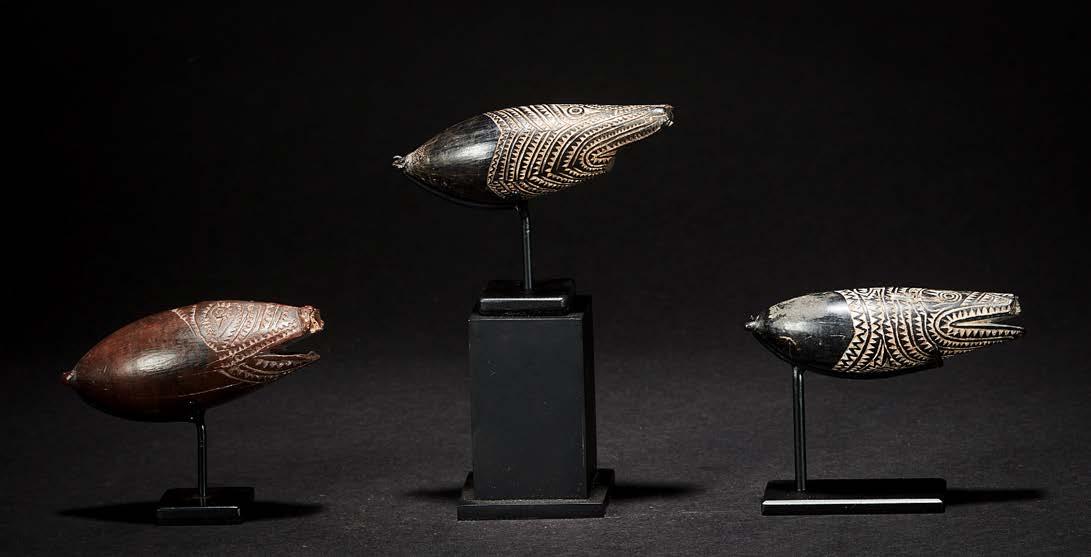

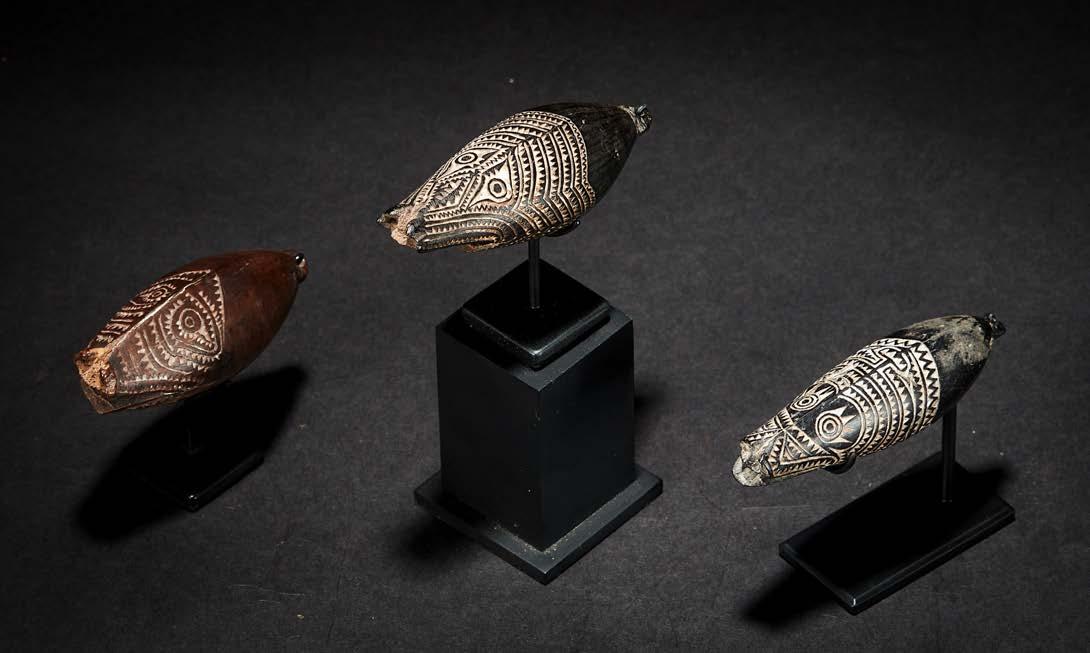
36. TWO CEREMONIAL PENIS COVERS
Upper Sepik River, Papua New Guinea.
These covers, made from the dwarf coconut, are used in one particular level of male initiation, in the Washkuk Hills areas of the Upper Sepik. Douglas Newton notes that these were worn only by initiates in the highest grade, Komaptam, by successful homicides.
a) Dwarf coconut with fibre edging decorated with cowrie and nassa shells, and ropes to fasten the penis cover securely around the waist
b) A large, engraved face surrounded by geometric motifs dominates this penis cover. The face is similar to that found on war shields and denotes the warrior meaning of these objects.
Reference: “Crocodile and Cassowary- religious art of the Upper Sepik River”, Douglas Newton, The Museum of Primitive Art, New York, 1971.
a) 13 x 6 diam cm
b) 10 x 4 diam cm

a) € 850
b) € 750
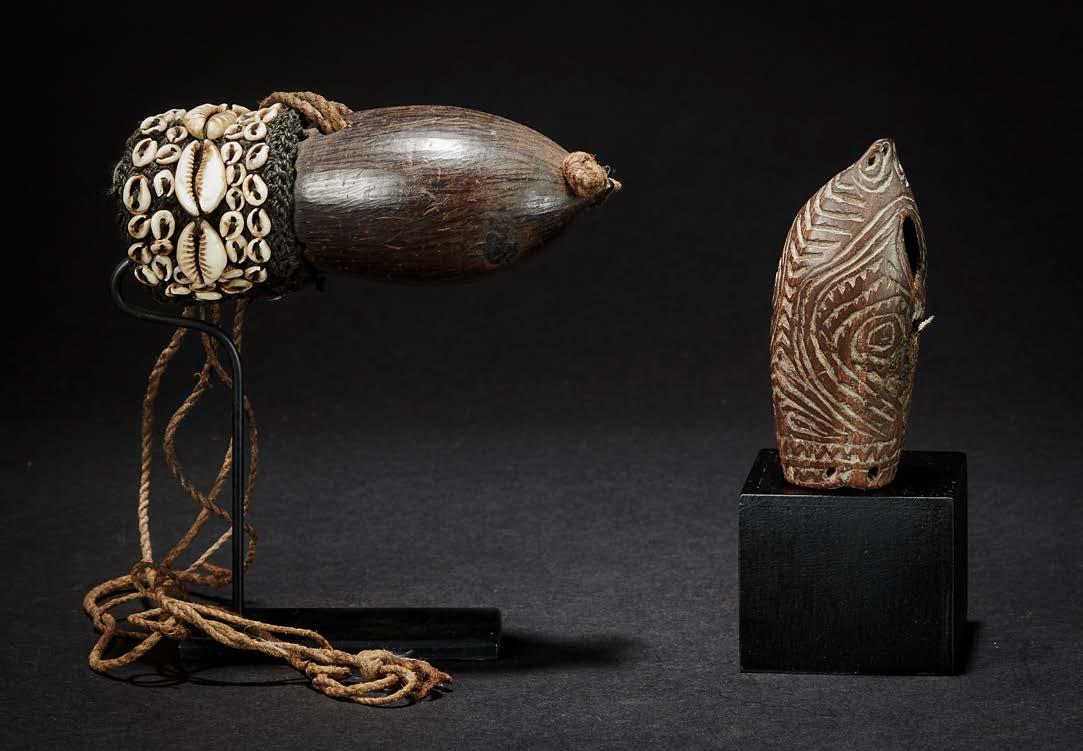

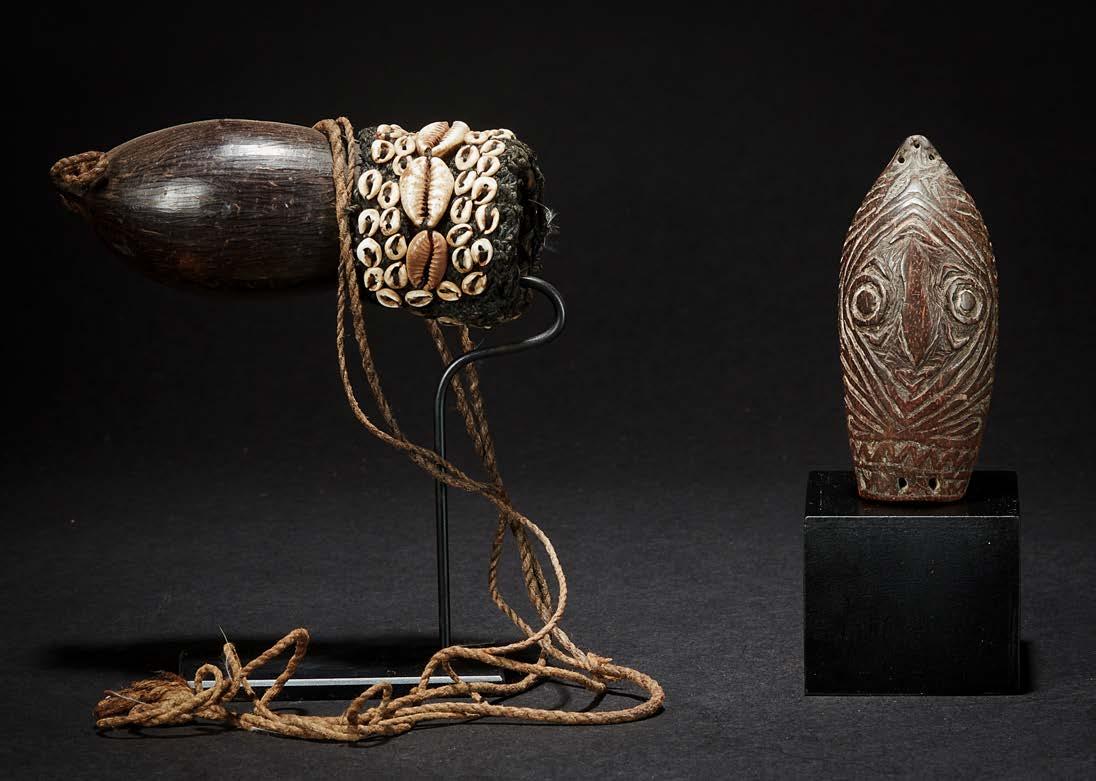
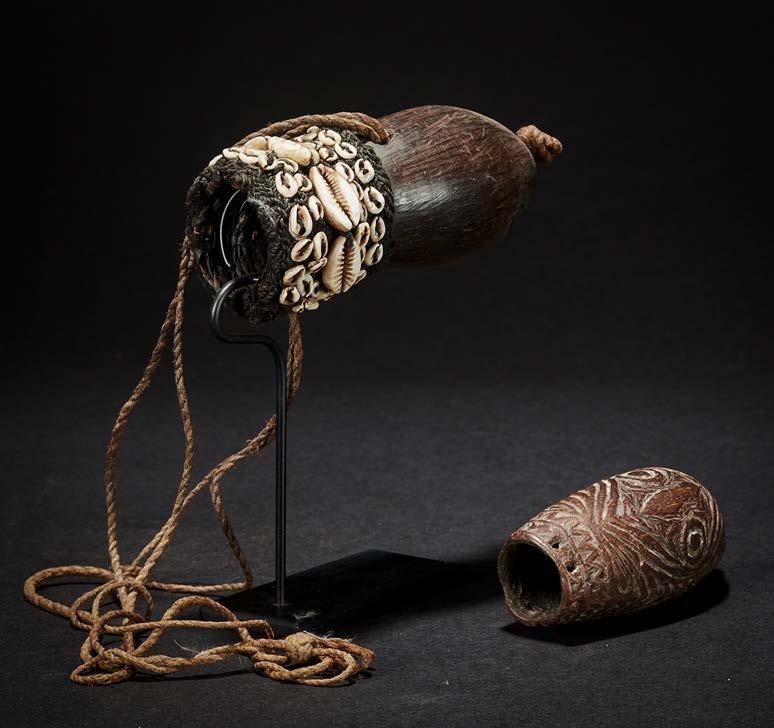
37. TWO THROWING CLUBS, ULA
Fiji, 19th Century.
a) Ula drisia, (ball-headed root club). Used as a throwing club in warfare, thrown with potentially devestating consequences. The club is old, definitely 19thC and the end of the handle engraved with well-worn tavatav designs.
b) Ula tavatava, (flute-headed club). These are the most elegant of Fijian throwing clubs, with fluted, serrated head that is completed with a finely carved dome ‘cap’. Almost half the handle is carved with finely engraved motifs. Both Ula have old glossy patias from generations of use.
a) 42 x 6.5 diam cm
b) 41 x 10 diam cm
a) € 500
b) € 550

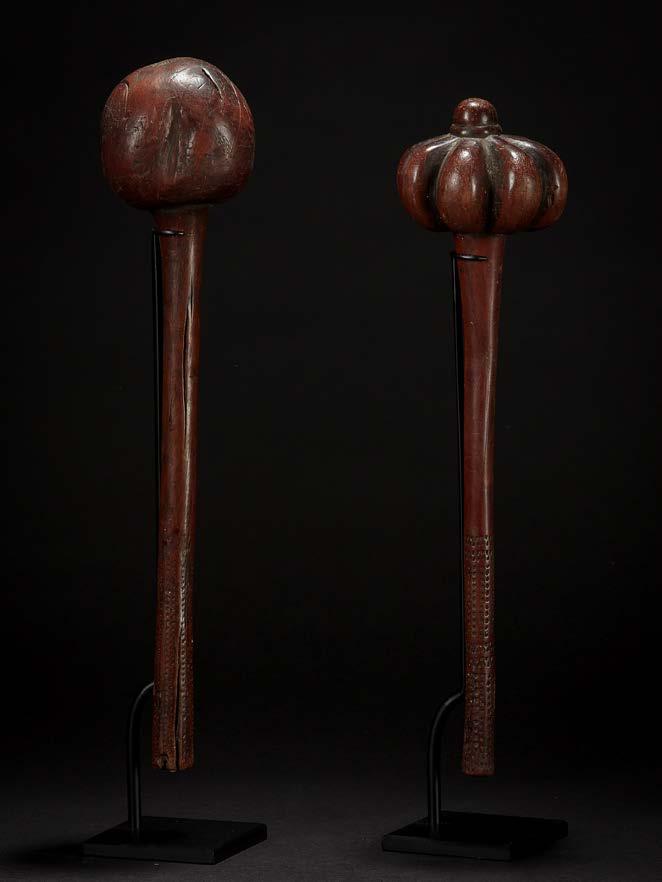
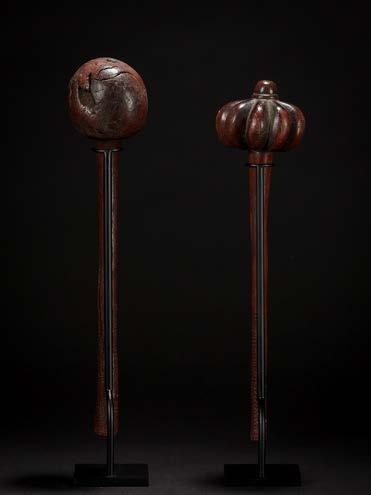

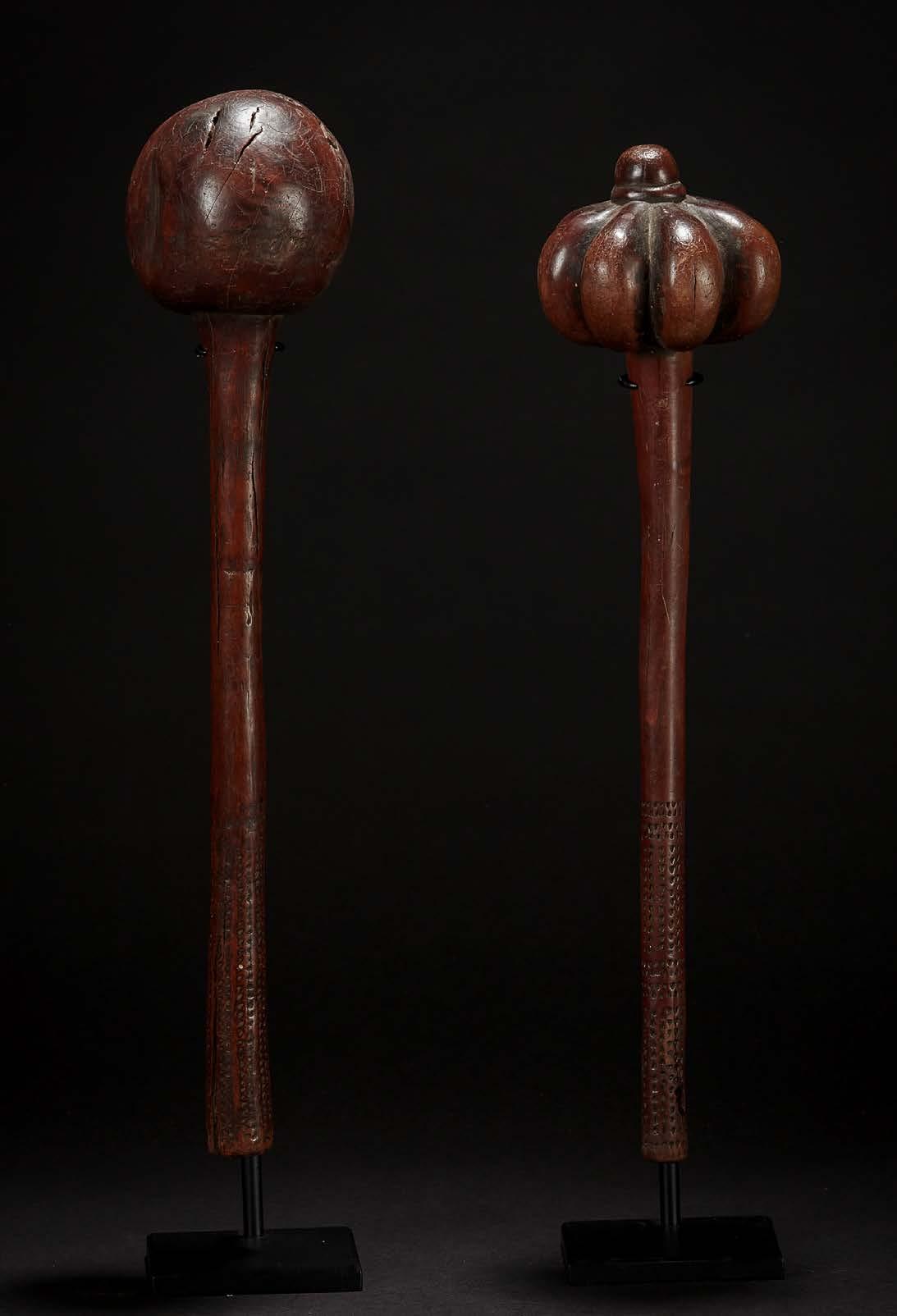
38.
THREE
ABORIGINAL WEAPONS
Australia. 19th/early 20thC.
The two swan-neck boomerangs originate in the Warlpiri or Warumungu territories of northern Central Australa and were also traded south to the Arrenete.
a) Spear Thrower, woomerah, Central Desert region, Northern Territory. The woomerah is finely engraved on the front, with a well-formed kangaroo bone secured at the top to hold the end of the spear. The back has delicate tooling indicating it was carved with a shell knife.
b) Swan-neck boomerang, Central Desert, with very fine fluting.. Used for hunting and warfare; they are non-returning. ex-Professor Peter McCabe, Adelaide.
c) Swan-neck boomerang with painted motifs that indicate it has been used in ceremony.
a) 82 x 13 x 2.5 cm
b) 71 x 21 cm
c) 65 x 24 cm

a) € 850
b) € 800
c) € 750
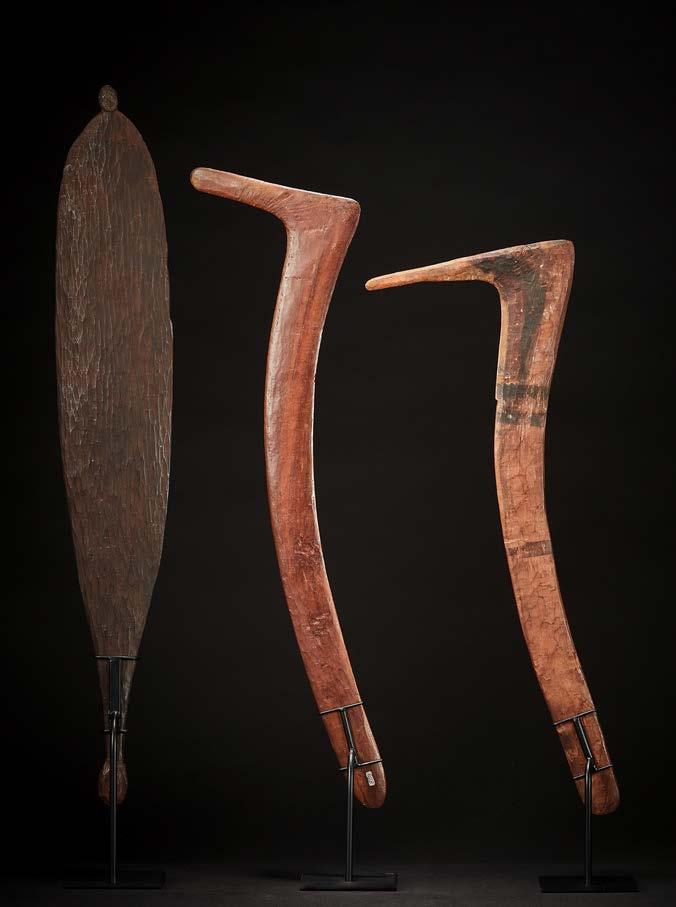

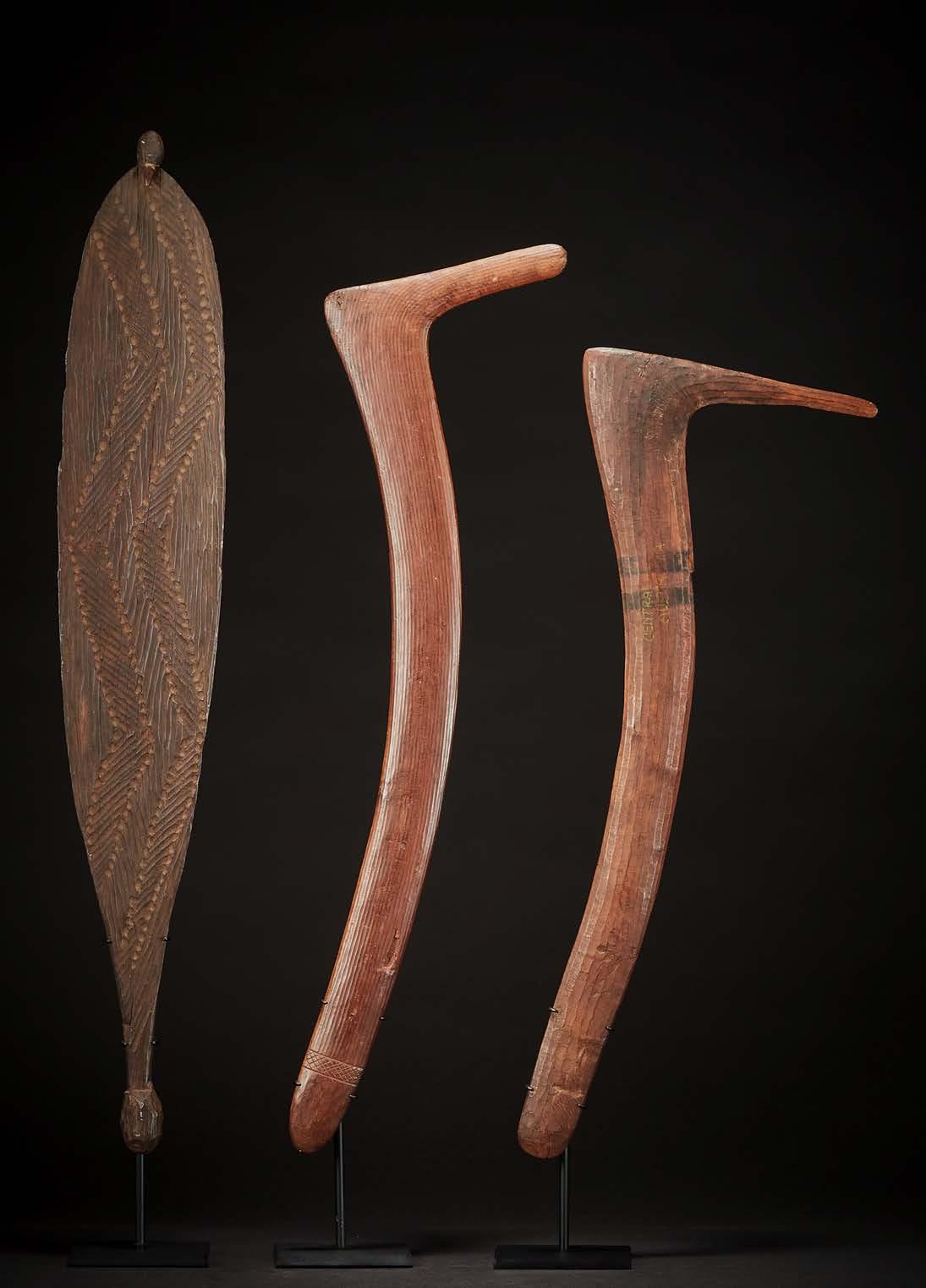

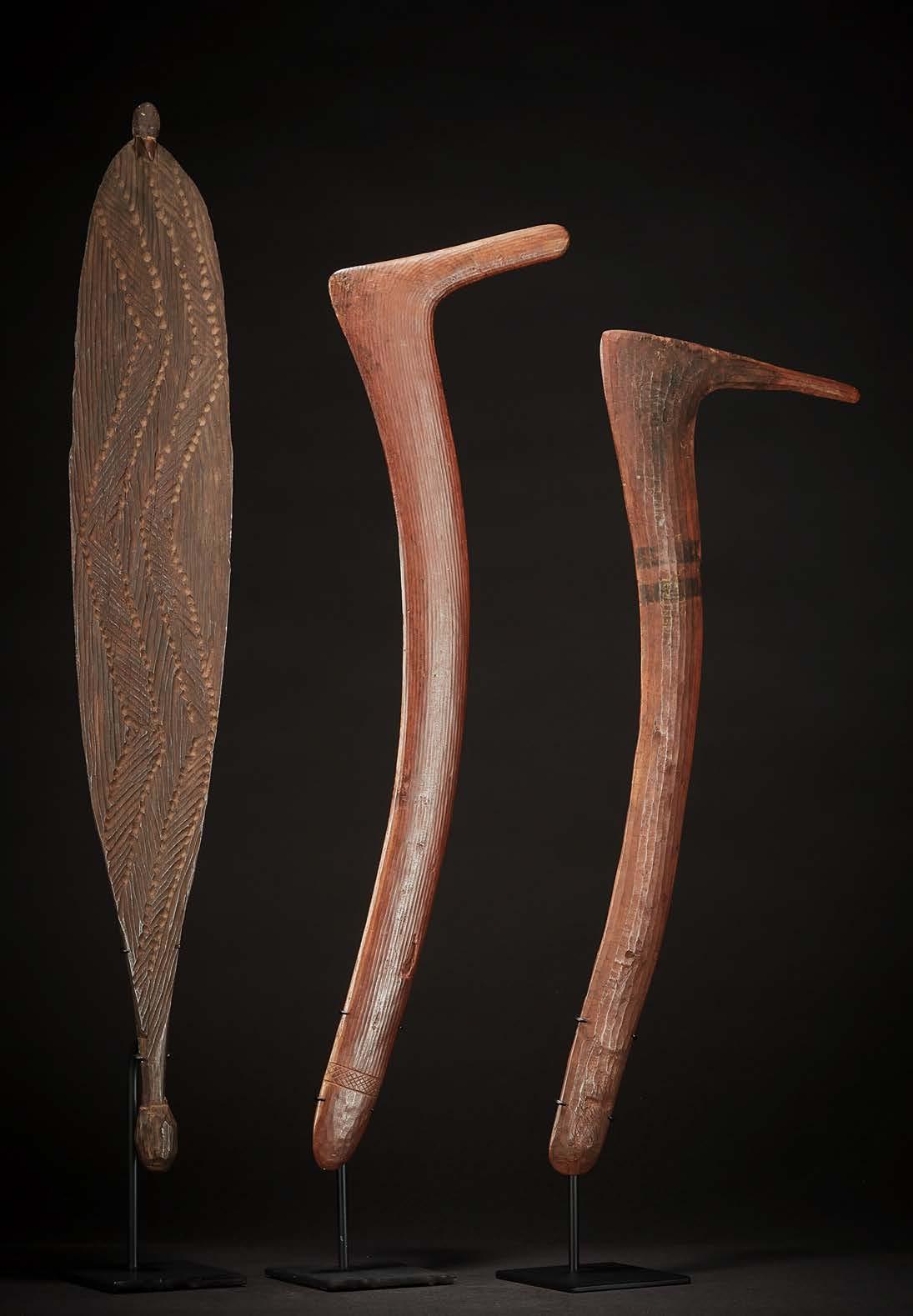
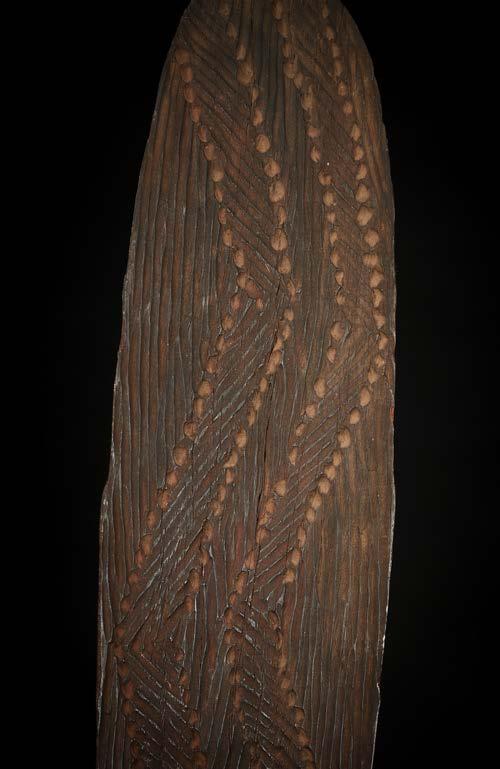

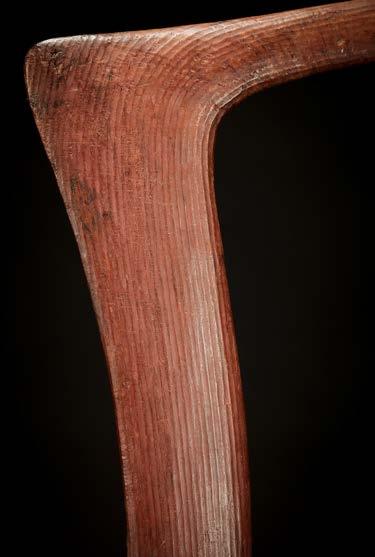
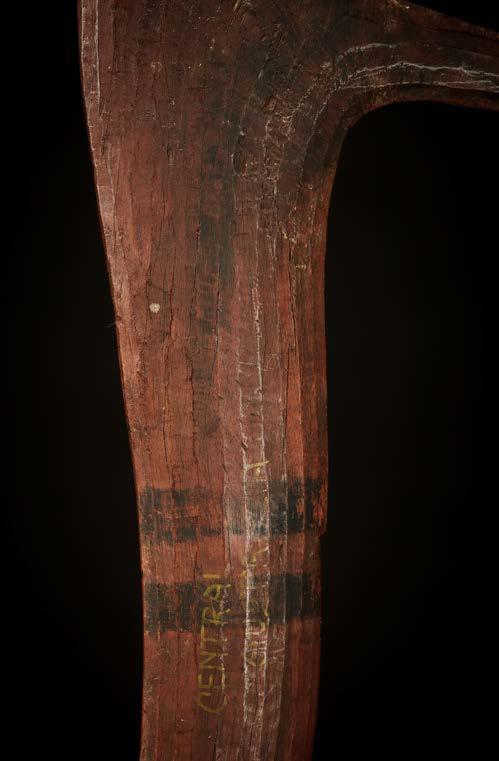
39. TWO ABORIGINAL FIGURES
Arnhemland, Northern Territory, Australia. Early to mid-1960s.
a) Turtle figure, East Arnhemland. It has an expressive form and beautifully painted top and bottom. He appears to be in swimming movement
b) Bandicoot, a small rodent-like native animal. It has a most elegany long sinuous form, and well painted.
a) 26 x 14 x 6.5 cm
b) 8 x 39 x 6.5 cm
a) € 1,800
b) € 1,400

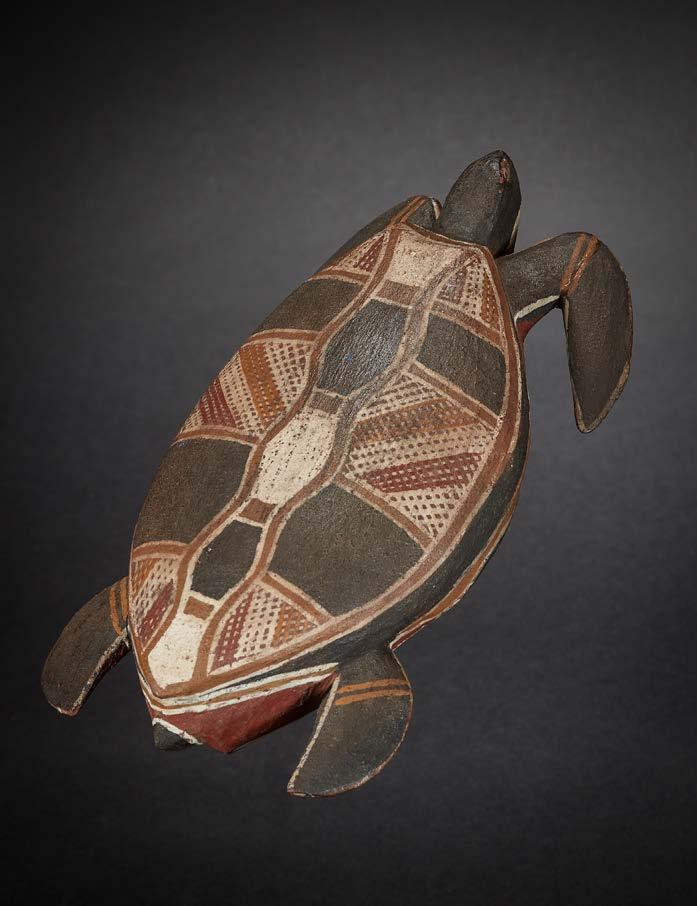
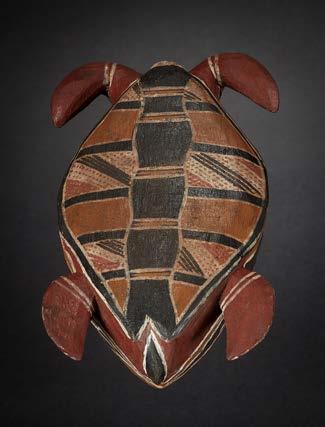

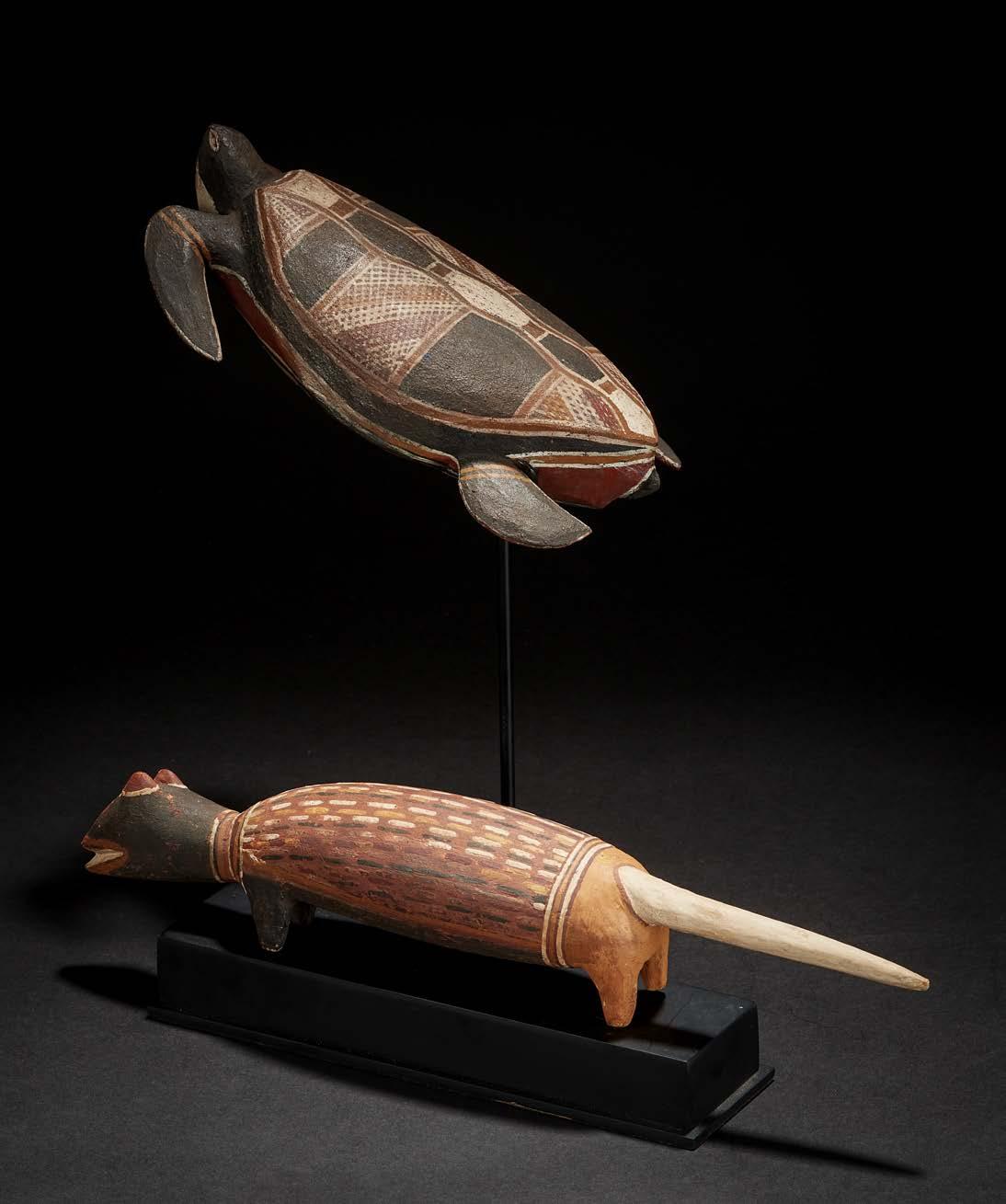

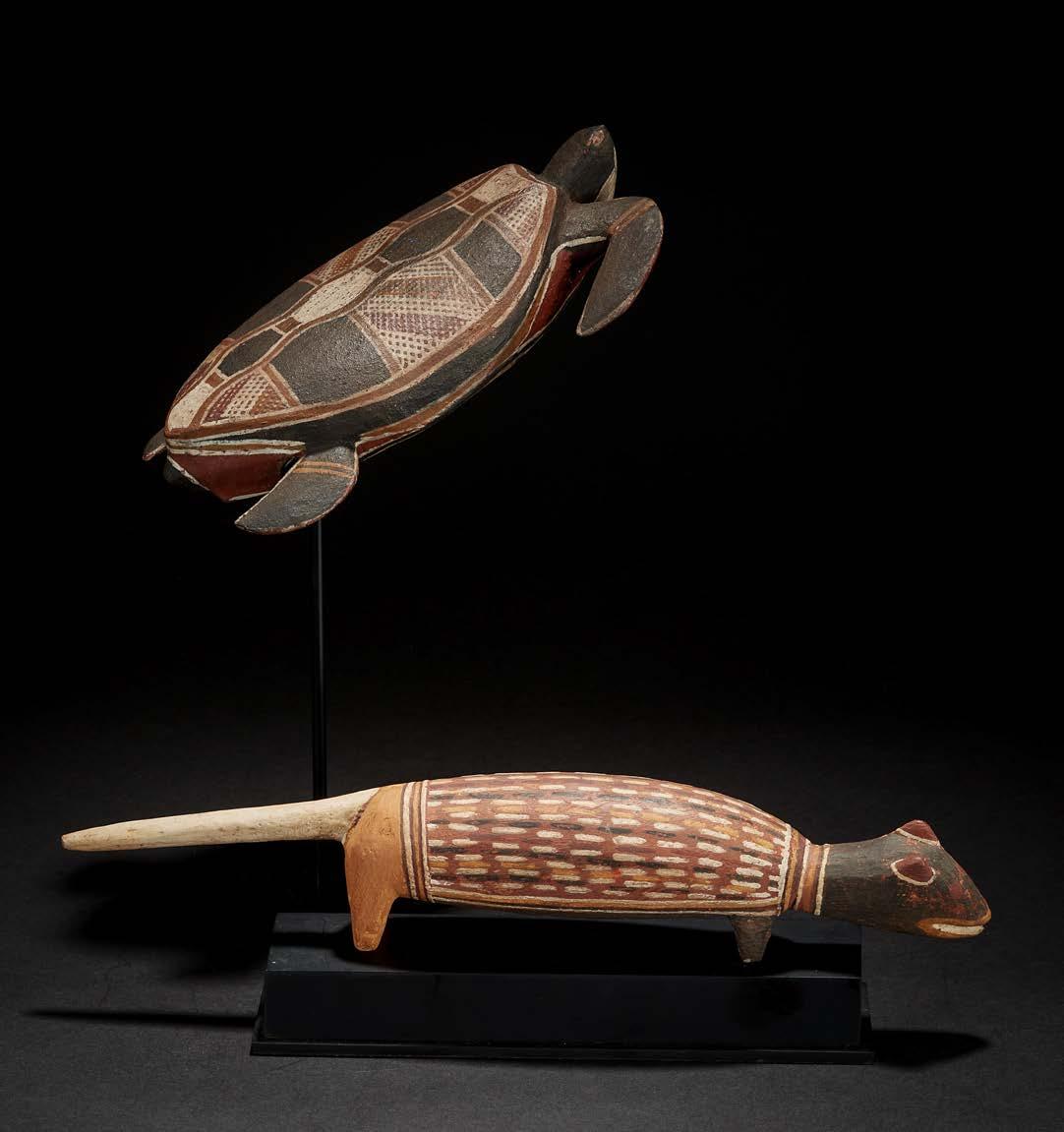

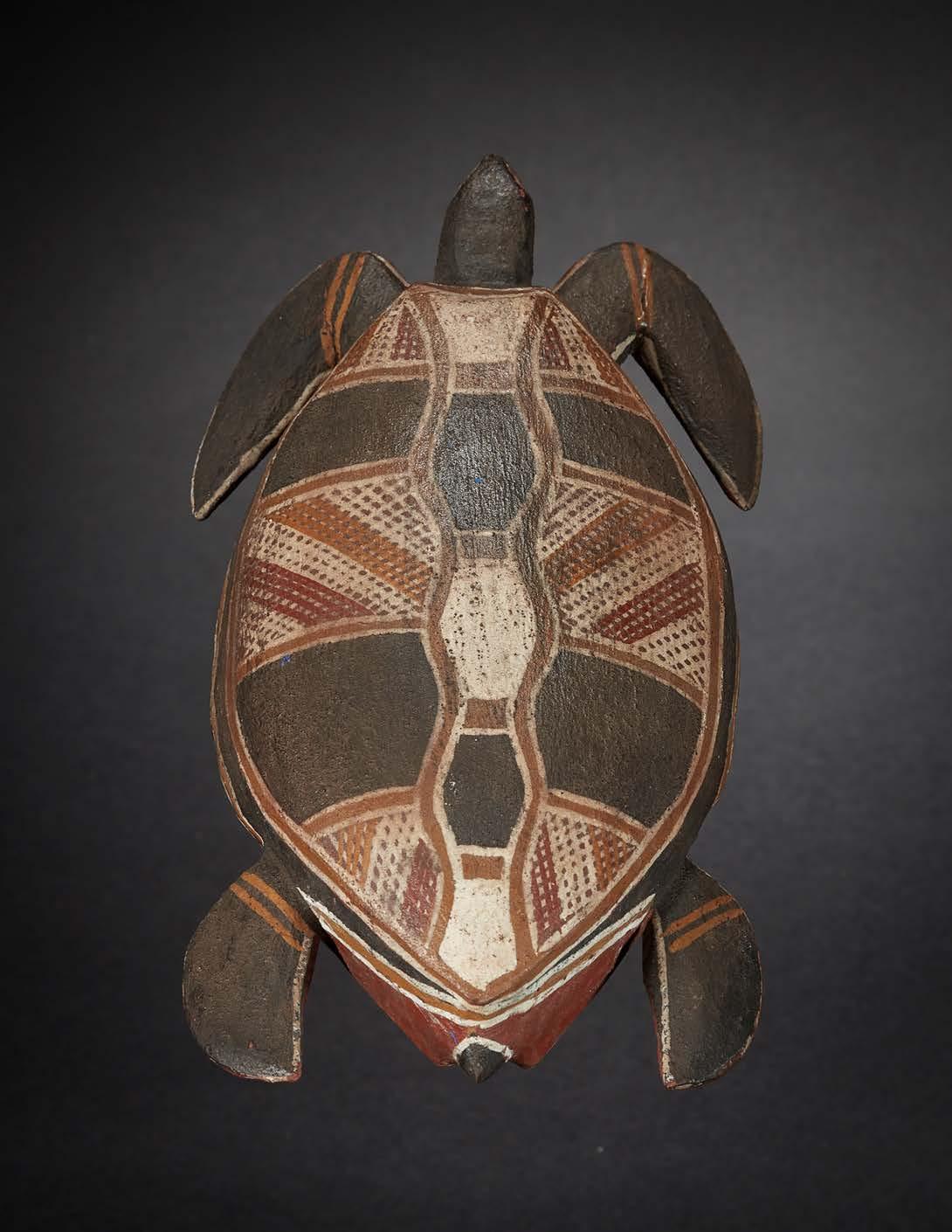
40. THREE EARLY MASSIM FIGURES
Trobriand Islands, Papua New Guinea.
All three figures would be from the earlier 20thC.
a) Large squatting figure, with a strong jutting jawline, sinuous arms and legs and delicate engraving over the body and head.
b) A very finely carved male figure with one arm and an arm reaching across the chest. The man appears to be an amputee, as the arm stump is certainly original.
c) A tall free-form figure with delicate legs and no base. One arm rests on the face; the other arm curves down and backwards. Lack of a base suggests the figure was meant to hang.
a) 51 x 14 x 20 cm
b) 31 x 9 x 9 cm
c) 50 x 10 x 11 cm
a) € 2,800
b) € 600
c) € 800

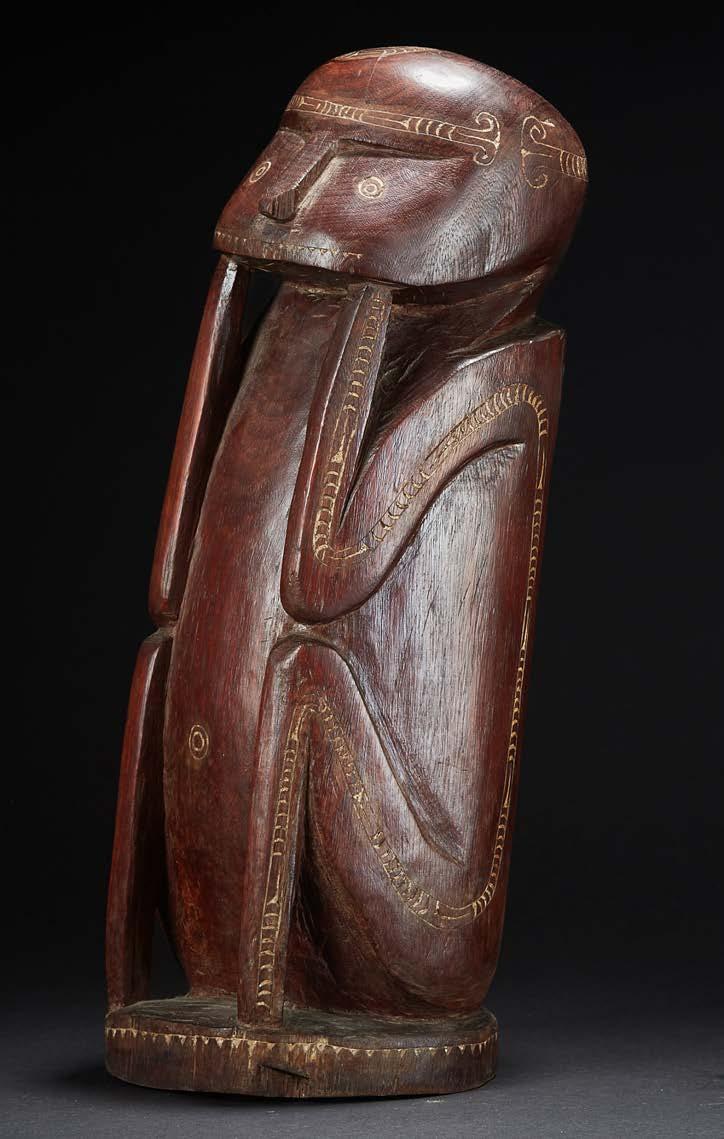

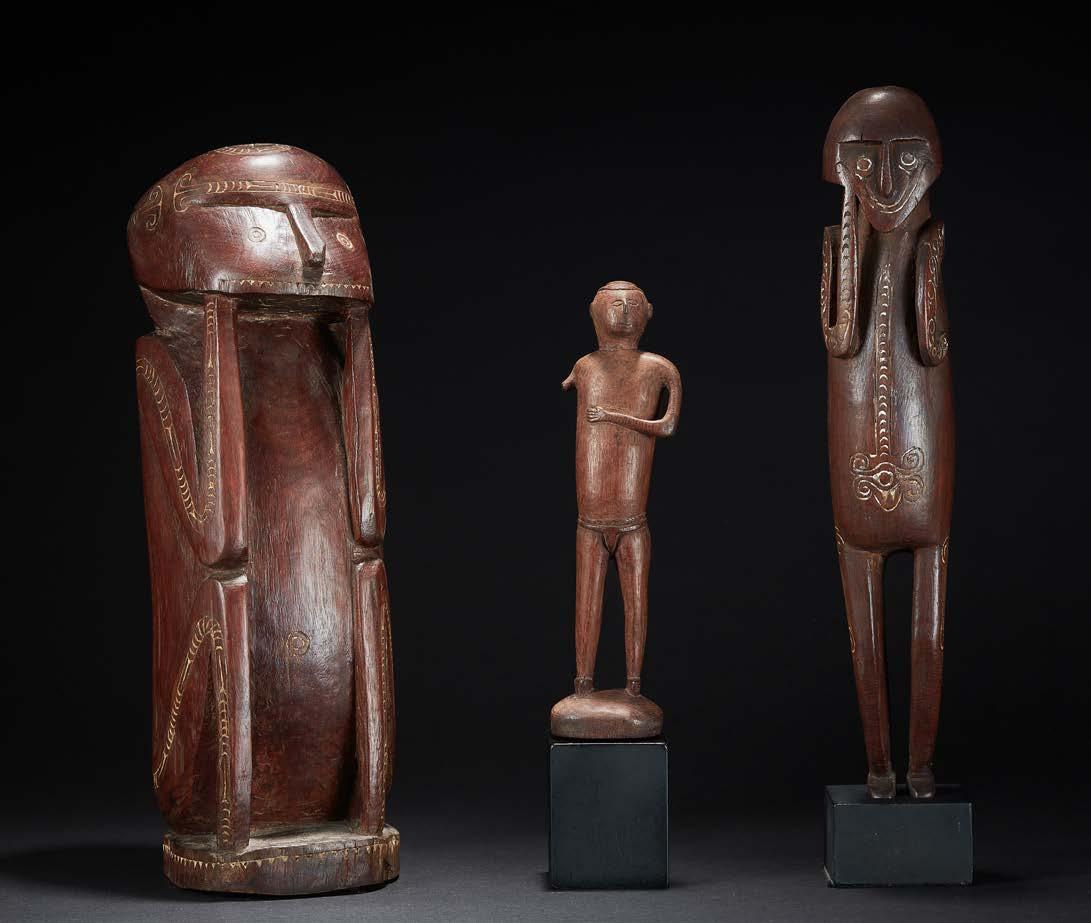
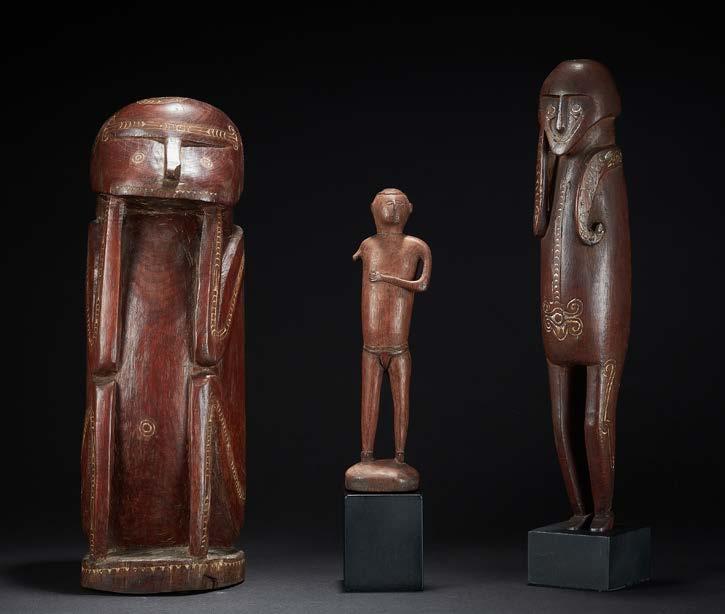
41. PHANTOM SHIELD
Wahgi Valley, Papua New Guinea Highlands. Artist: John Wahgi.
Shields with non-traditional designs are a relatively recent phenomena; the first shields with The Phantom painted on its surface was in the 1990s. These “new designs” were a ressponse of the first generation of educated Highlanders becoming warriors. They knew of the wider world beyond their Highland valleys and decided to incorporate new ideas into their shield designs. “The Phantom” became a favourite motif, as the story reflected in many ways their own Highland cosmology.
This strong Phantom shield shows the Phantom in action, emerging fromt he Skull Cave where he lives, with a haunting moon rising large in the dark sky, and reflecting across a lake. His dog, Wolf, is behingd him, ready to follow. “The Phantom” is written in large red letter and, below this, “Man who Cannot Die”.
137 x 39 cm

€ 4,000
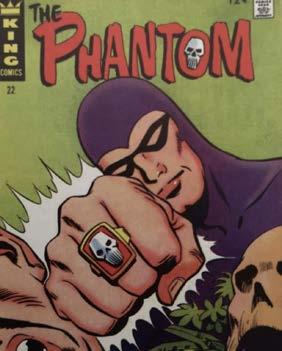
The Phantom comic was imported into PNG from the 1970s onwards and also published as a serial in newspapers. It was very popular and the young boys of the 1970s became the warriors of the 1980s/1990s.
